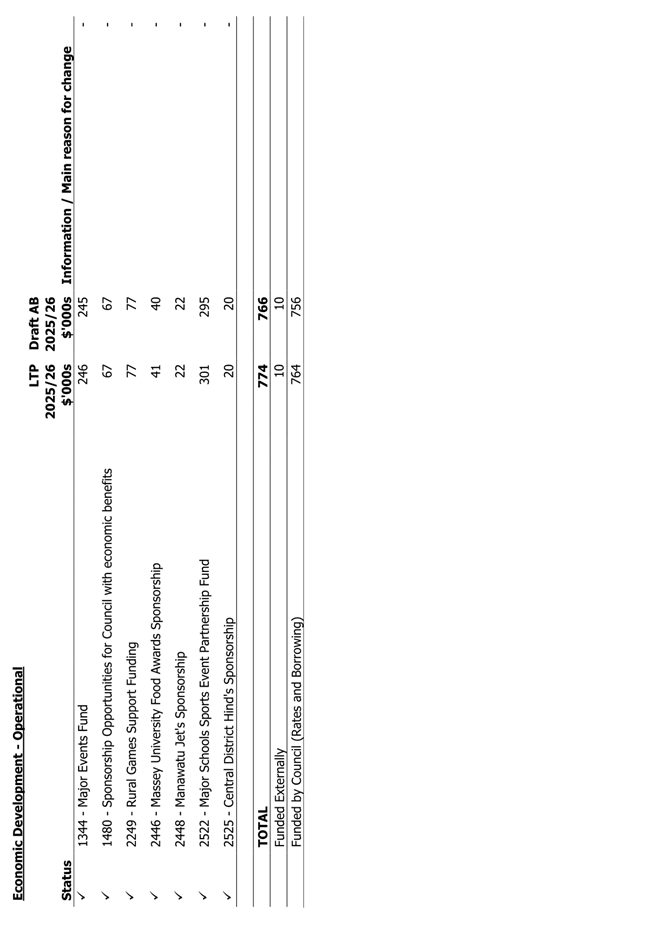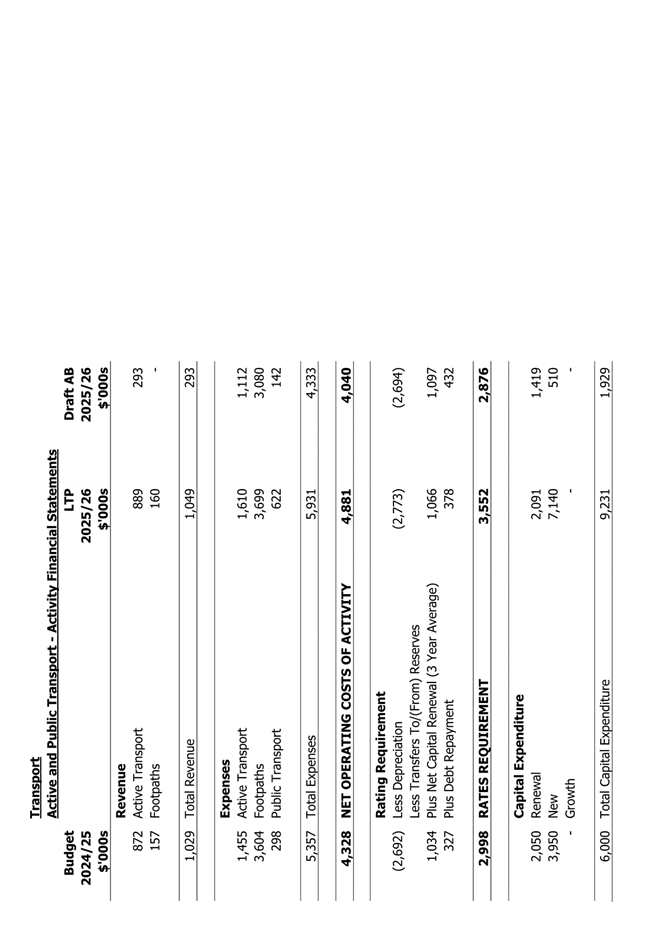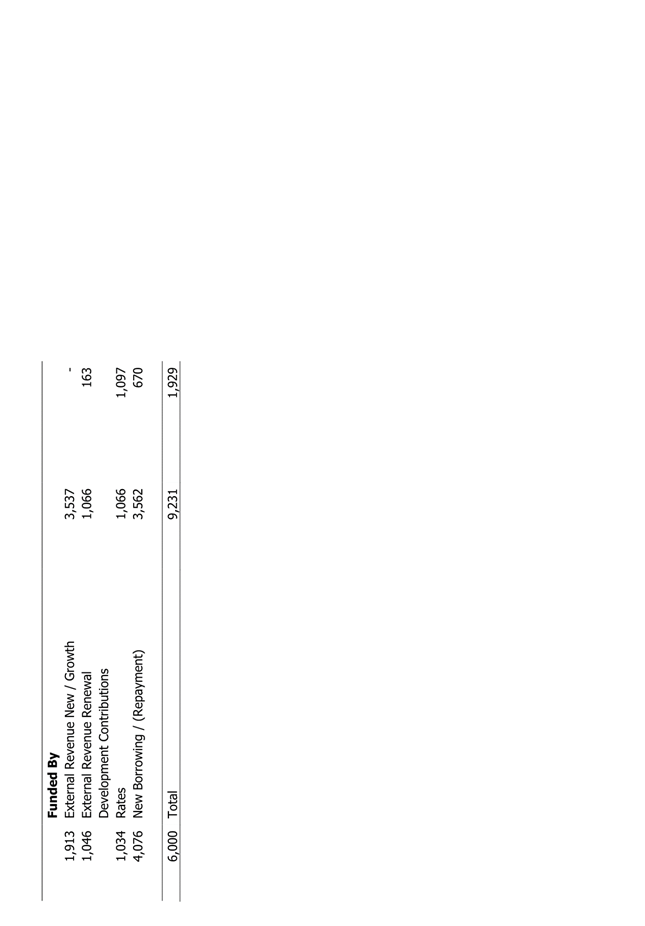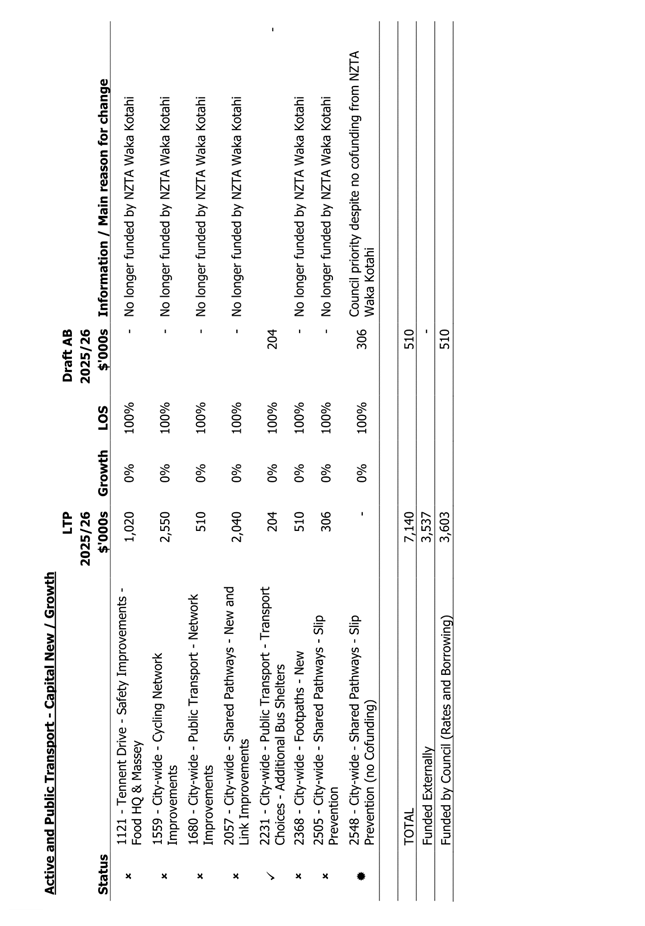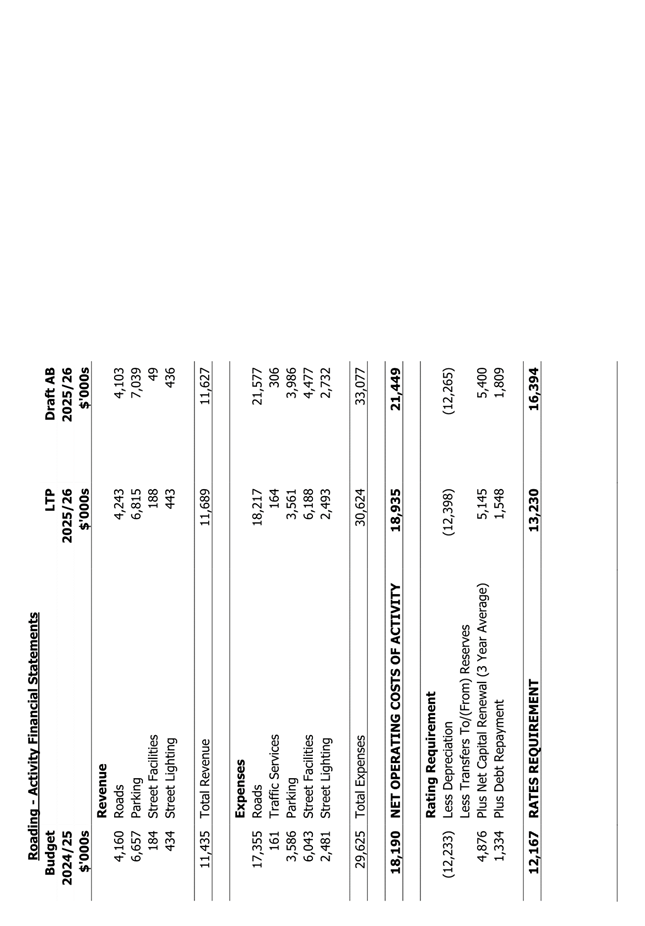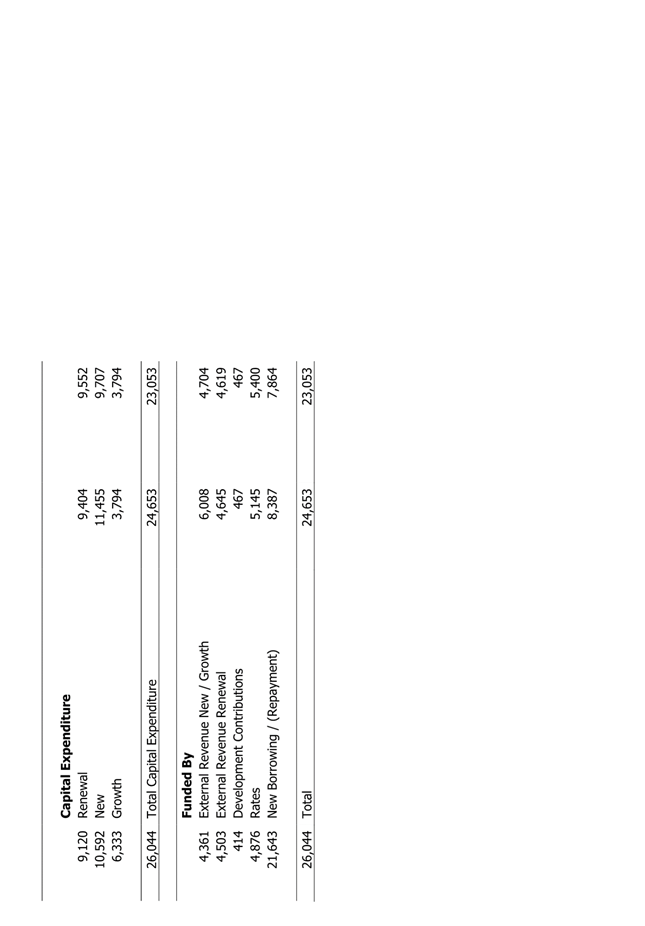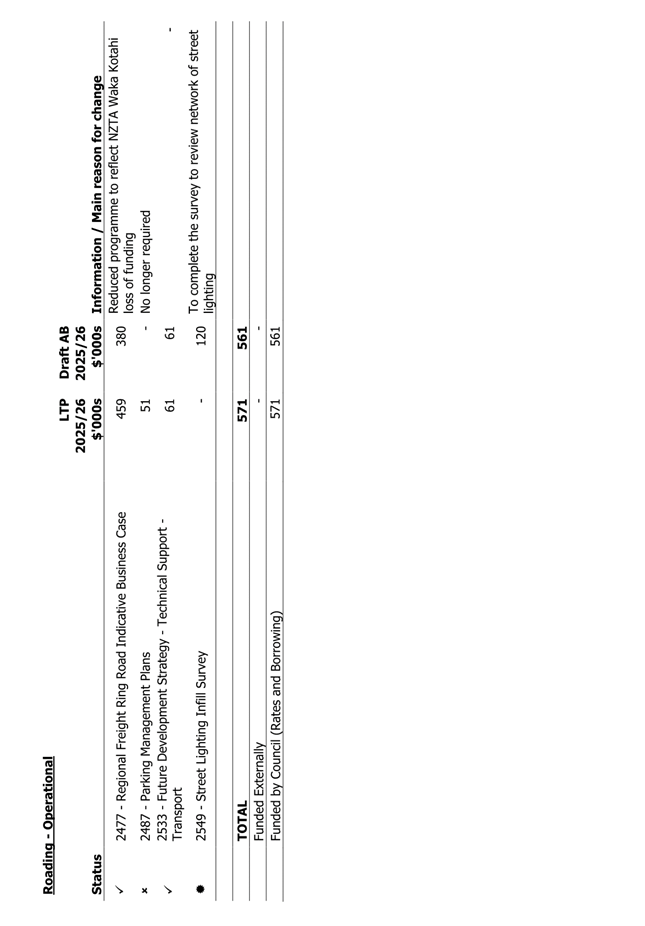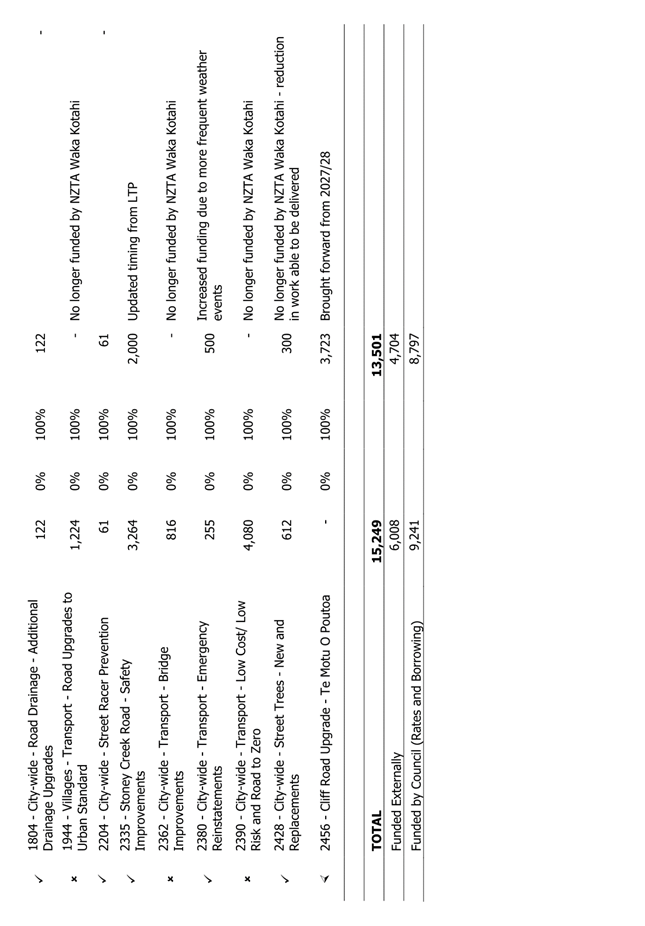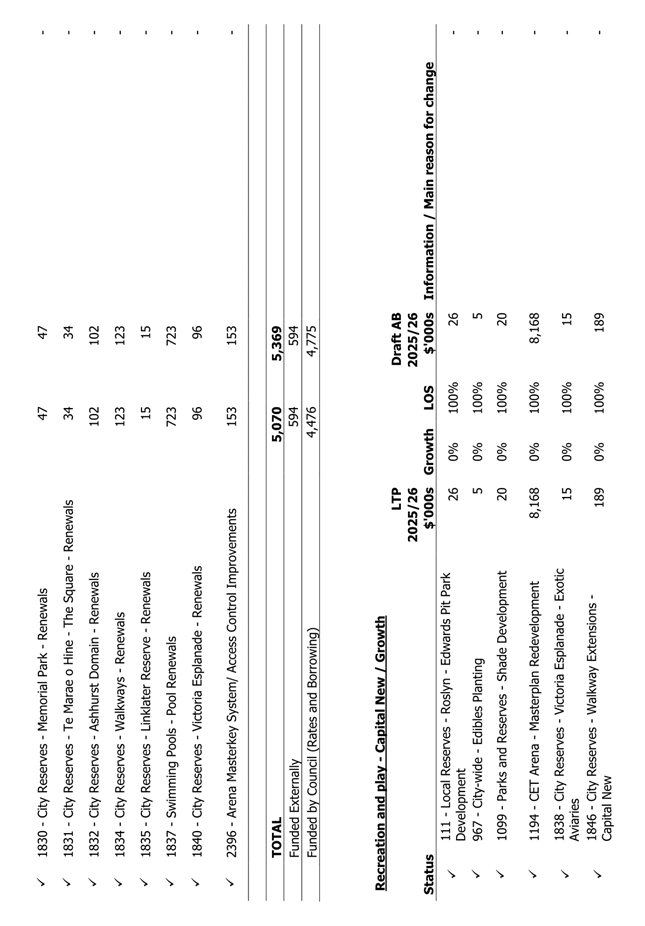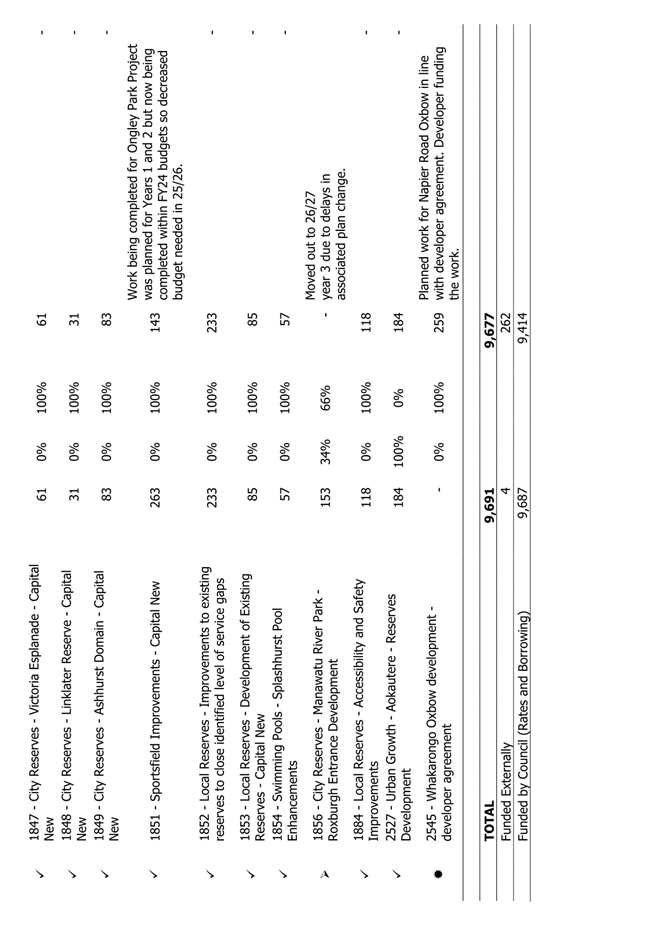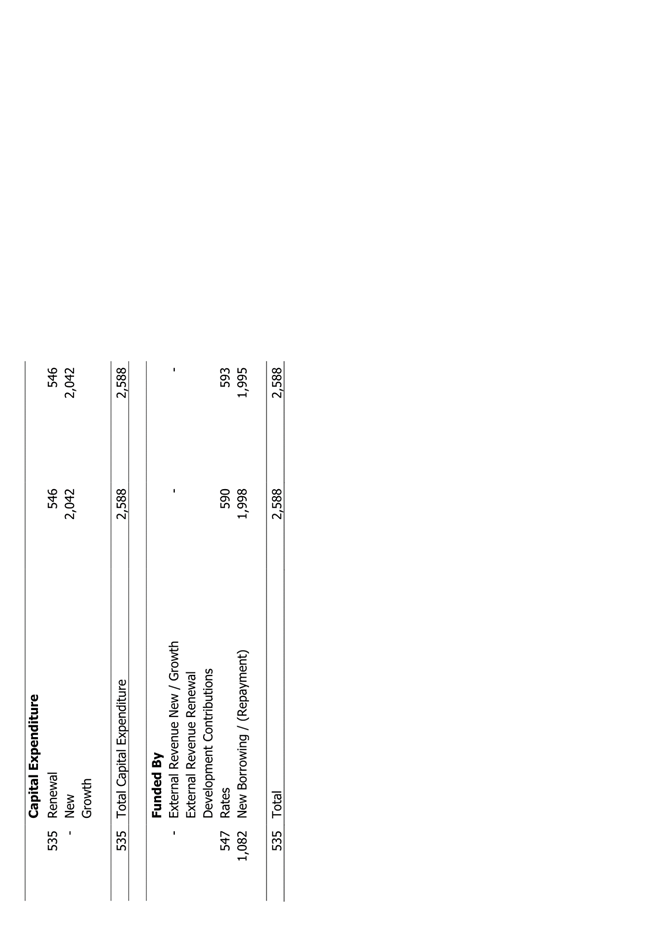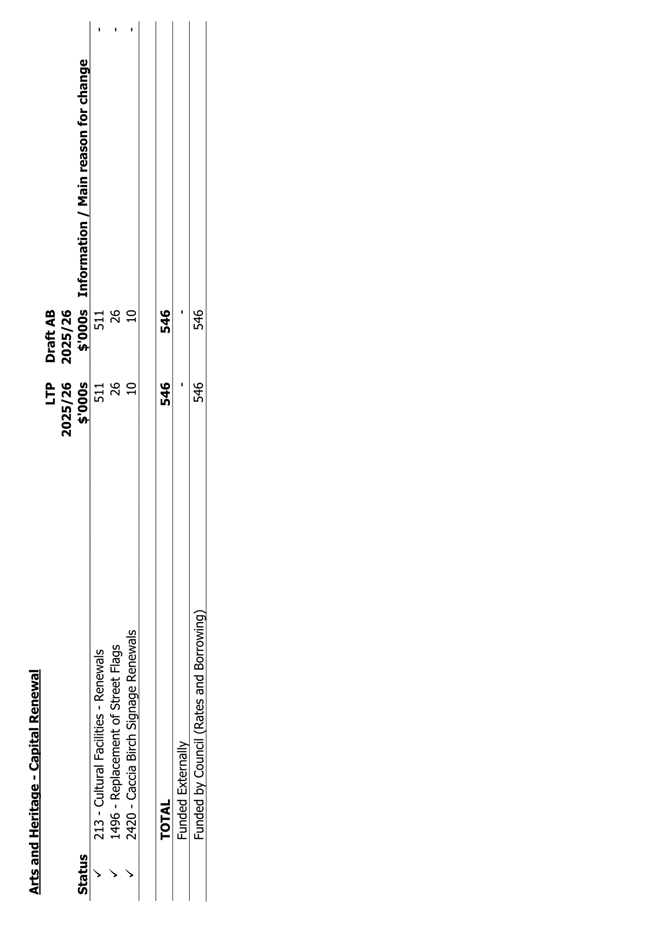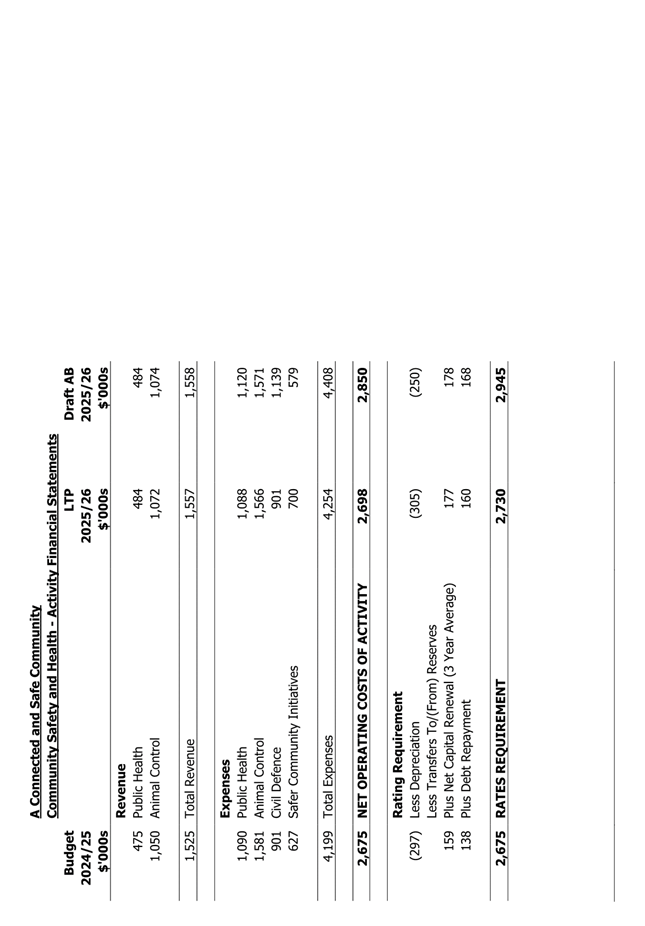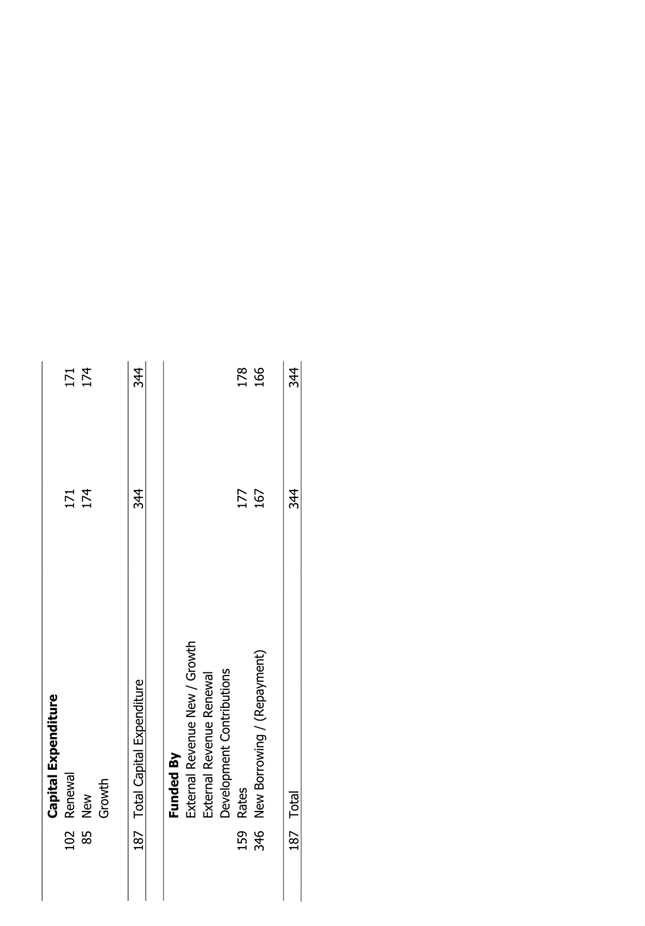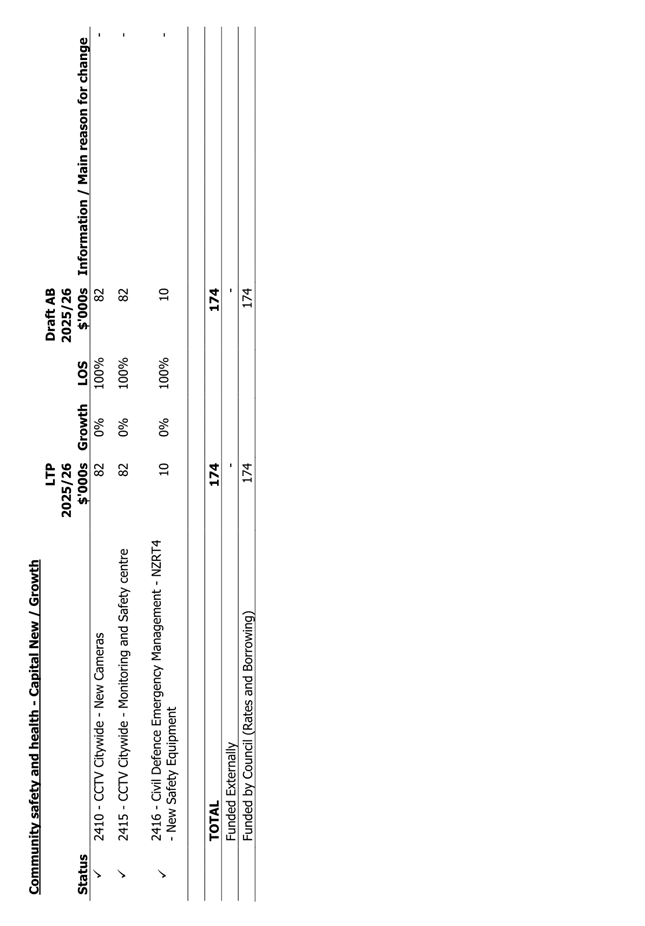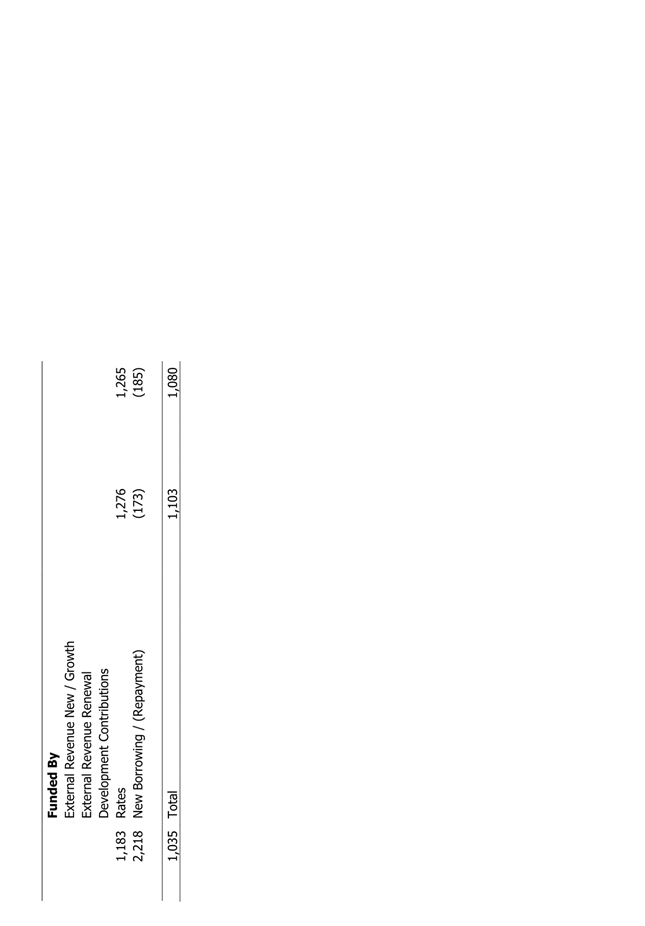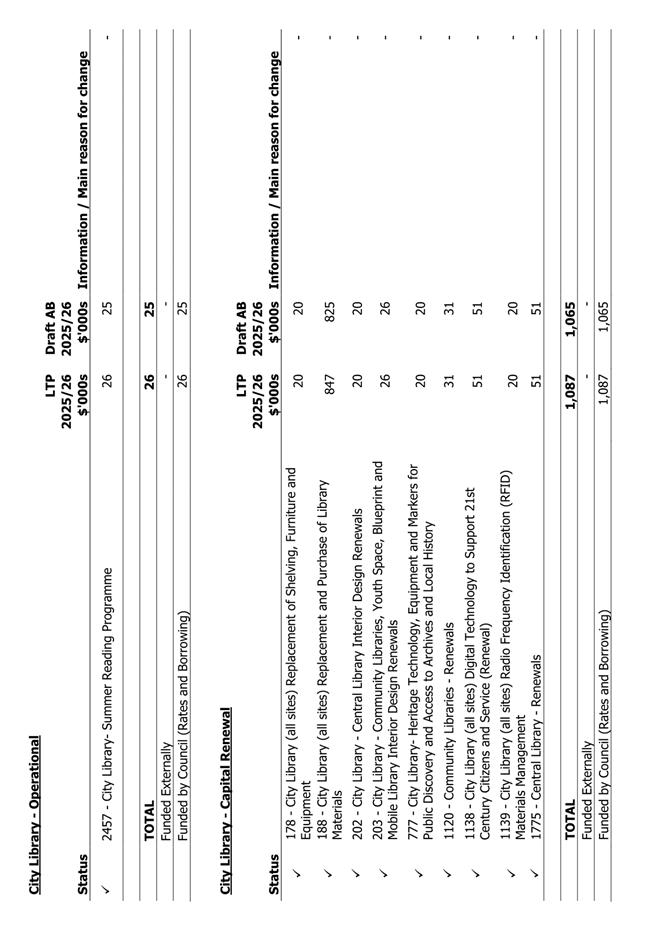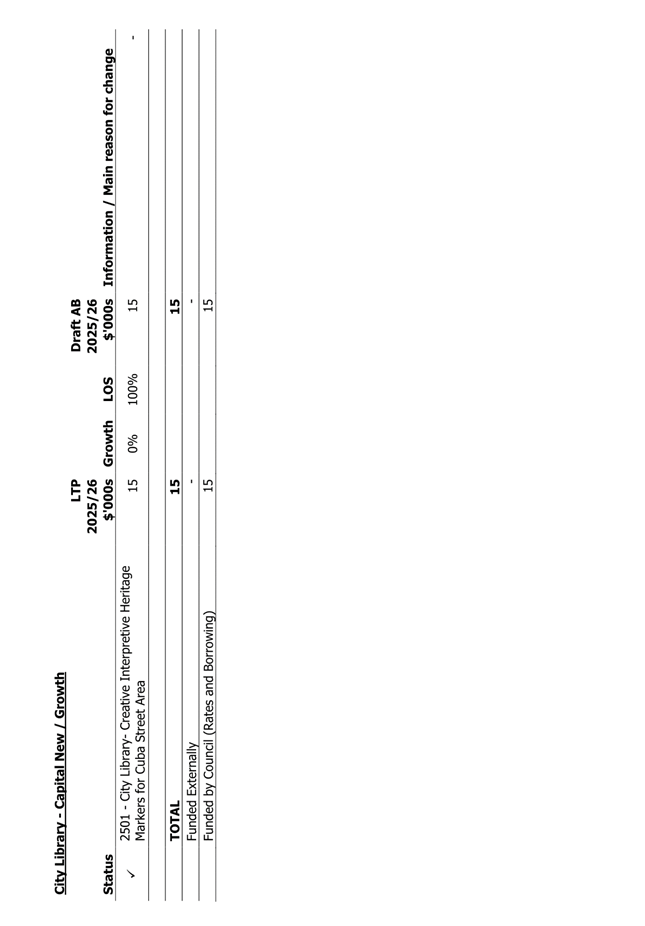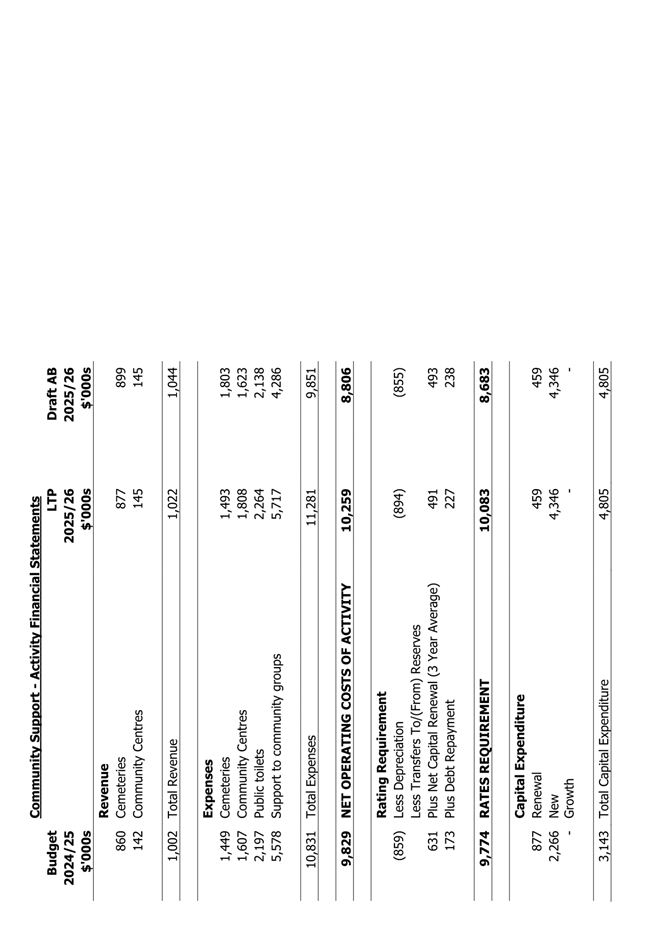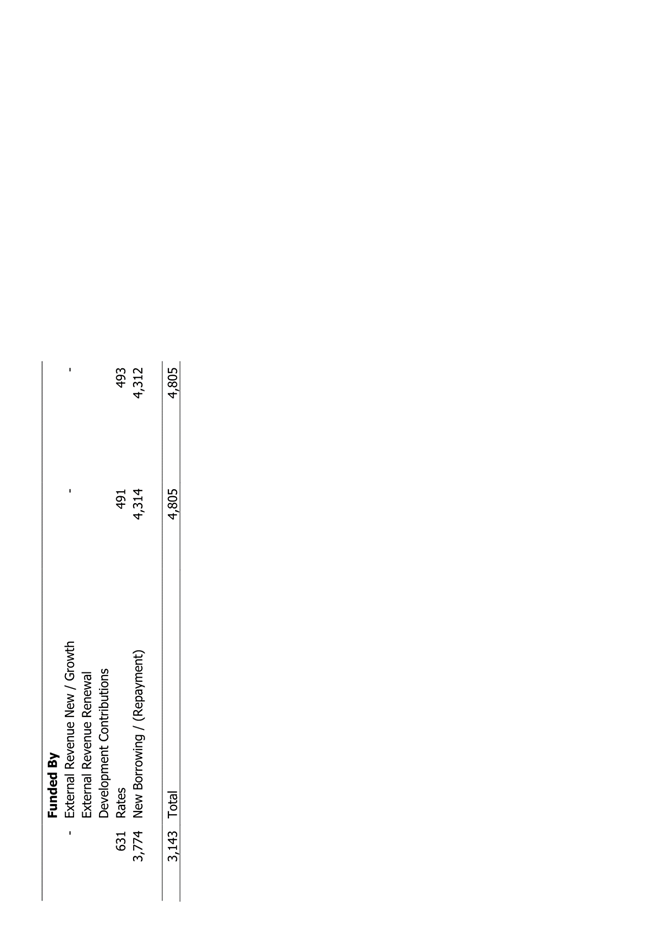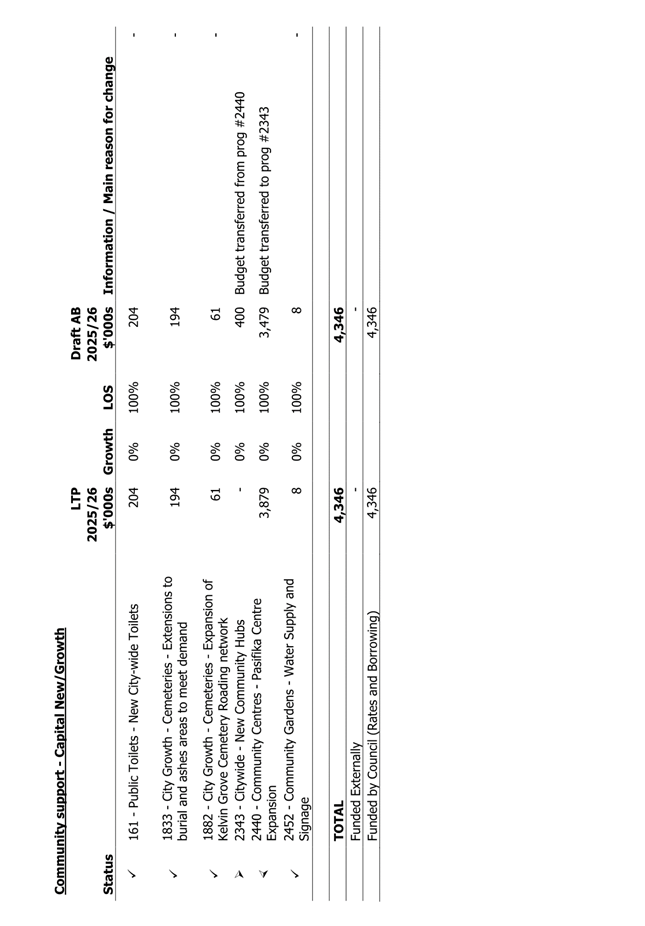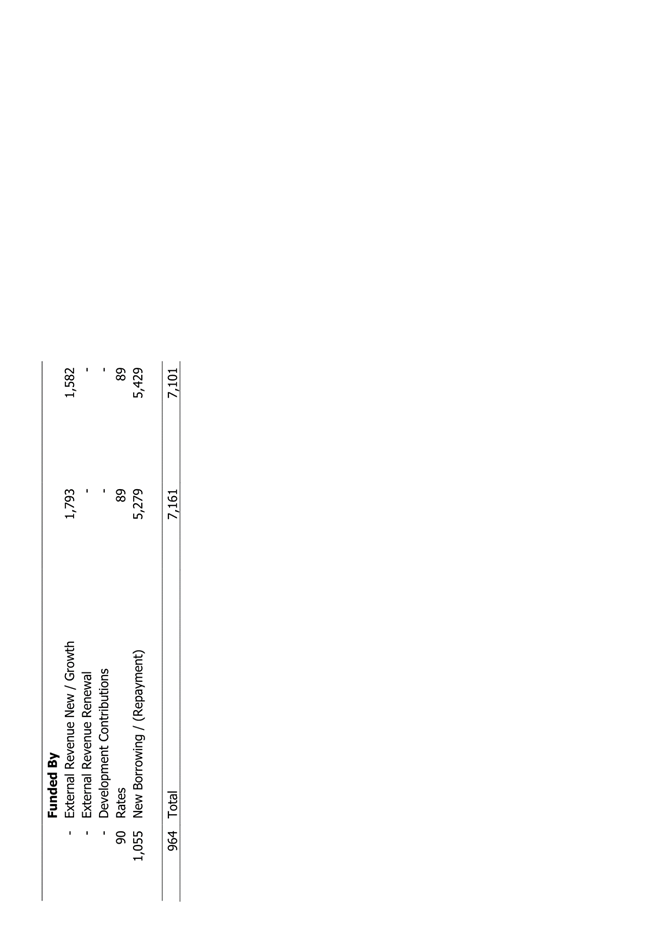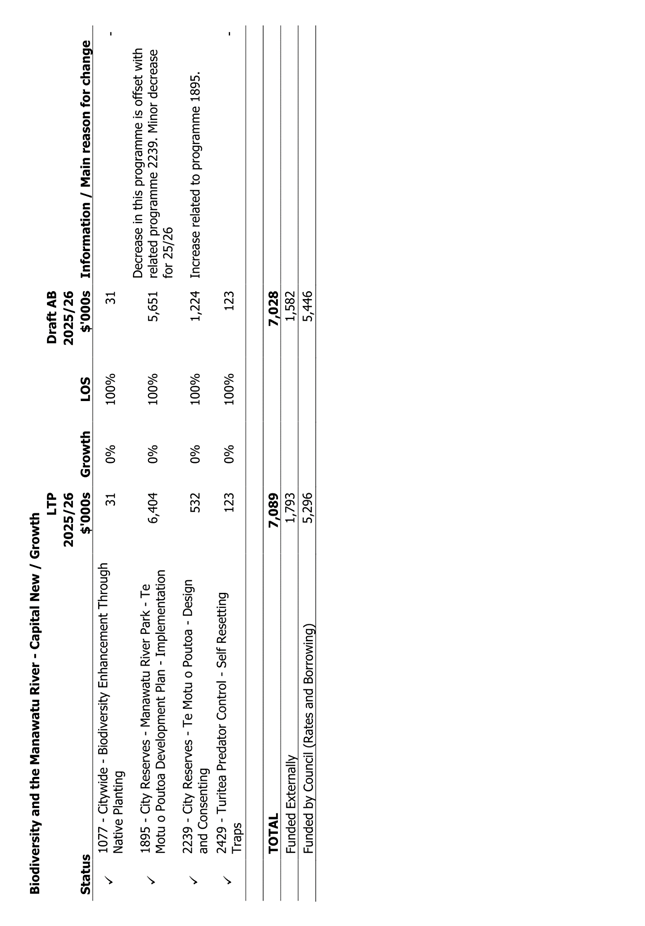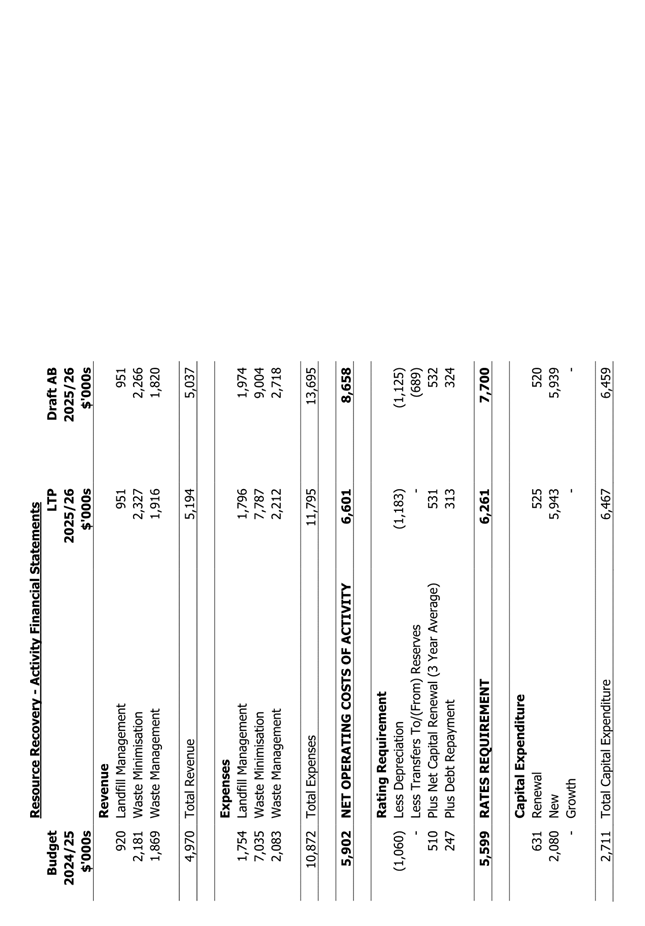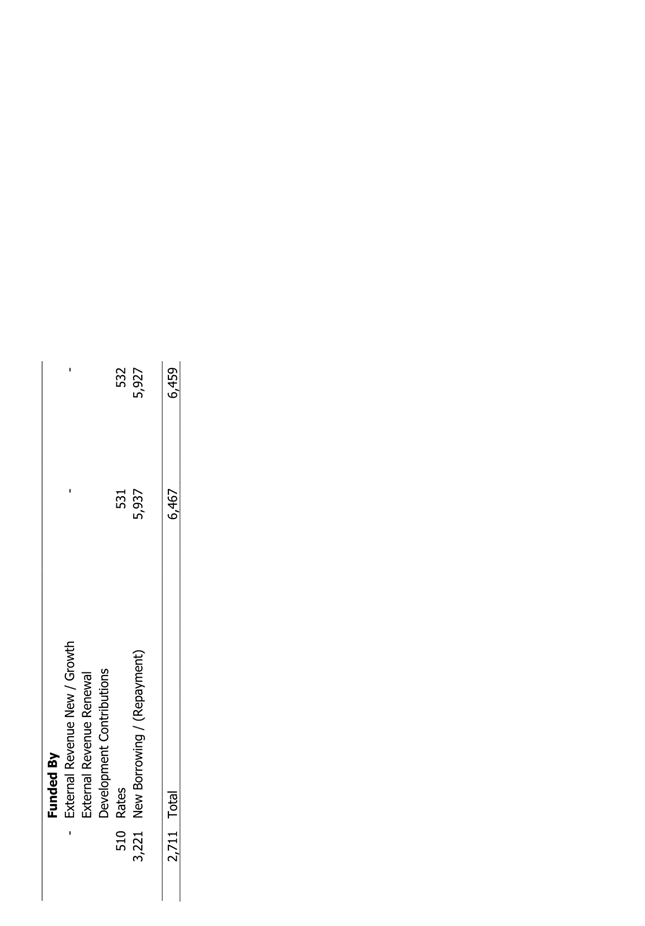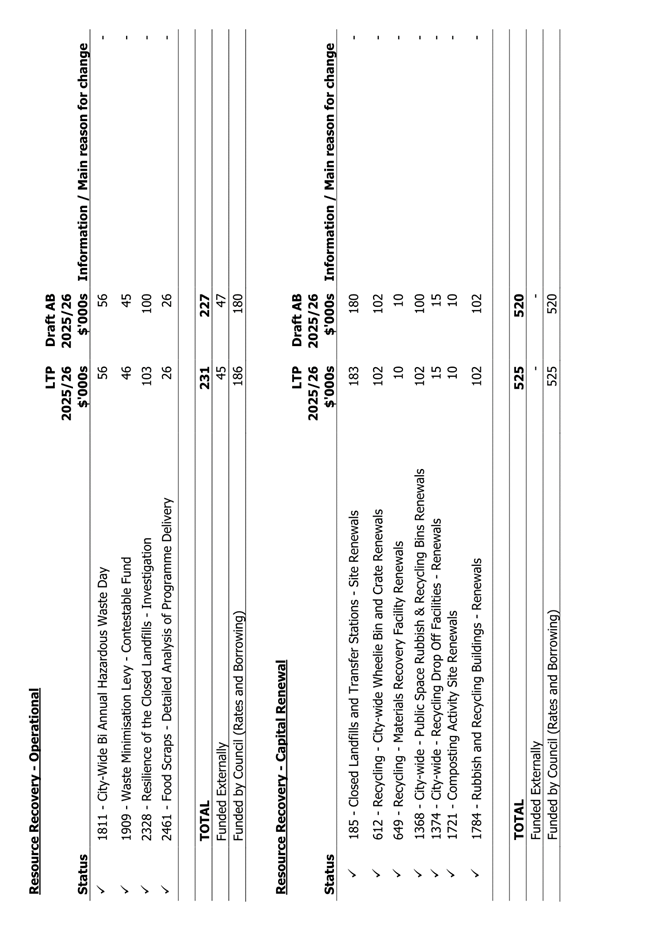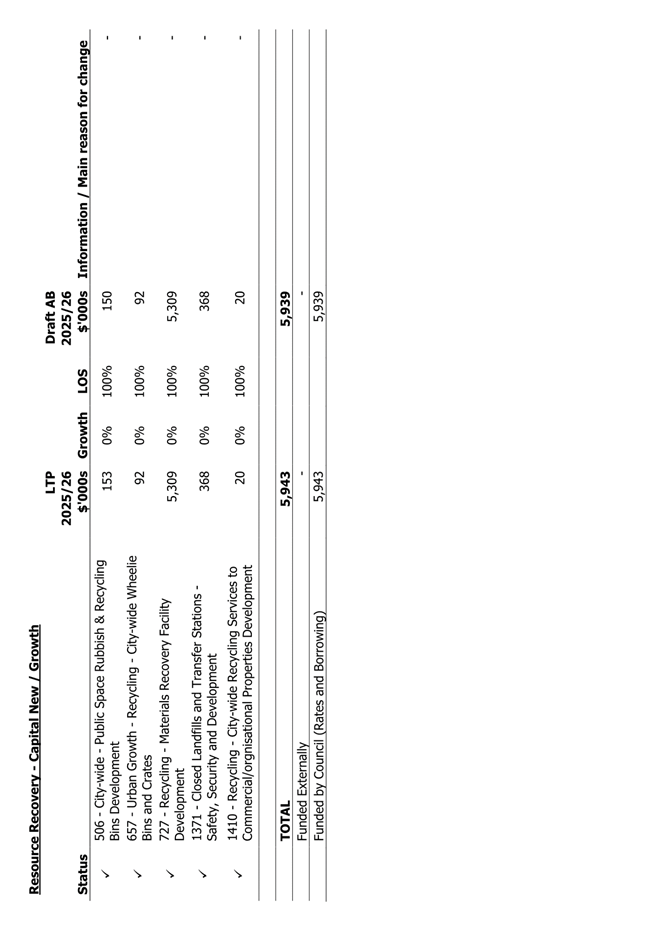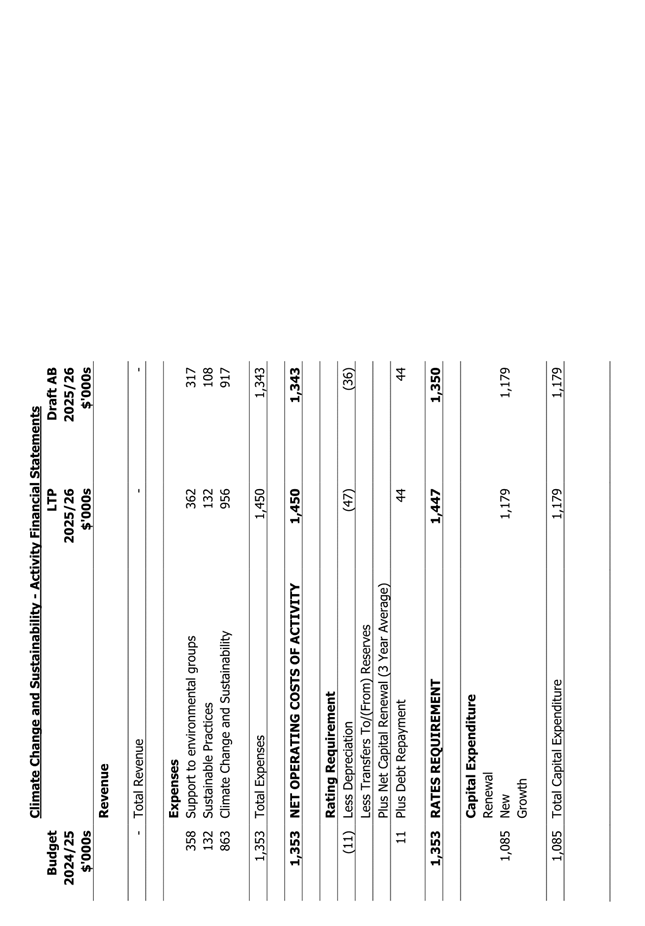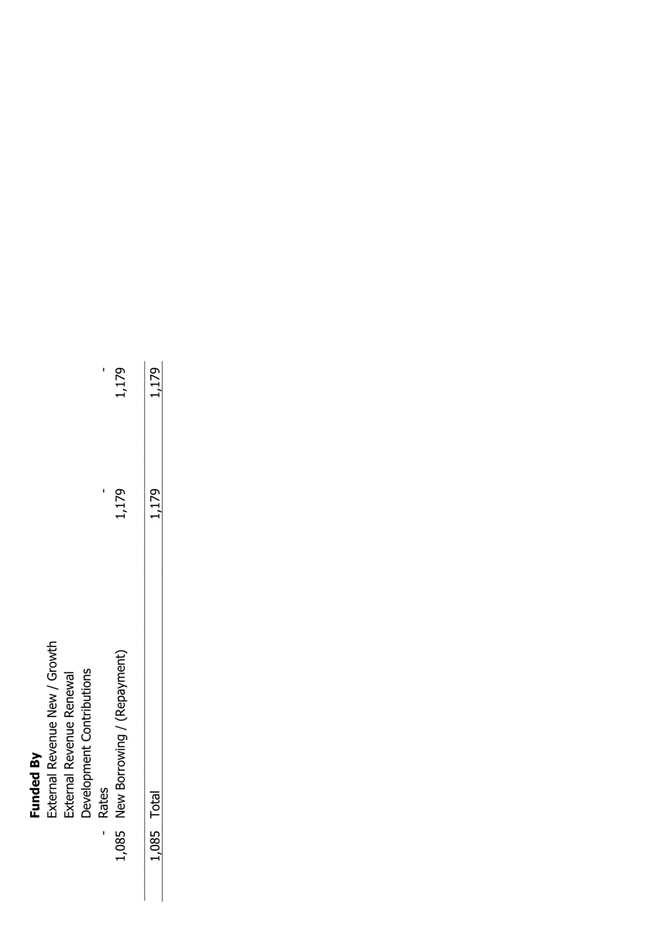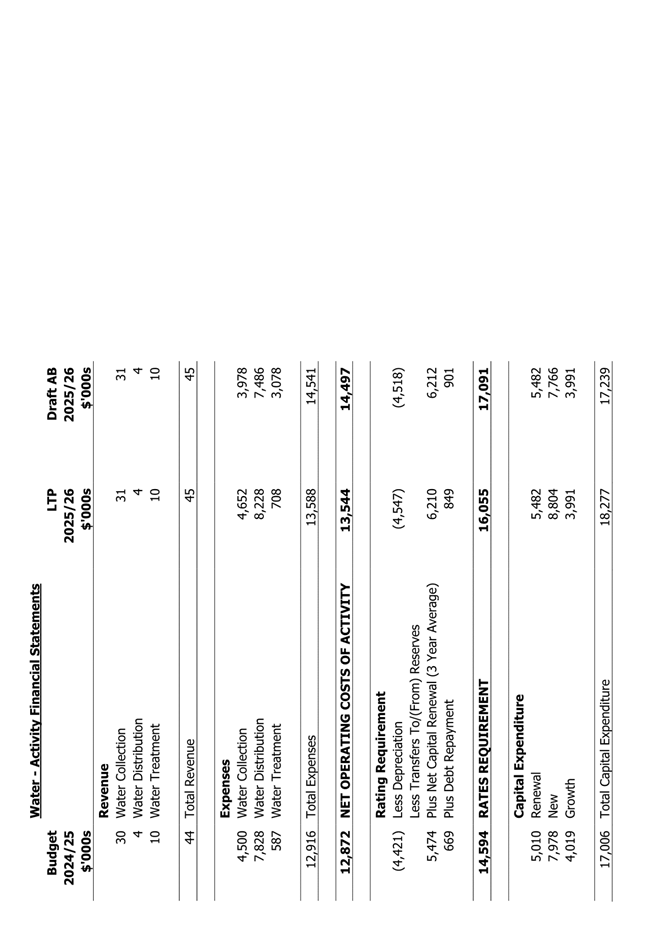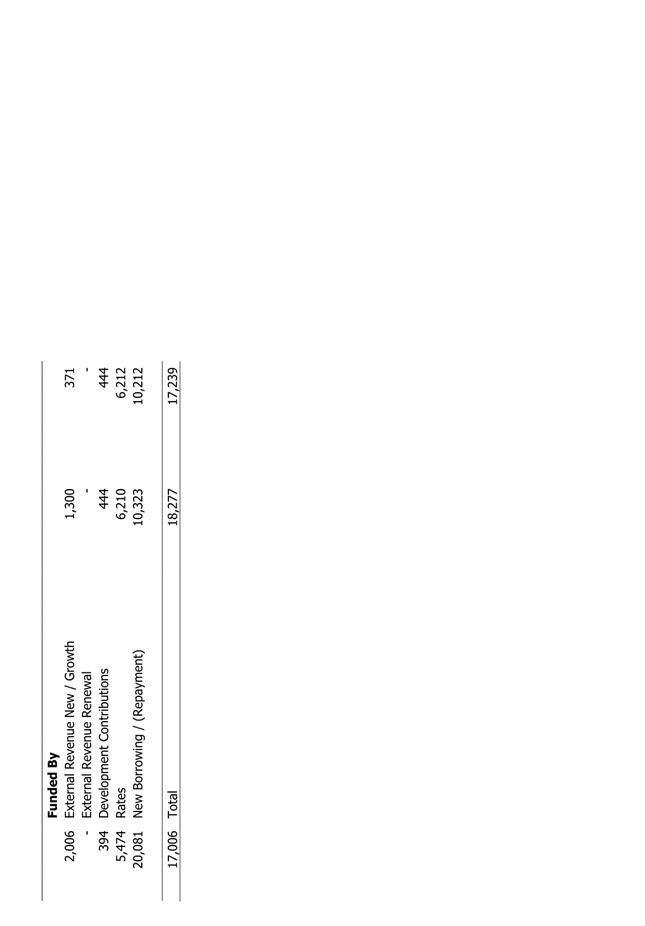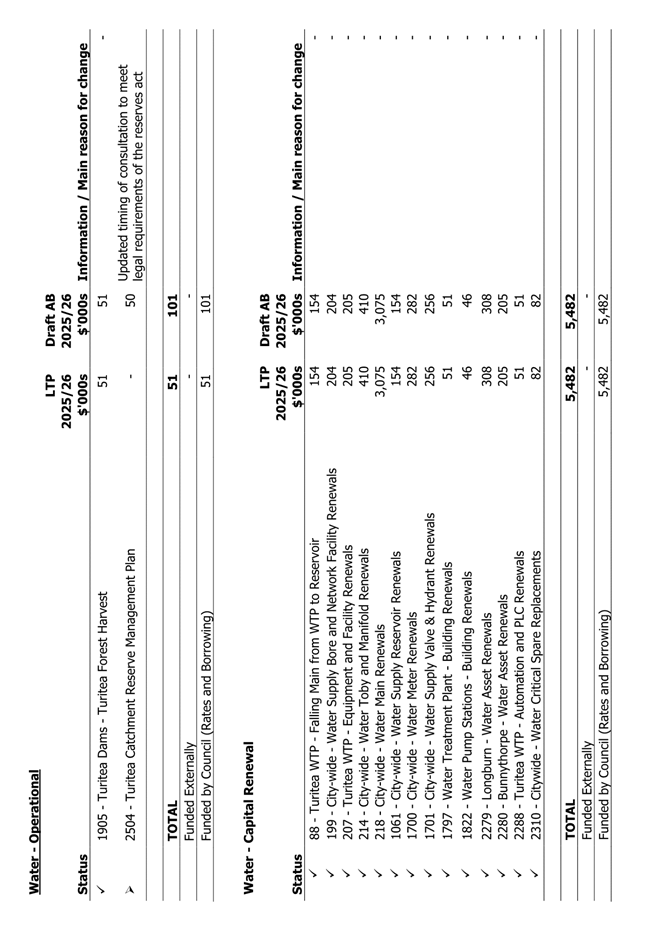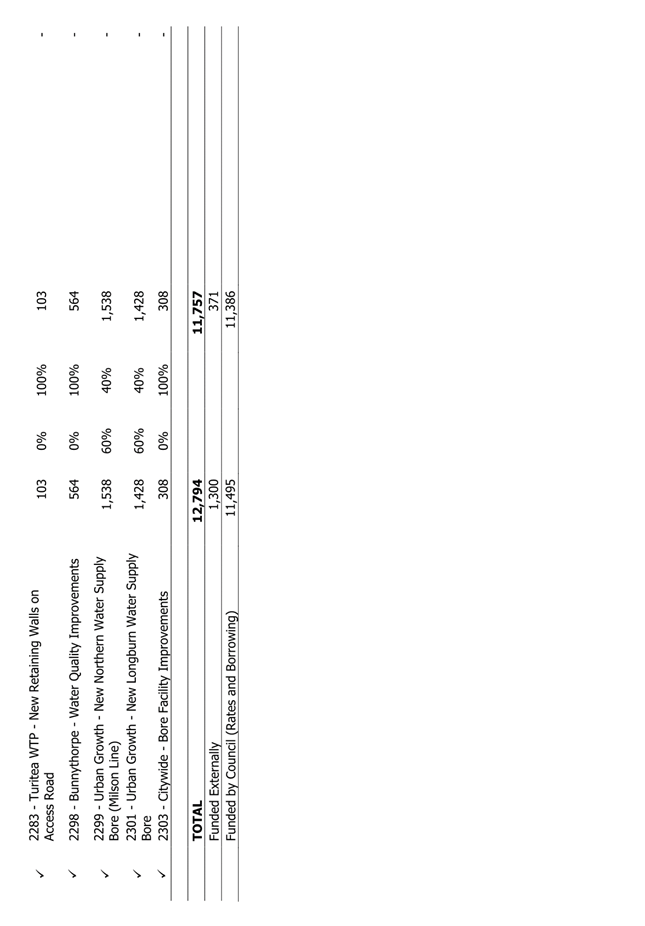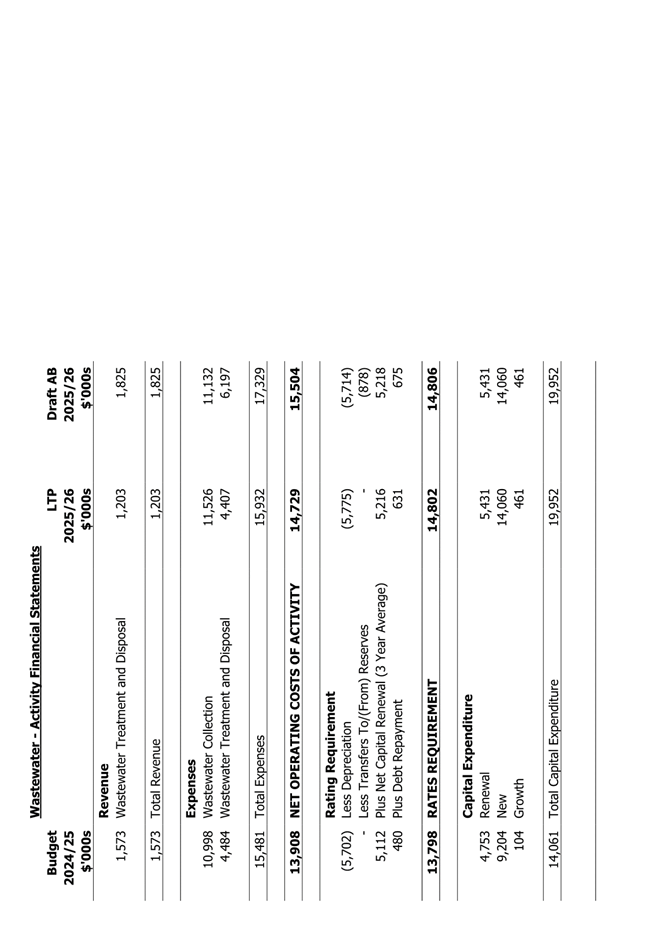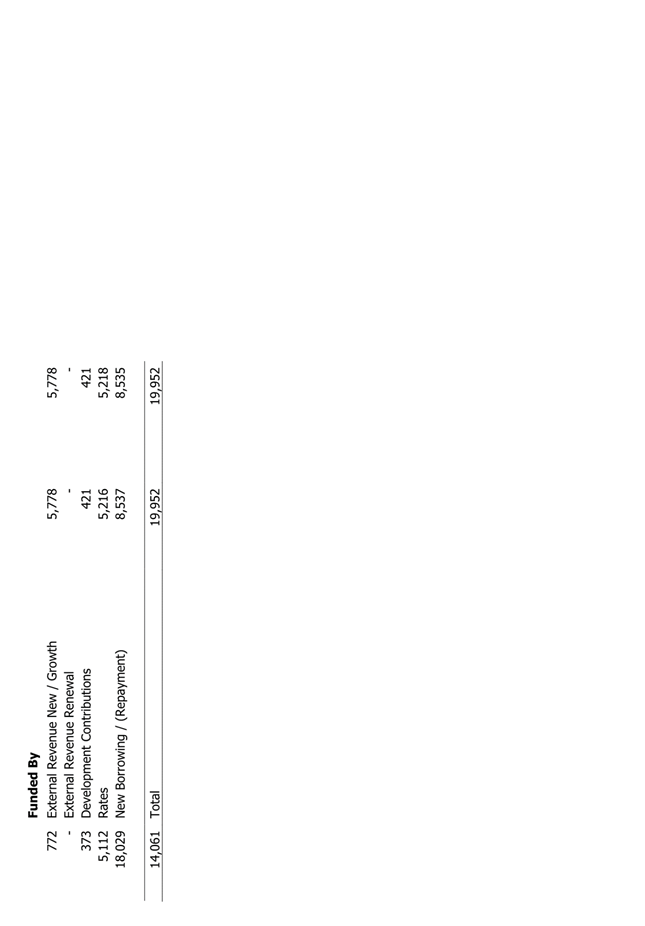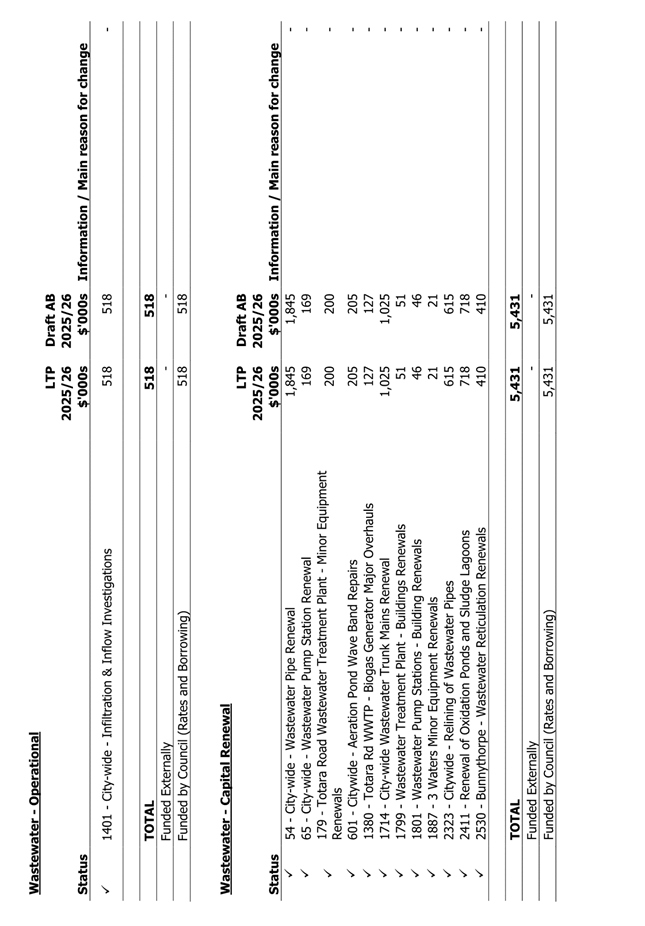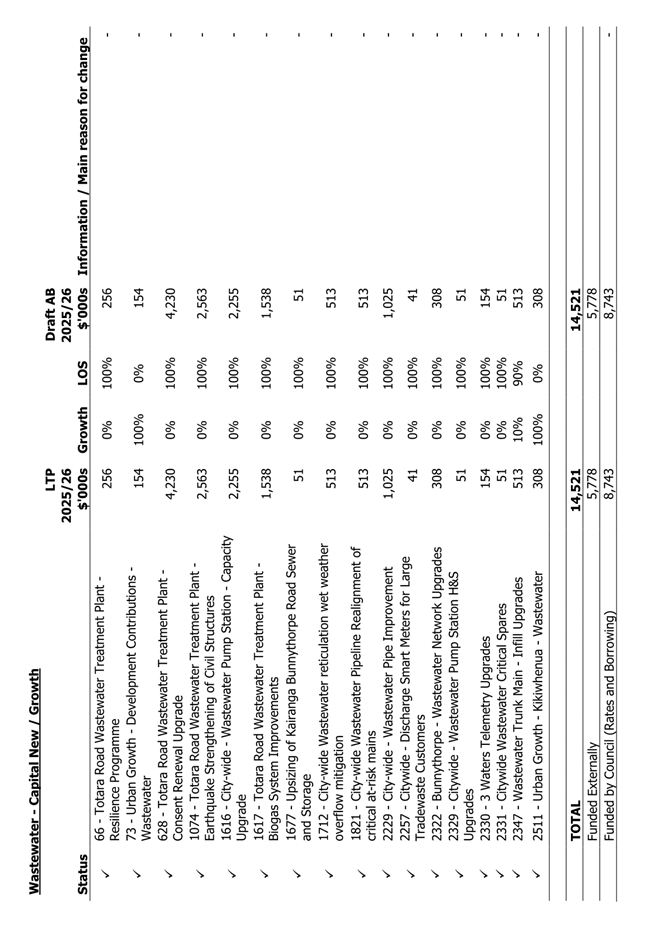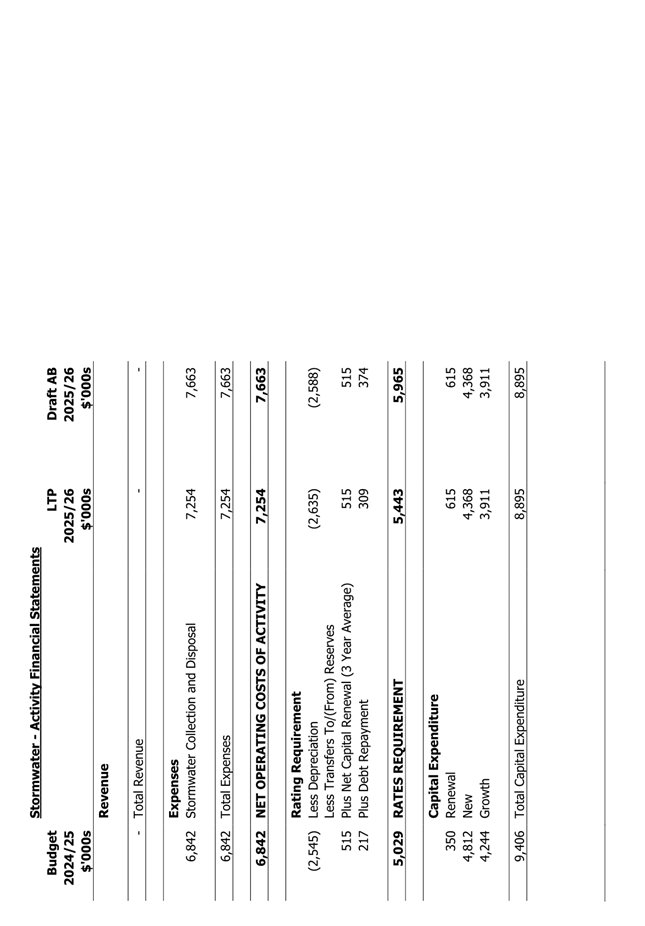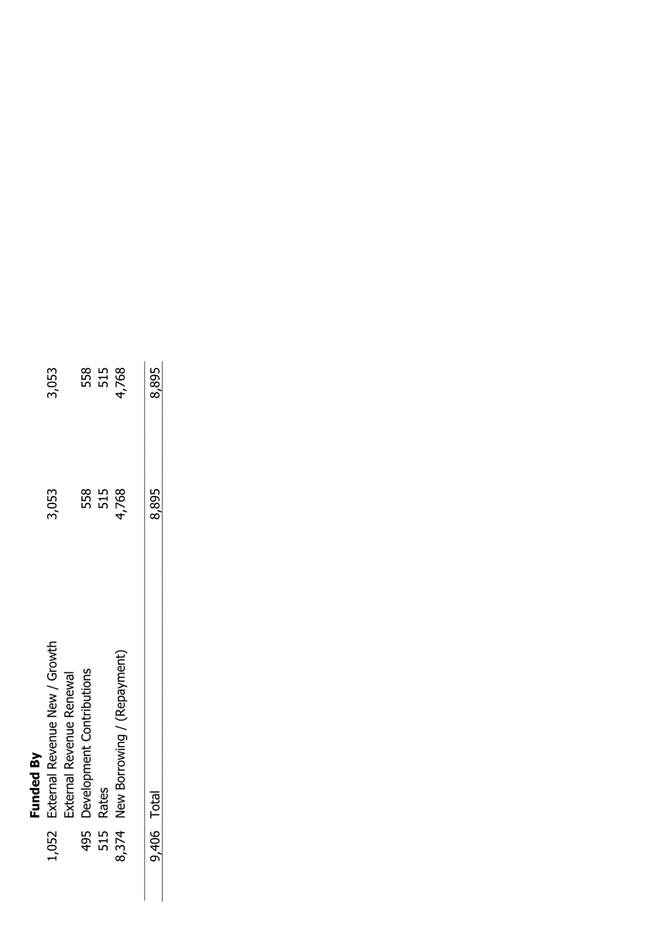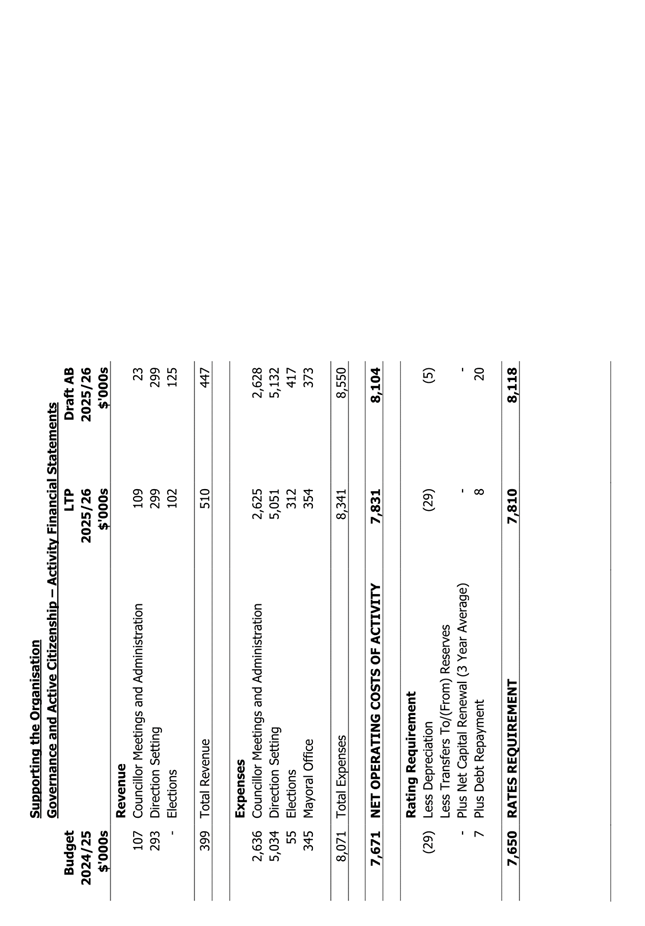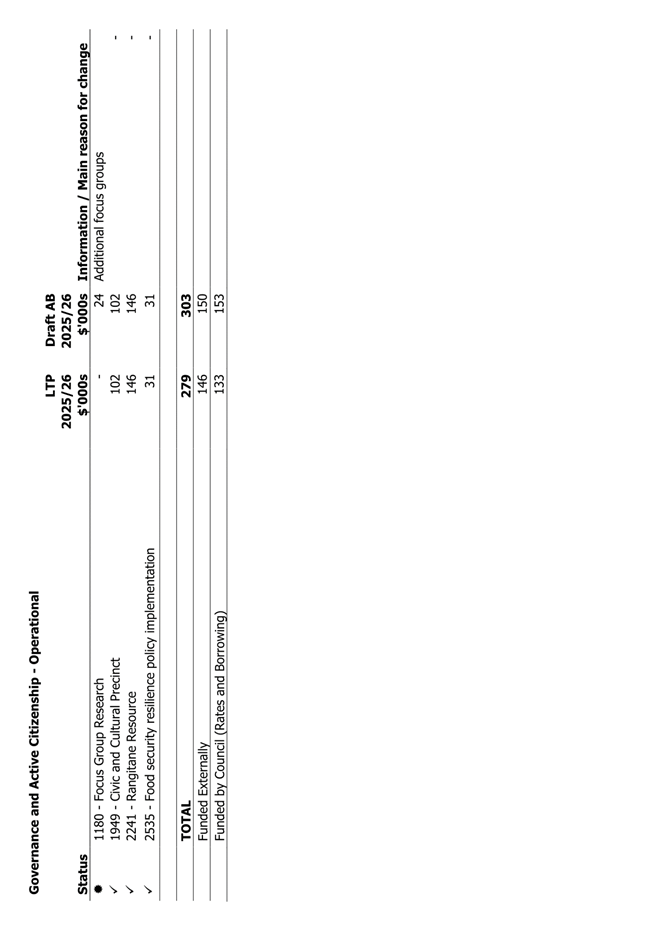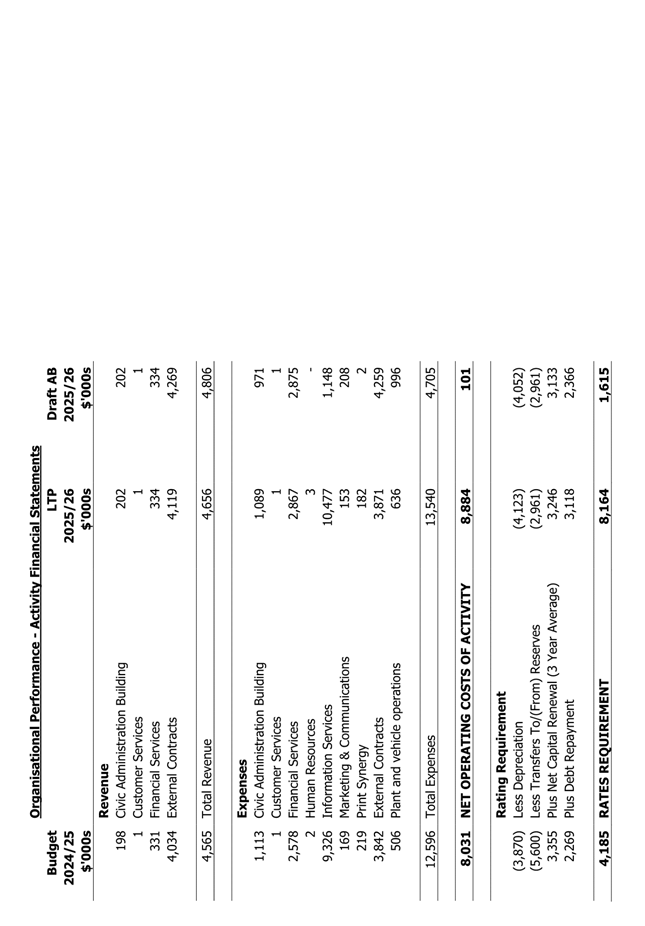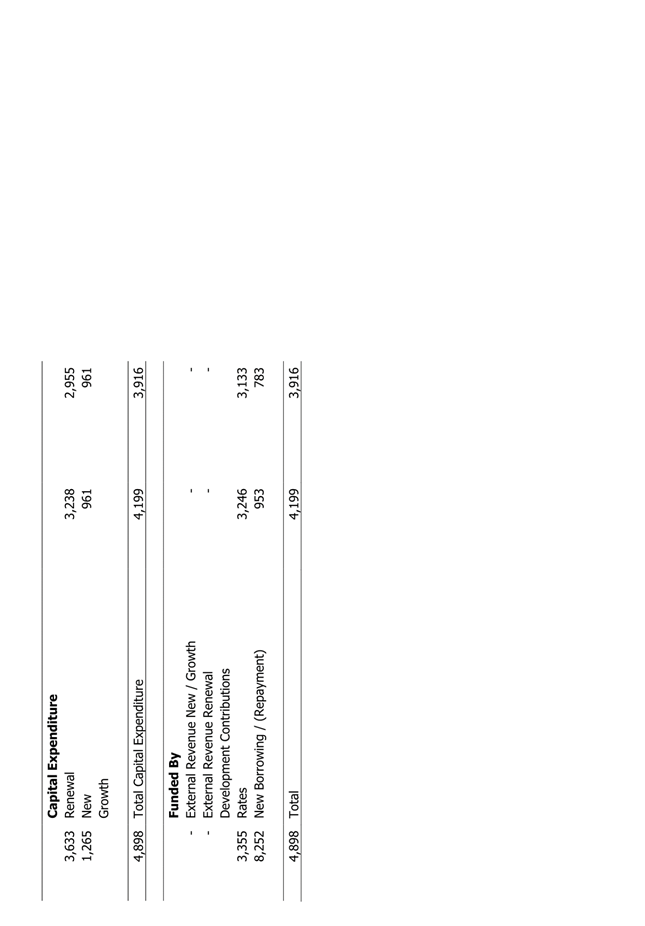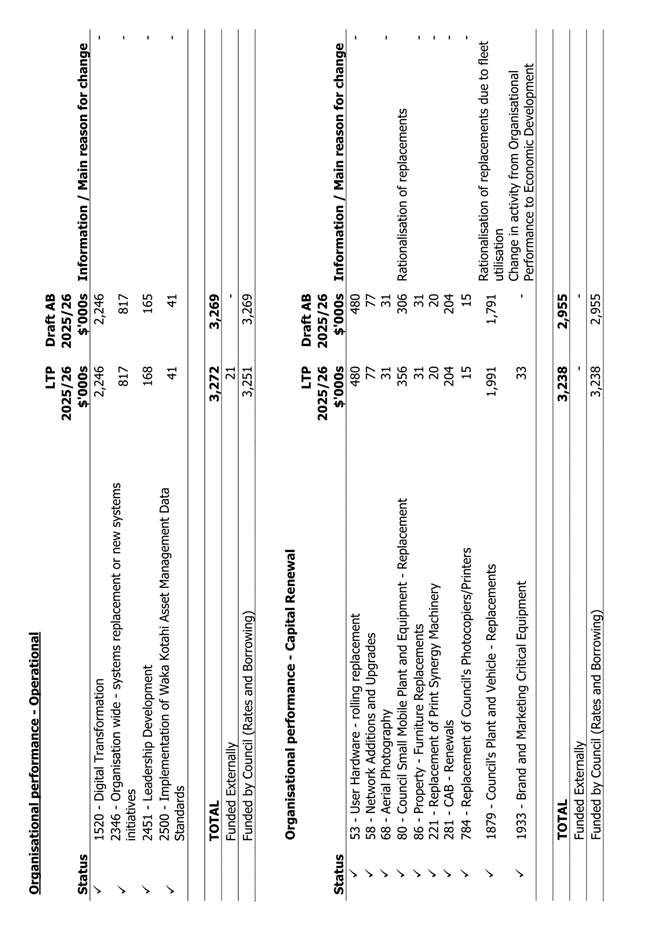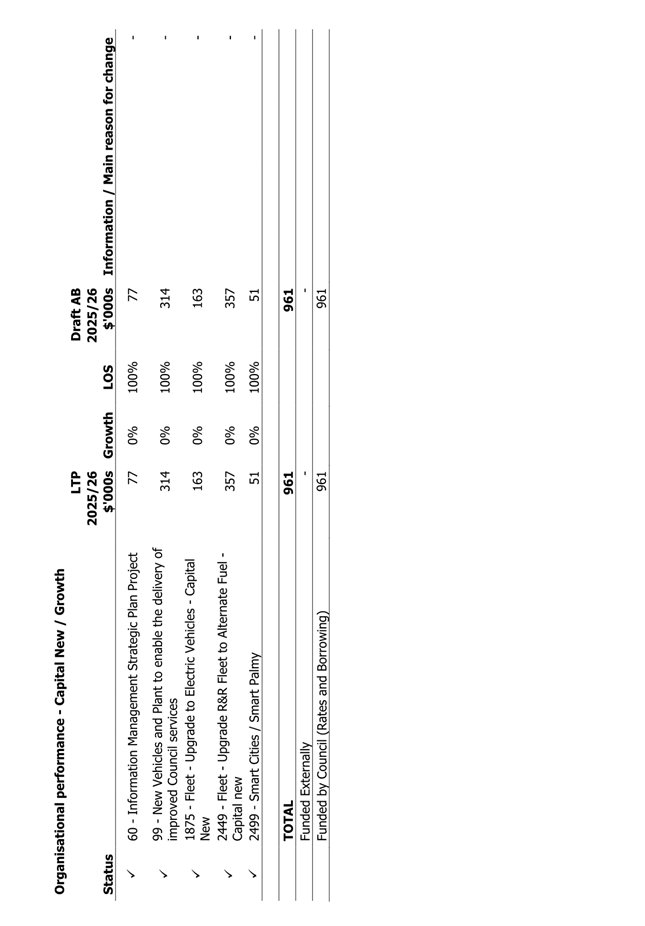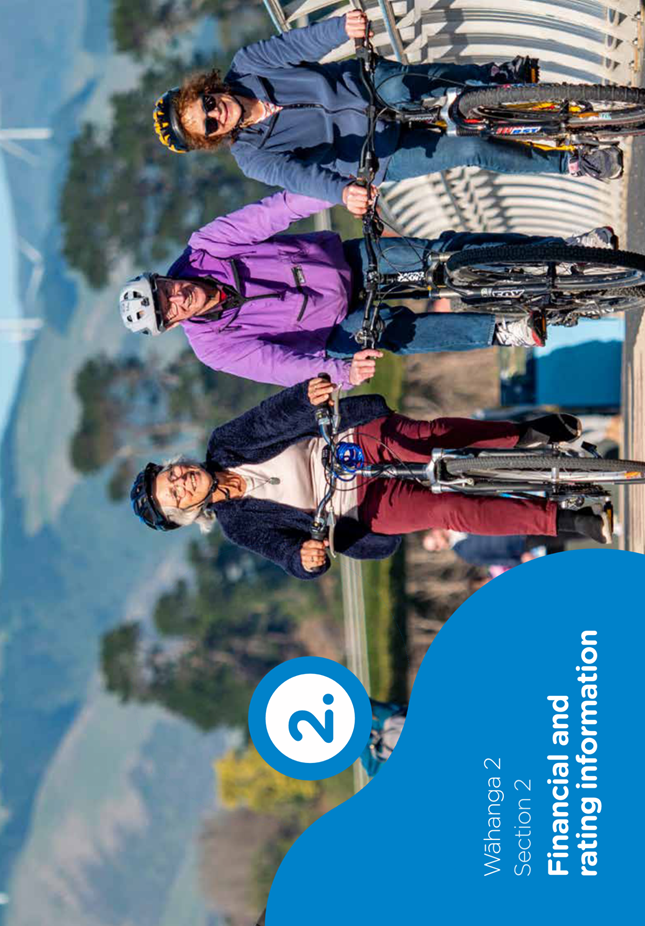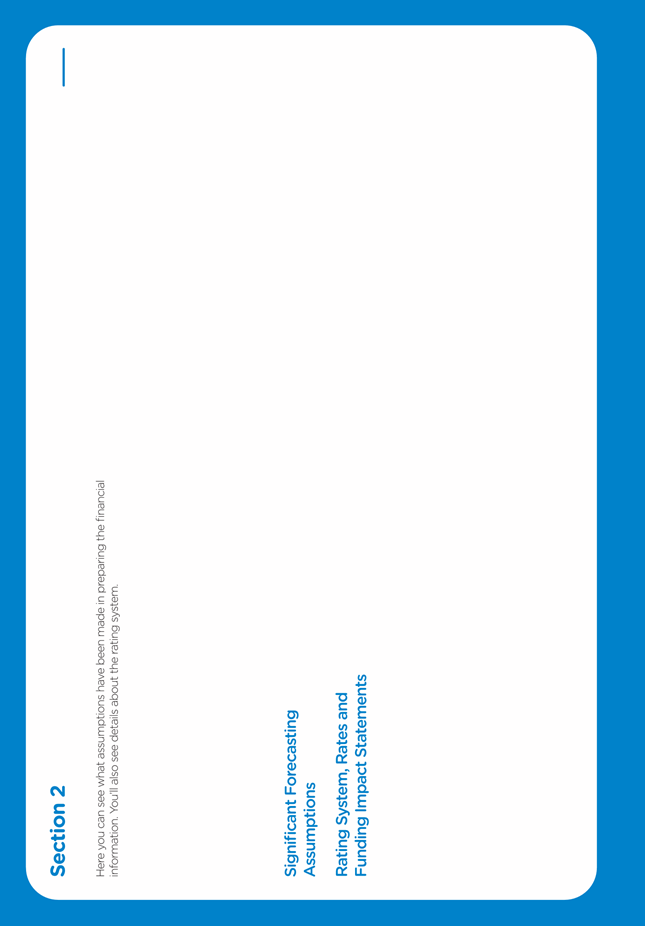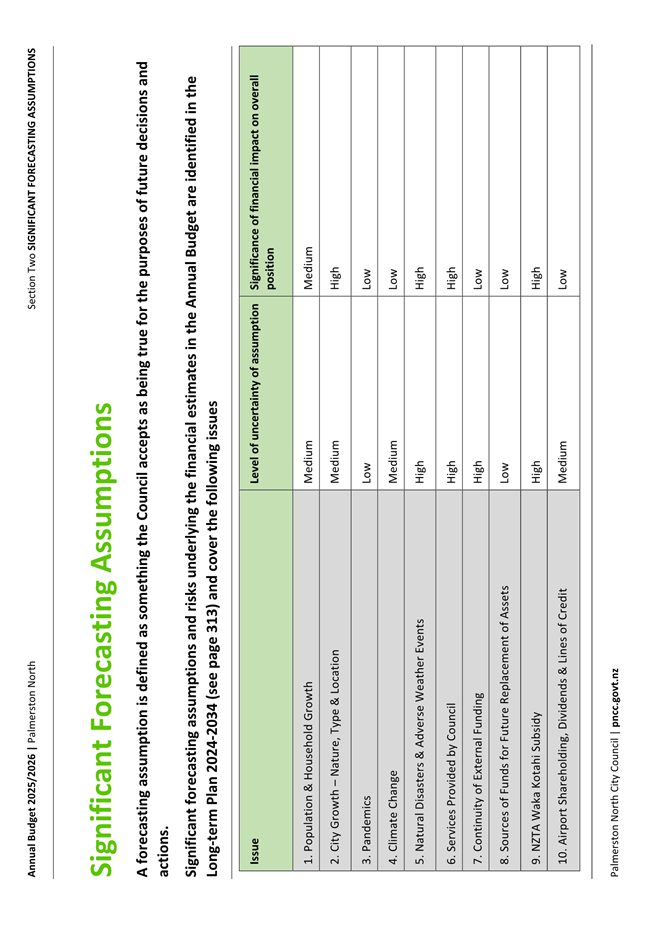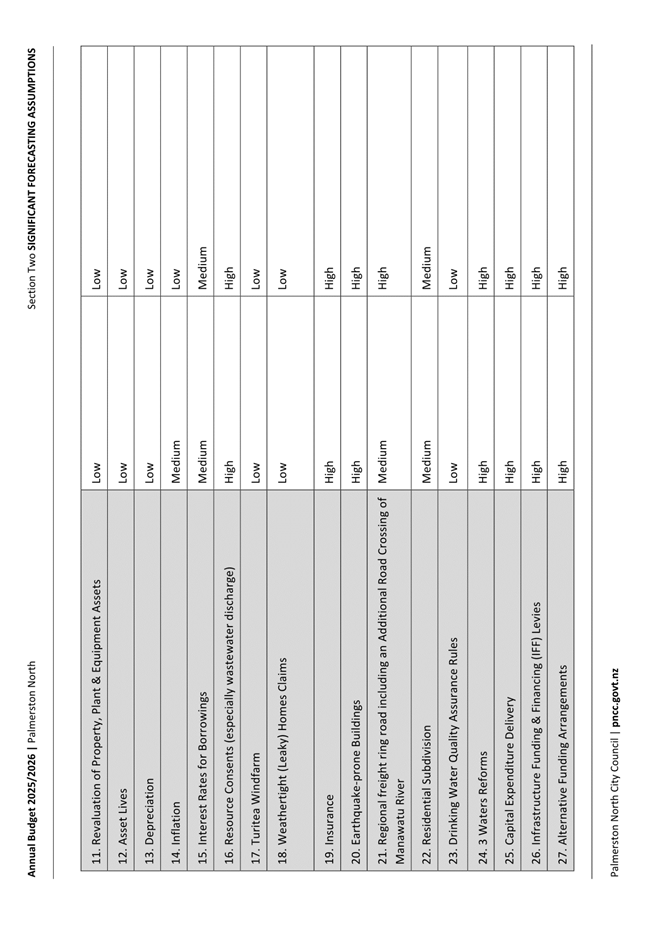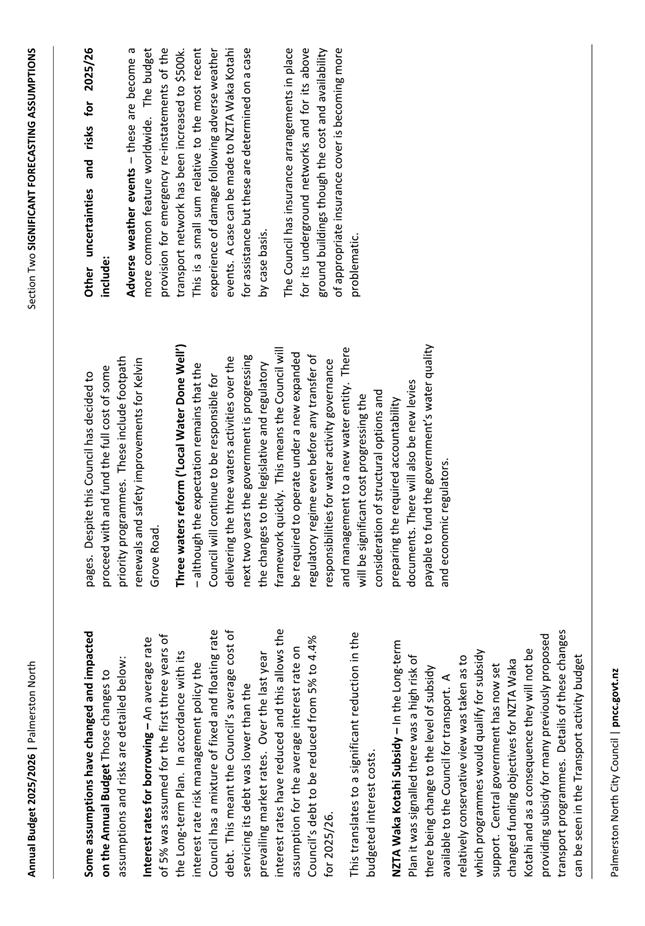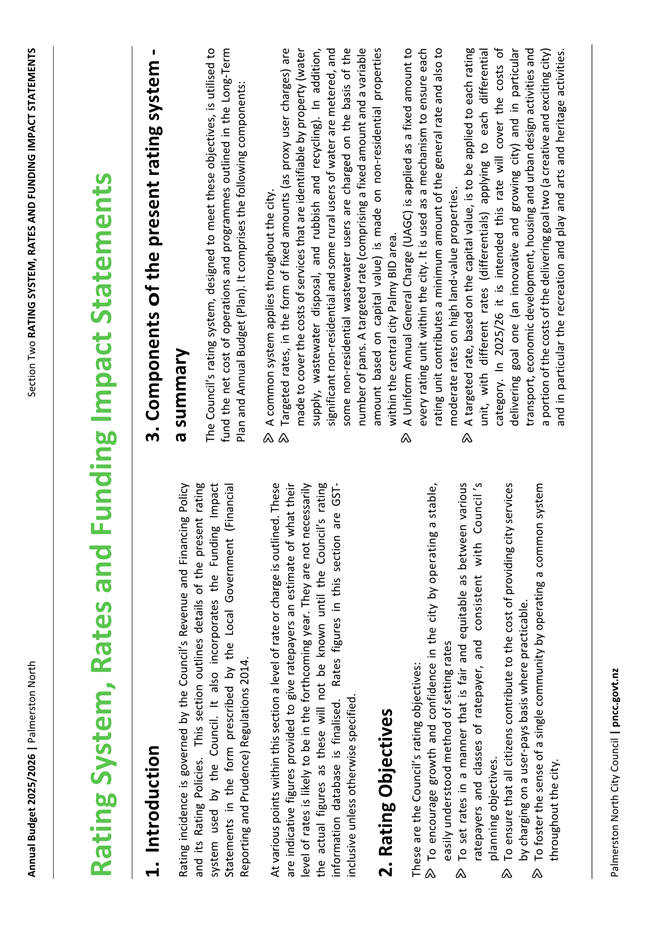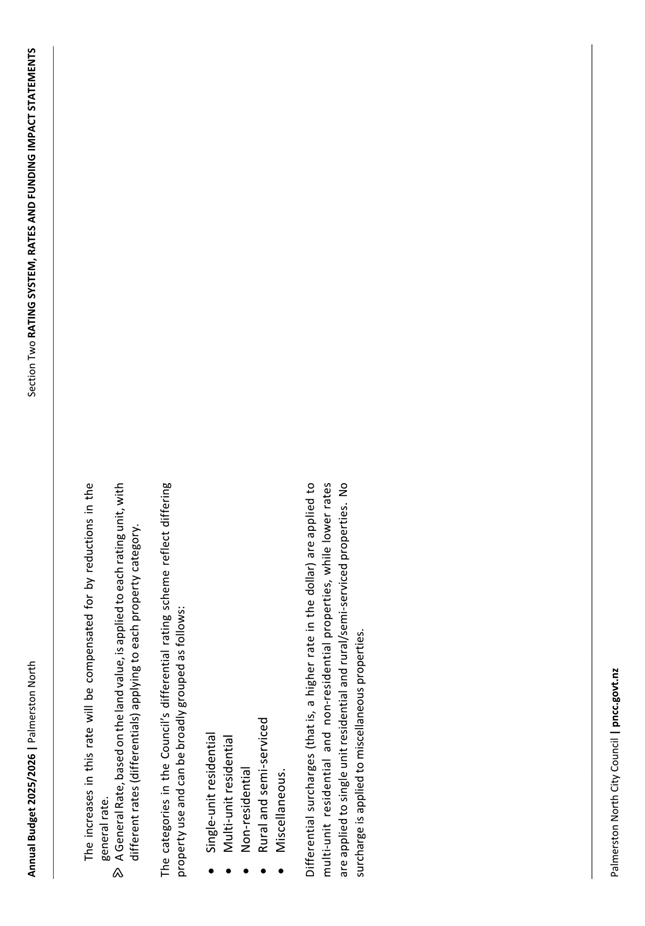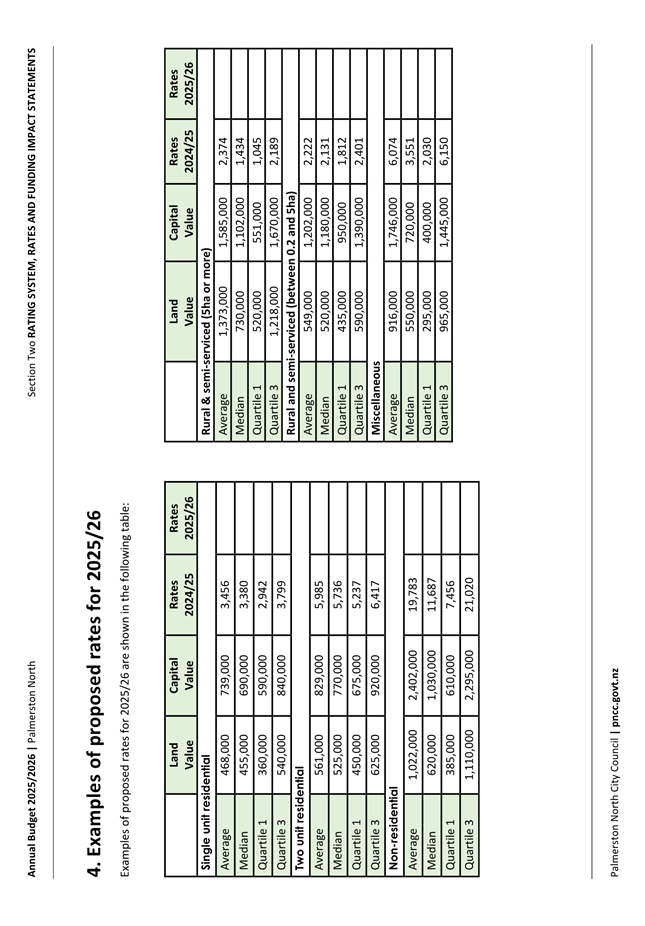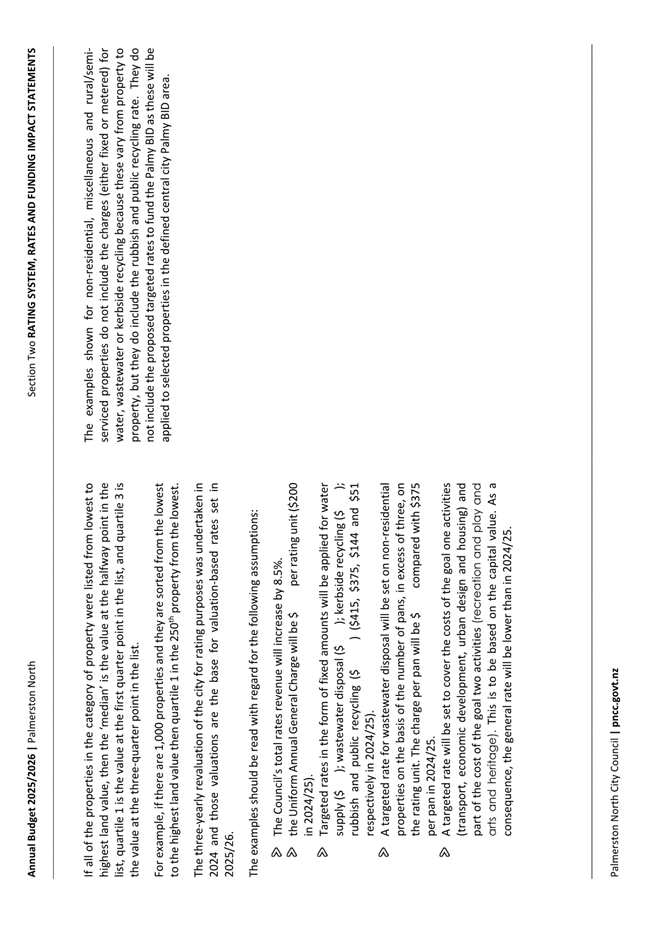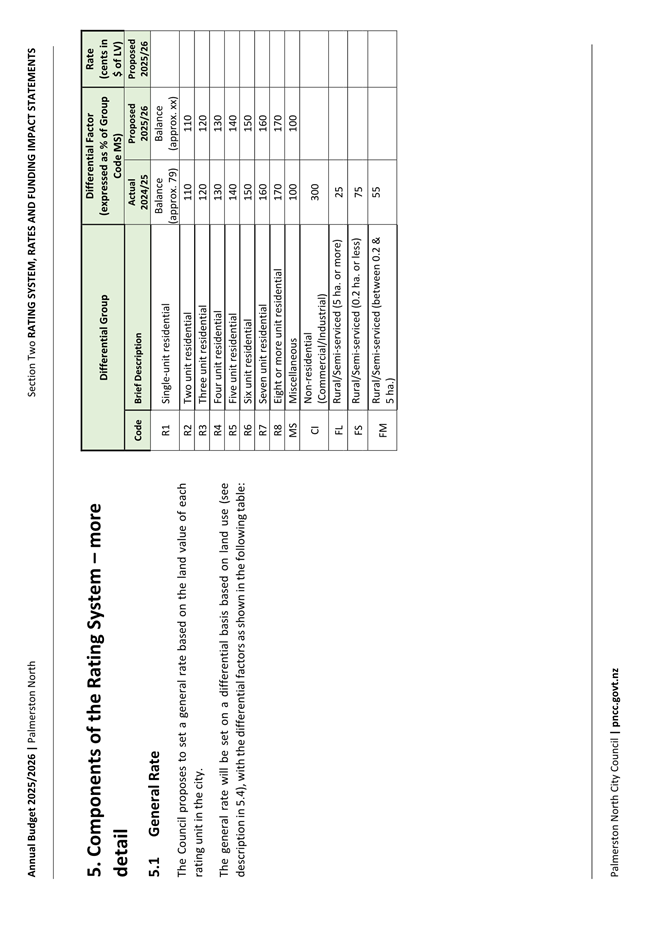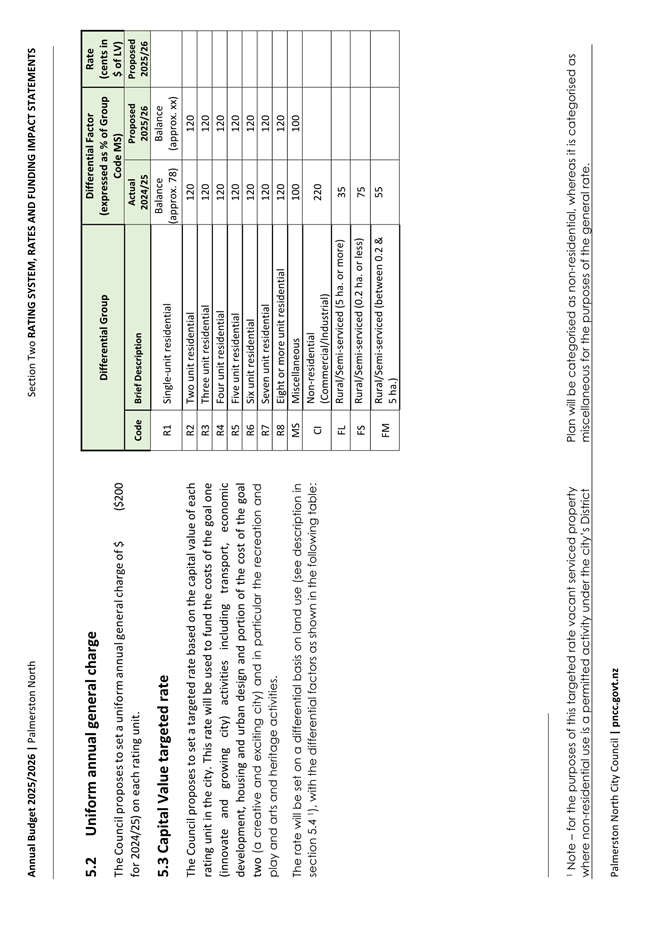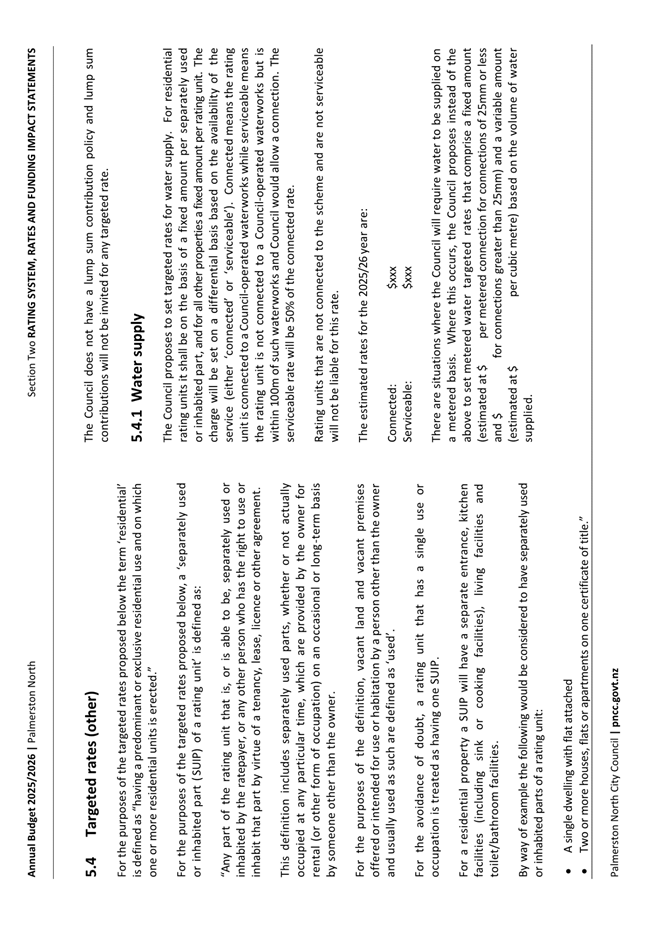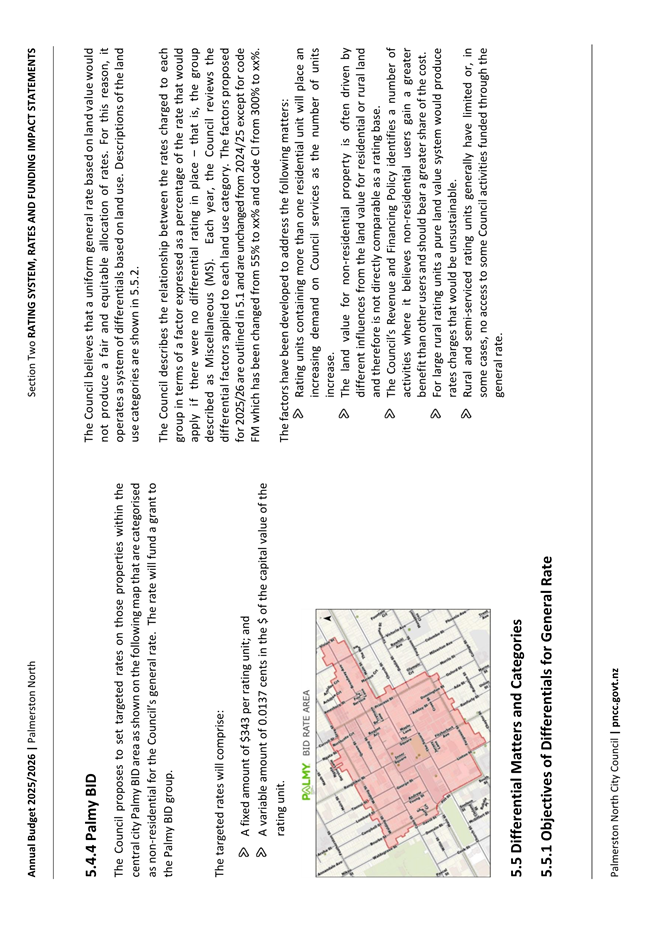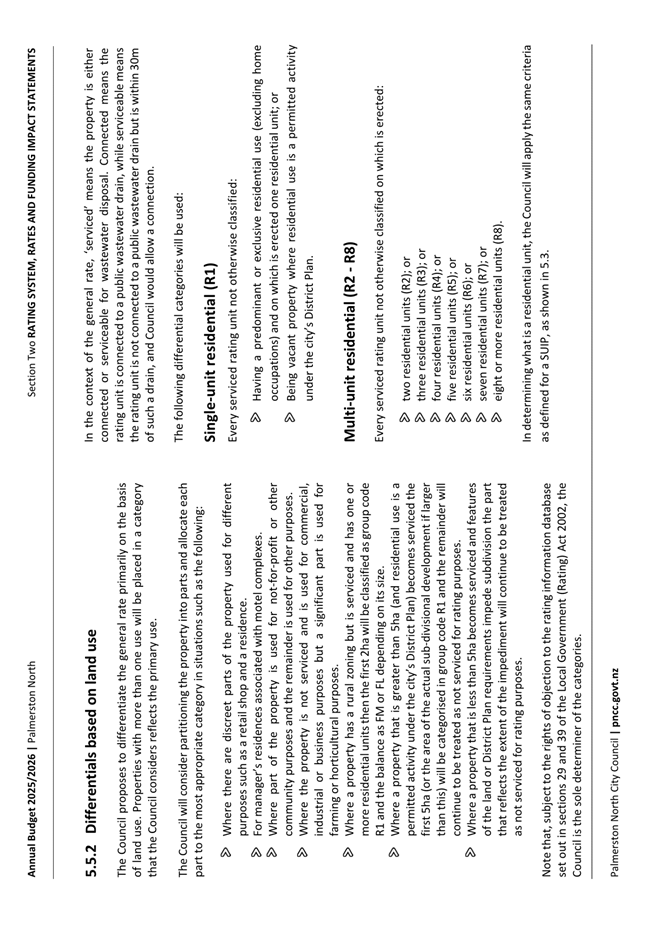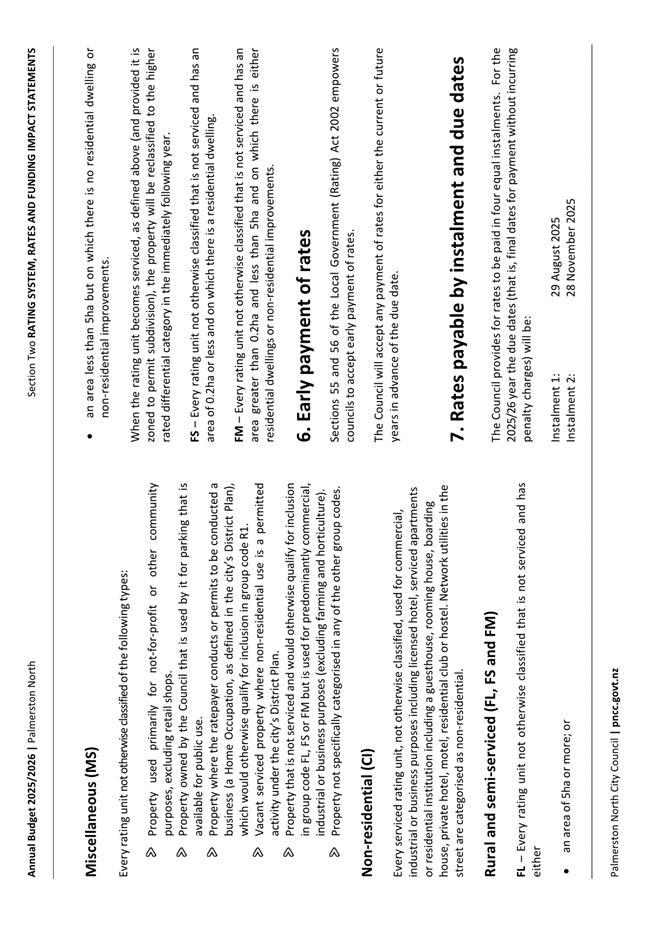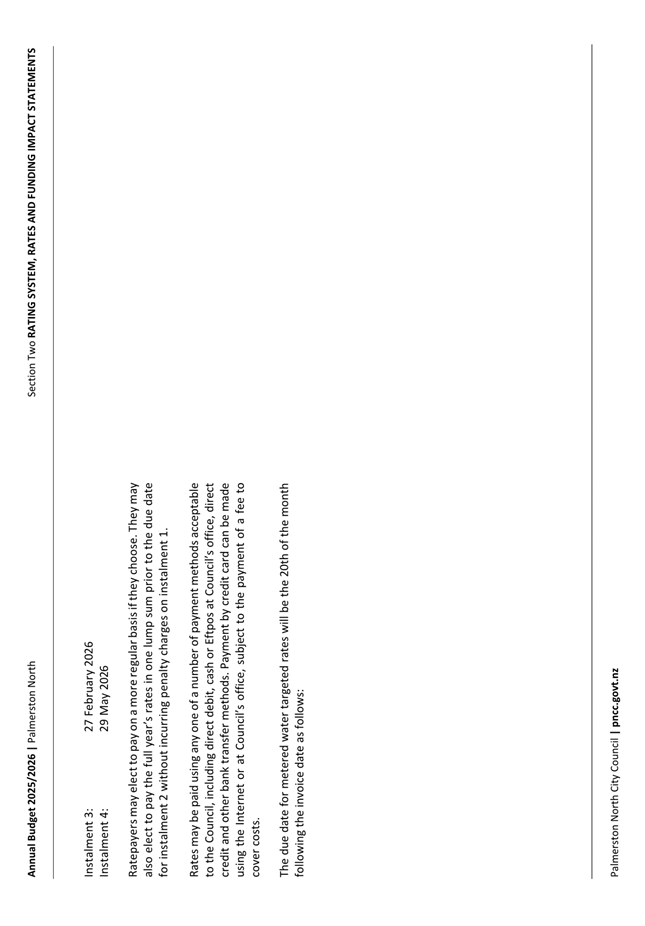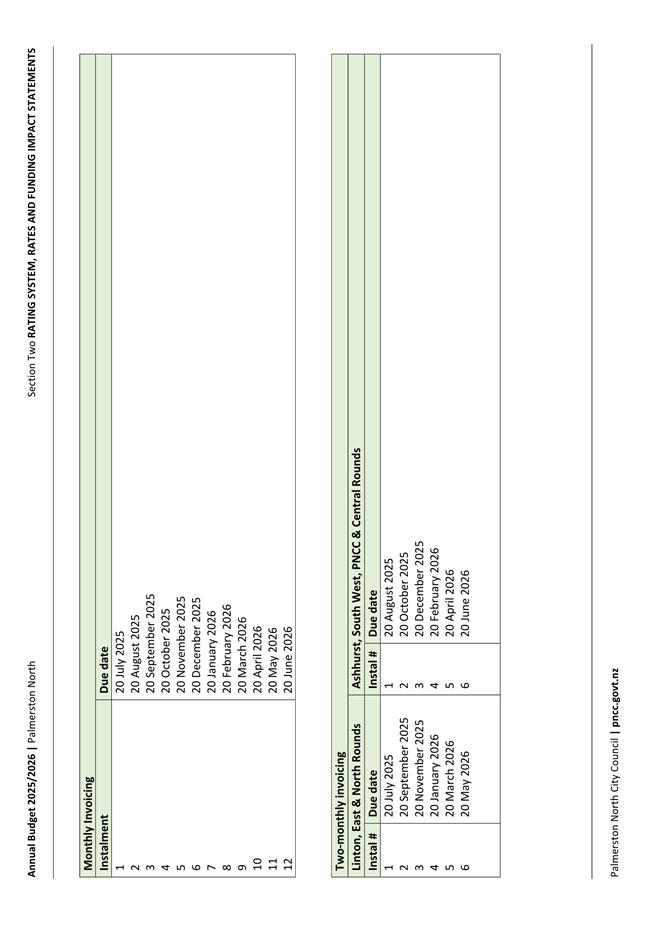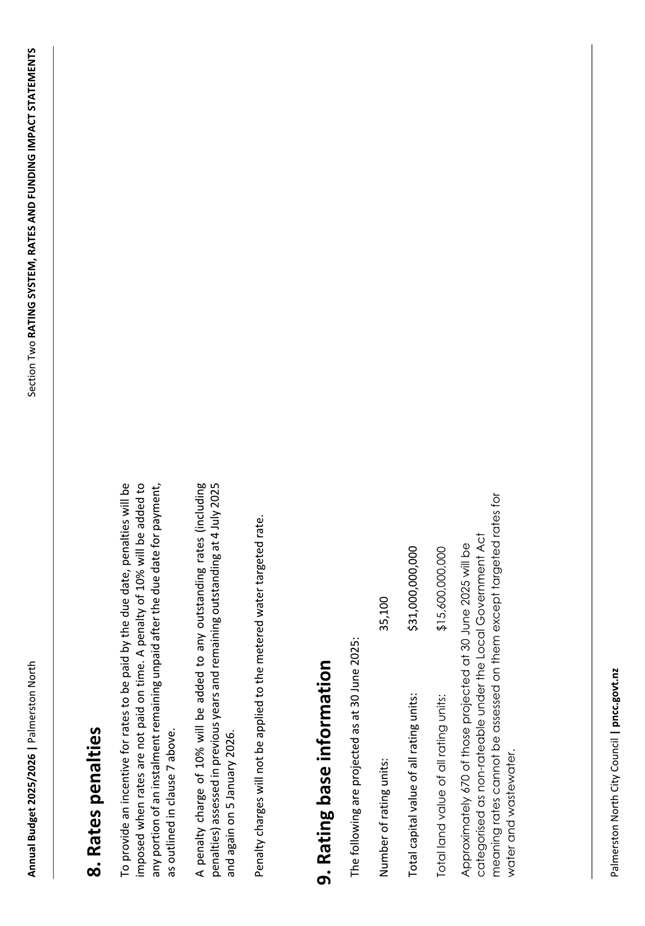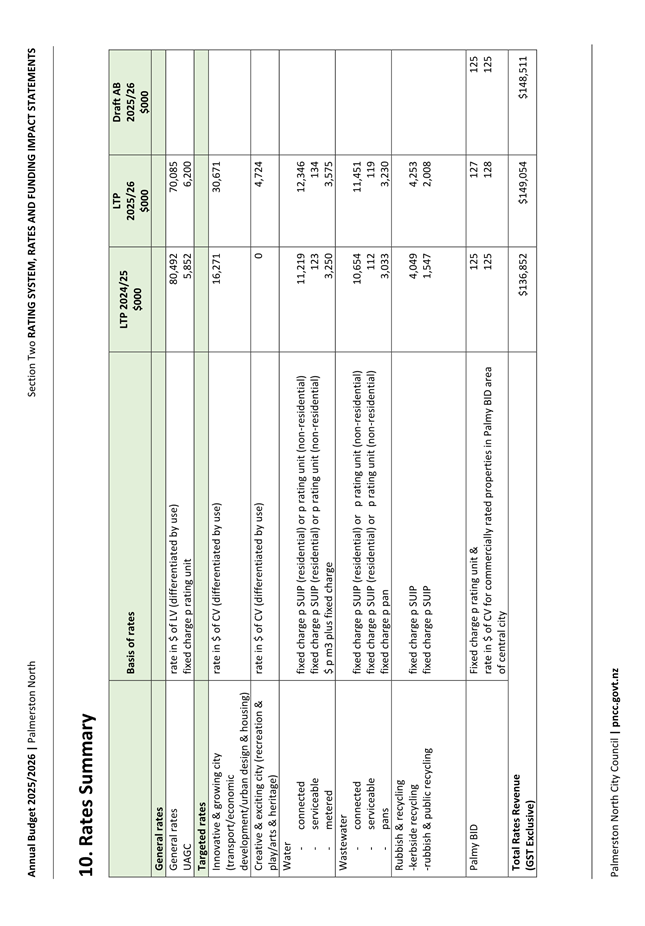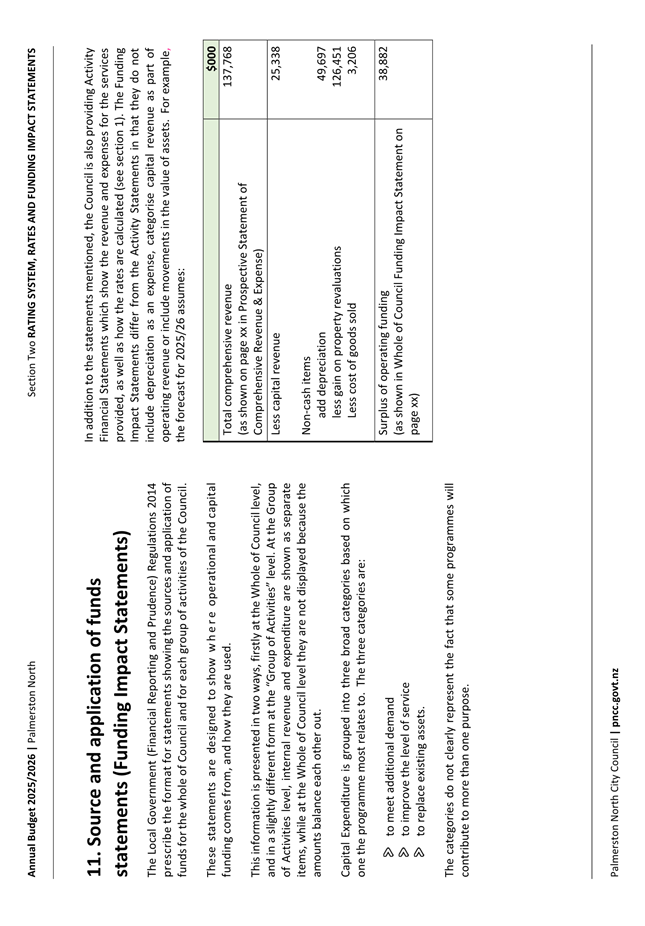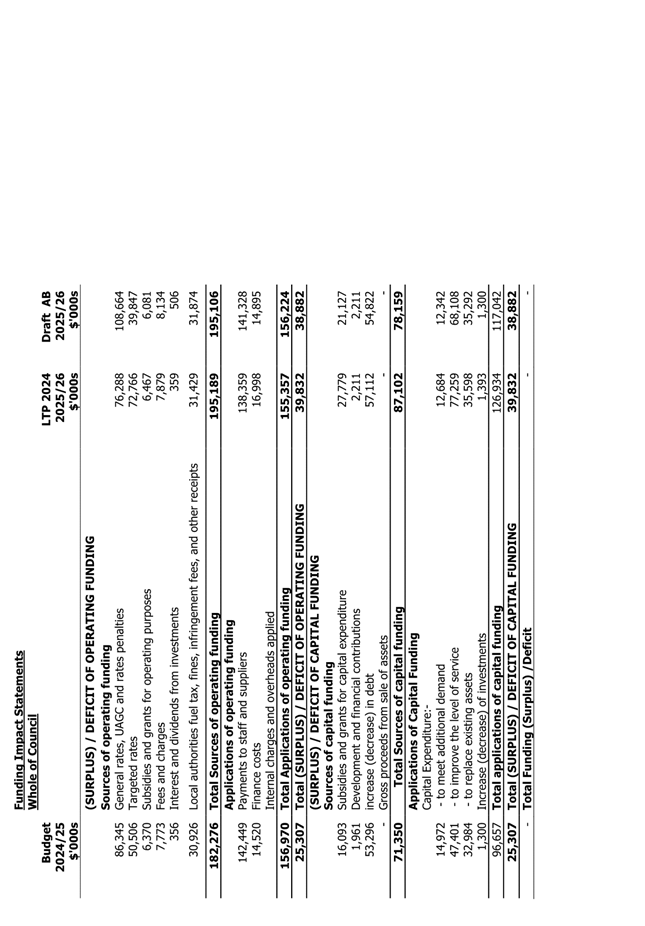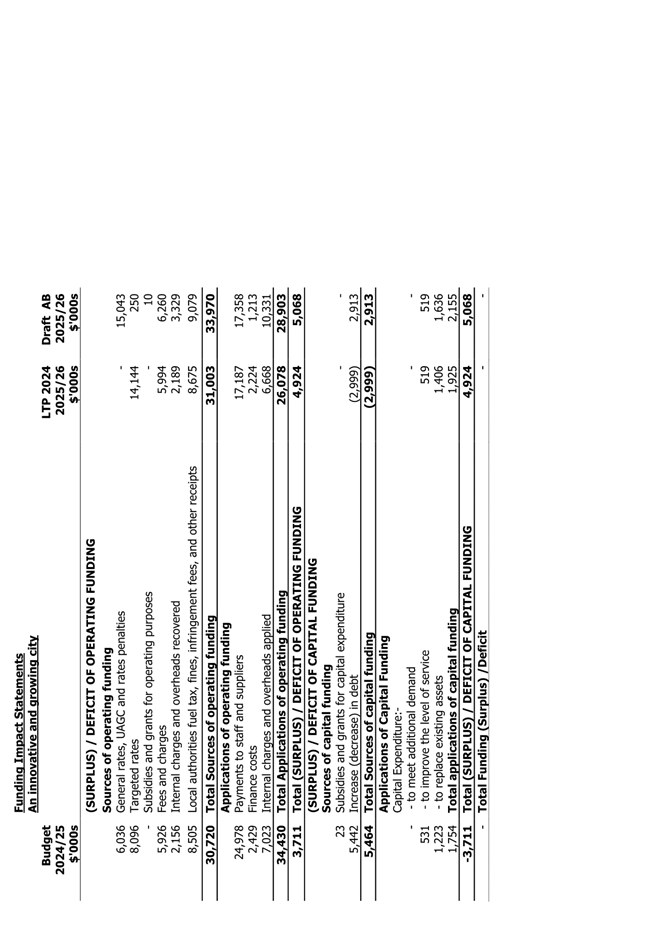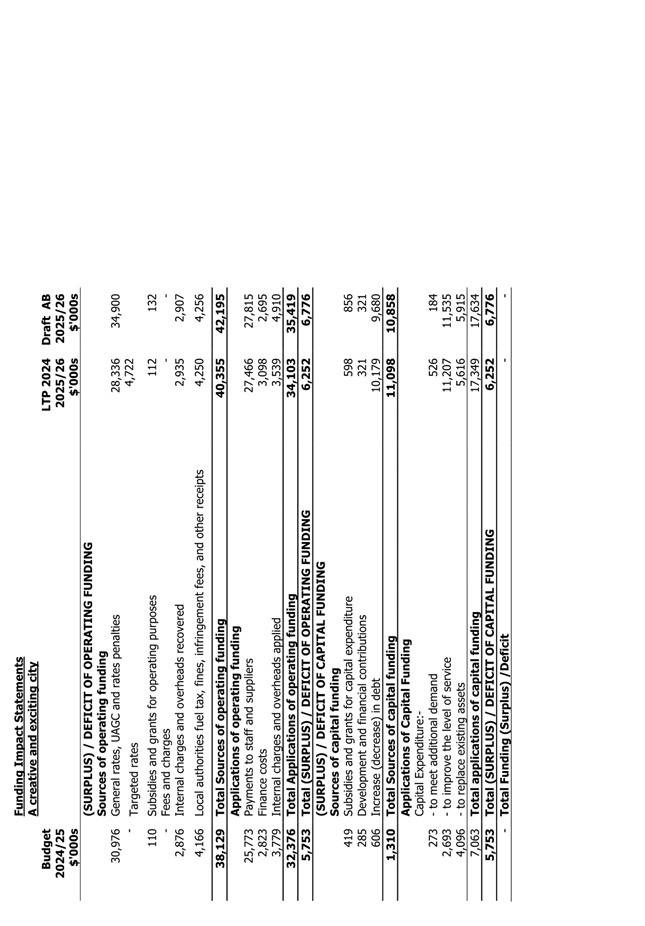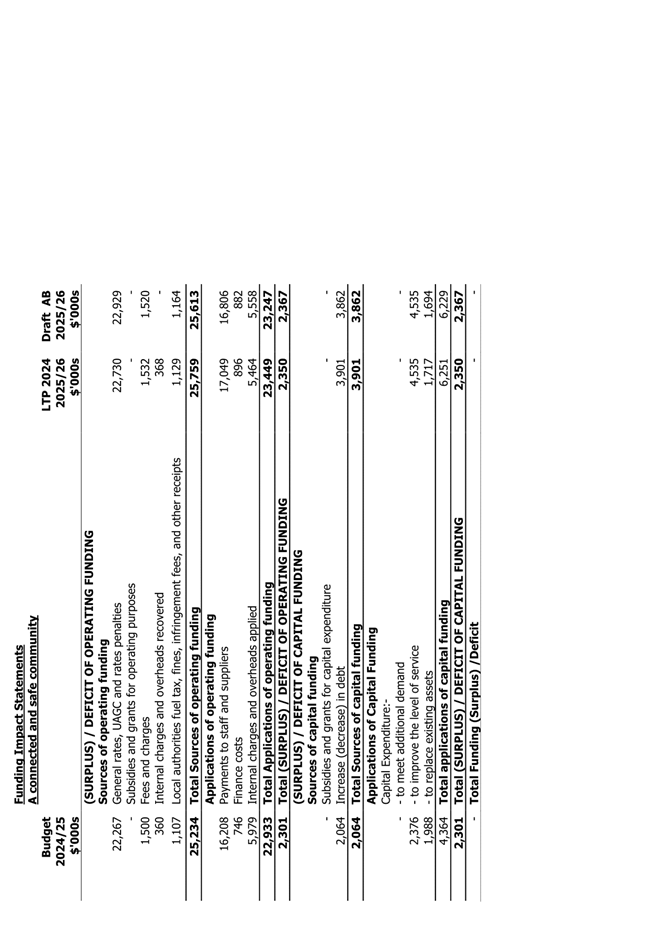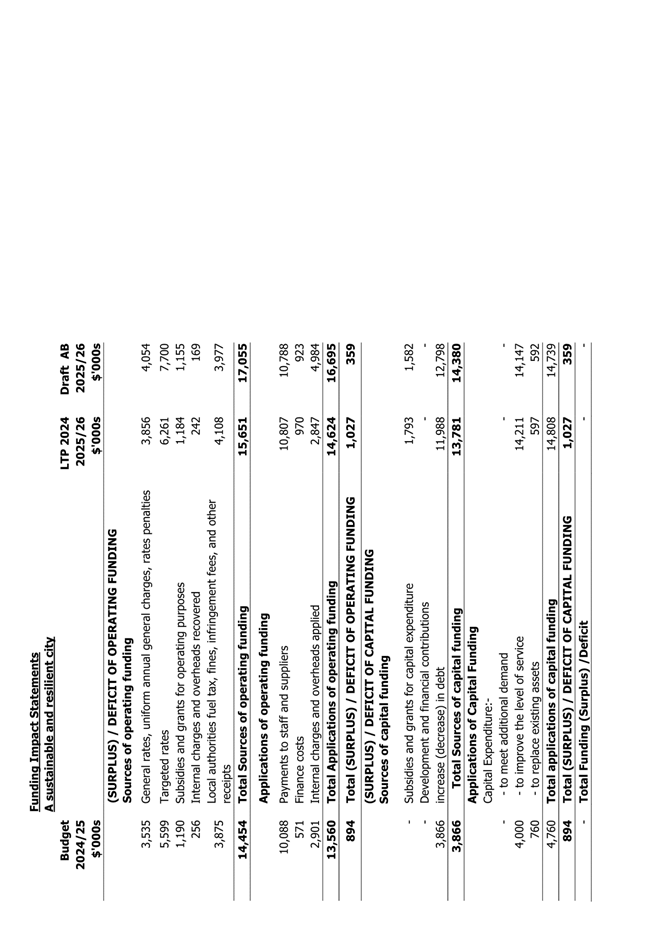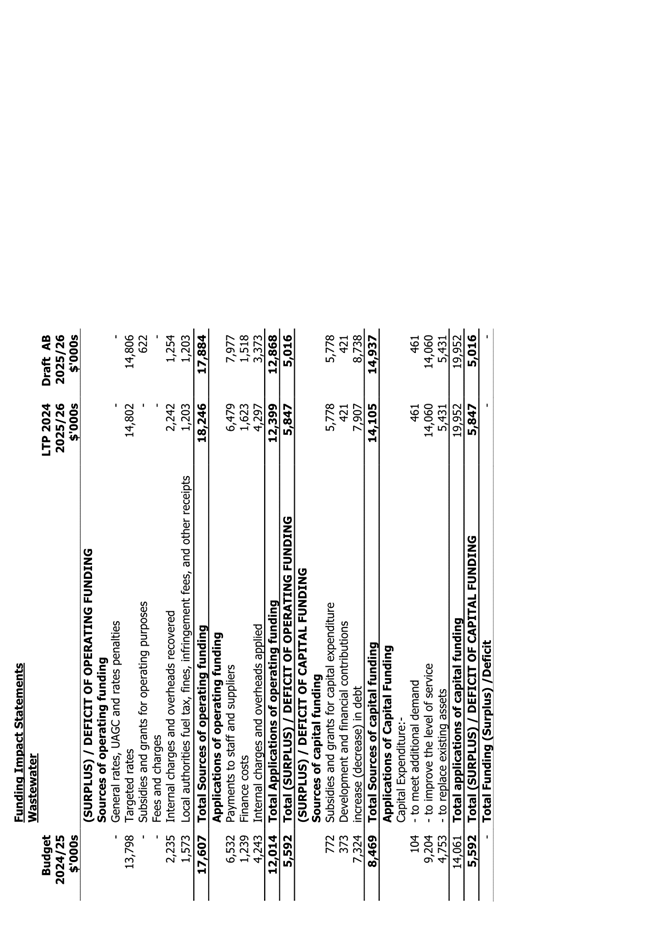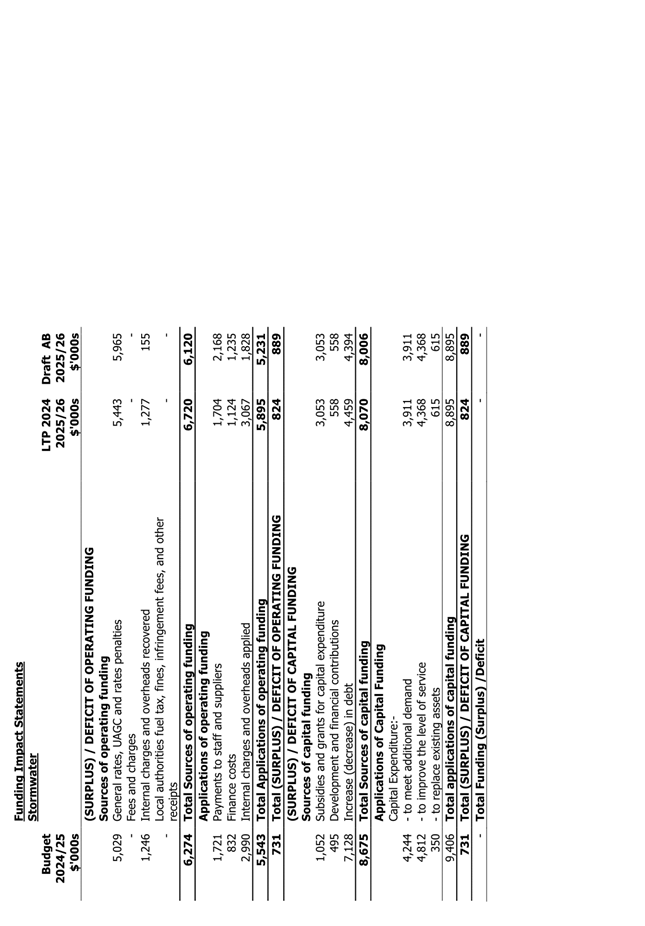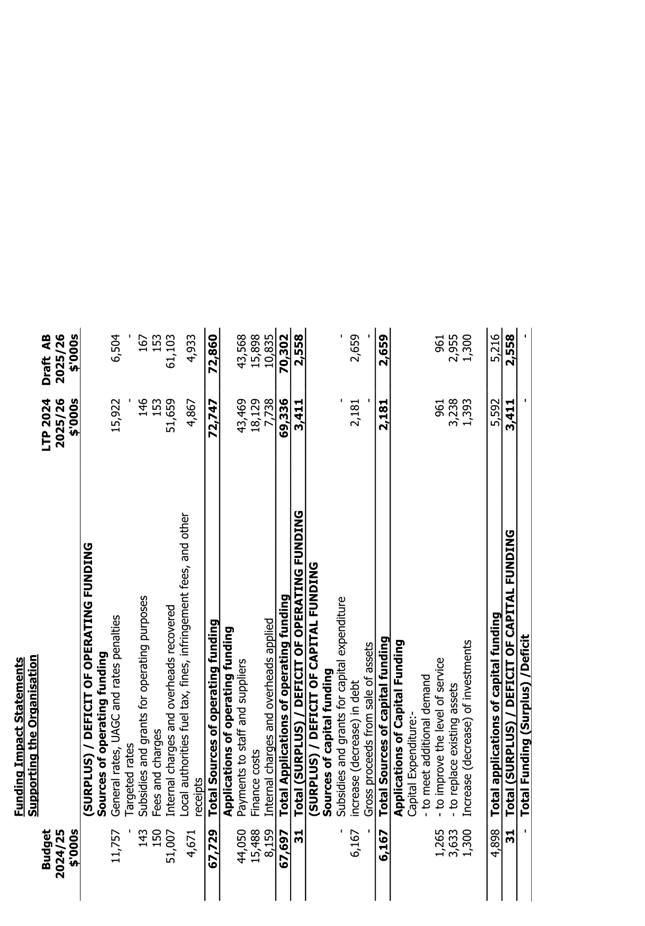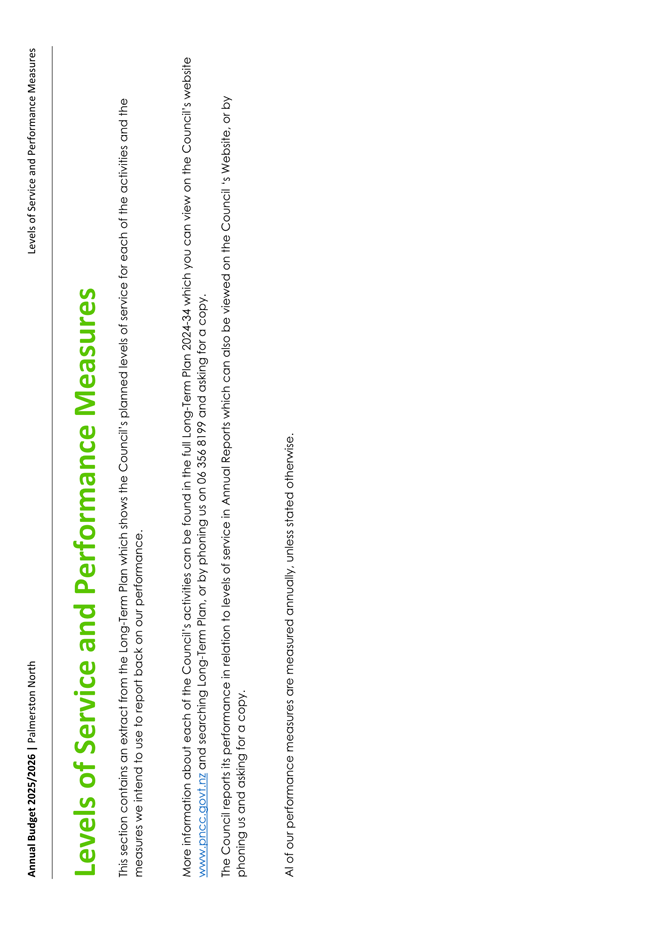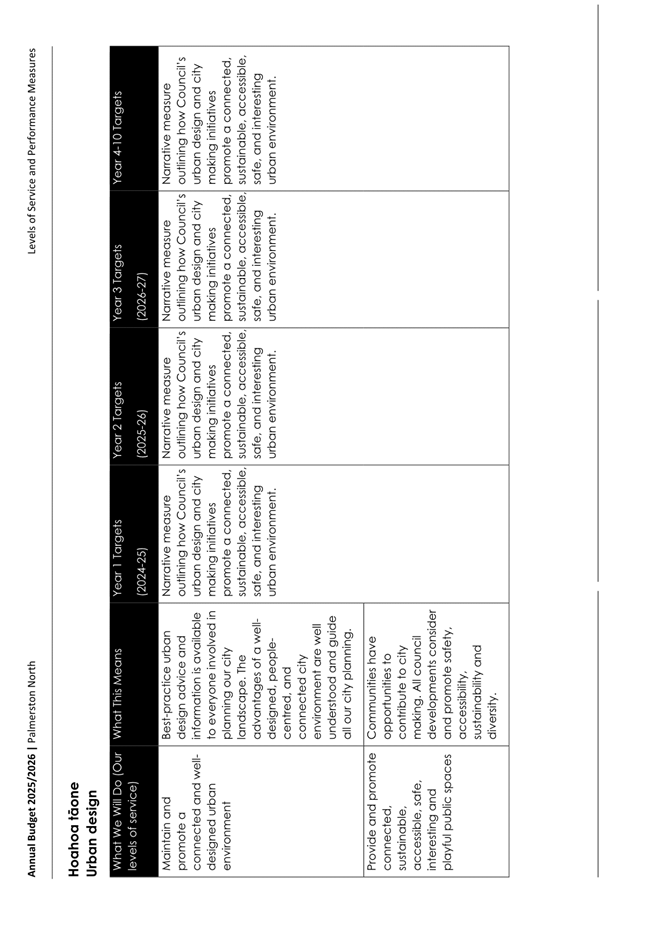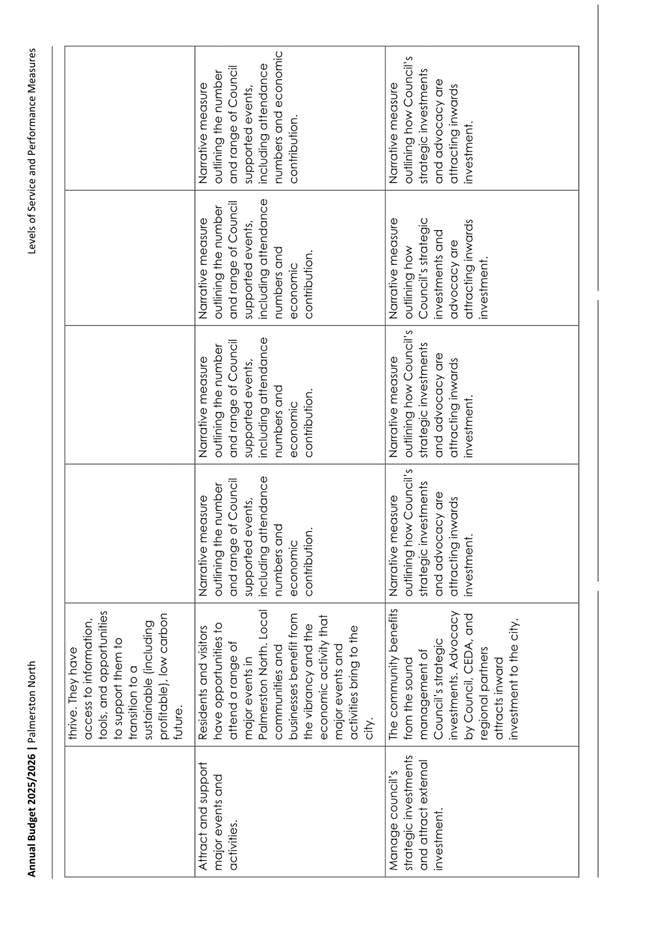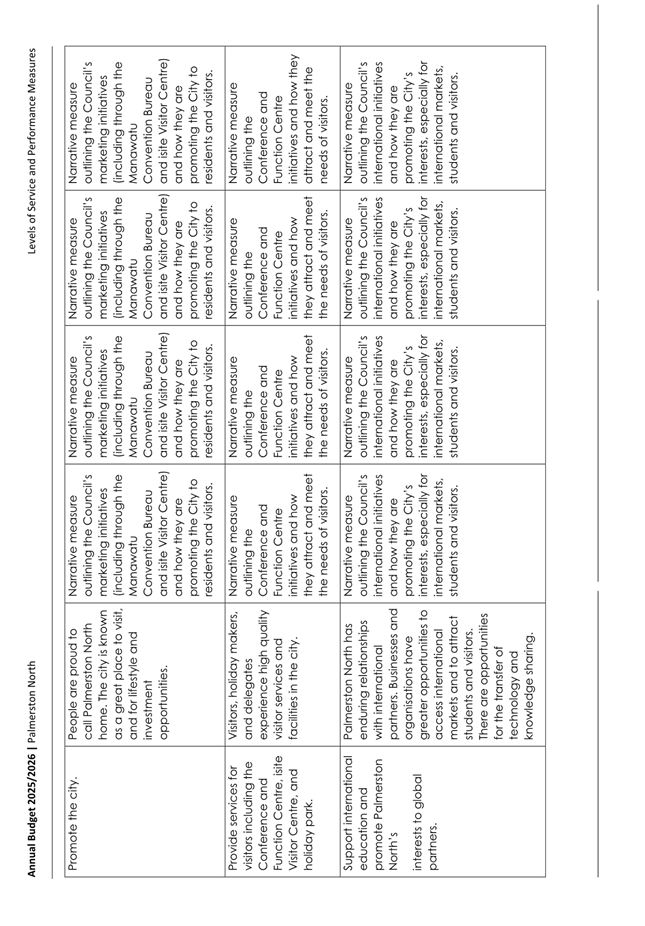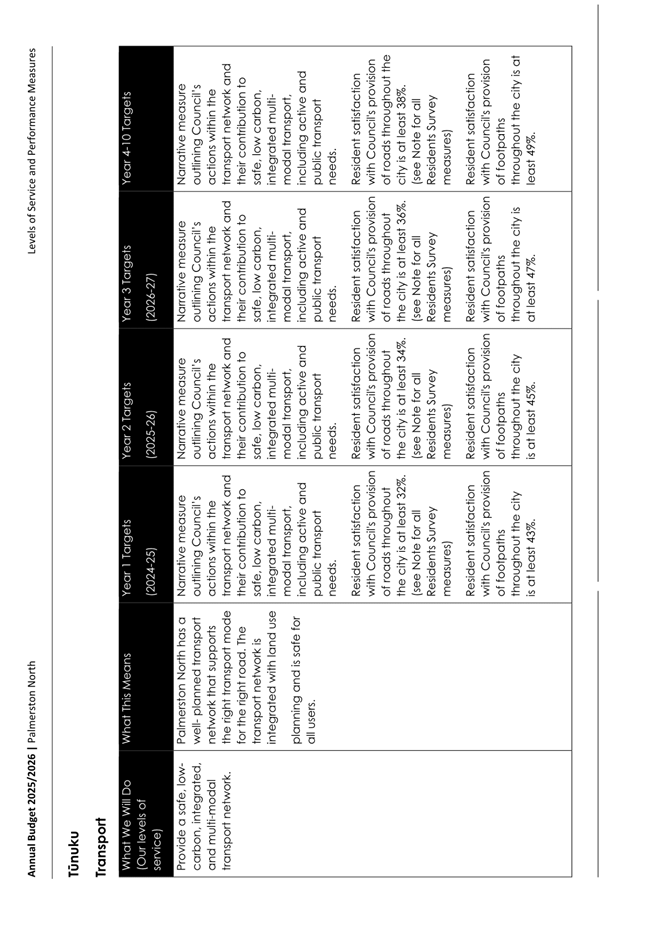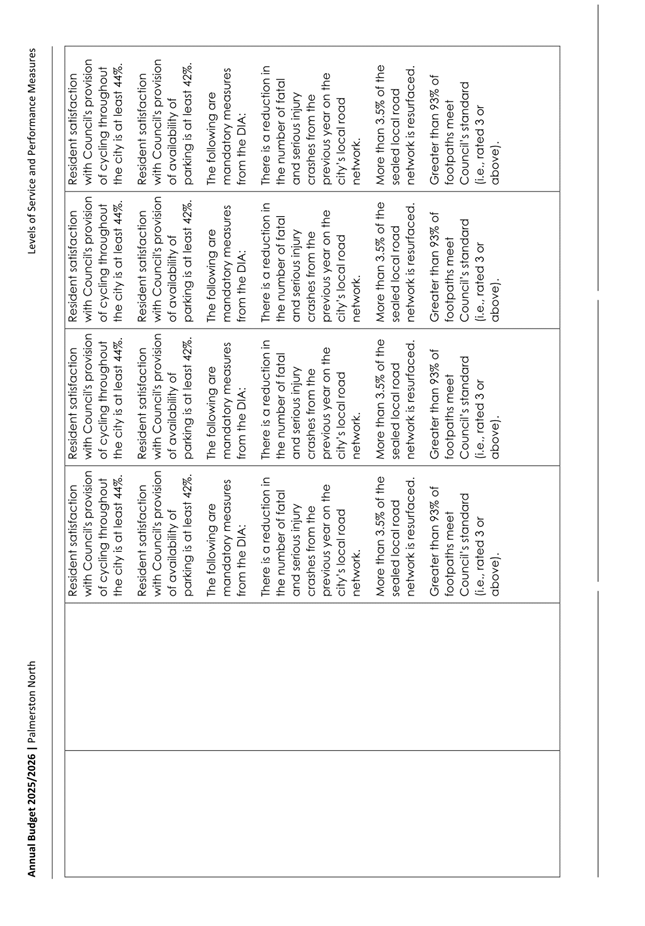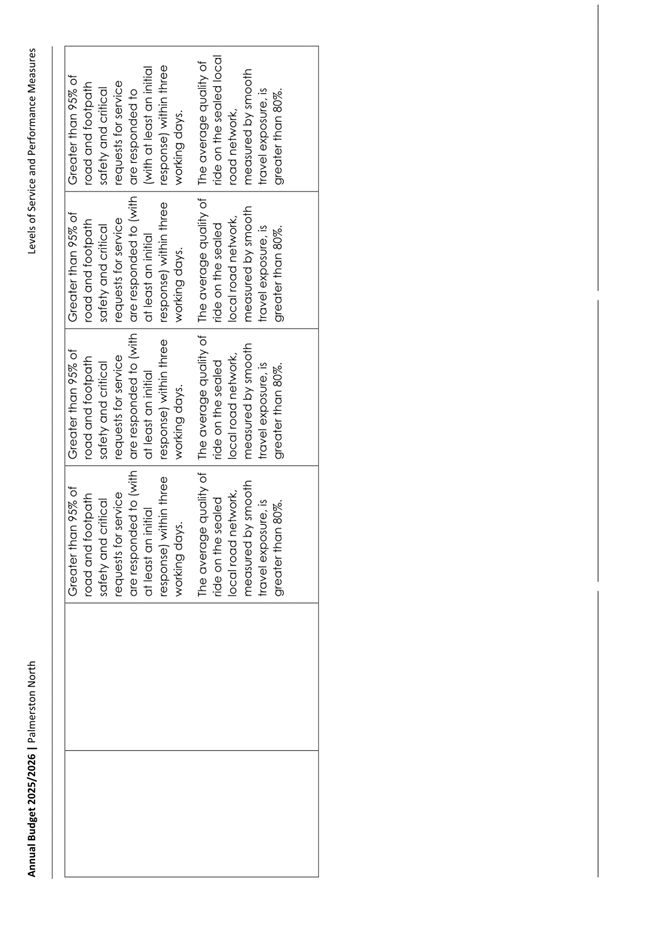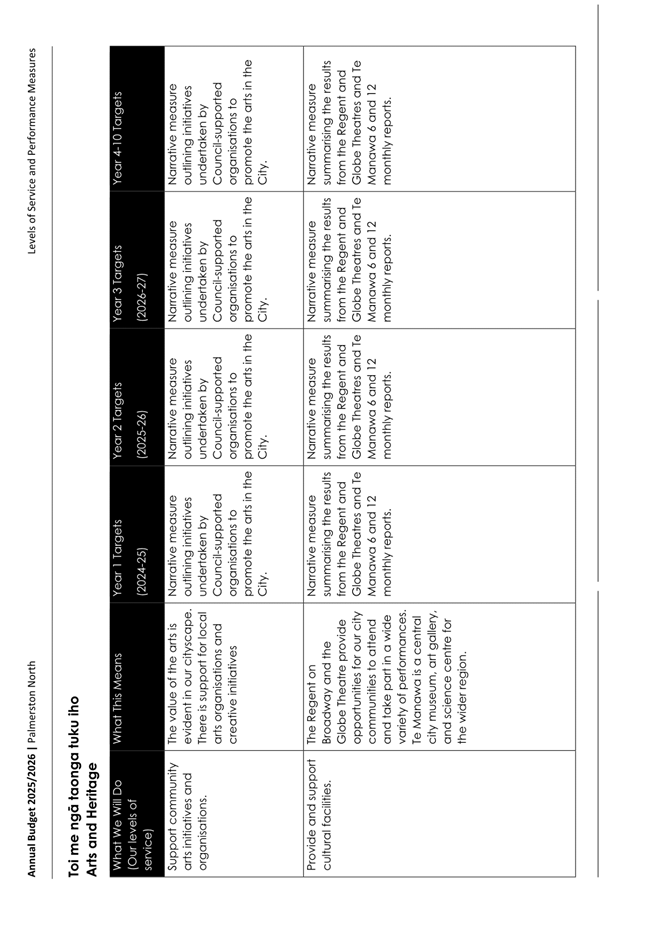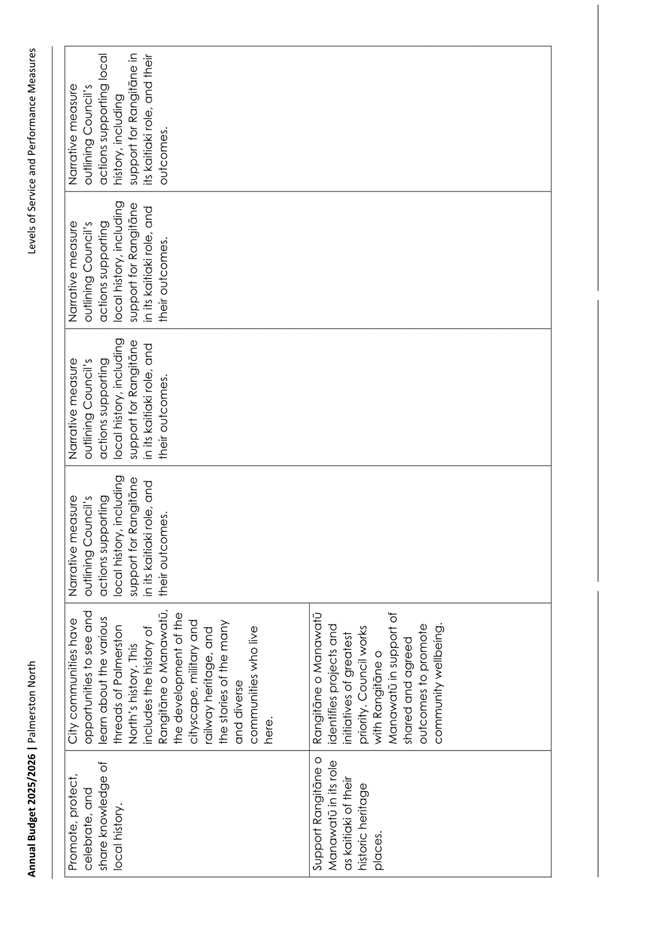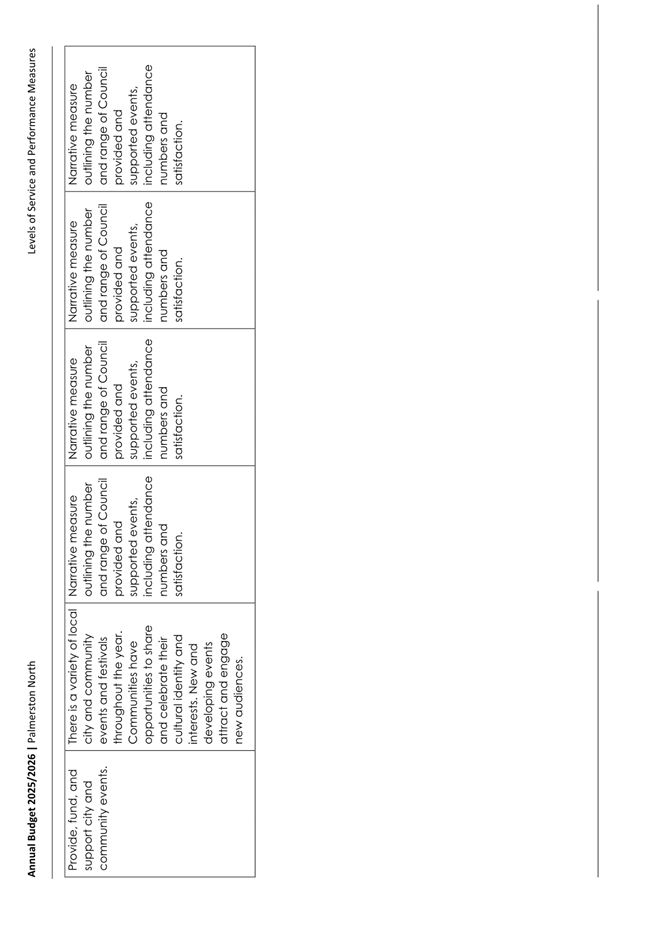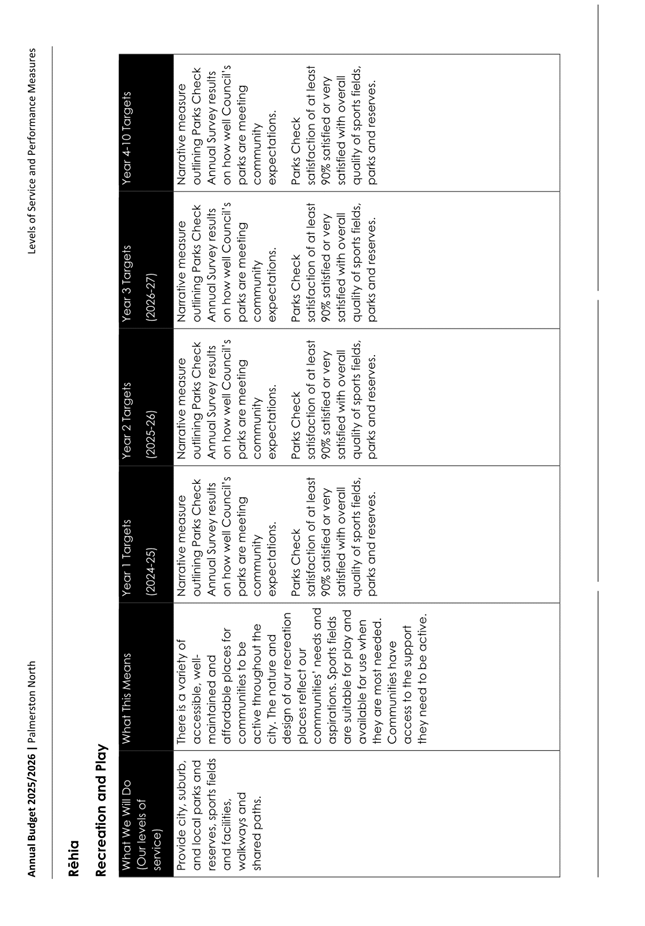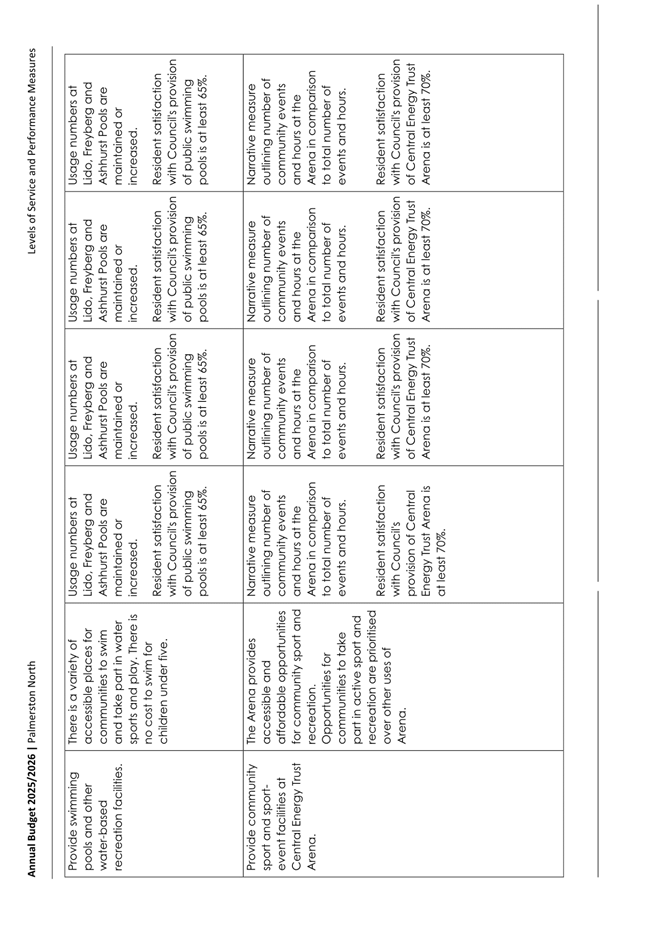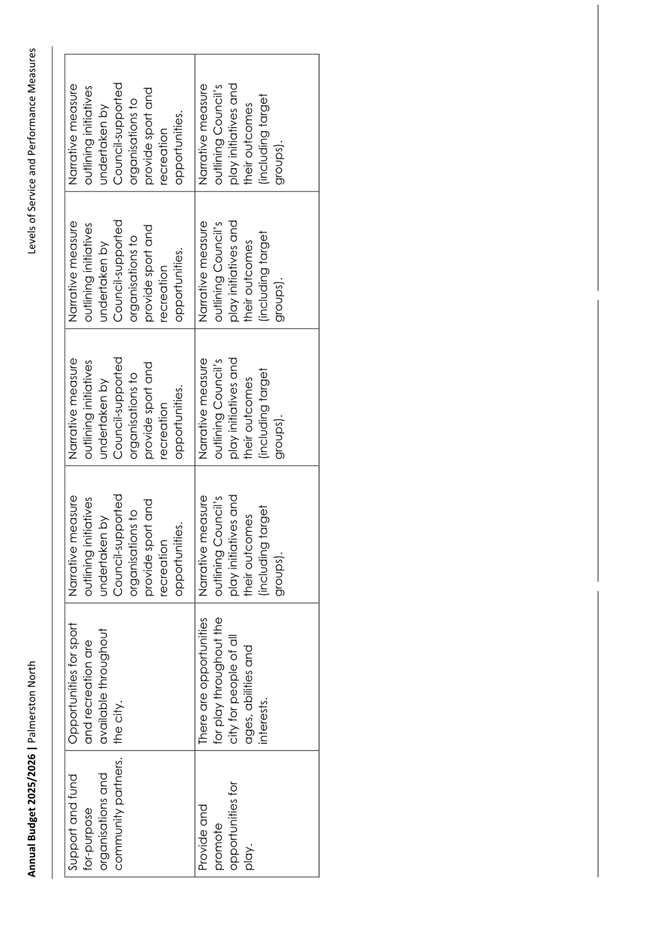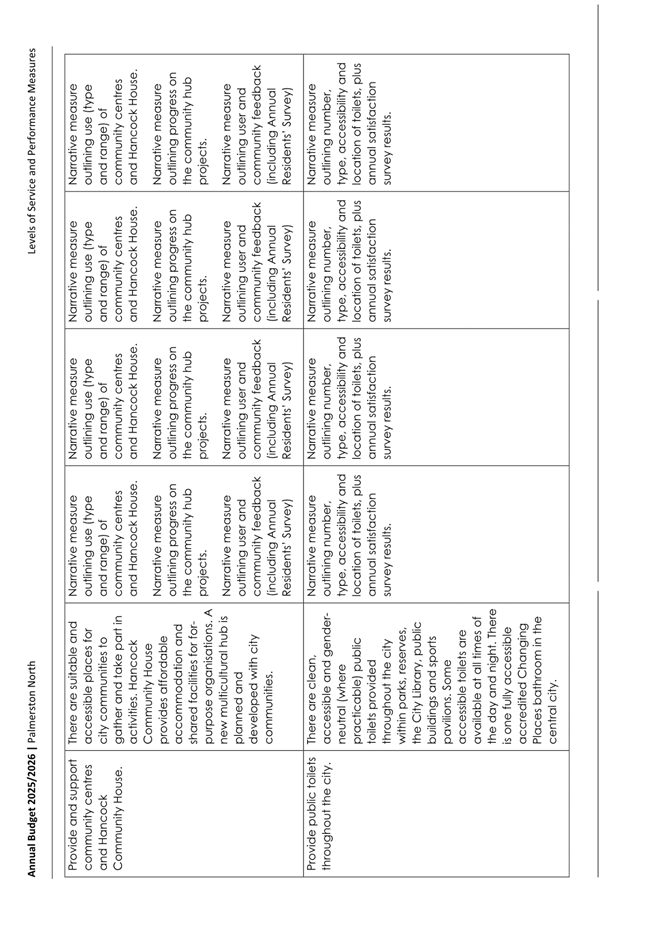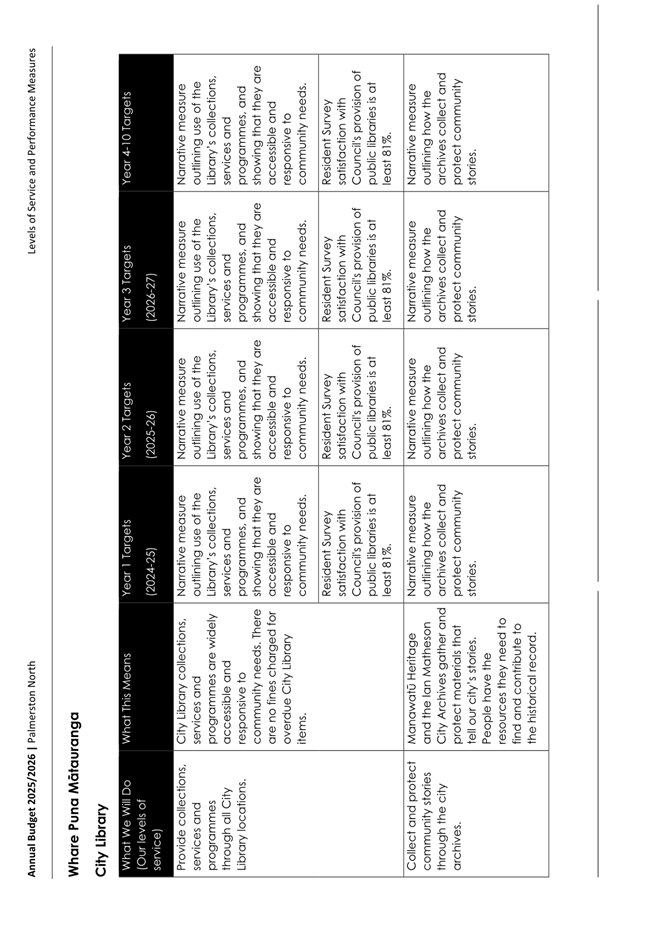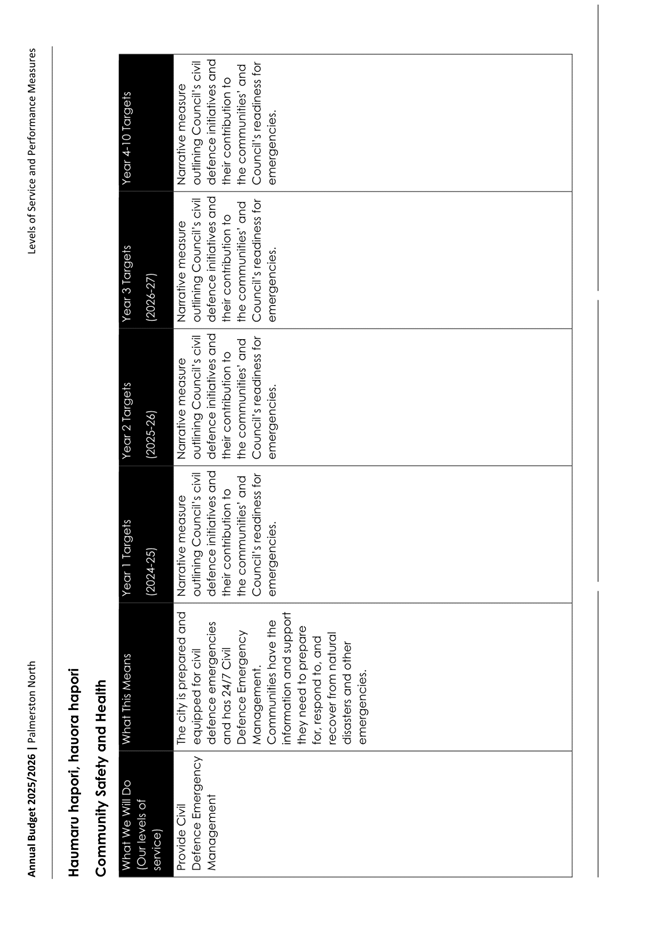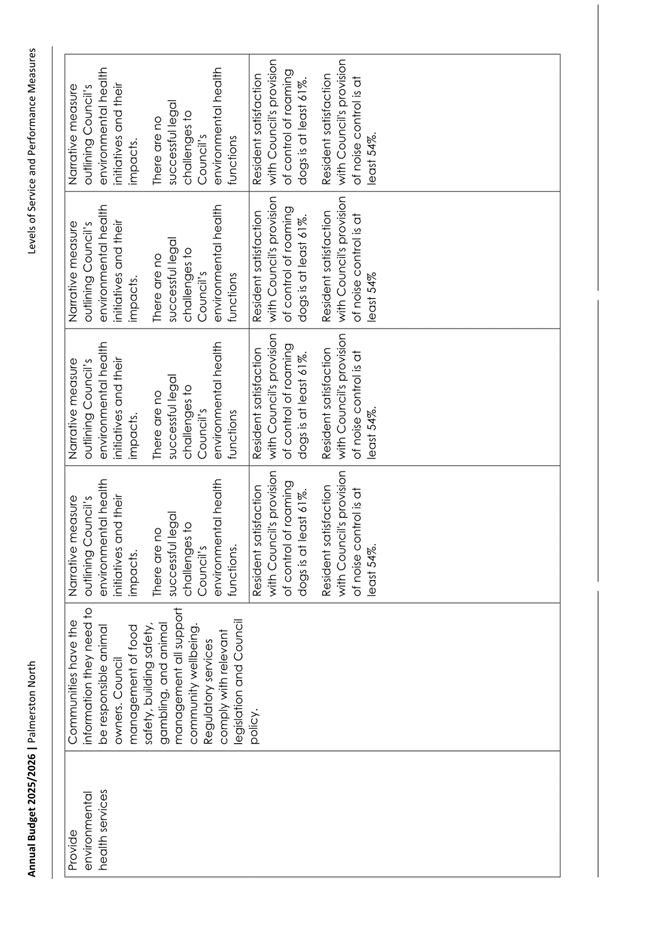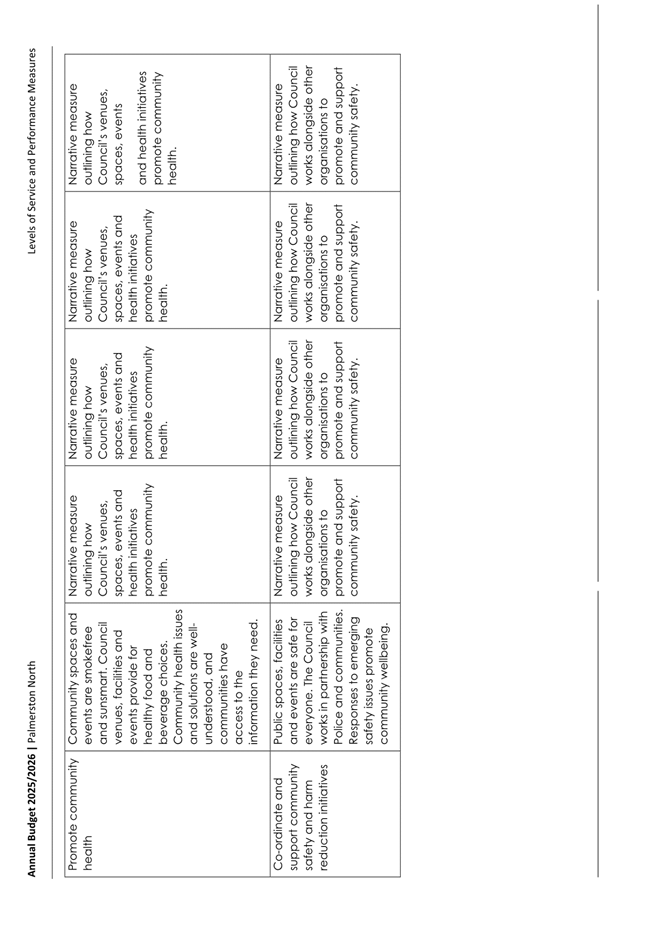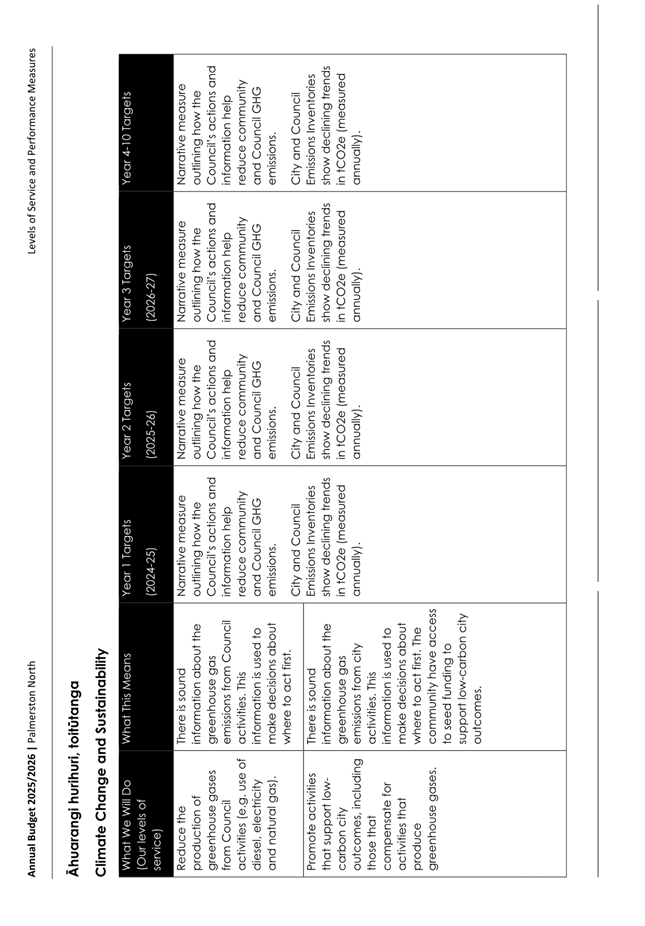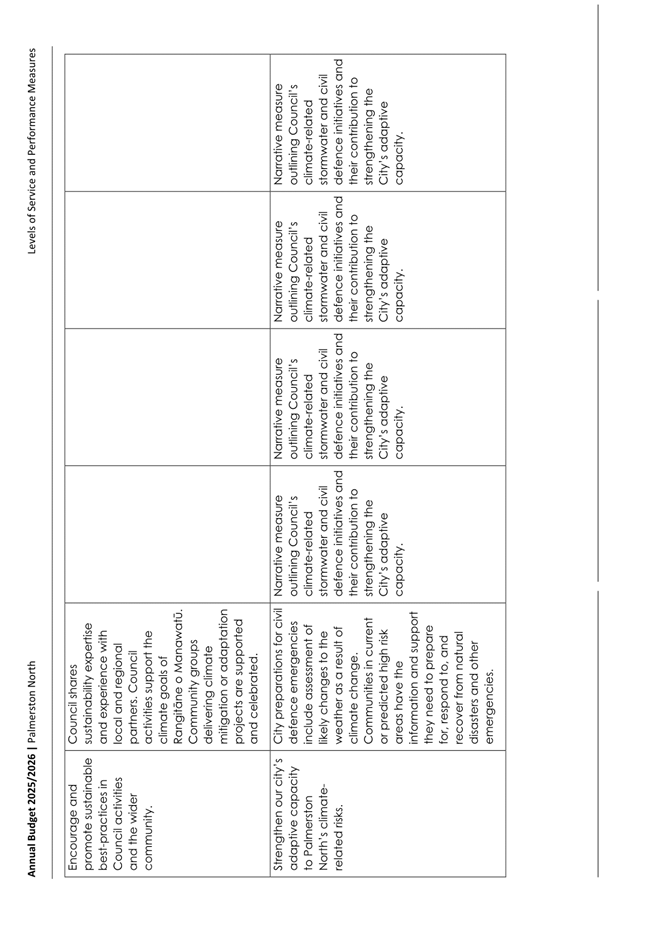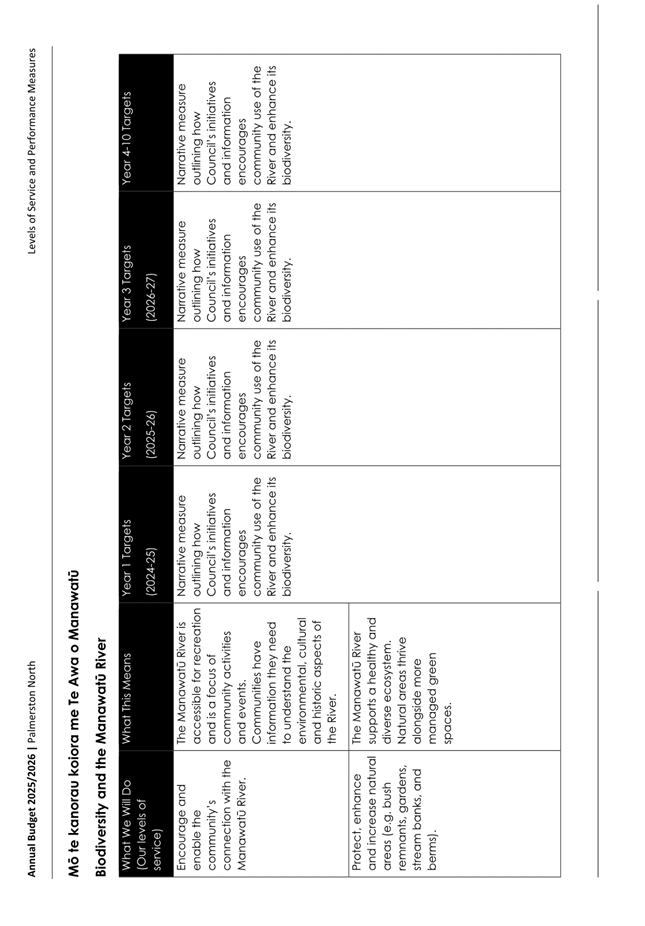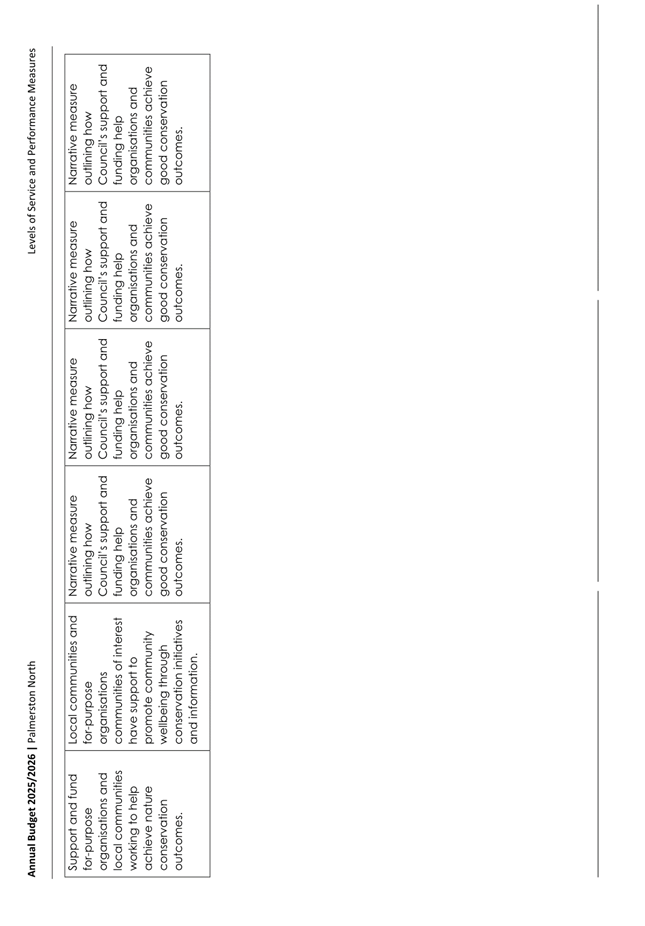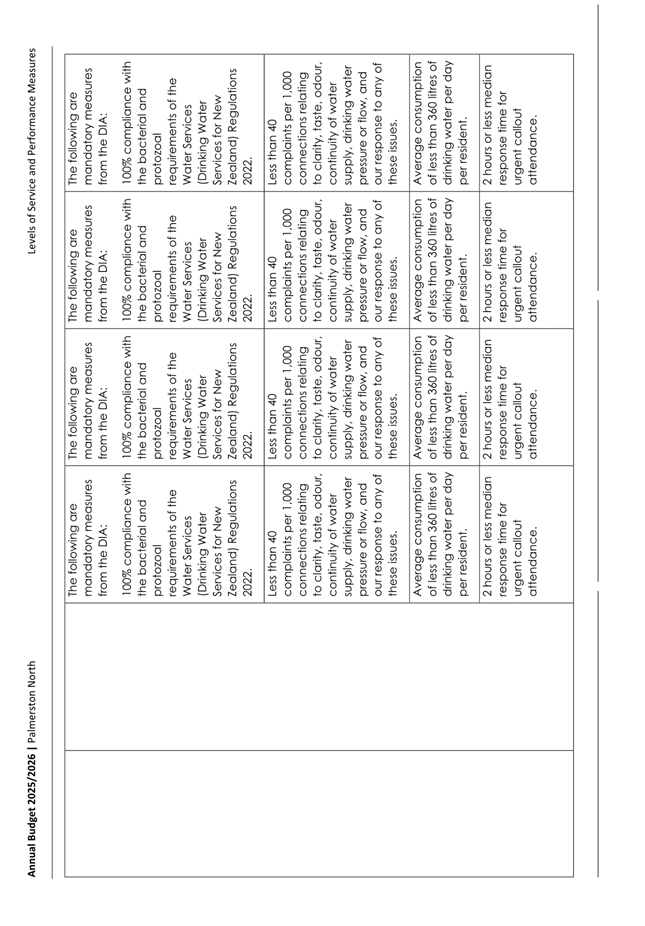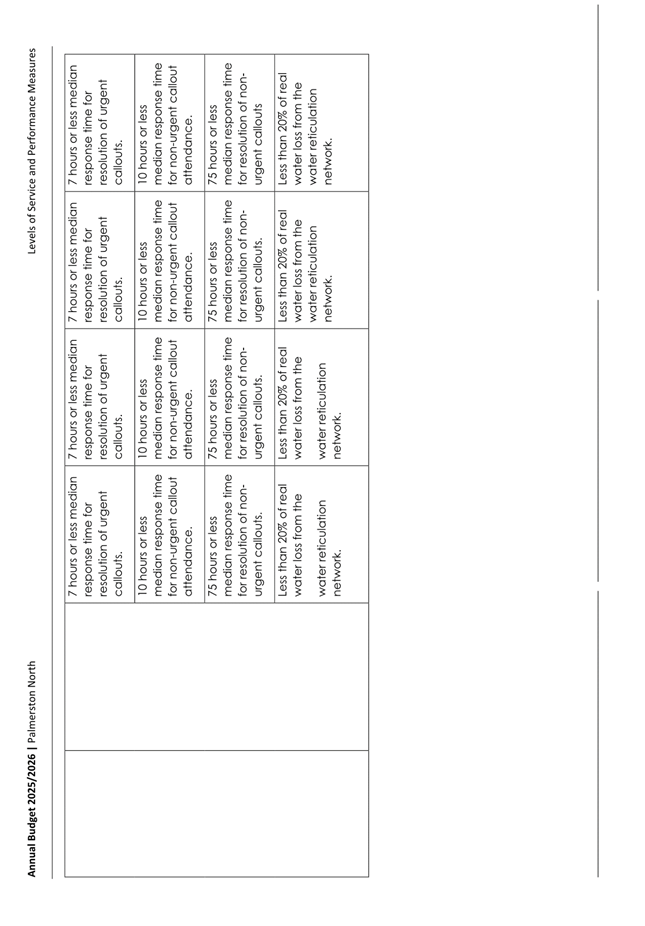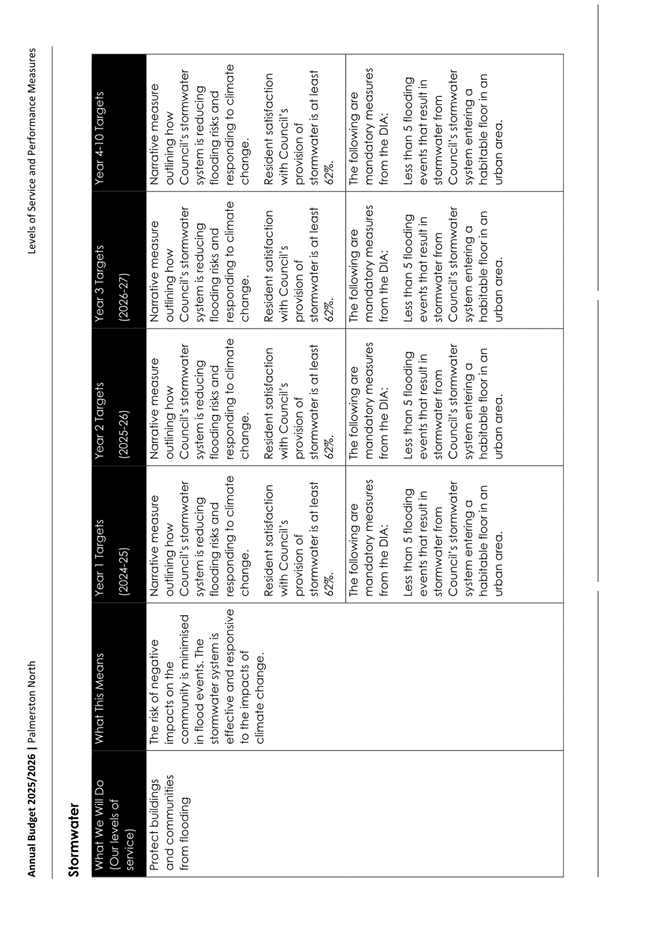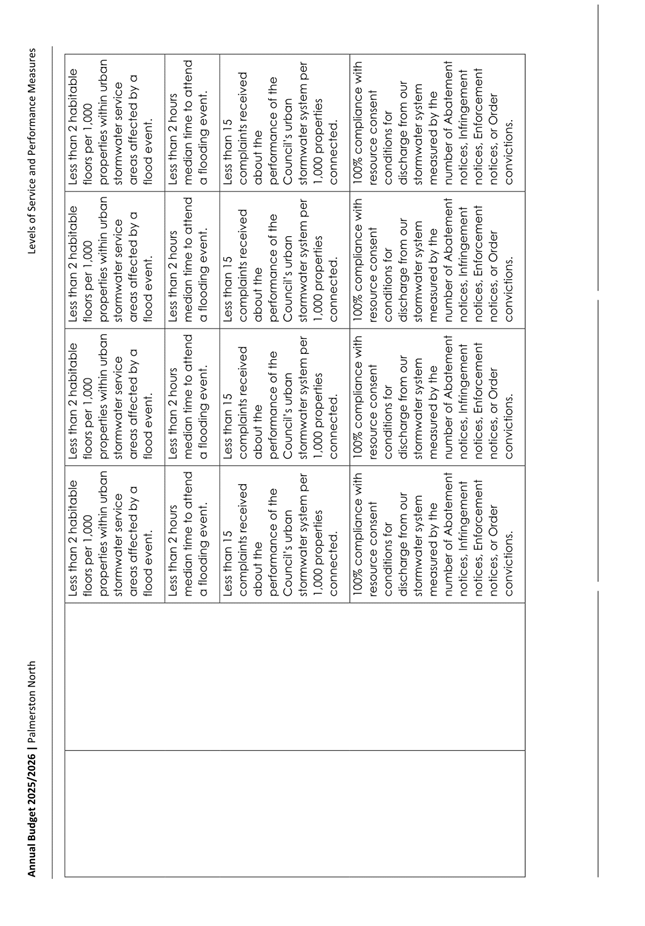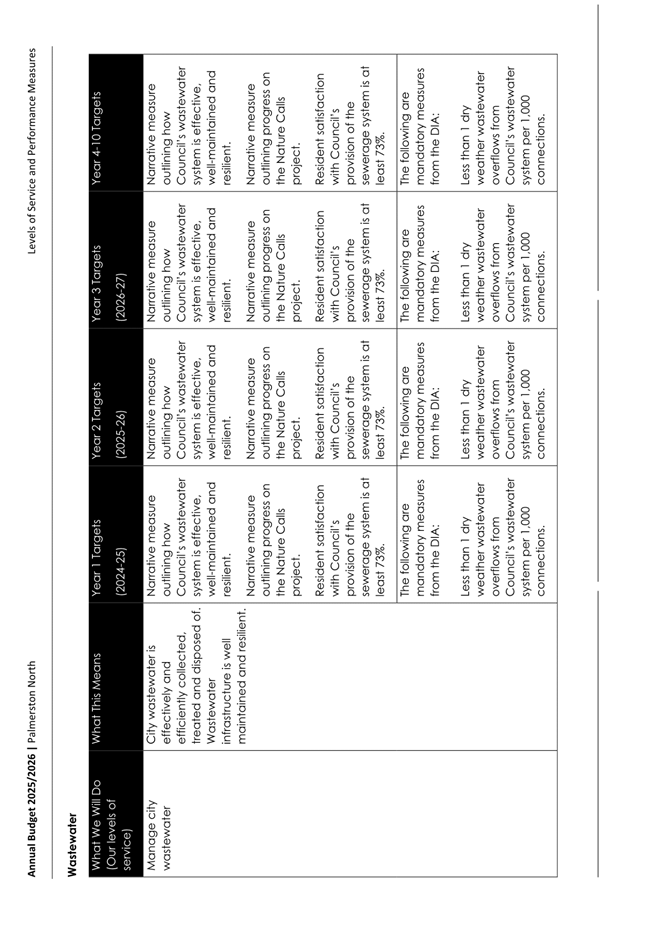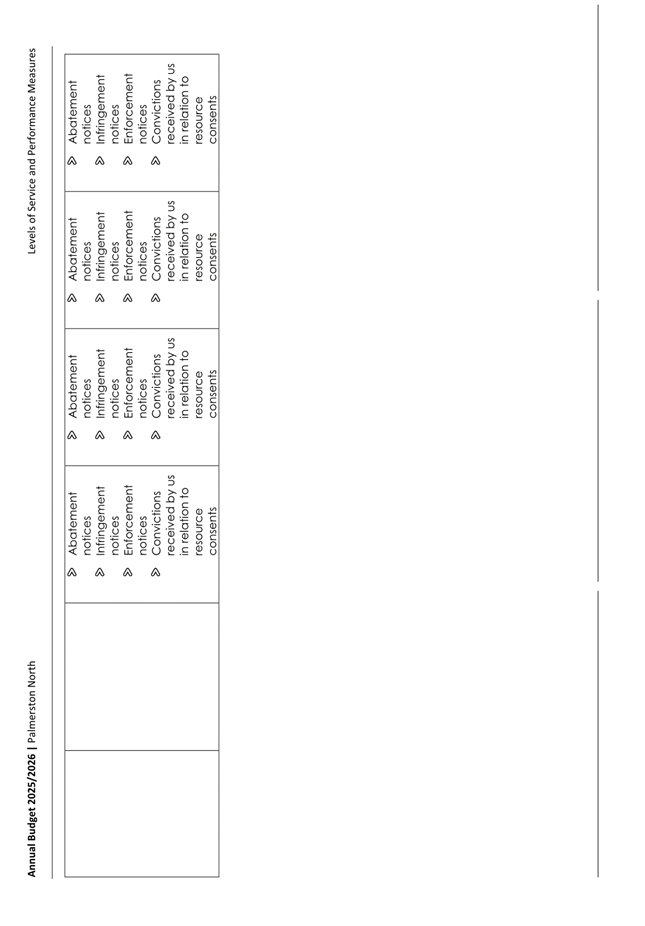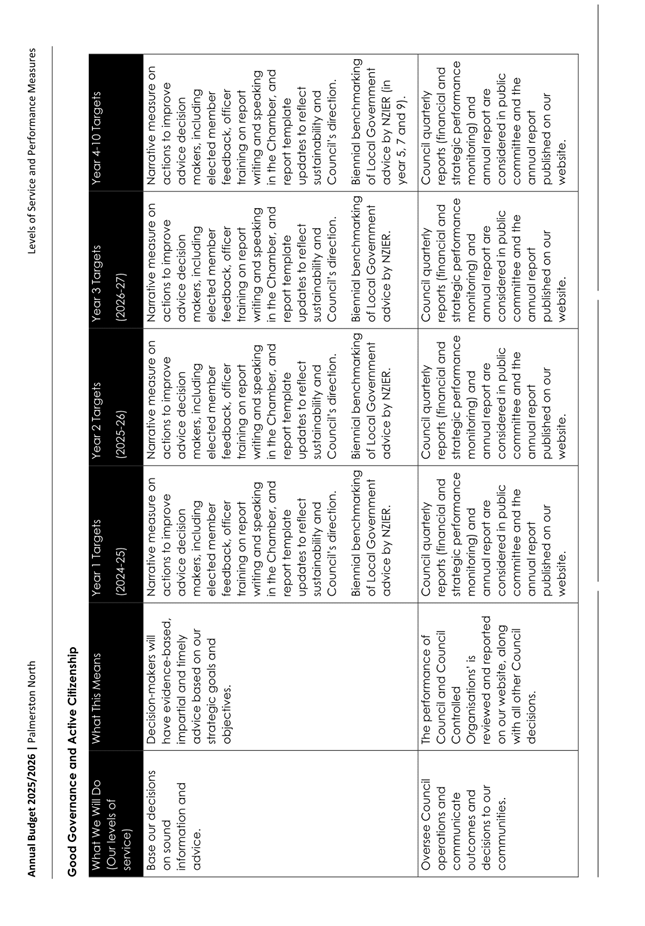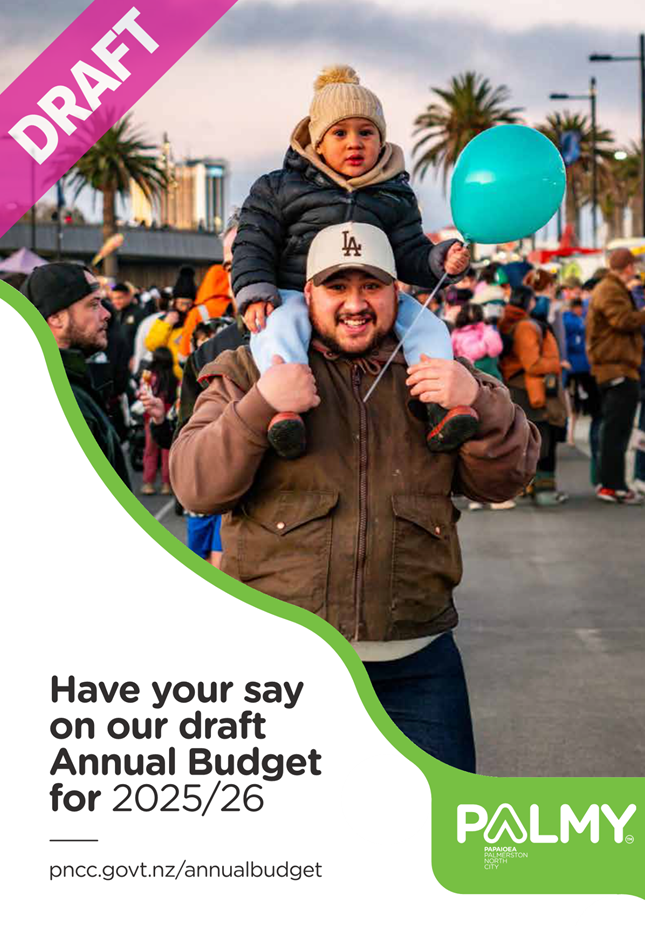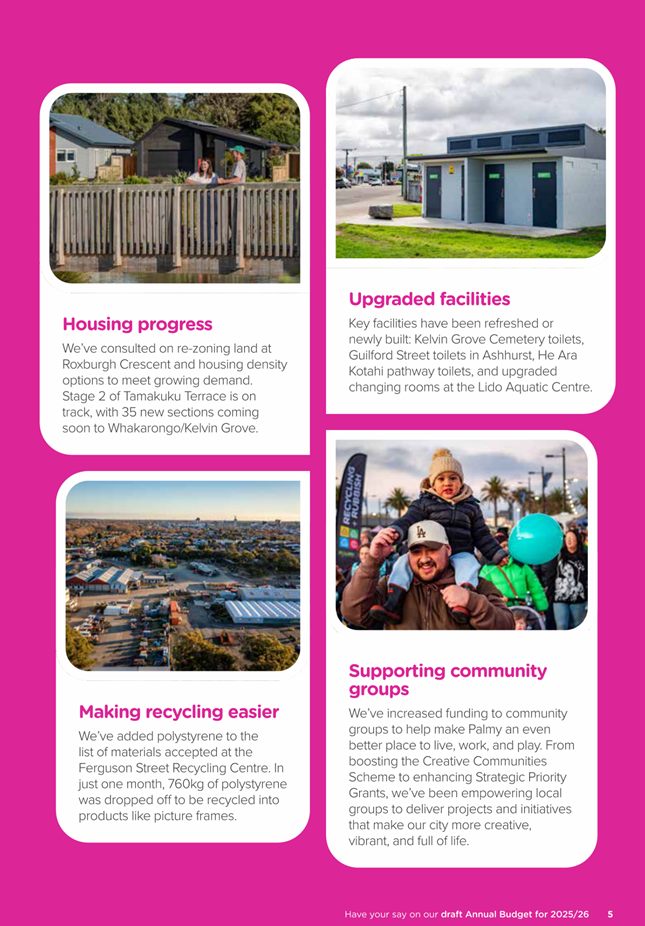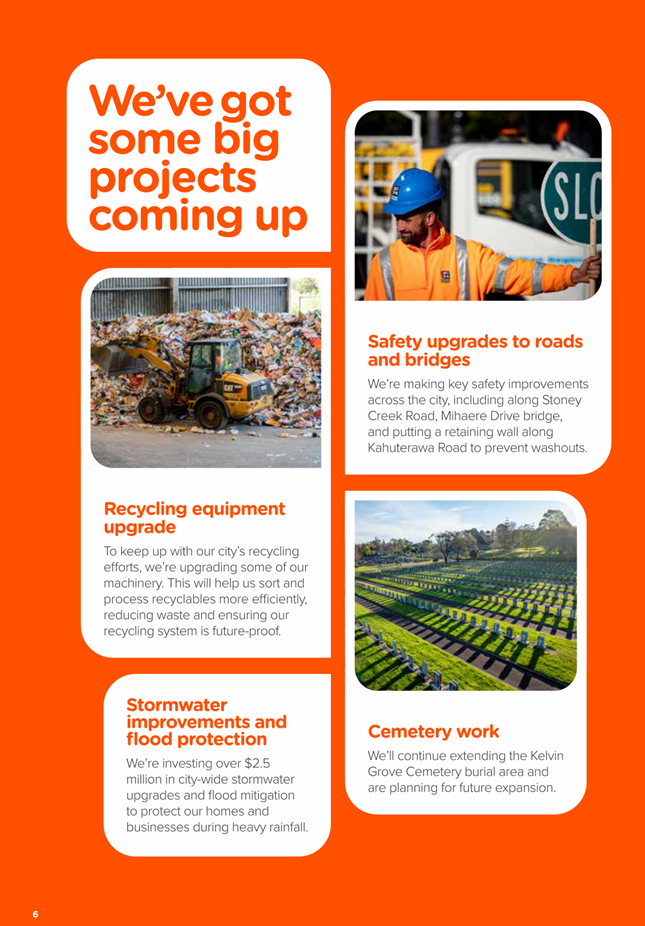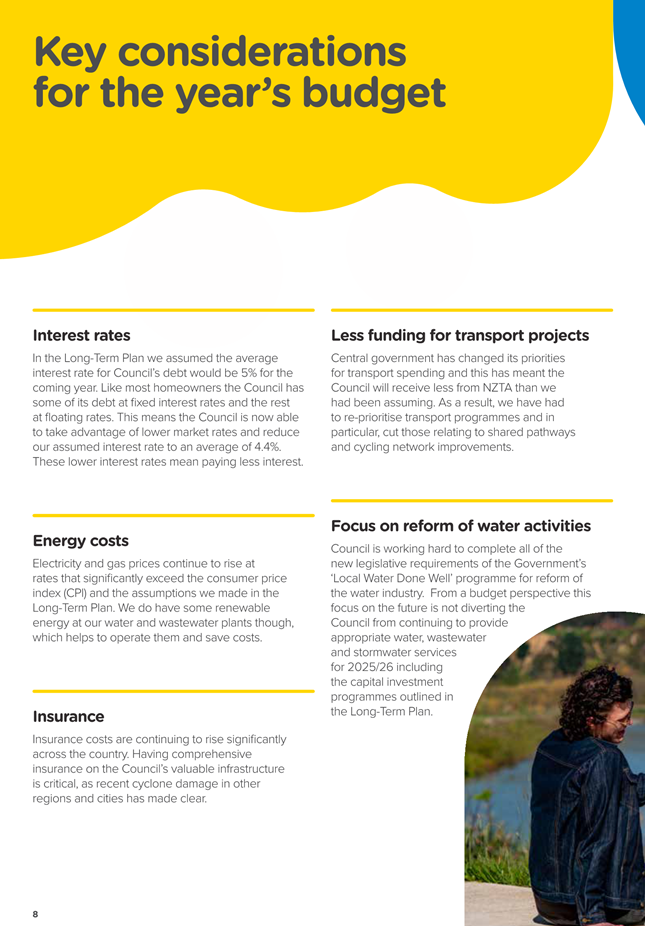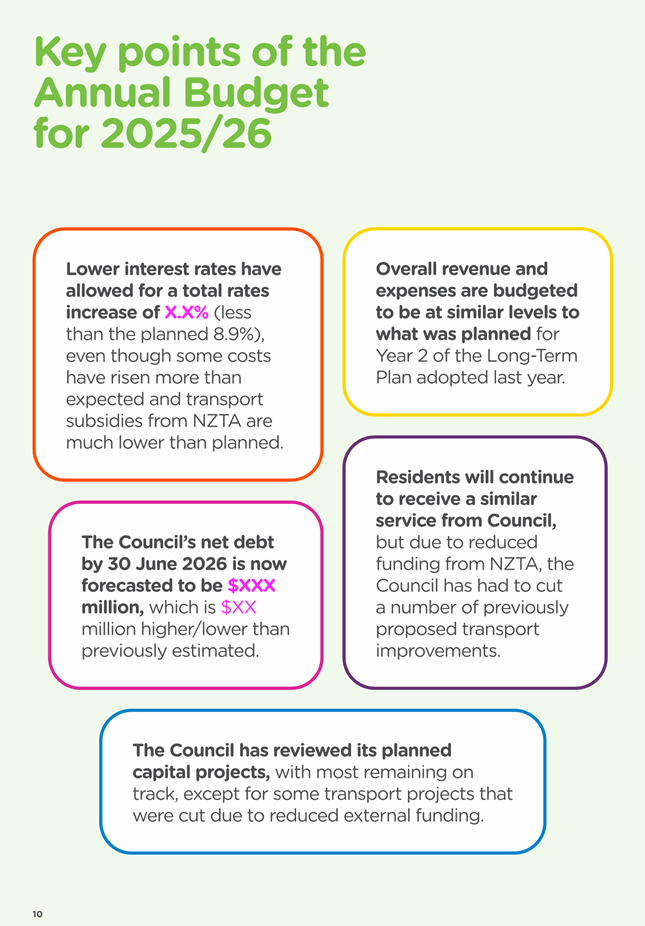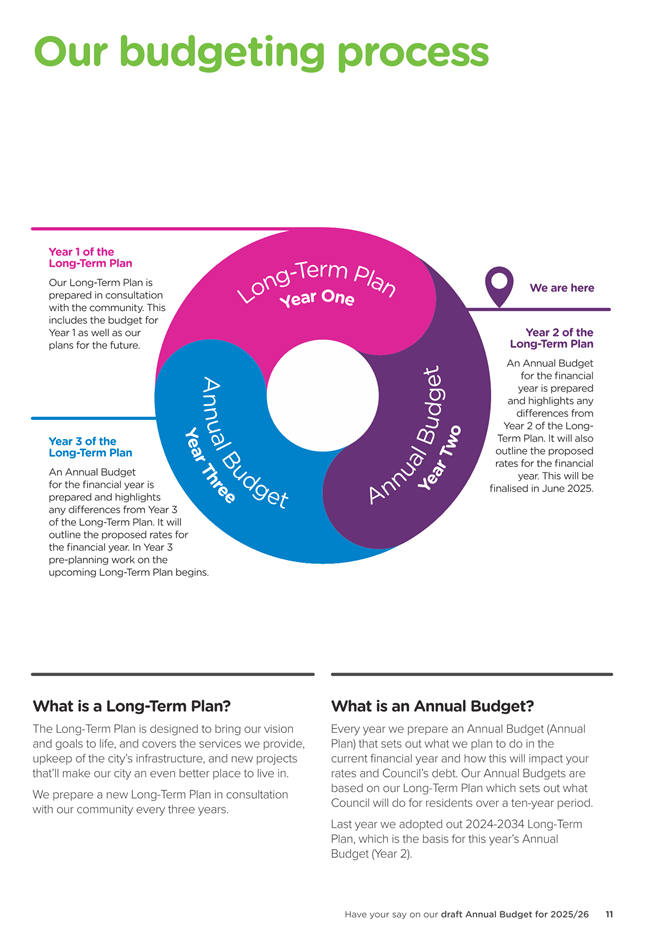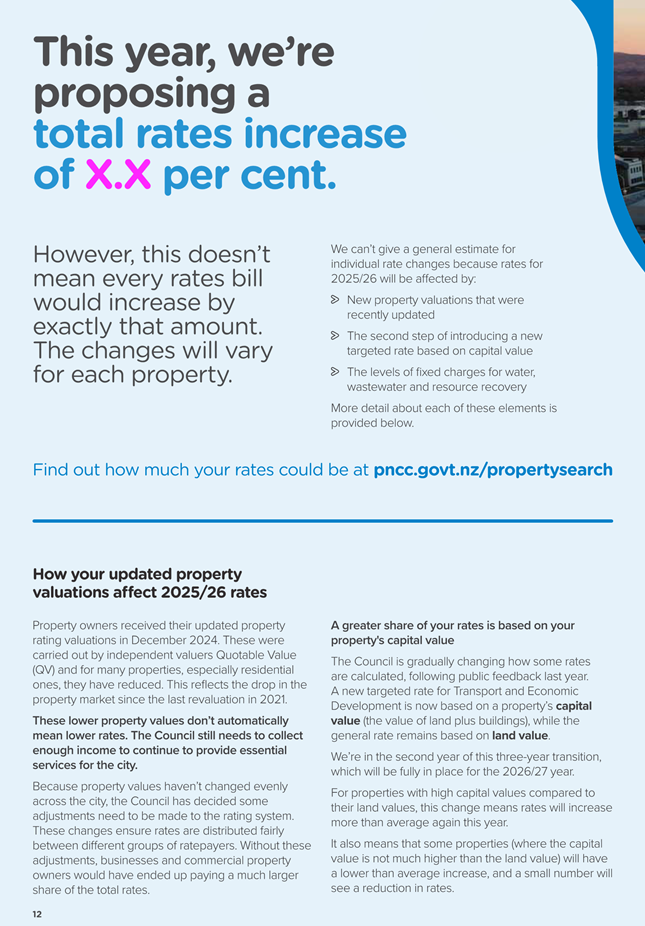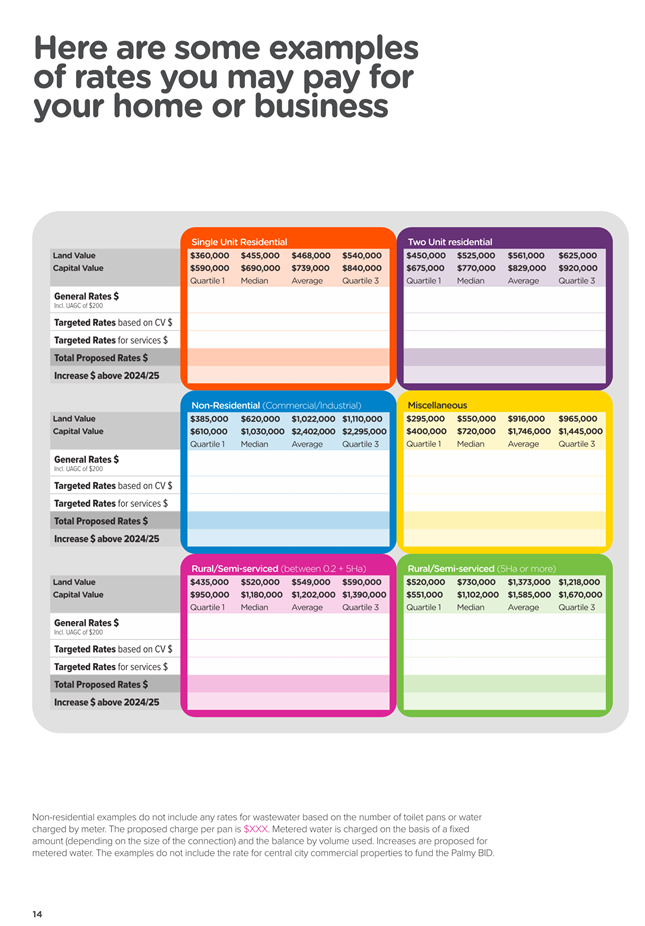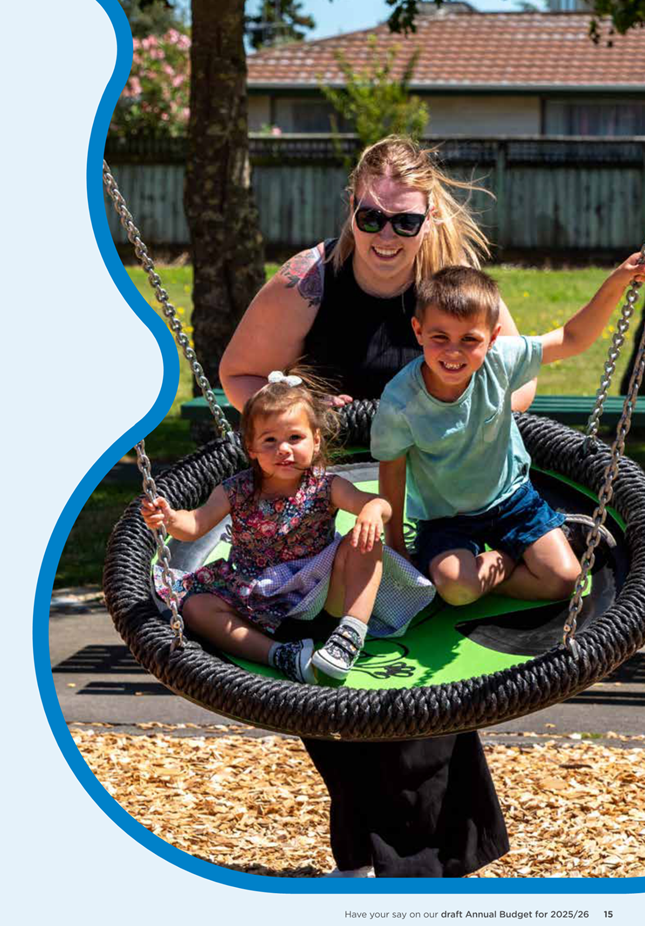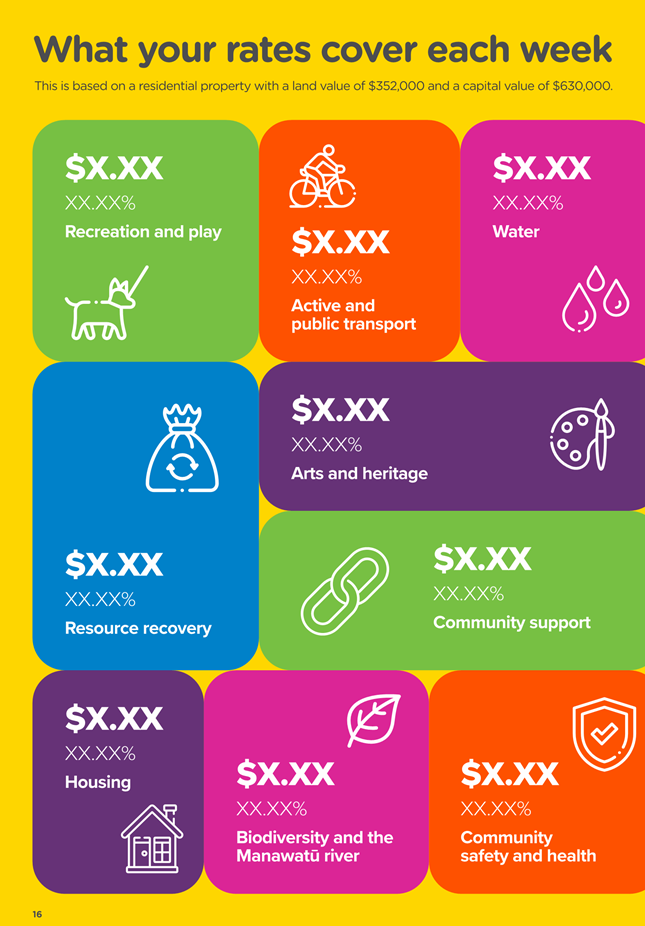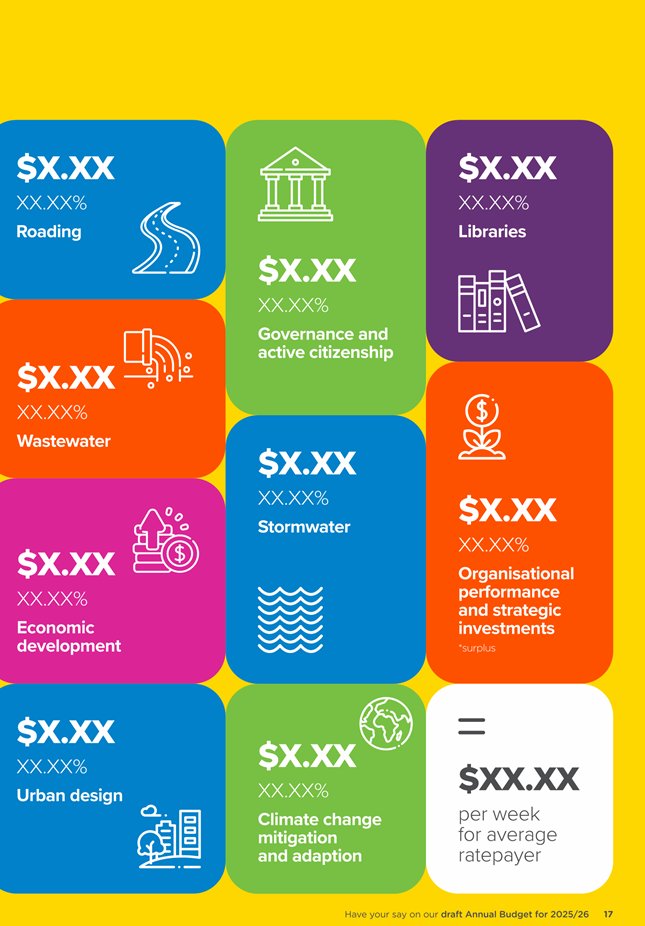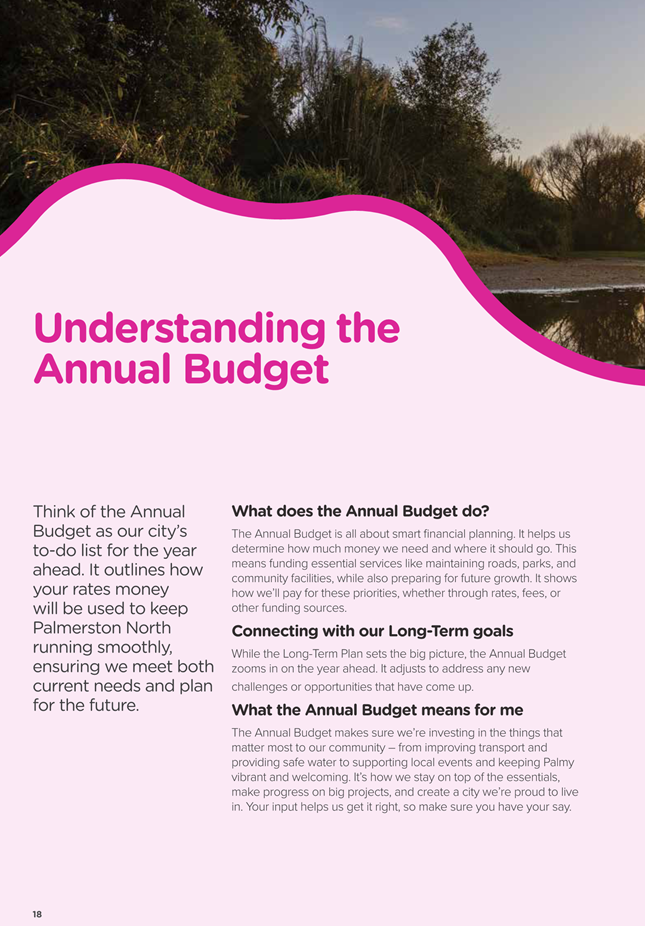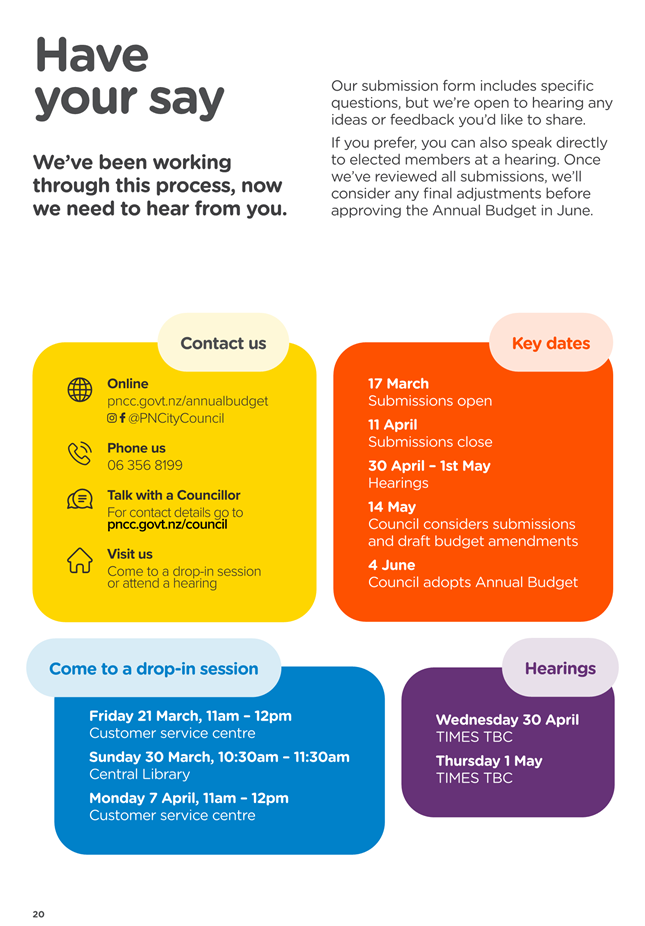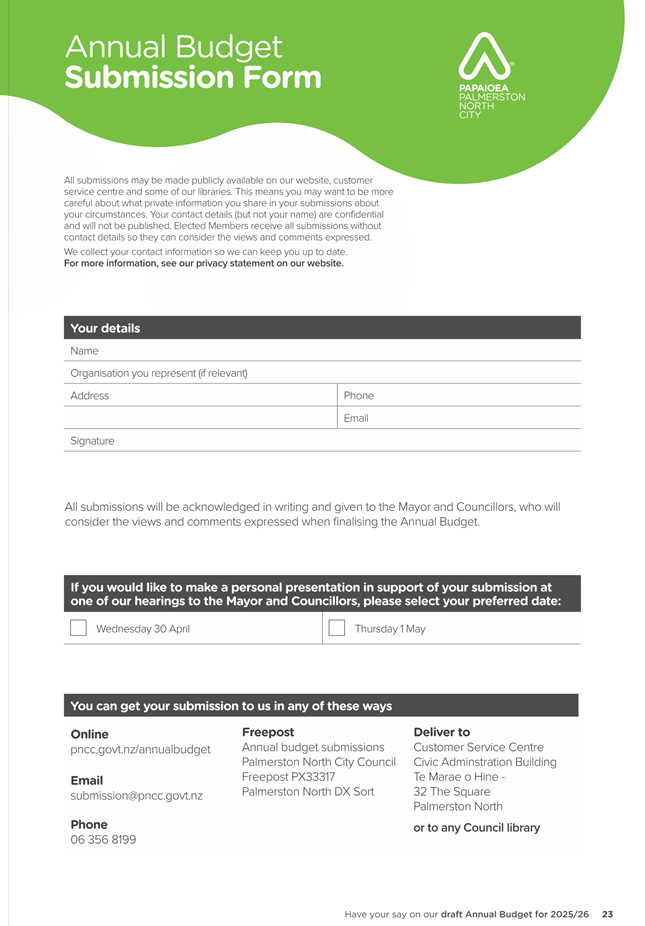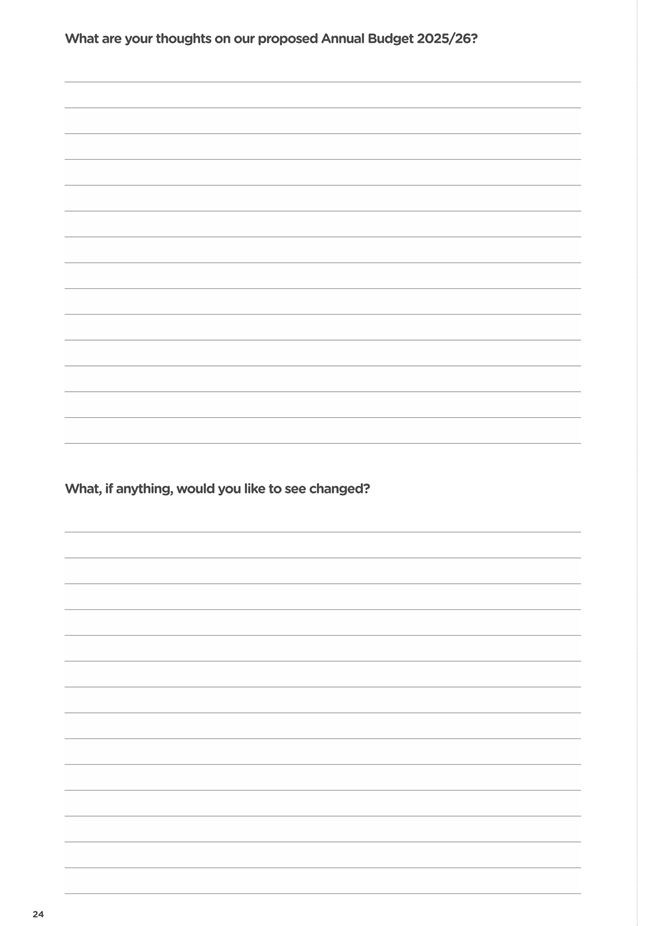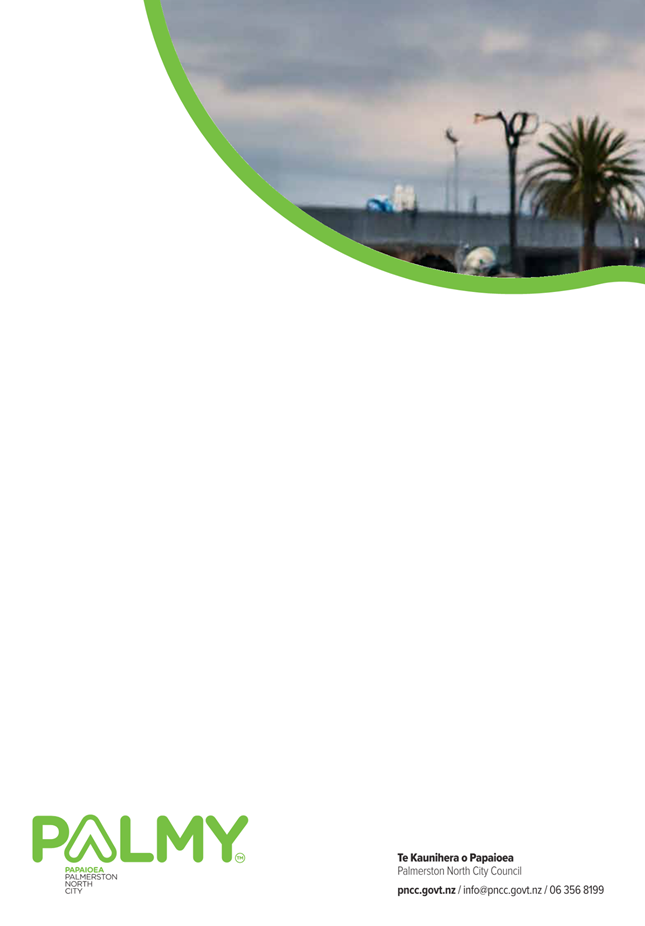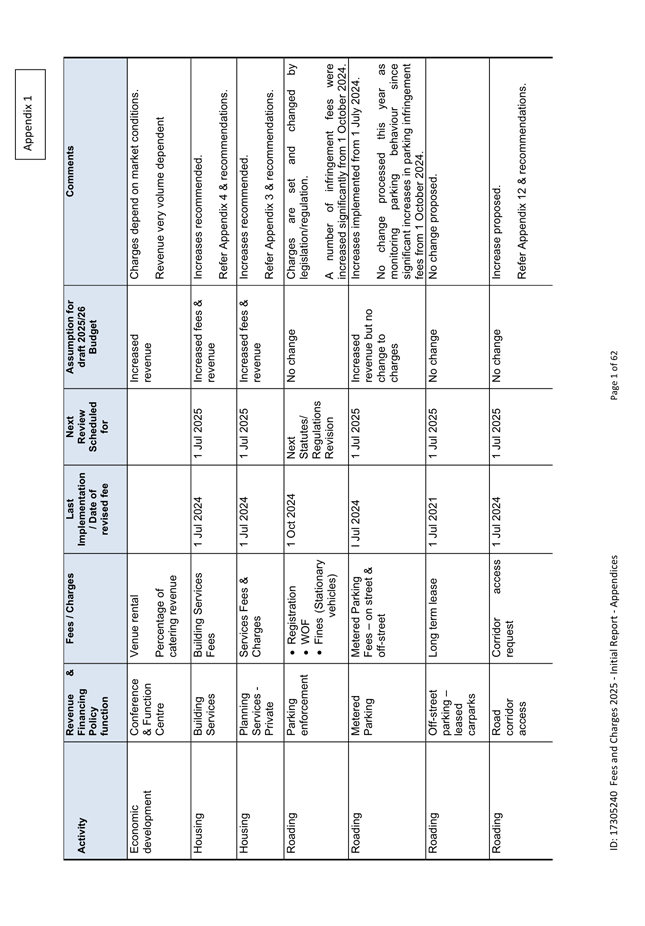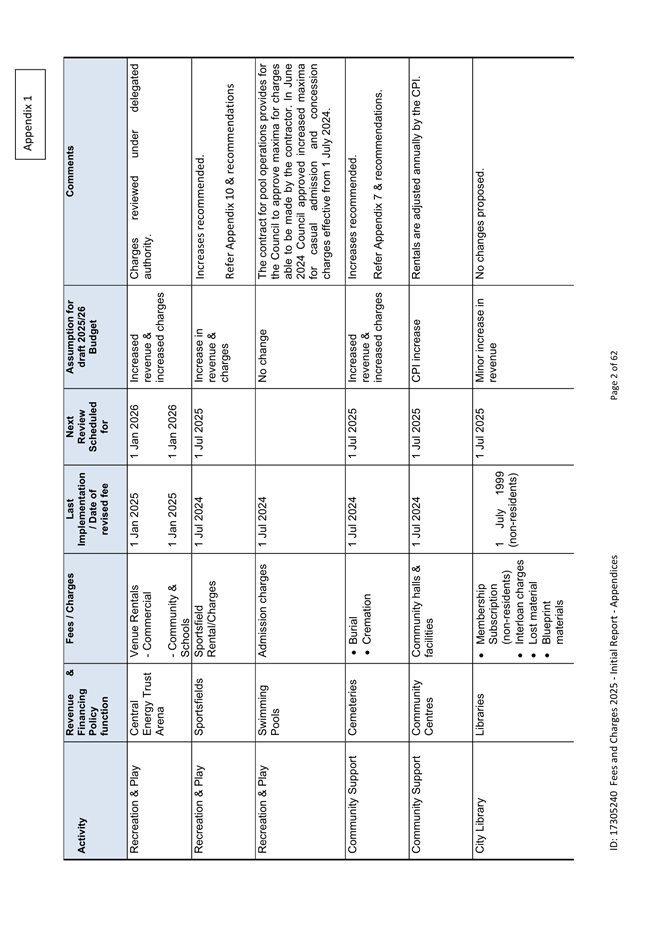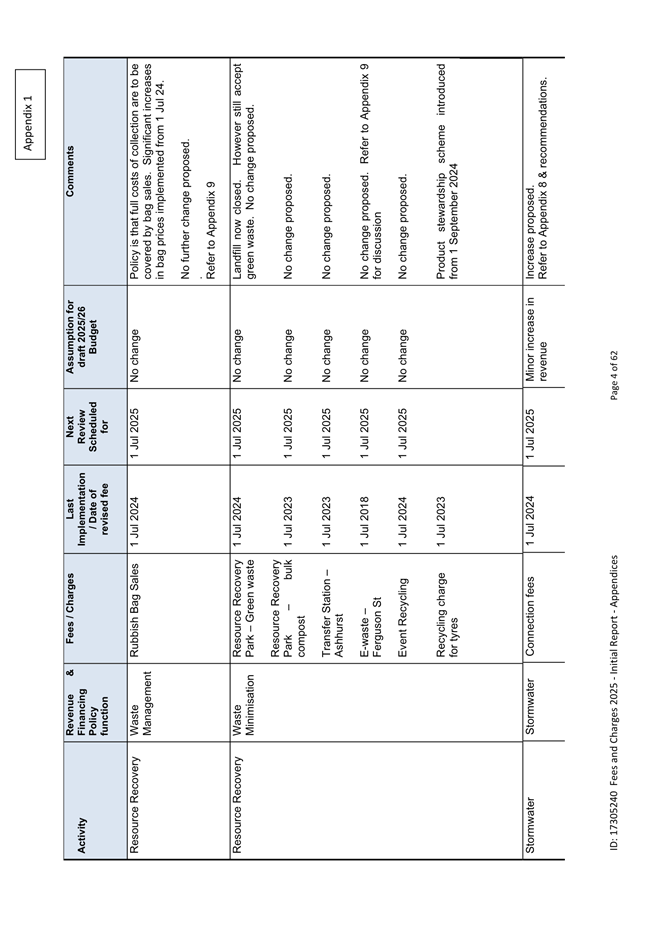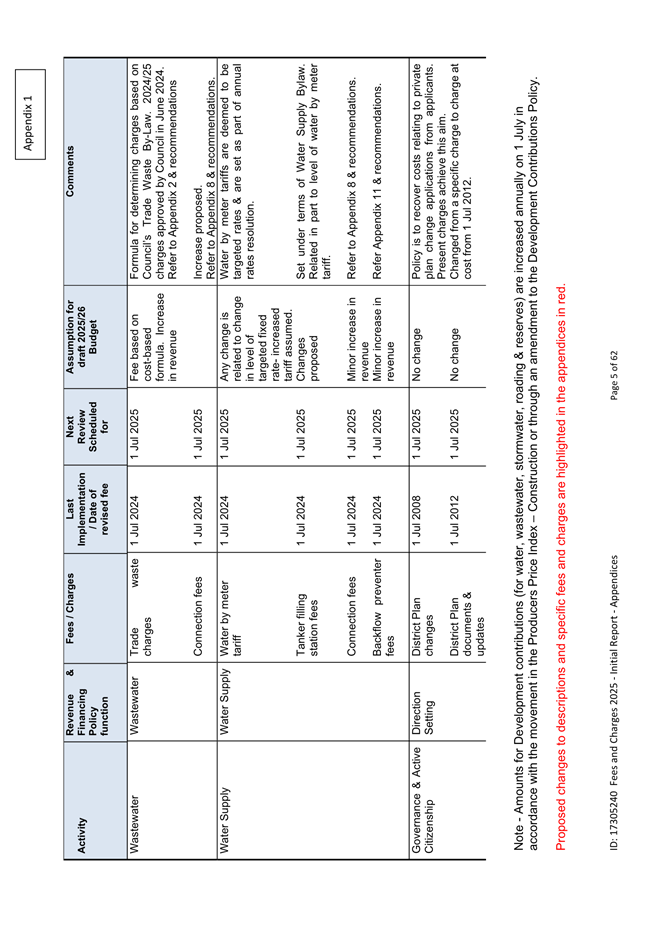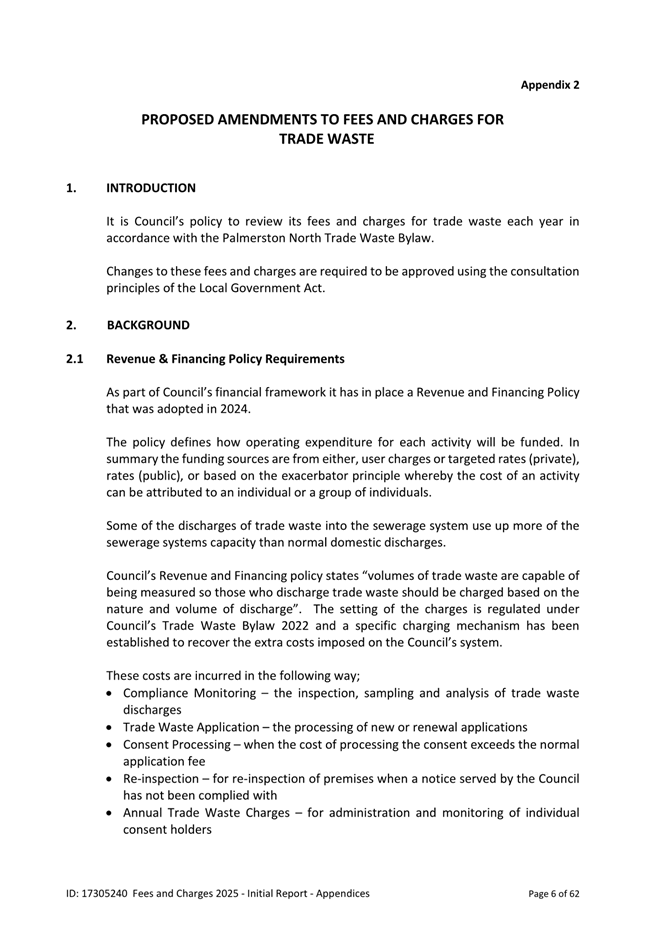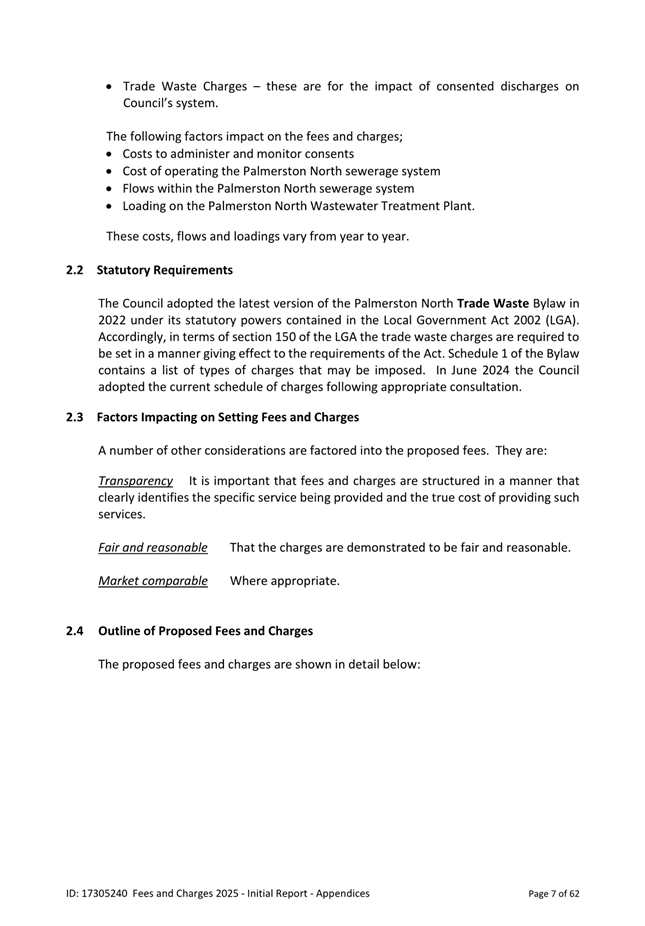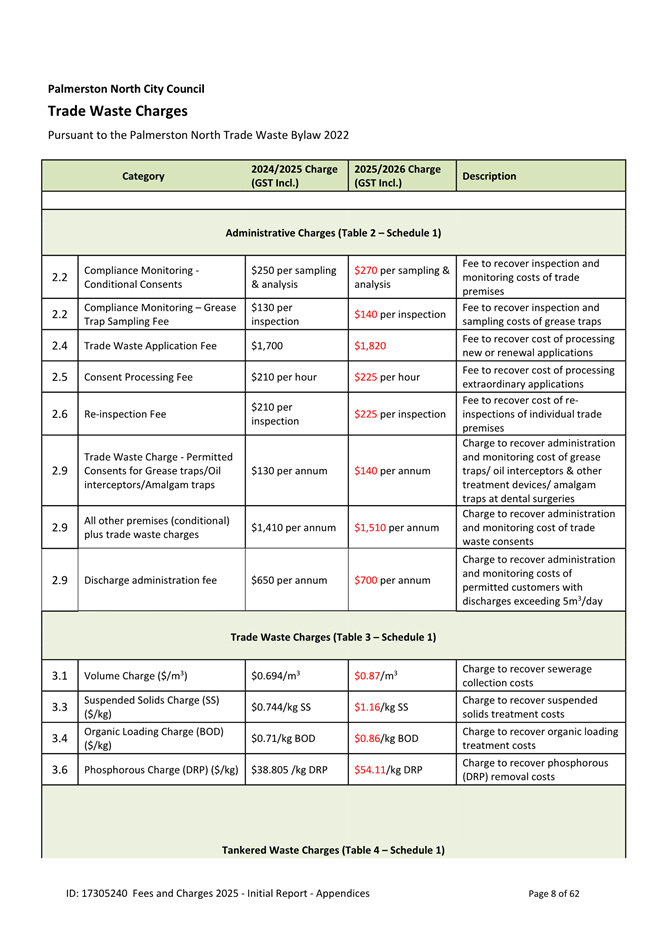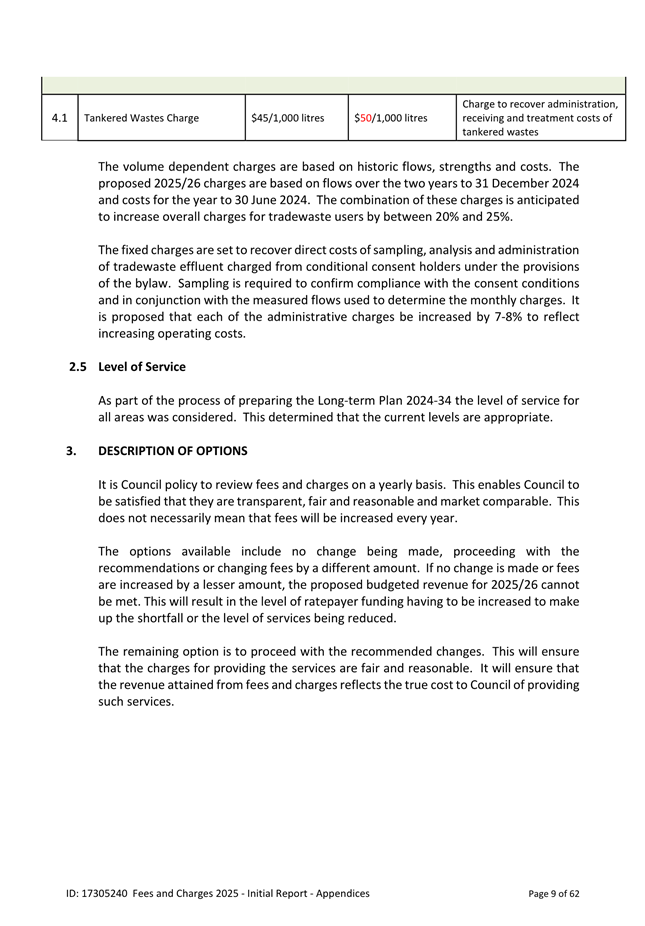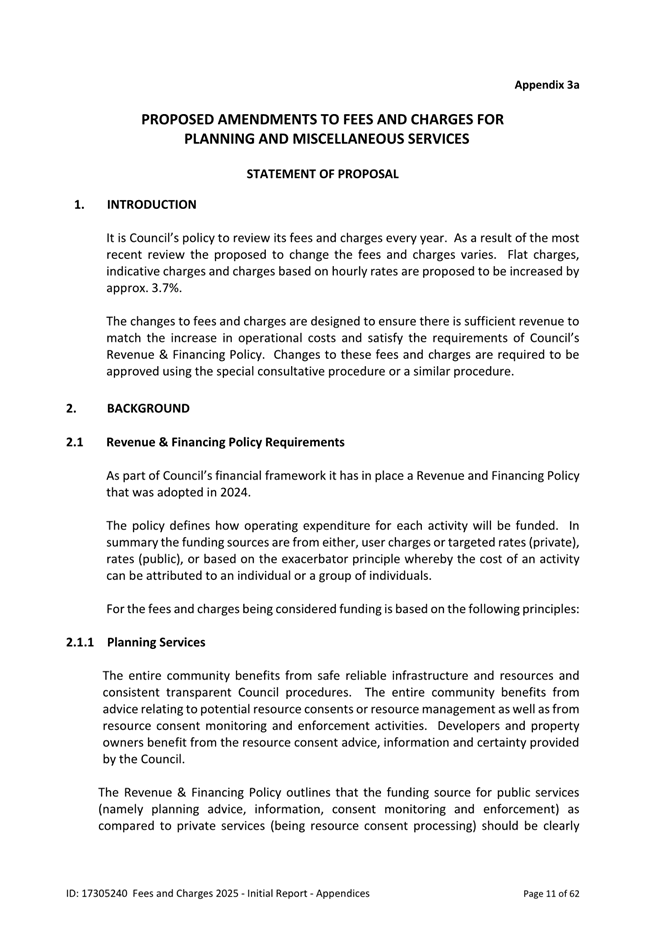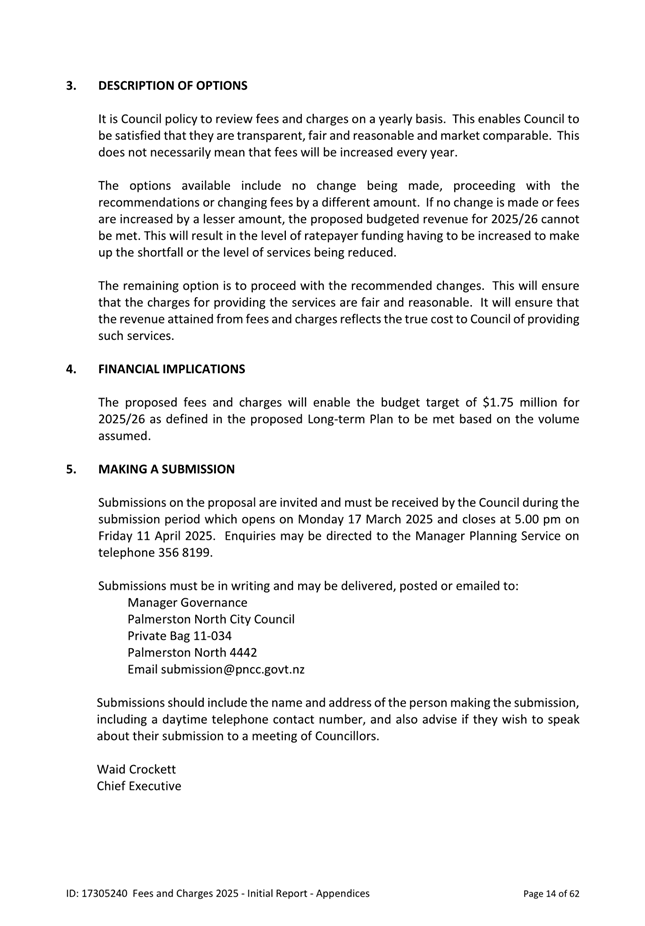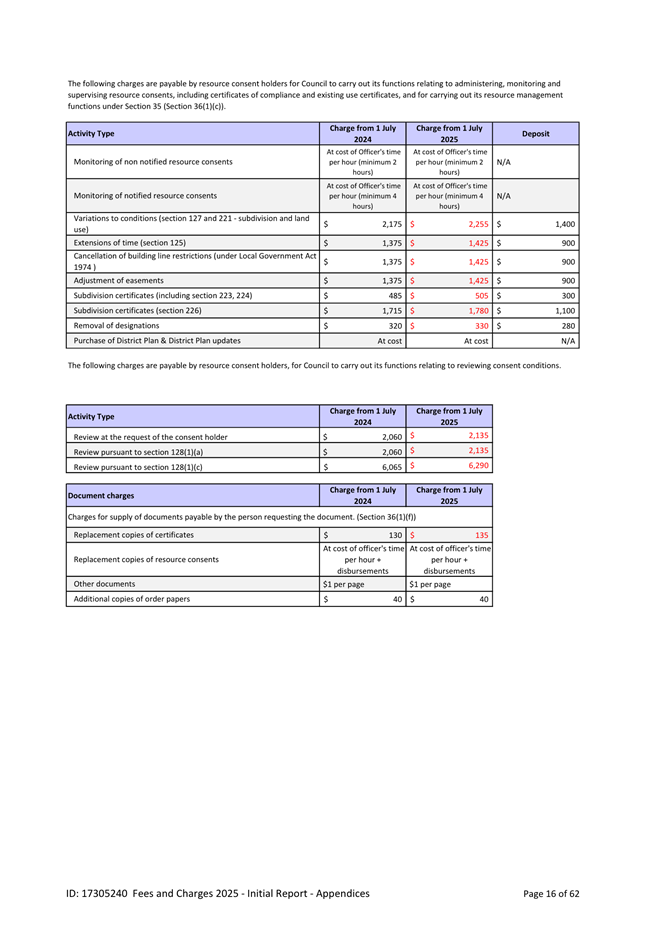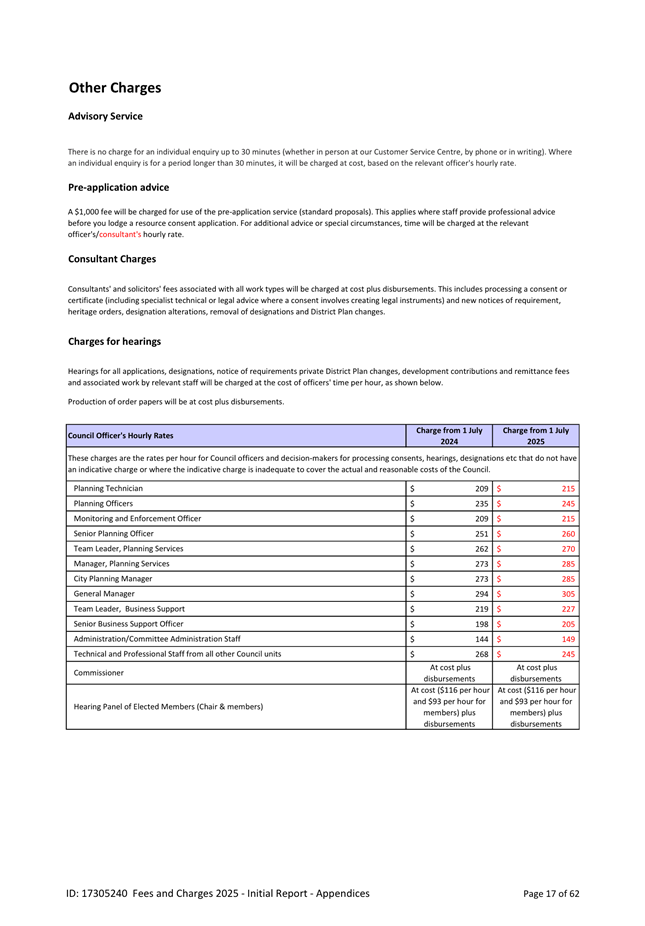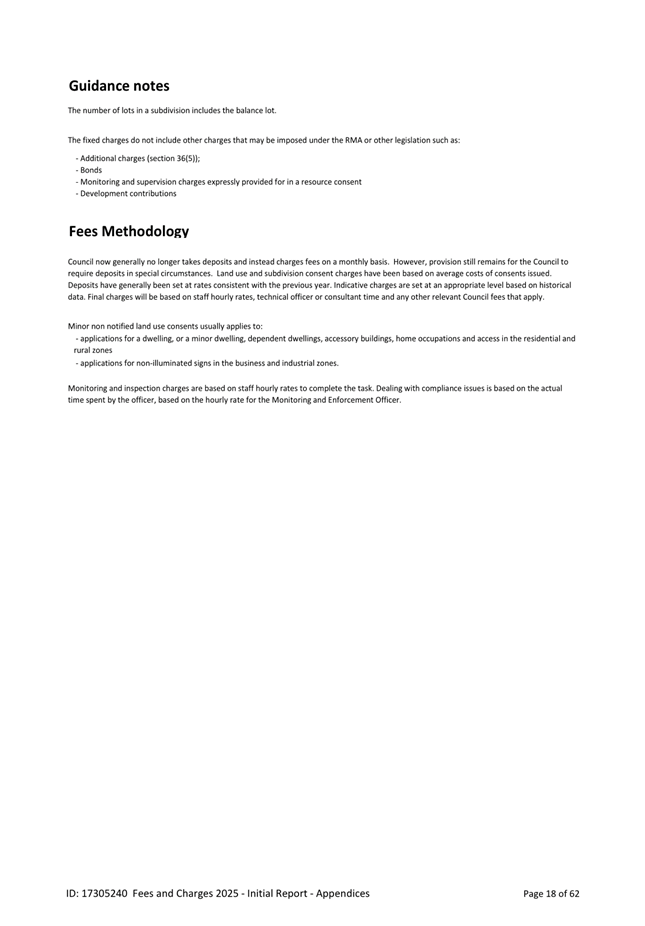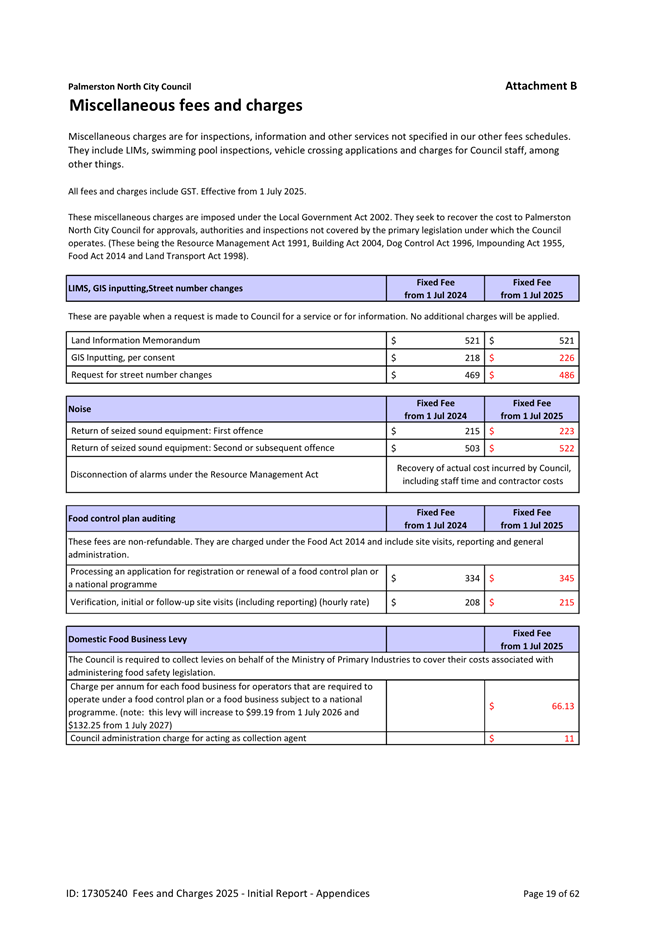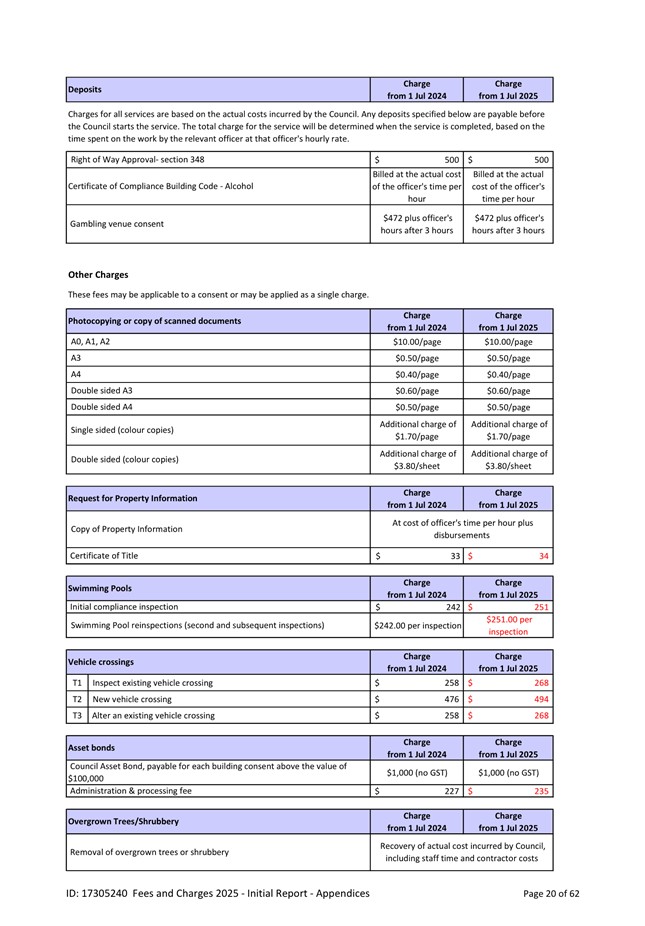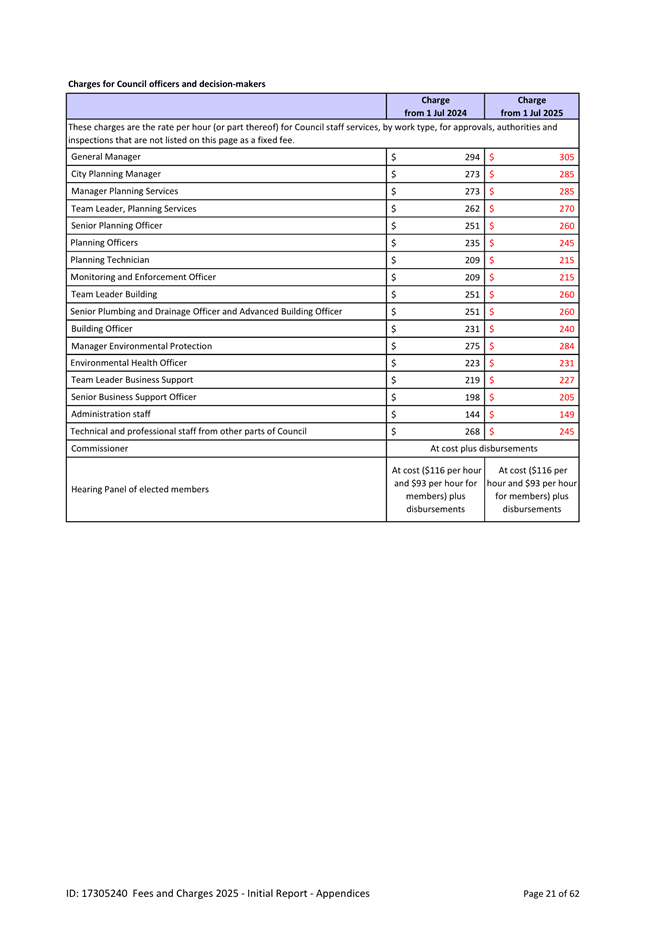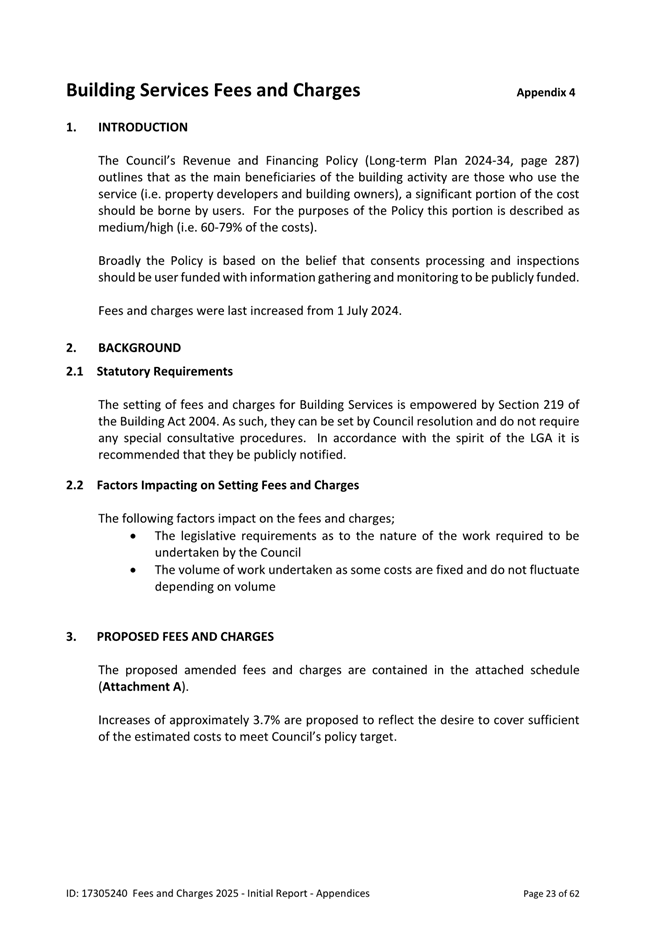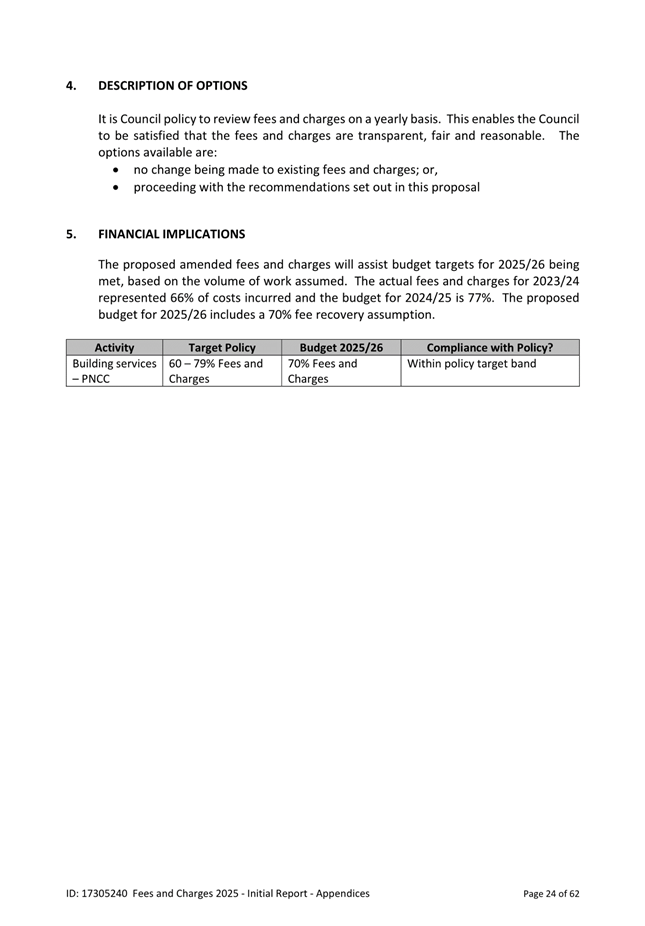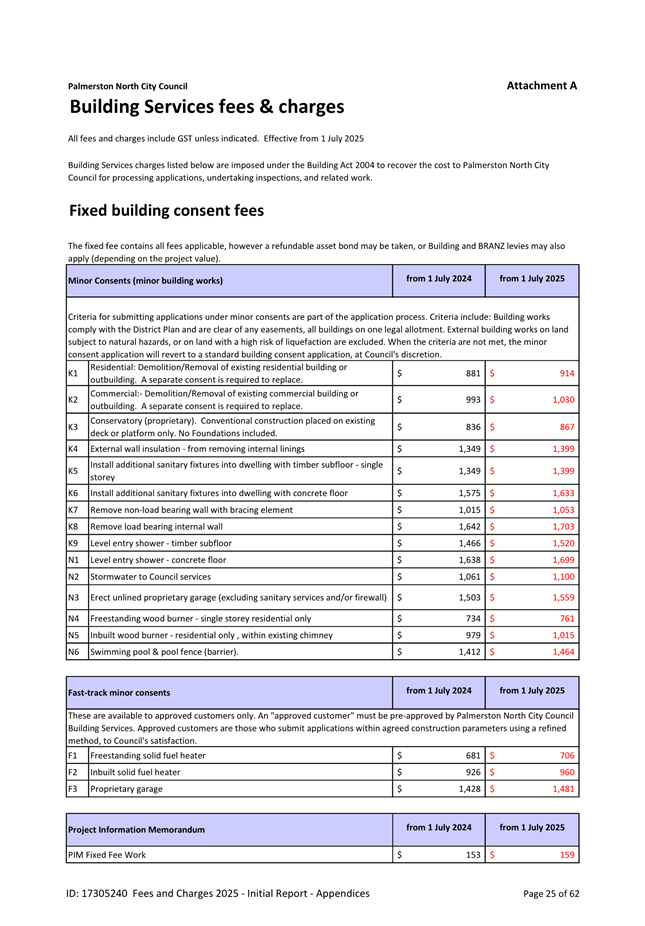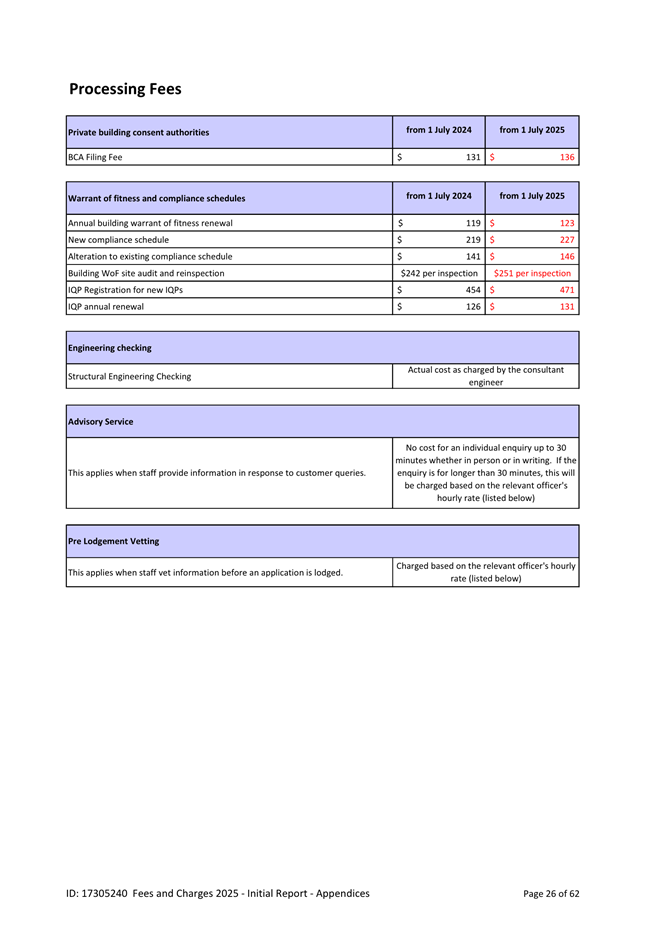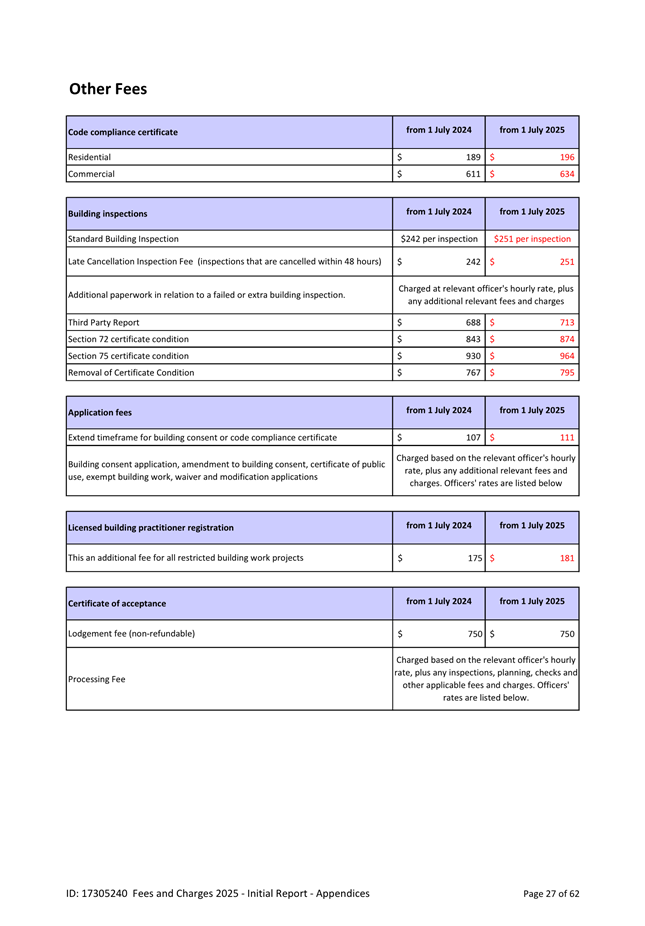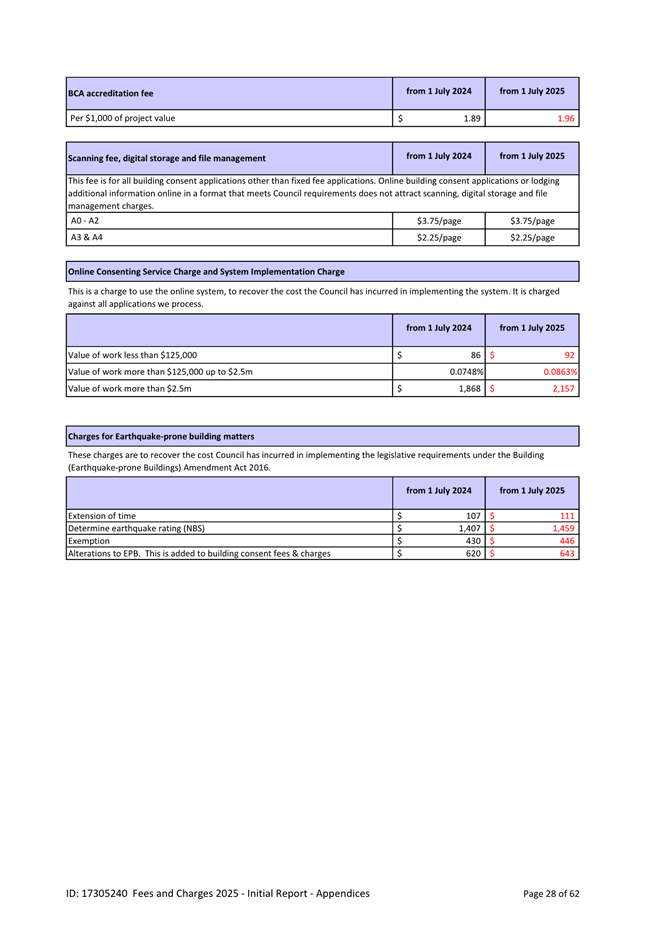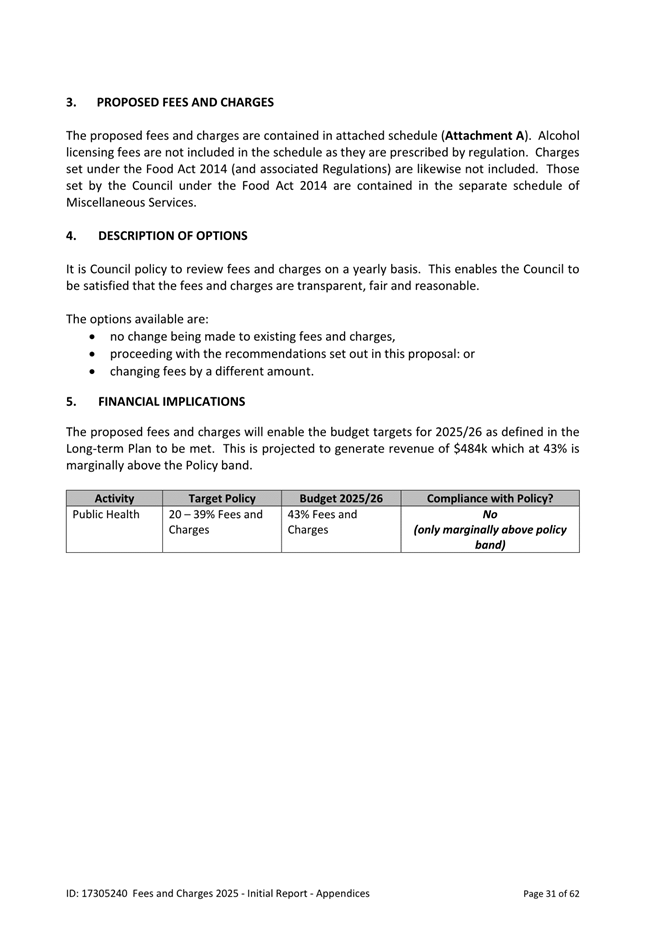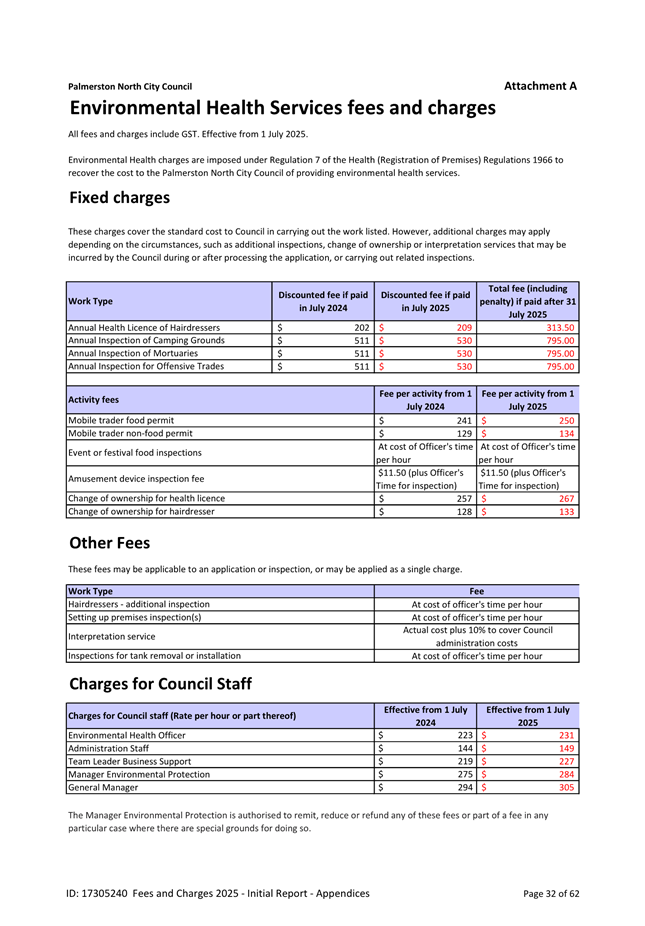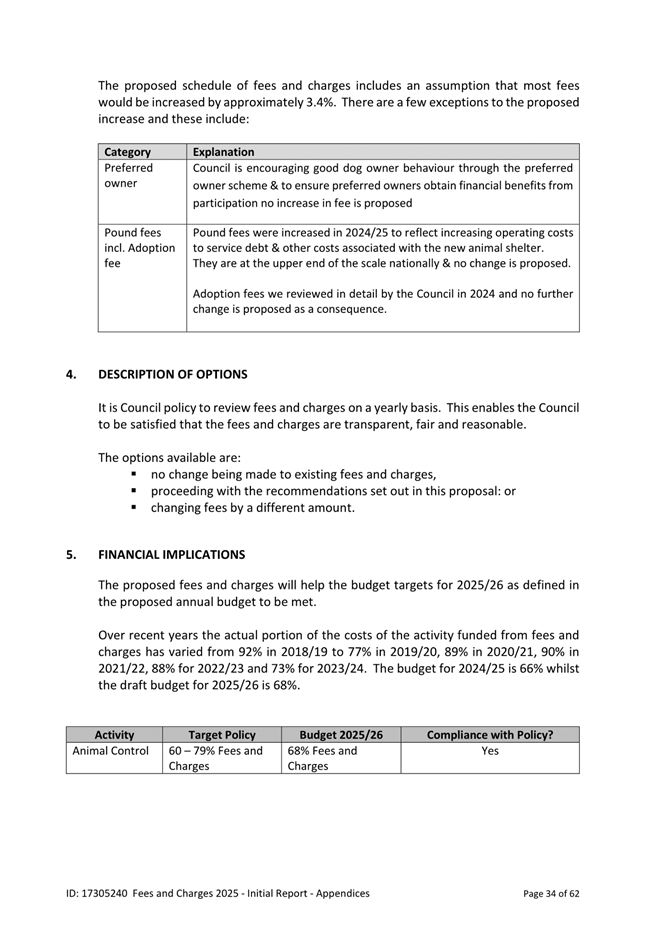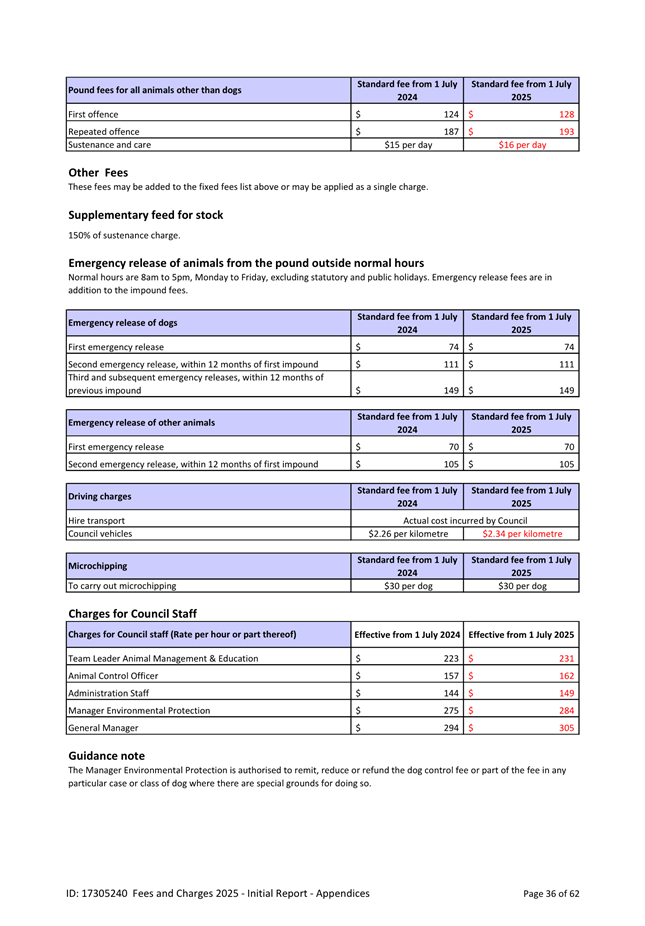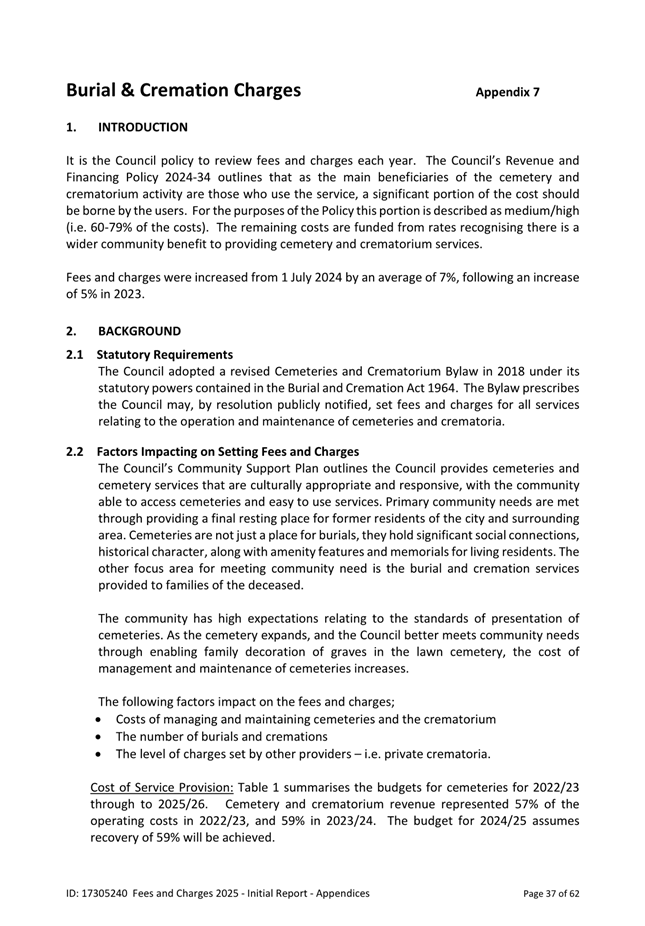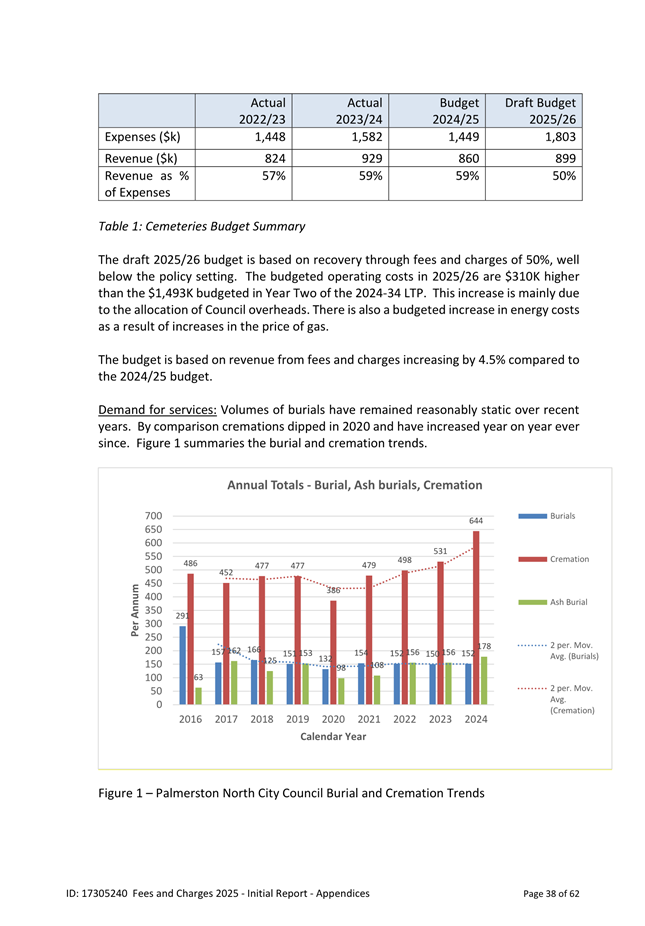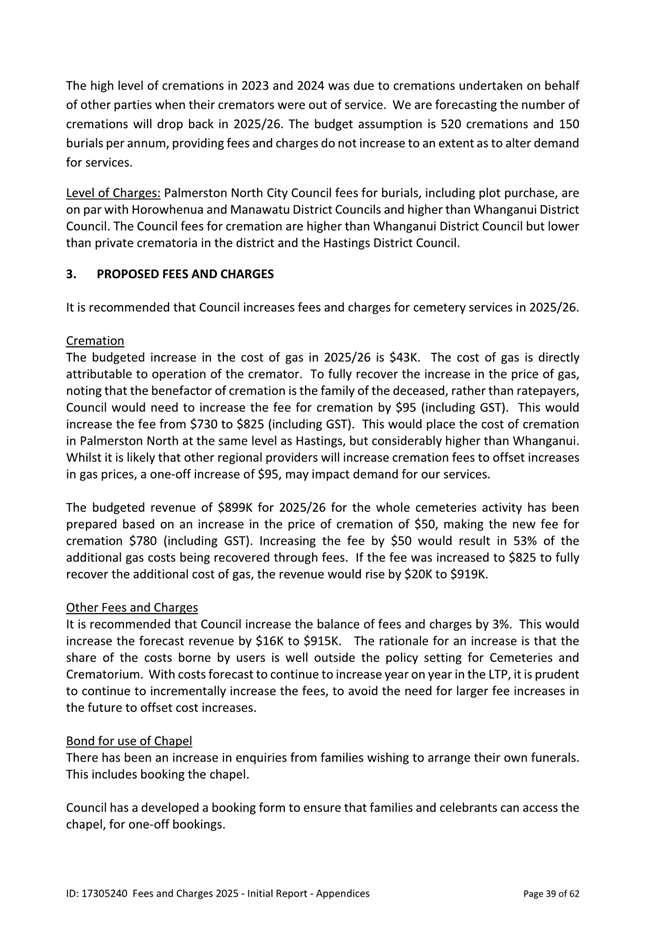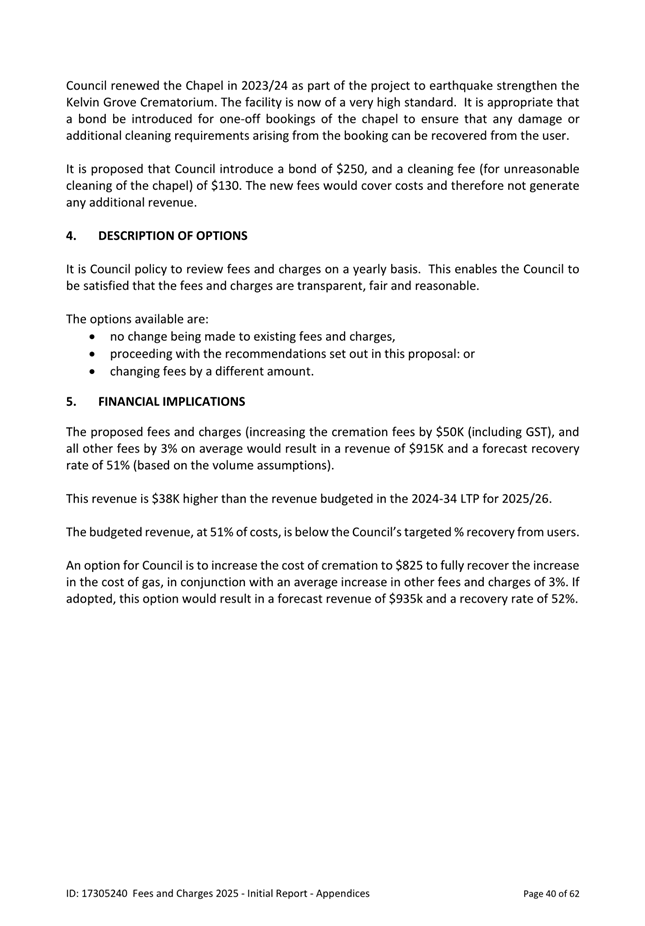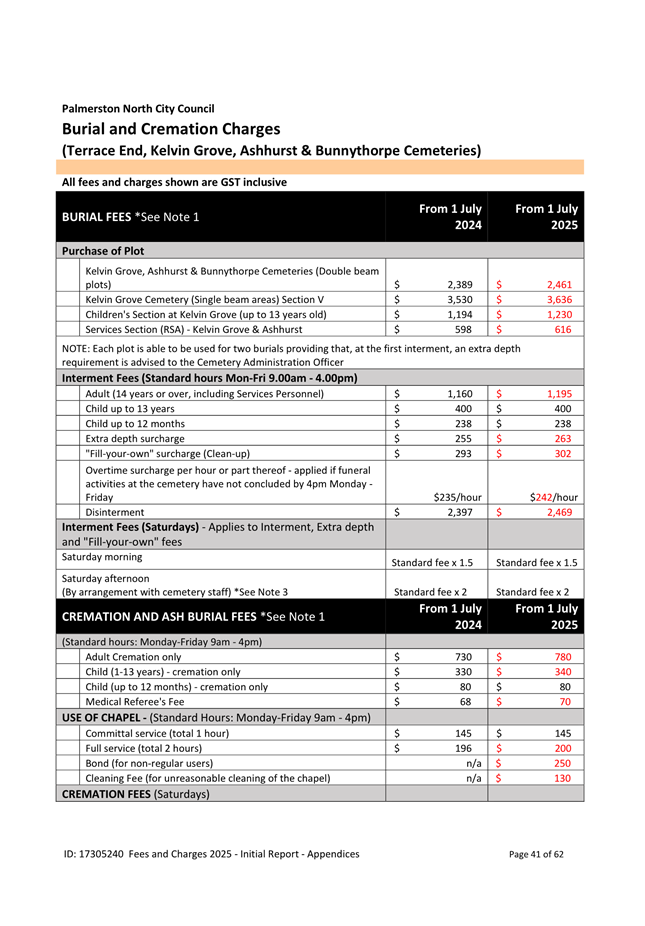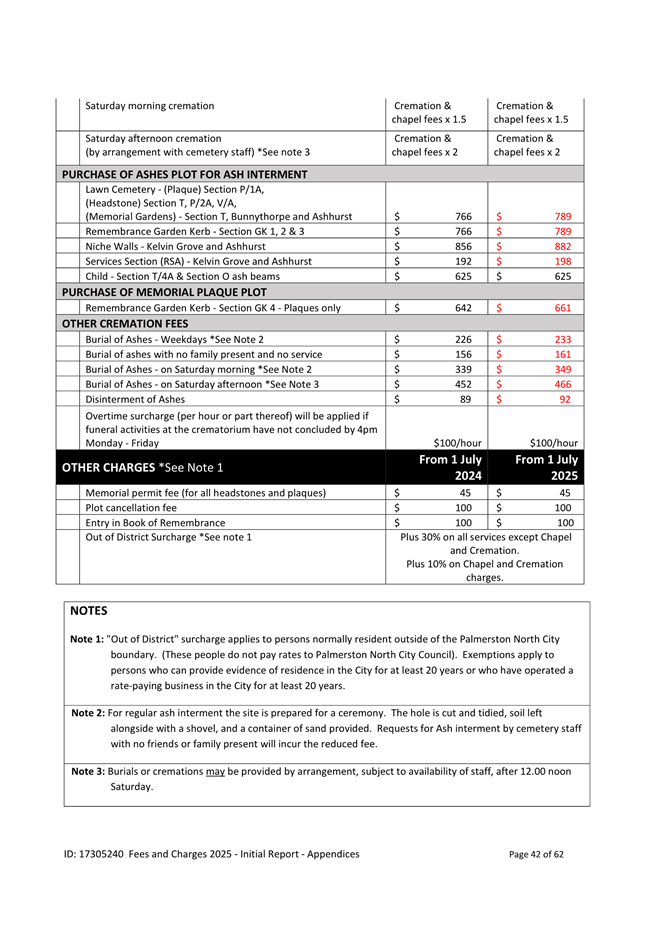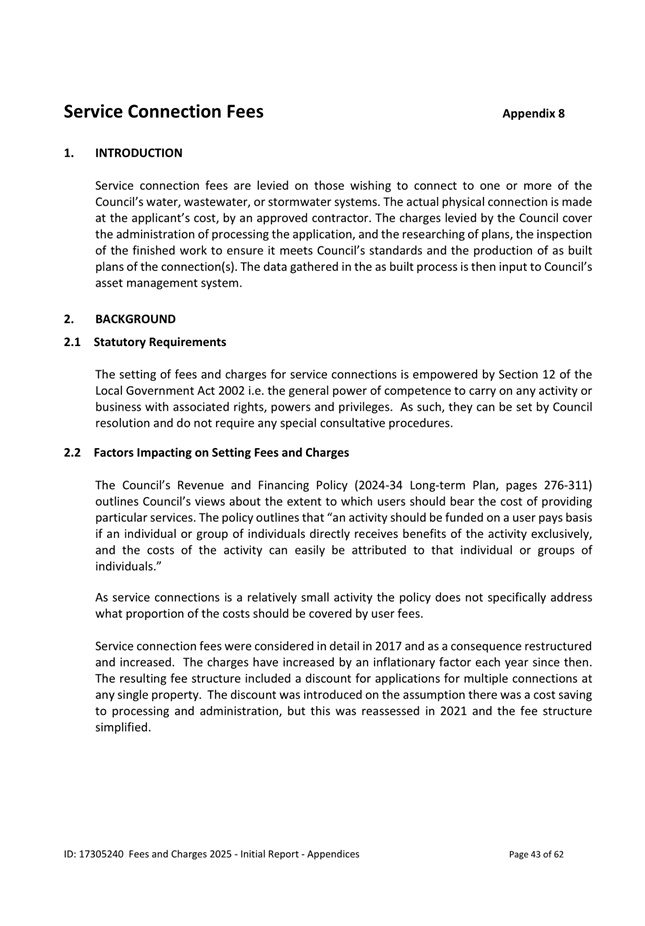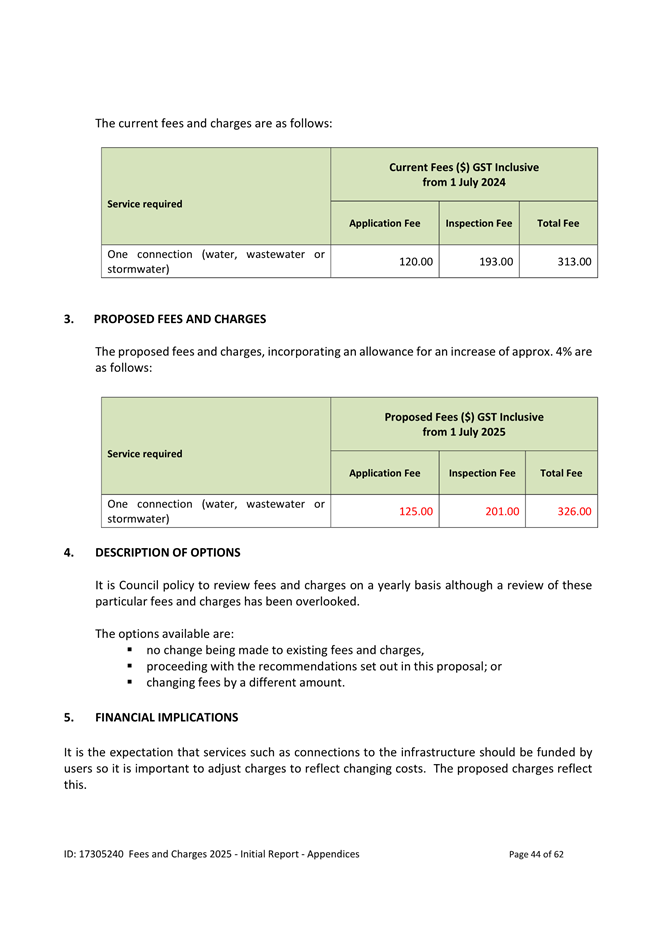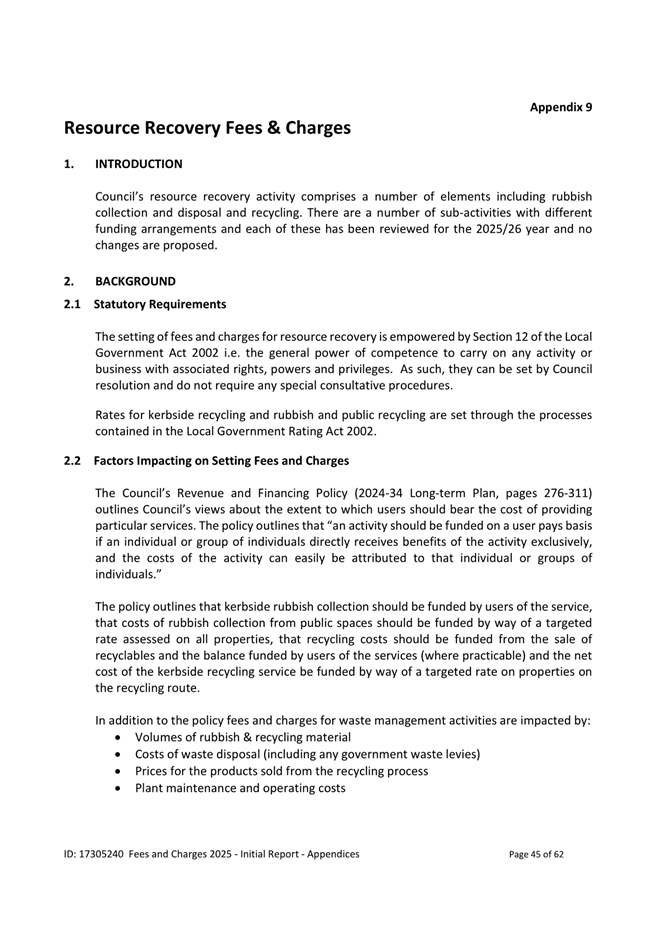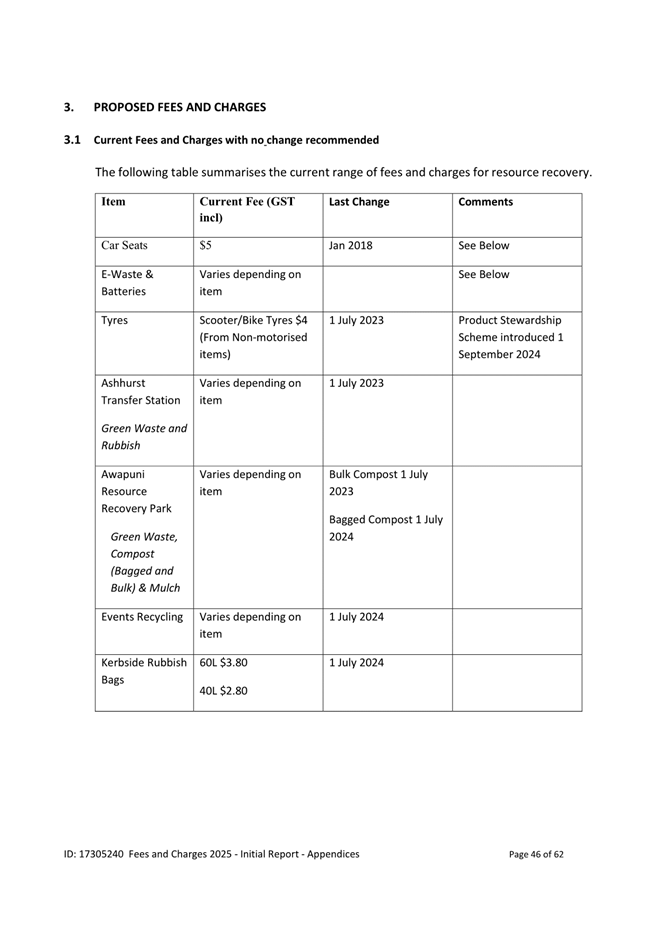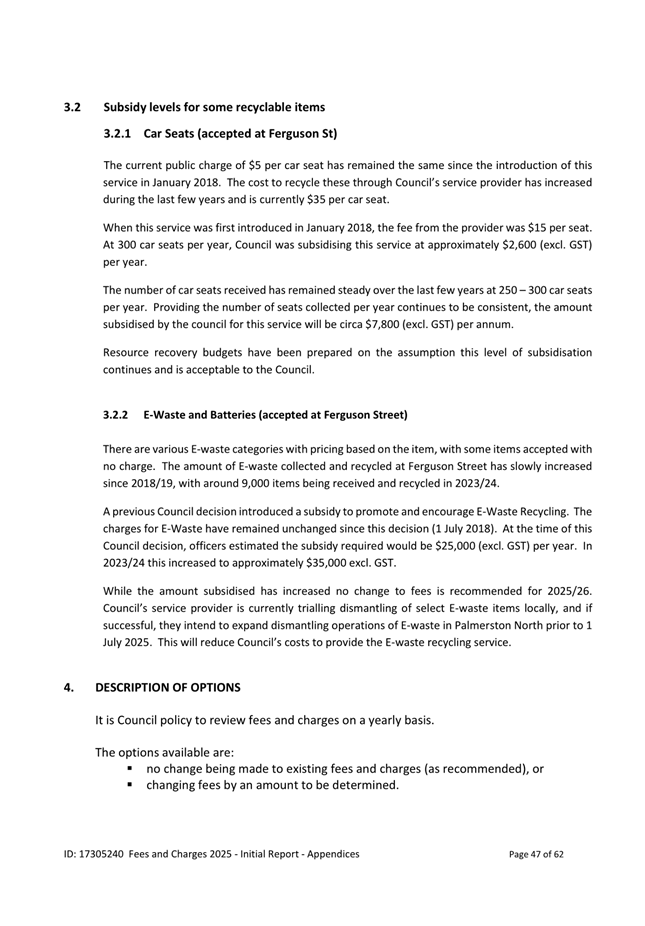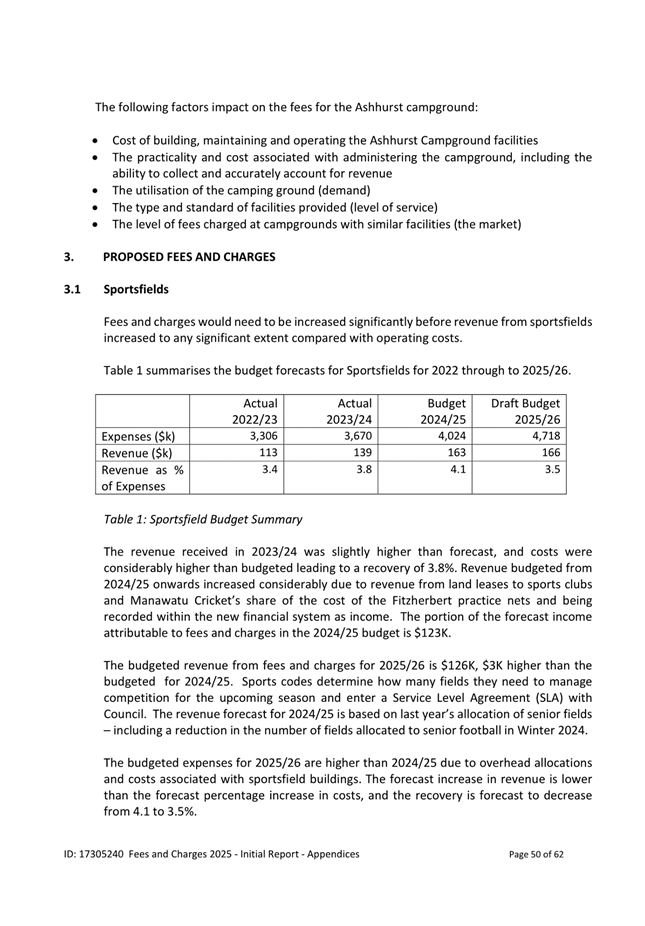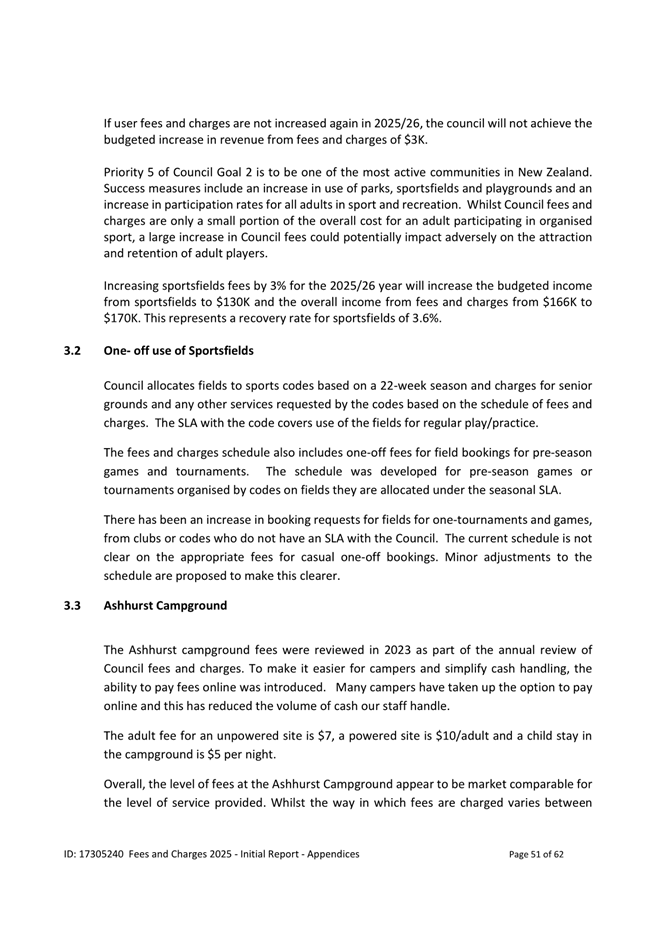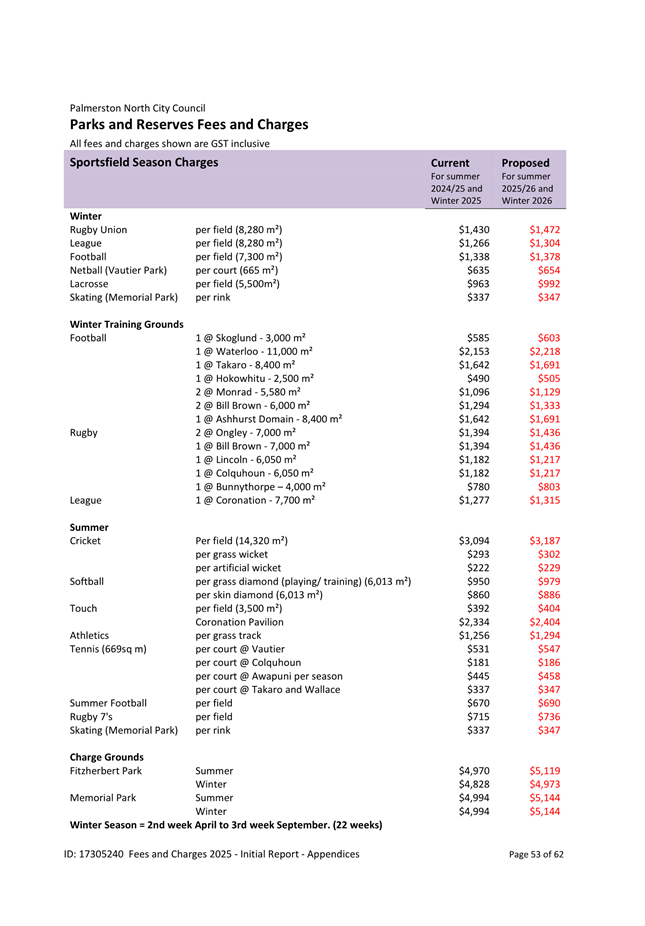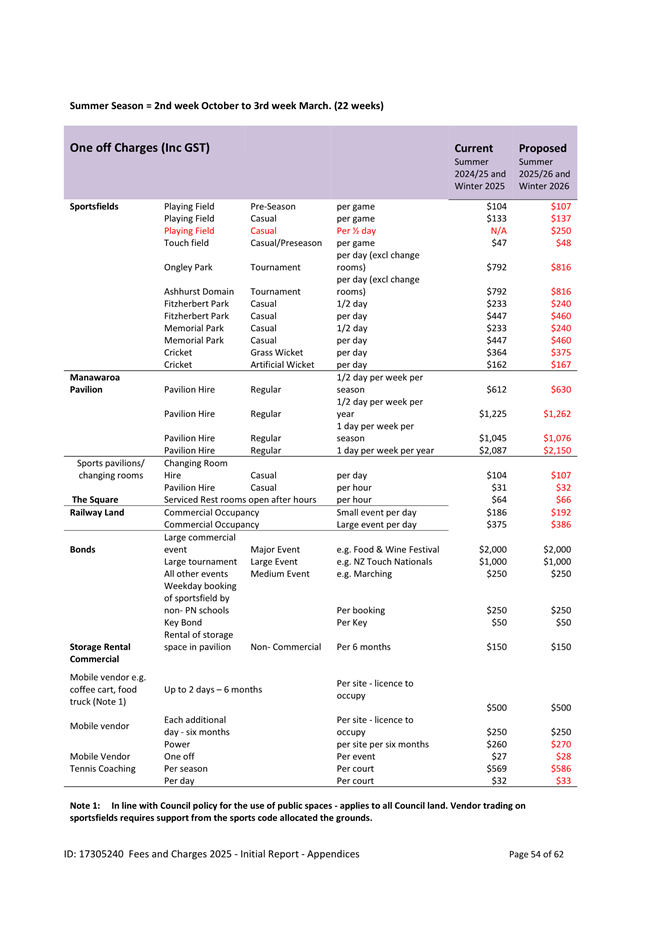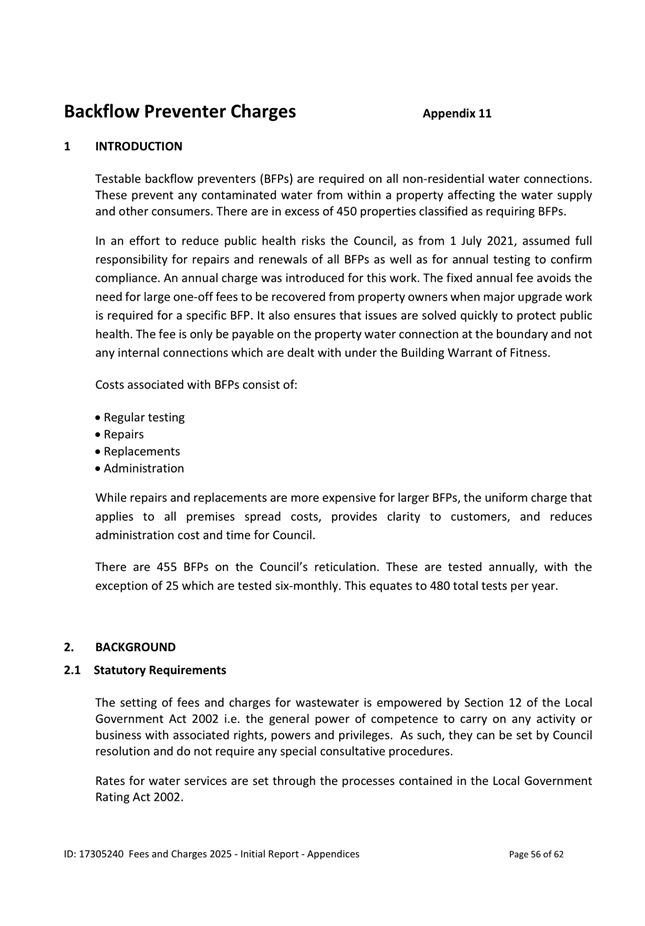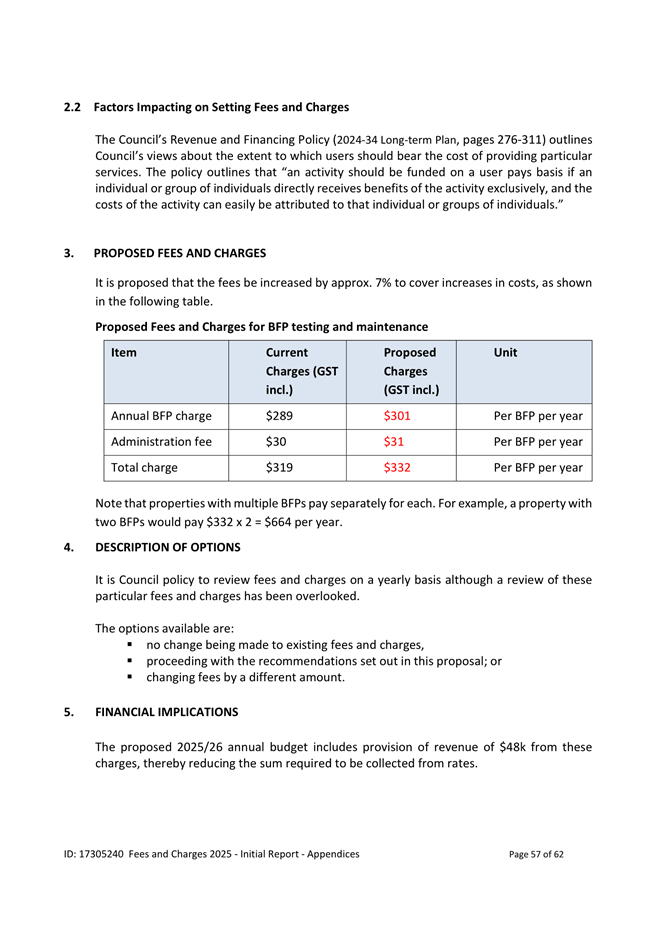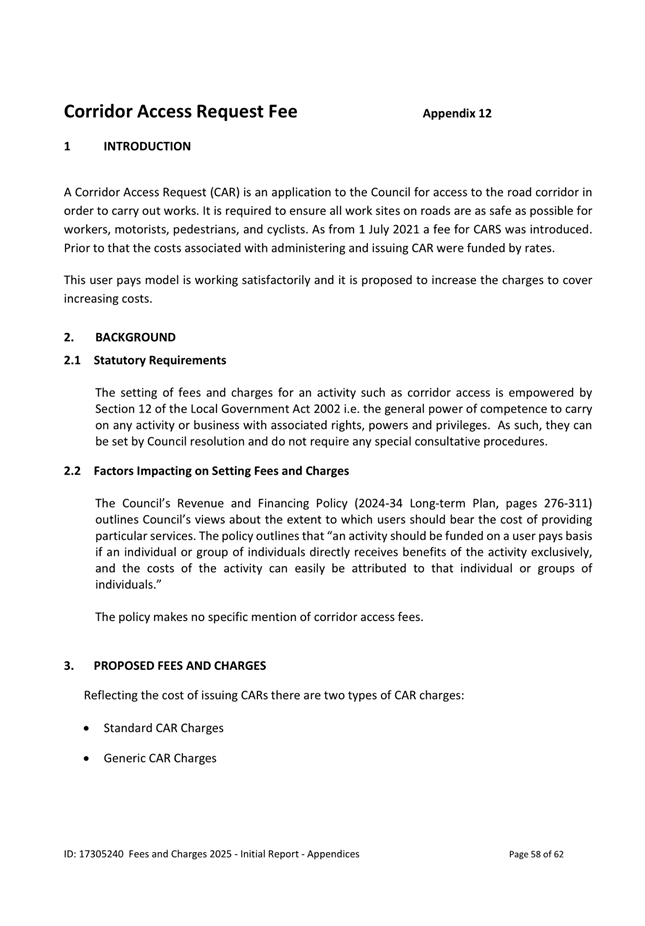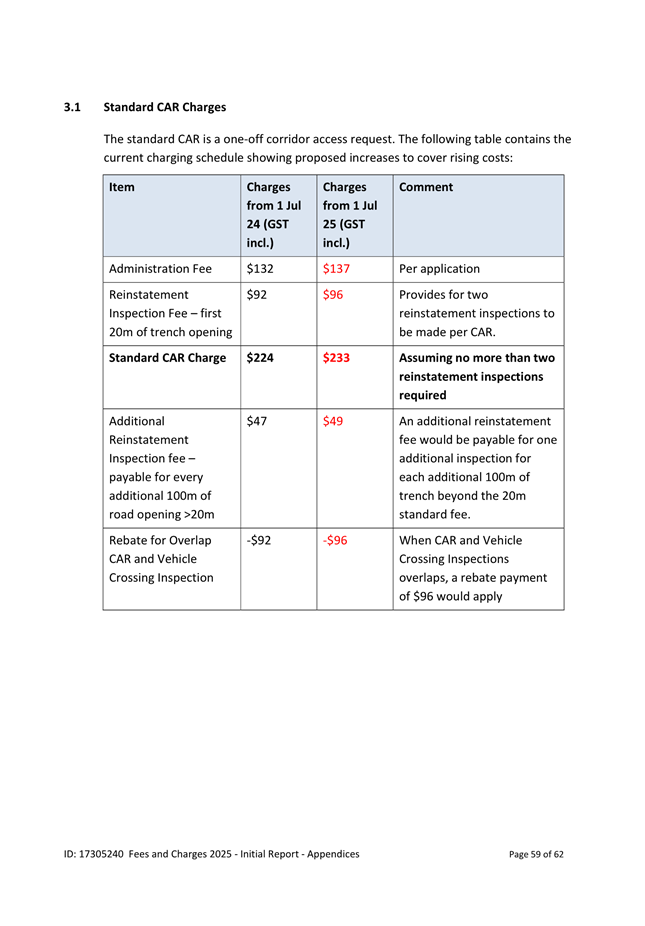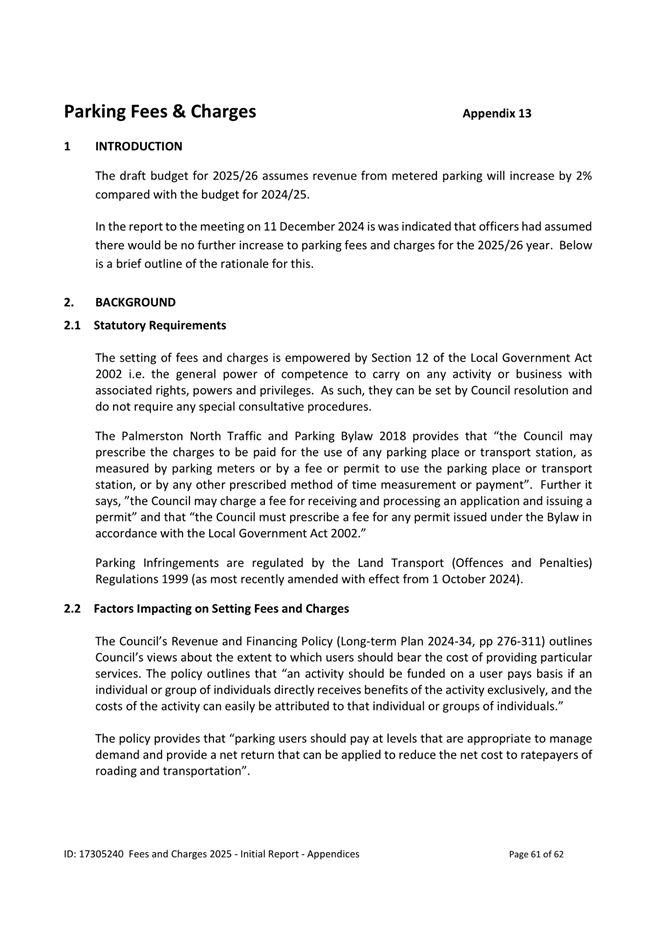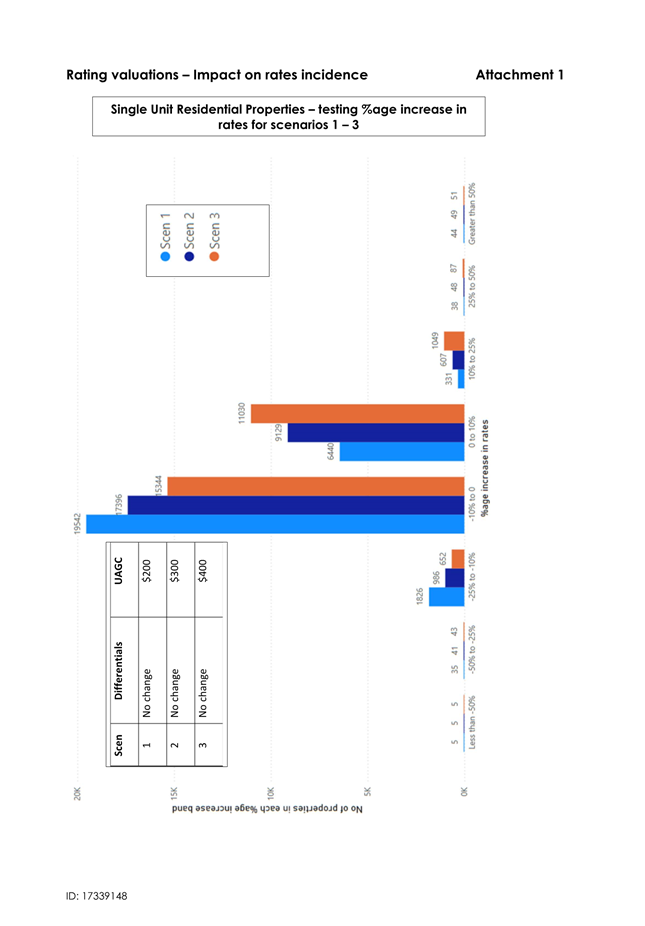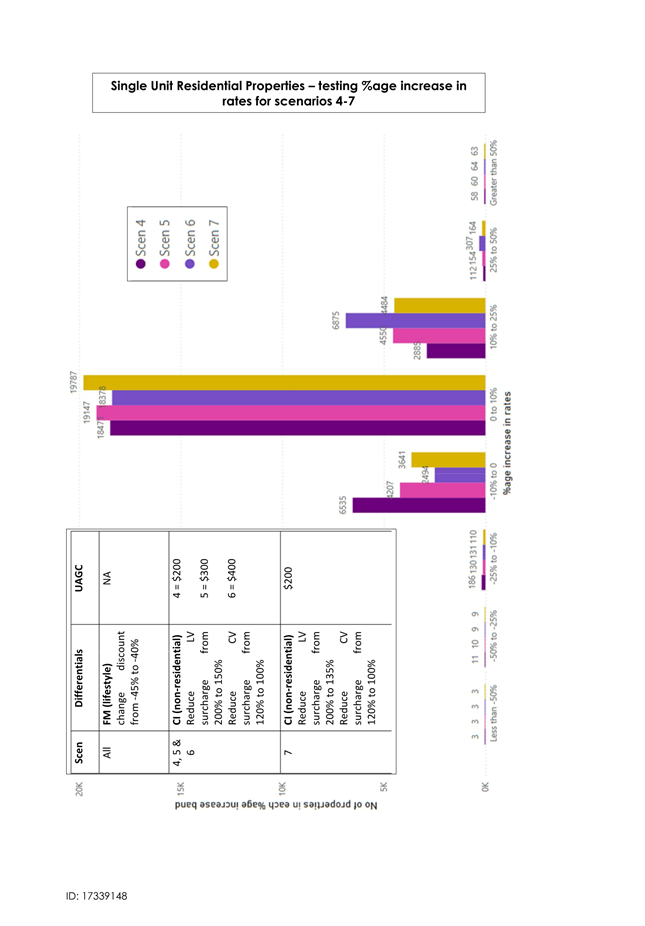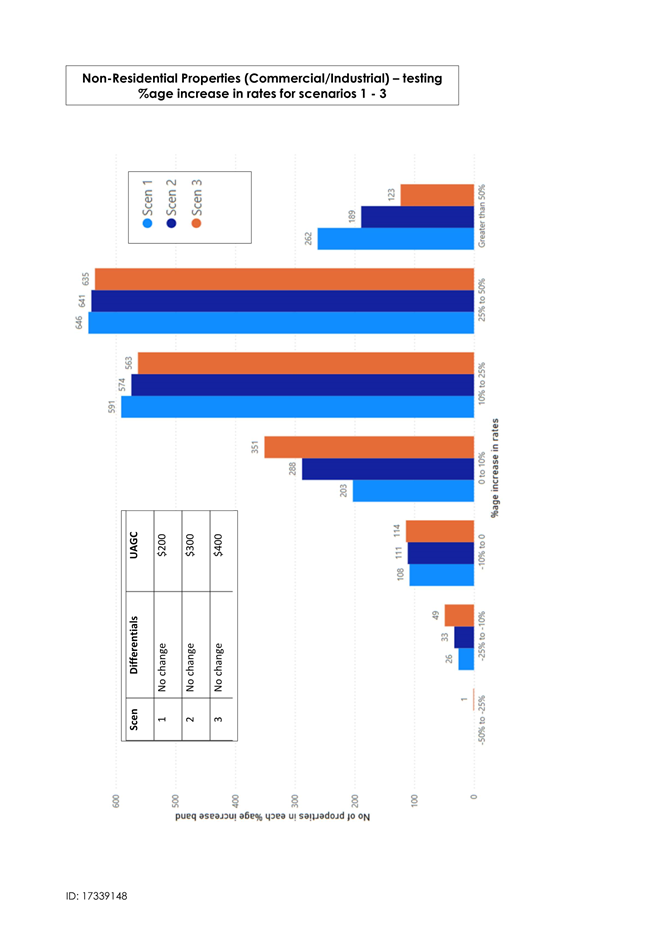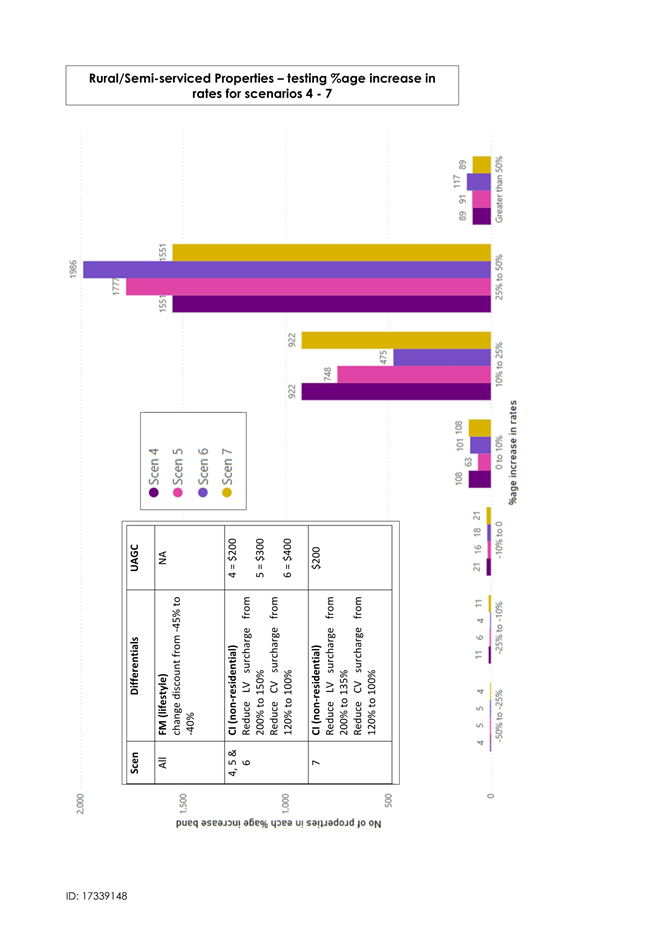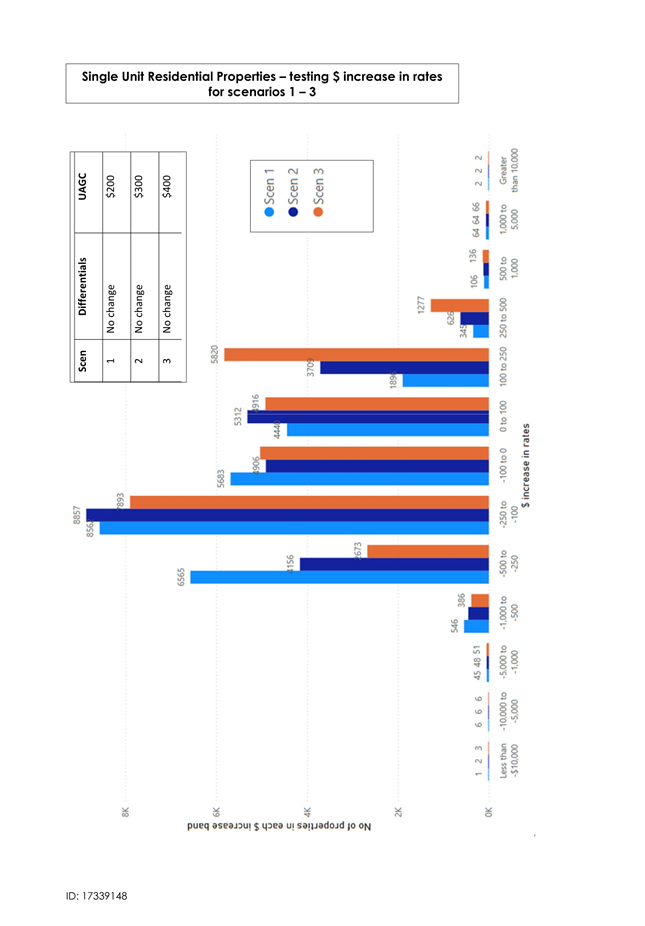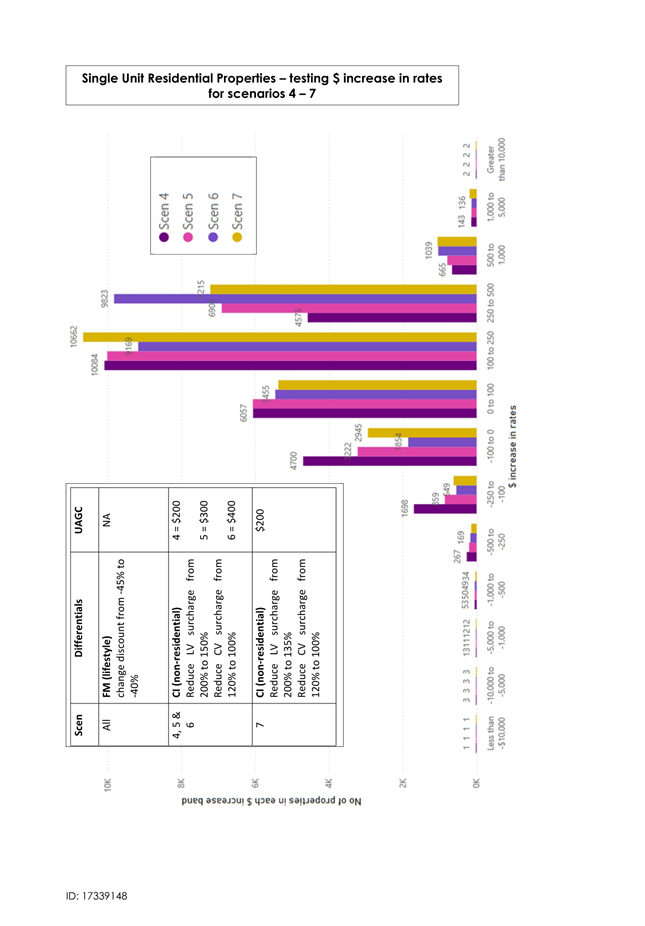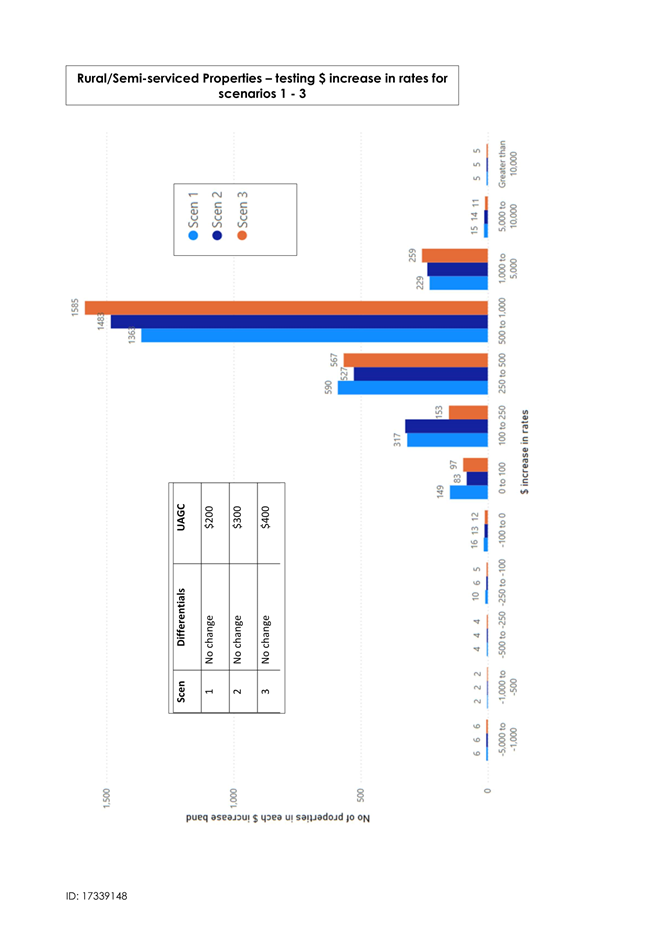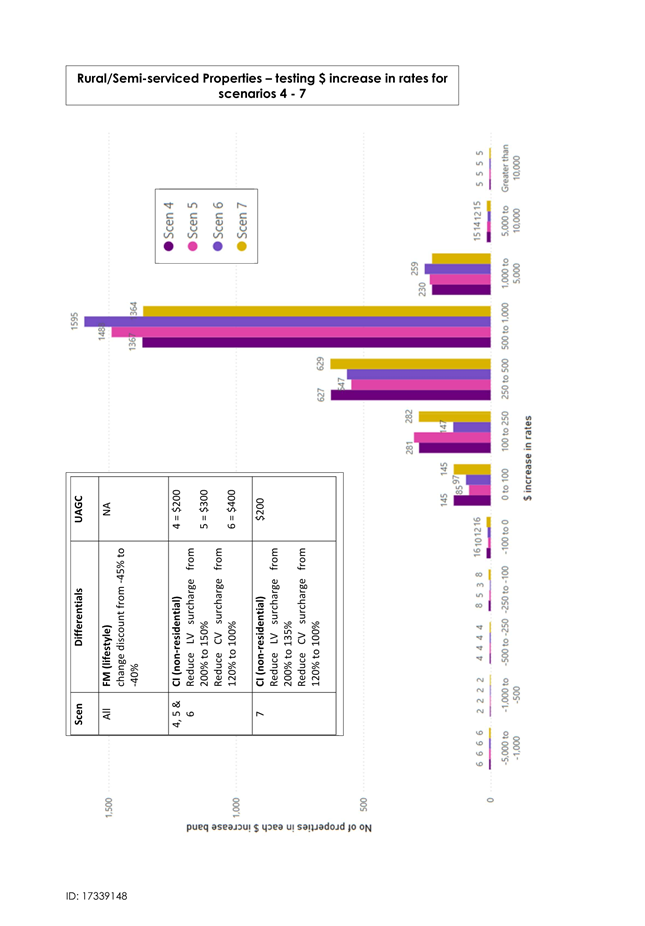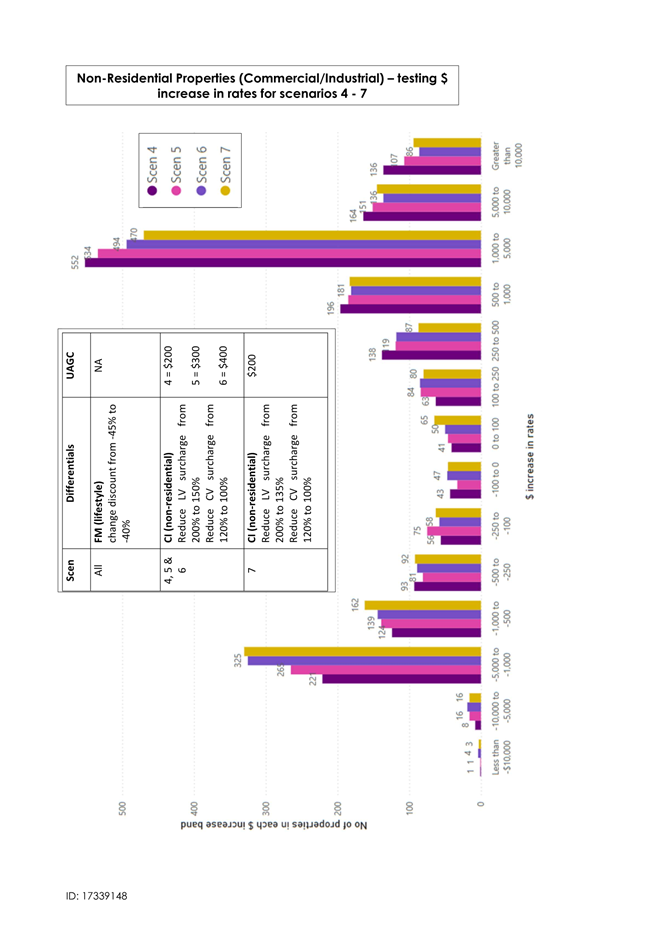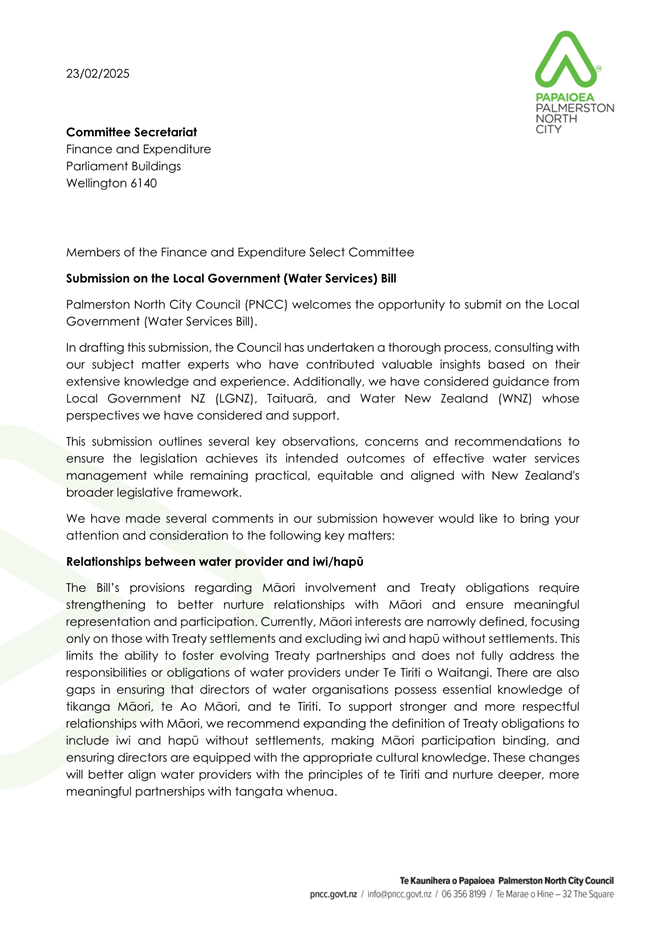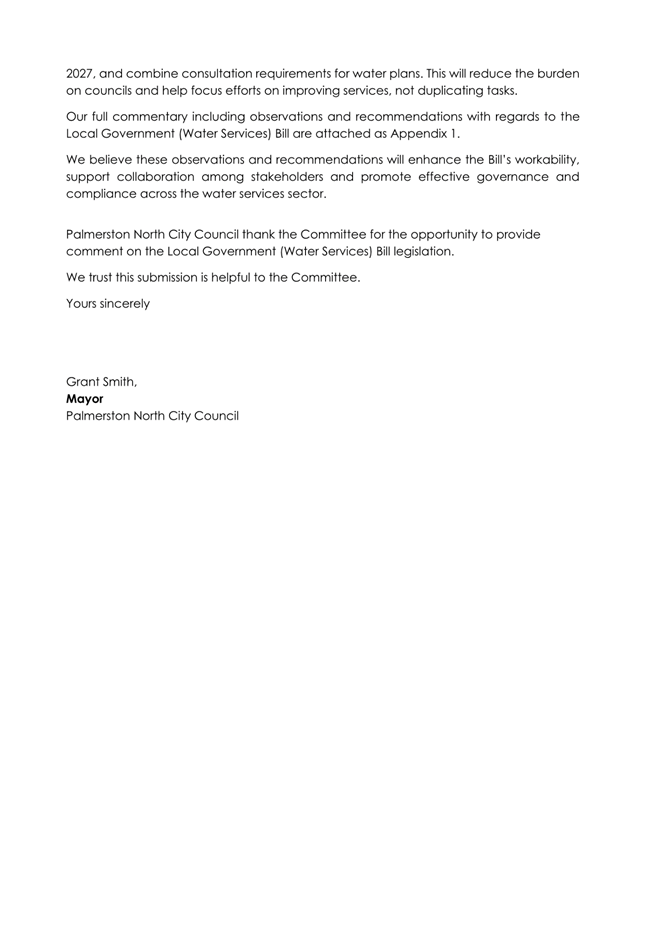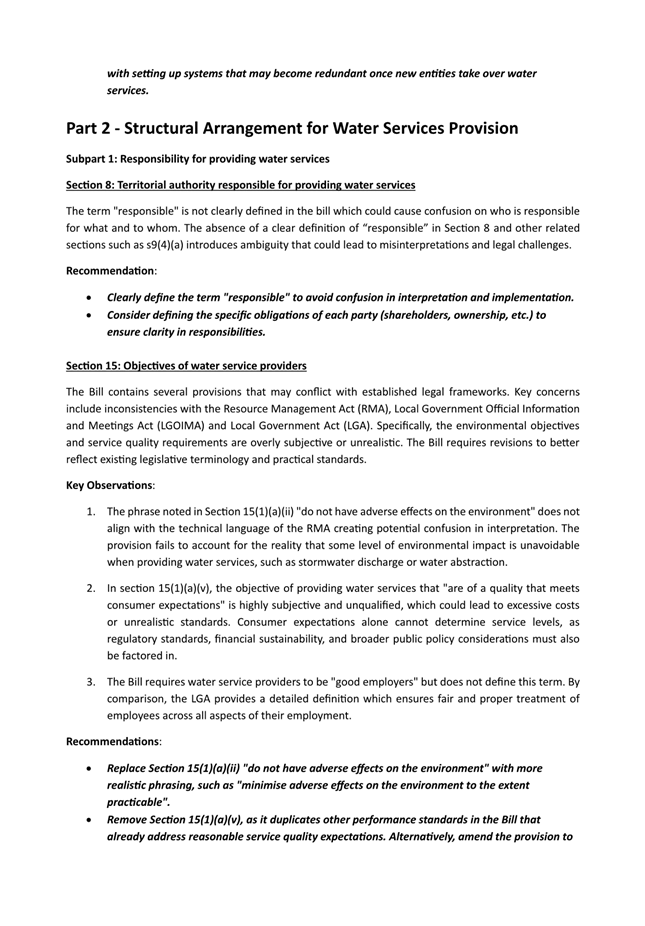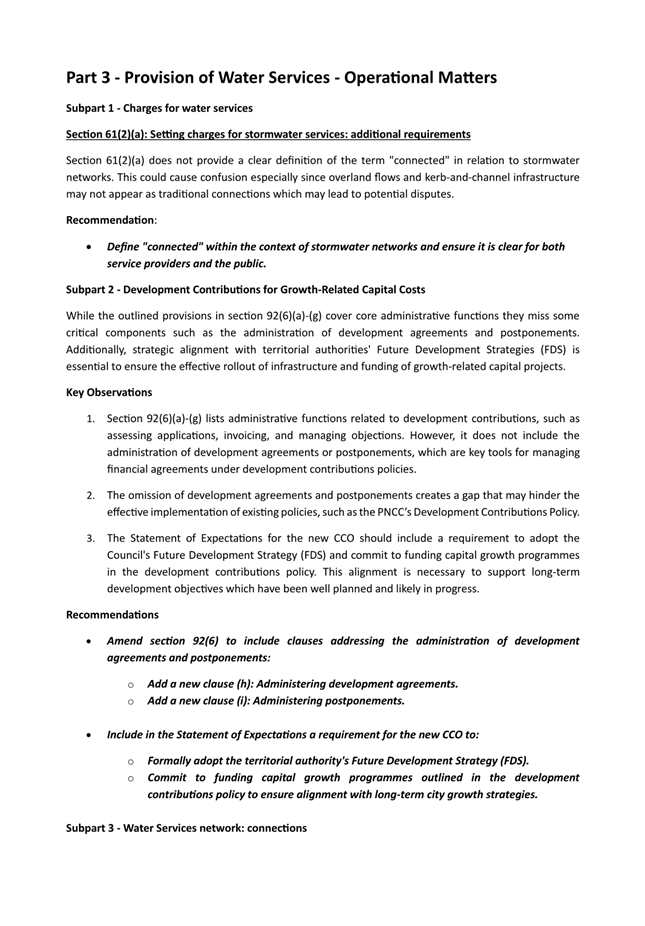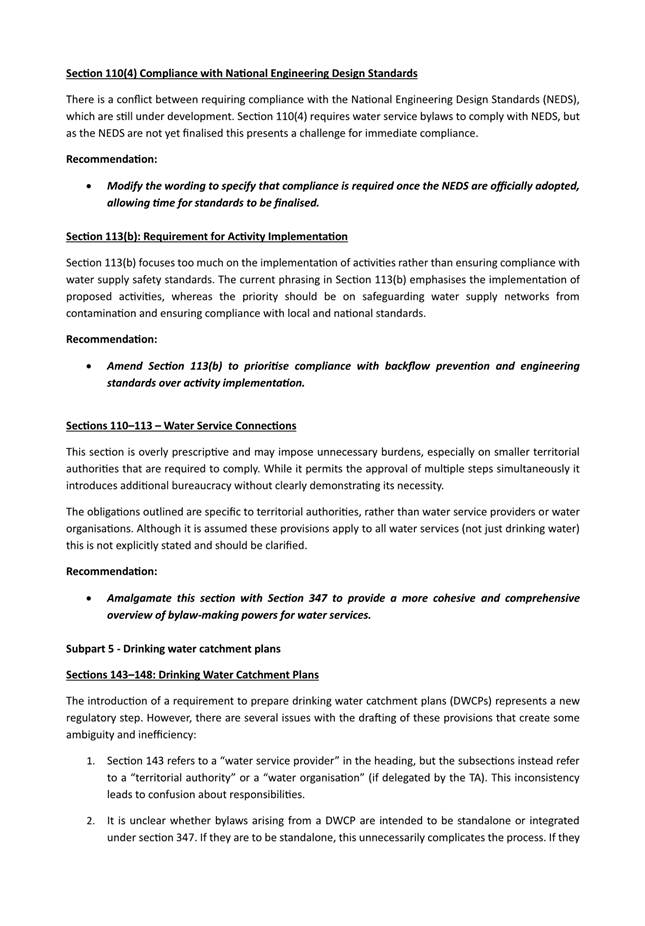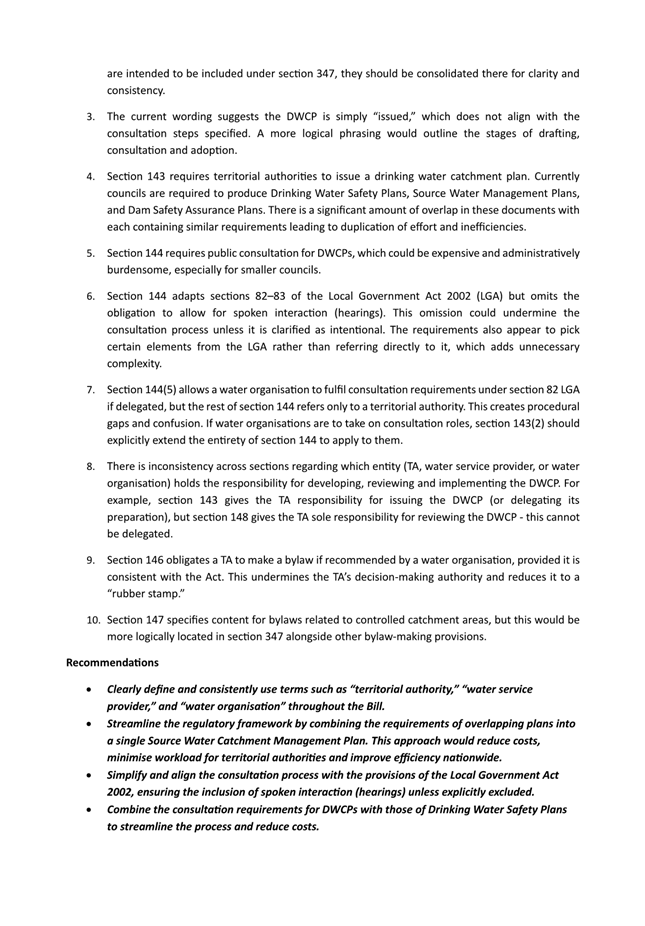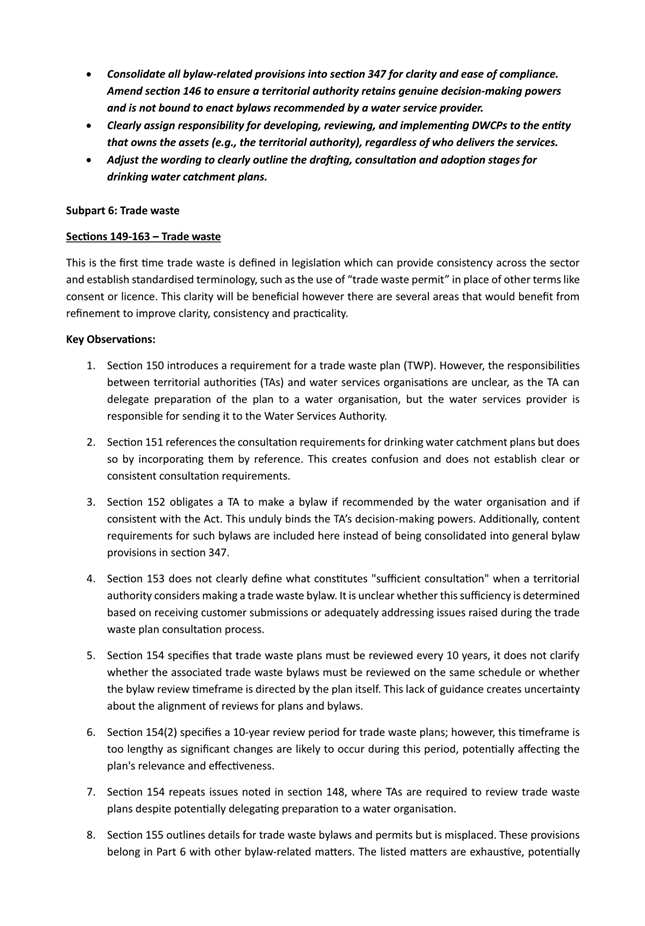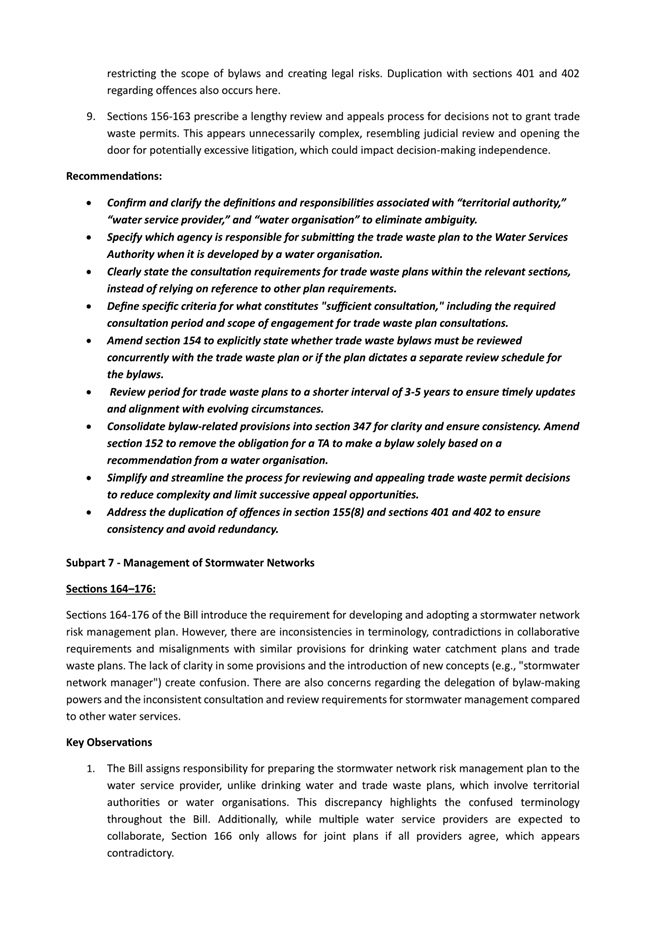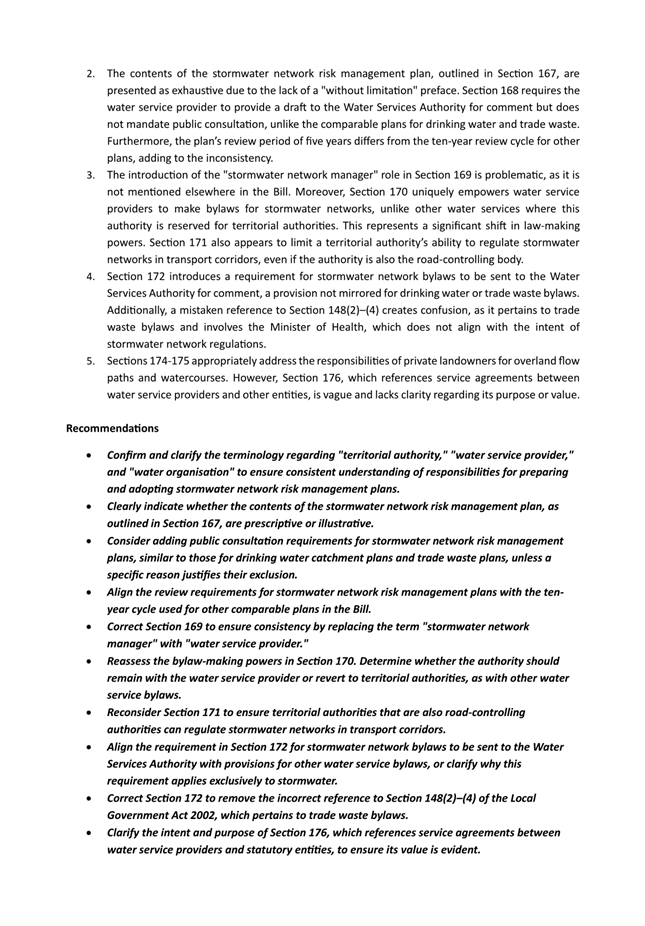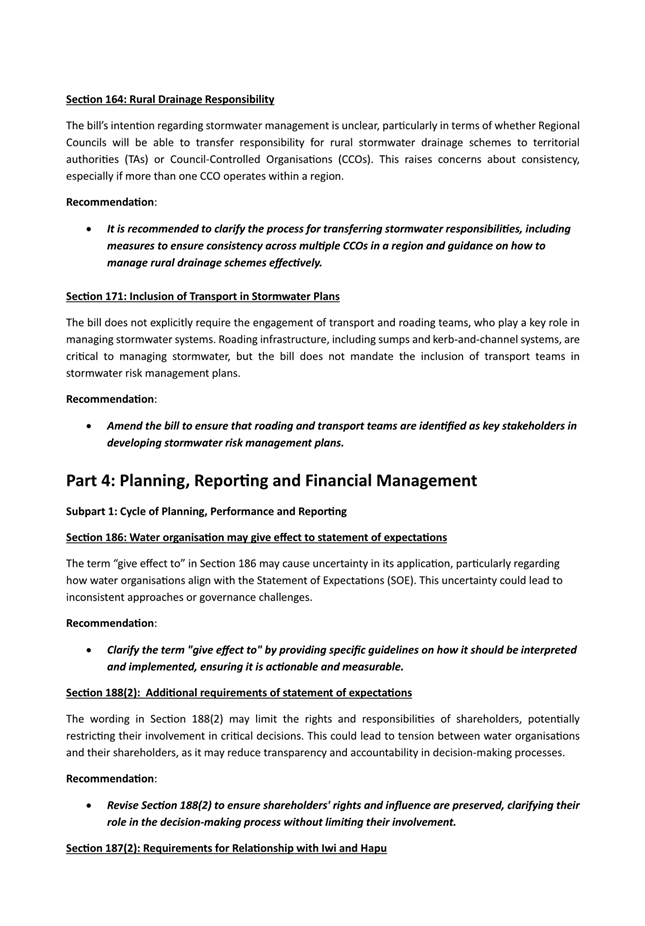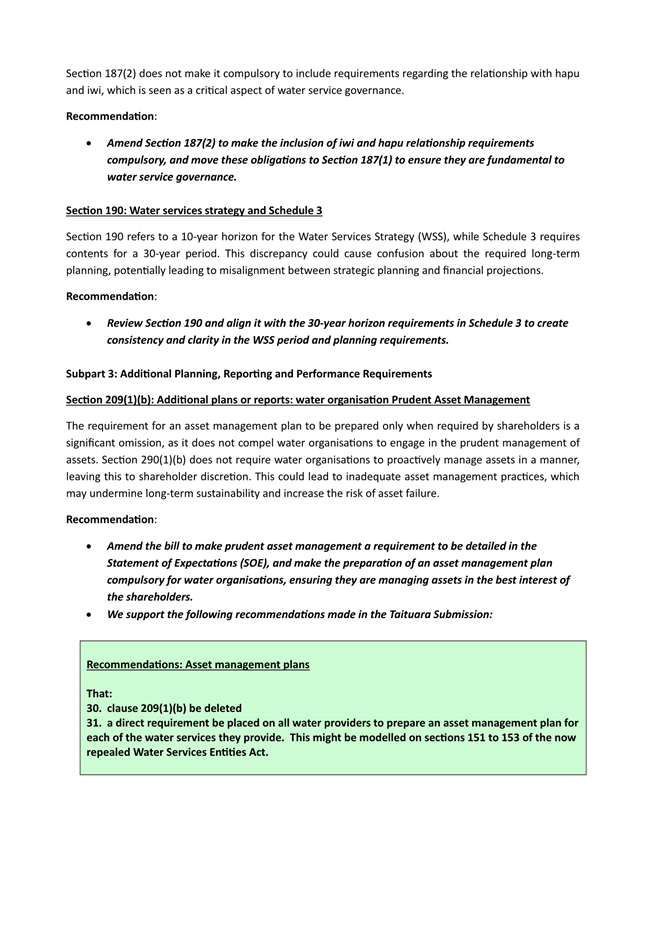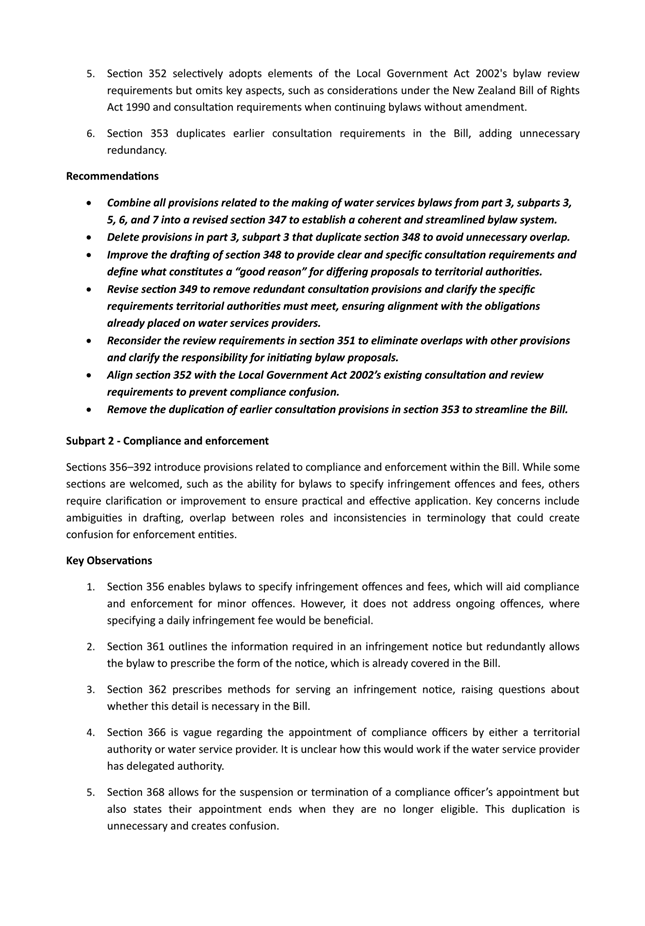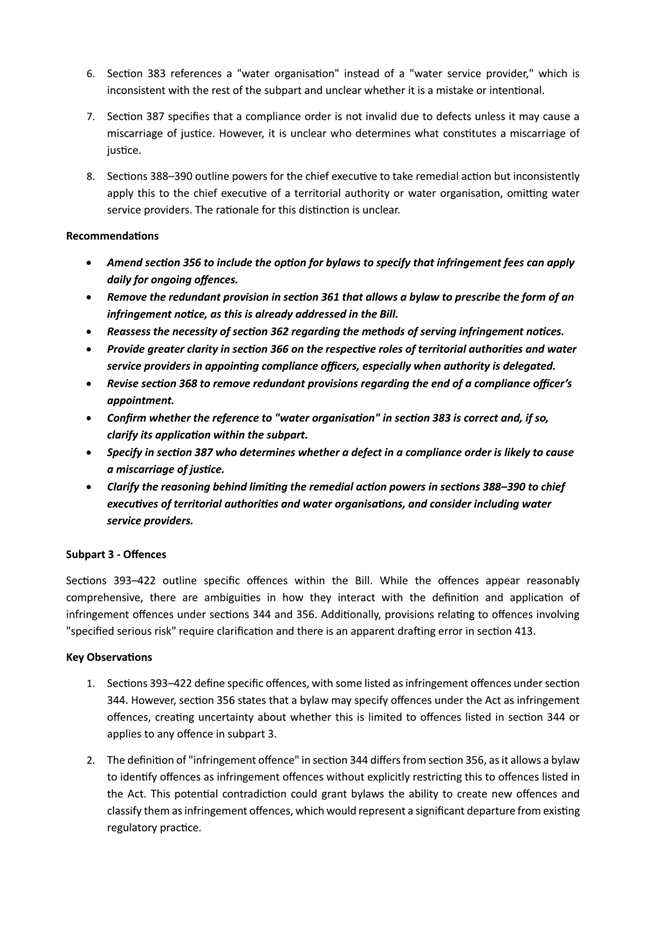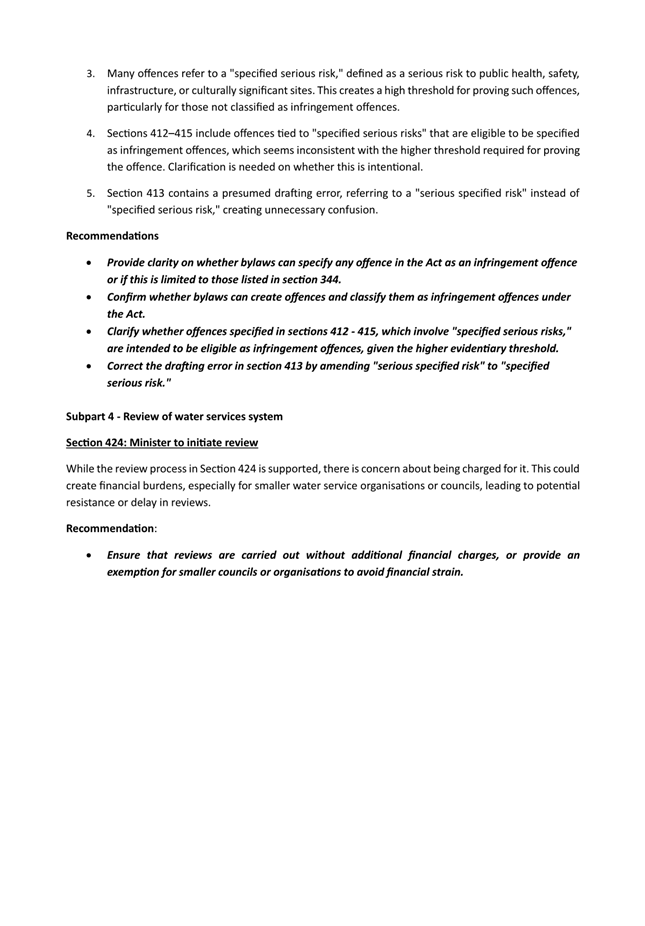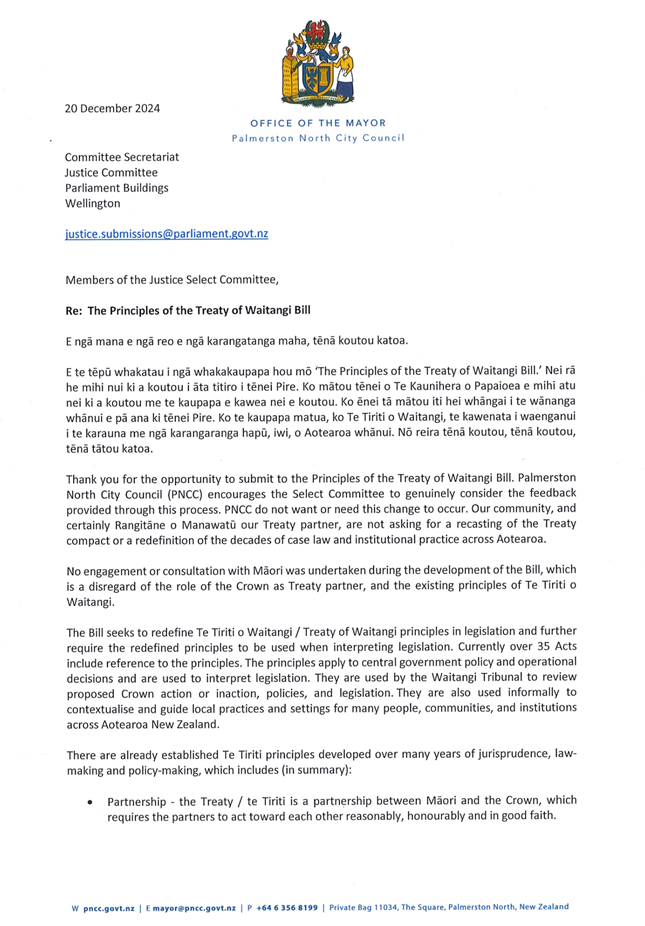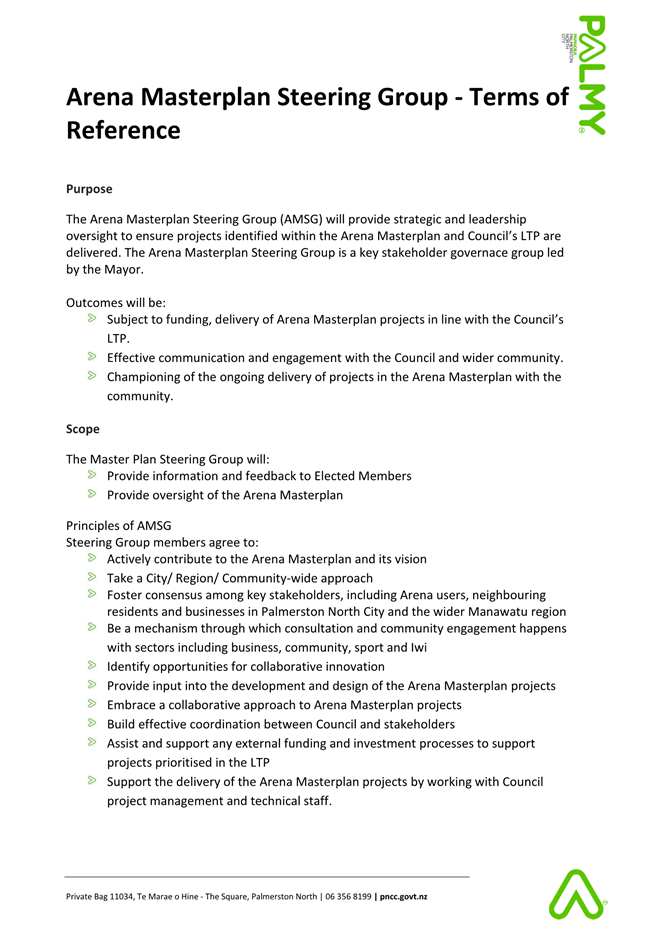|
Grant
Smith (Mayor)
|
|
Debi
Marshall-Lobb (Deputy Mayor)
|
|
Mark
Arnott
|
Leonie
Hapeta
|
|
Brent
Barrett
|
Lorna
Johnson
|
|
Rachel
Bowen
|
Billy
Meehan
|
|
Vaughan
Dennison
|
Orphée
Mickalad
|
|
Lew
Findlay (QSM)
|
Karen
Naylor
|
|
Roly
Fitzgerald
|
William
Wood
|
|
Patrick
Handcock (ONZM)
|
Kaydee
Zabelin
|
Council MEETING
12 February 2025
Order of Business
1. Karakia
Timatanga
2. Apologies
3. Notification
of Additional Items
Pursuant to
Sections 46A(7) and 46A(7A) of the Local Government Official Information and
Meetings Act 1987, to receive the Chairperson’s explanation that
specified item(s), which do not appear on the Agenda of this meeting and/or the
meeting to be held with the public excluded, will be discussed.
Any
additions in accordance with Section 46A(7) must be approved by resolution with
an explanation as to why they cannot be delayed until a future meeting.
Any
additions in accordance with Section 46A(7A) may be received or referred to a
subsequent meeting for further discussion. No resolution, decision or
recommendation can be made in respect of a minor item.
4. Declarations
of Interest (if any)
Members
are reminded of their duty to give a general notice of any interest of items to
be considered on this agenda and the need to declare these interests.
5. Public
Comment
To receive
comments from members of the public on matters specified on this Agenda or, if
time permits, on other matters.
6. Presentation
- Massey University Foundation Page 7
7. Confirmation
of Minutes Page 9
That the minutes of the ordinary Council meeting of 5
February 2025 Part I Public be confirmed as a true and correct record.
Reports
8. Annual
Budget (Plan) 2025/26 - Update including draft Consultation Document and
Supporting Information Page 19
Memorandum, presented by Steve Paterson, Manager - Financial
Strategy and Scott Mancer, Manager - Finance.
9. Fees and
Charges Review Page 223
Report, presented by Steve Paterson, Manager -
Financial Strategy.
10. Rating System for
2025/26 Page 293
Memorandum, presented by Steve Paterson, Manager -
Financial Strategy.
11. Submission on the
Local Government (Water Services) Bill Page 317
Memorandum, presented by Mike Monaghan, Group Manager -
3 Waters and Julie Keane, Transition Manager Three Waters.
12. Submission on
Treaty of Waitangi Principles Bill Page 341
Memorandum, presented by Todd Taiepa, Manager -
Māori Advisory.
13. Arena Masterplan
Steering Group Page 347
Memorandum, presented by John Lynch, Manager Venues +
Events.
14. Order of Candidate
Names on Voting Papers 2025 Page 355
Report, presented by Hannah White, Manager - Governance.
15. Appointment to the
Heritage Reference Group Page 361
Memorandum, presented by Hannah White, Manager -
Governance.
16. Council Work
Schedule Page 363
17. Karakia
Whakamutunga
18. Exclusion
of Public
|
|
To be
moved:
“That the public be excluded from the
following parts of the proceedings of this meeting listed in the table below.
The general subject of each matter to be considered
while the public is excluded, the reason for passing this resolution in
relation to each matter, and the specific grounds under Section 48(1) of the
Local Government Official Information and Meetings Act 1987 for the passing
of this resolution are as follows:
|
General subject of each matter to be
considered
|
Reason for passing this resolution in
relation to each matter
|
Ground(s) under Section 48(1) for
passing this resolution
|
|
19.
|
Confirmation of the minutes of the ordinary
Council meeting of 5 February 2025 Part II Confidential
|
For the reasons set out in the Council of 5 February
2025, held in public present.
|
|
|
|
|
This resolution is made in reliance on Section
48(1)(a) of the Local Government Official Information and Meetings Act 1987
and the particular interest or interests protected by Section 6 or Section 7
of that Act which would be prejudiced by the holding of the whole or the
relevant part of the proceedings of the meeting in public as stated in the
above table.
|
Presentation
TO: Council
MEETING DATE: 12
February 2025
TITLE: Presentation
- Massey University Foundation
FROM:
RECOMMENDATION(S)
TO Council
1. That the
Council receive the presentation for information.
Mitch Murdoch, Director of the Massey University
Foundation, will update the Council on the Foundation’s projects and
plans.
Attachments
NIL
Palmerston North City Council
Minutes of
the Council Meeting Part I Public, held in the Council Chamber, First Floor,
Civic Administration Building, 32 The Square, Palmerston North on 05 February 2025,
commencing at 9.00am
|
Members
Present:
|
Grant Smith (The Mayor) (in the Chair)
and Councillors Debi Marshall-Lobb, Mark Arnott, Brent Barrett, Rachel Bowen,
Vaughan Dennison, Lew Findlay, Roly Fitzgerald, Patrick Handcock, Leonie
Hapeta, Billy Meehan, Orphée Mickalad, Karen Naylor, William Wood and
Kaydee Zabelin.
|
|
Apologies:
|
Councillor Lorna Johnson (lateness)
|
Councillor Lorna Johnson entered the meeting at 9.23am during
consideration of clause 3-25. She was not present
for clauses 1-25 and 2-25.
Councillor Leonie Hapeta left the meeting at 12.25pm after
consideration of clause 7-25. She was not present
for clauses 8-25 to 14-25.
|
|
Karakia
Timatanga
|
|
|
Councillor
Debi Marshall-Lobb opened the meeting with karakia.
|
|
1-25
|
Apologies
|
|
|
Moved Grant Smith, seconded Debi Marshall-Lobb.
RESOLVED
1. That
Council receive the apologies.
|
|
|
Clause 1-25 above was carried 15 votes to 0, the voting being as
follows:
For:
The Mayor (Grant Smith) and Councillors Debi Marshall-Lobb, Mark
Arnott, Brent Barrett, Rachel Bowen, Vaughan Dennison, Lew Findlay, Roly
Fitzgerald, Patrick Handcock, Leonie Hapeta, Billy Meehan, Orphée
Mickalad, Karen Naylor, William Wood and Kaydee Zabelin.
|
|
2-25
|
Public
Comment
|
|
|
Shaun
Kay spoke on the work of the Education is a right not a privilege Stationery
bank.
|
|
|
Moved Grant Smith, seconded Debi Marshall-Lobb.
RESOLVED
That the Public Comment
be received.
|
|
|
Clause 2-25 above was carried 15 votes to 0, the voting being as
follows:
For:
The Mayor (Grant Smith) and Councillors Debi Marshall-Lobb, Mark
Arnott, Brent Barrett, Rachel Bowen, Vaughan Dennison, Lew Findlay, Roly
Fitzgerald, Patrick Handcock, Leonie Hapeta, Billy Meehan, Orphée
Mickalad, Karen Naylor, William Wood and Kaydee Zabelin.
|
|
3-25
|
Presentation
- The Plaza, Kiwi Property
Presentation from Andrew
Heaphy, Senior Centre Manager, The Plaza and Linda Trainer, General Manager
– Assets, Kiwi Property.
The presenters discussed the
detrimental effect of the change in the rating system on the Plaza. Whilst
they agreed with the rationale to move towards capital value; they were
concerned with the speed at which the change was happening.
They requested Council
consider the following:
· Slow
the transition (to Capital value) from the proposed 3 years to 5 years,
· Lower
the differential factor for non-residential ratepayers
· Increase
the uniform annual general charge
Councillor Lorna Johnson entered
the meeting at 9.23am.
|
|
|
Moved
Grant Smith, seconded Debi Marshall-Lobb.
RESOLVED
1. That the Council receive the presentation for
information.
|
|
|
Clause 3-25 above was
carried 16 votes to 0, the voting being as follows:
For:
The Mayor (Grant Smith) and
Councillors Debi Marshall-Lobb, Mark Arnott, Brent Barrett, Rachel Bowen,
Vaughan Dennison, Lew Findlay, Roly Fitzgerald, Patrick Handcock, Leonie Hapeta,
Lorna Johnson, Billy Meehan, Orphée Mickalad, Karen Naylor, William
Wood and Kaydee Zabelin.
|
|
4-25
|
Confirmation
of Minutes
|
|
|
Moved Grant Smith, seconded Brent Barrett.
RESOLVED
1. That the
minutes of the extraordinary Council meeting of 5 December 2024 Part I Public
be confirmed as a true and correct record.
2. That the
minutes of the ordinary Council meeting of 11 December 2024 Part I Public be
confirmed as a true and correct record.
|
|
|
Clause 4-25 above was
carried 15 votes with 1 abstention, the voting being as follows:
For:
The Mayor (Grant Smith) and
Councillors Mark Arnott, Brent Barrett, Rachel Bowen, Vaughan Dennison, Lew
Findlay, Roly Fitzgerald, Patrick Handcock, Leonie Hapeta, Lorna Johnson,
Billy Meehan, Orphée Mickalad, Karen Naylor, William Wood and Kaydee
Zabelin.
Abstained:
Councillor Debi
Marshall-Lobb.
|
|
5-25
|
Tribute
- New Year's Honours 2025
The Mayor read out the
achievements of the New Year’s Honours recipients from Palmerston
North. He also acknowledged the achievements of the following former
Palmerstonians:
· Sam
Whitelock. (Now Hawkes Bay) Former resident and ex All Black Rugby
captain. Awarded ONZM for services to Rugby and Community/Mental
Health.
· Noel
Harris. (now Mt Maunganui) Former resident and premier Horse Racing
jockey. Awarded MNZM for services to Horse Racing.
|
|
|
Moved
Grant Smith, seconded Debi Marshall-Lobb.
RESOLVED
1. That Council congratulate the local recipients of
the New Year’s Honours 2025.
|
|
|
Clause 5-25 above was
carried 16 votes to 0, the voting being as follows:
For:
The Mayor (Grant Smith) and
Councillors Debi Marshall-Lobb, Mark Arnott, Brent Barrett, Rachel Bowen,
Vaughan Dennison, Lew Findlay, Roly Fitzgerald, Patrick Handcock, Leonie
Hapeta, Lorna Johnson, Billy Meehan, Orphée Mickalad, Karen Naylor,
William Wood and Kaydee Zabelin.
|
|
6-25
|
Local
Water Done Well- Approval for Consultation
Memorandum, presented by
Julie Keane - Transition Manager Three Waters, Mike Monaghan - Group Manager
Three Waters, Olivia Wix - Communications Manager.
Council requested several
amendments be made to the consultation document to further clarify some of
the issues and ensure continuity of how costs are presented throughout the
document.
|
|
|
Moved
Grant Smith, seconded Lorna Johnson.
RESOLVED
1. That the consultation document be edited and come
back to Council on 12 February, with the following edits:
· show
option of numbers plus inflation
· Option
2 – show which councils are possible for option 2 and effect of smaller
group on costs; range of options – best vs worst matrix.
· explain
changes to national standards and likely changes to costs due to them.
· whether
Nature Calls costs are included or not - show consistently across all
figures.
|
|
|
Clause 6-25 above was
carried 16 votes to 0, the voting being as follows:
For:
The Mayor (Grant Smith) and
Councillors Debi Marshall-Lobb, Mark Arnott, Brent Barrett, Rachel Bowen,
Vaughan Dennison, Lew Findlay, Roly Fitzgerald, Patrick Handcock, Leonie Hapeta,
Lorna Johnson, Billy Meehan, Orphée Mickalad, Karen Naylor, William
Wood and Kaydee Zabelin.
|
The
meeting adjourned at 11.05am.
The
meeting resumed at 11.20am.
|
7-25
|
Exemption
of Council Controlled Organisations
Memorandum, presented by
Sarah Claridge, Governance Advisor.
An amendment to
recommendation 4 was moved, which requested that the Globe and Regent
Theatres continue to present an annual Statement of Intent. An additional
recommendation was also moved ensuring that Council produce a Statement of
Expectation for the two theatre CCOs. Both resolutions were put to ensure
some continuity of current practice whilst allowing for an annual audit and
six-month report to no longer be required.
|
|
|
Moved
Grant Smith, seconded Debi Marshall-Lobb.
RESOLVED
3. That Council
decline the request from Te Manawa Museums Trust to become an exempted
organisation.
|
|
|
Clause 7-25 above was
carried 12 votes to 4, the voting being as follows:
For:
The Mayor (Grant Smith) and
Councillors Debi Marshall-Lobb, Mark Arnott, Brent Barrett, Vaughan Dennison,
Lew Findlay, Roly Fitzgerald, Patrick Handcock, Leonie Hapeta, Lorna Johnson,
Billy Meehan and Orphée Mickalad.
Against:
Councillors Rachel Bowen,
Karen Naylor, William Wood and Kaydee Zabelin.
|
|
|
Moved
Grant Smith, seconded Debi Marshall-Lobb.
RESOLVED
1. That Council approve the
request to treat the Globe Theatre
Trust as an exempted organisation for the purpose of compliance and
external financial audit; for three years from 5 February 2025 to 5 February
2028, pursuant to Section 7 of the Local Government Act 2002.
2. That Council approve the request to treat the
Regent Theatre Trust as an exempted organisation for the purpose of
compliance and external financial audit; for three years from 5 February 2025
to 5 February 2028, pursuant to Section 7 of the Local Government Act 2002.
4. That Council request the Globe Theatre Trust and
Regent Theatre Trust present an annual Statement of Intent and Annual Report
to the relevant committee.
|
|
|
Clause 7-25 above was
carried 16 votes to 0, the voting being as follows:
For:
The Mayor (Grant Smith) and
Councillors Debi Marshall-Lobb, Mark Arnott, Brent Barrett, Rachel Bowen,
Vaughan Dennison, Lew Findlay, Roly Fitzgerald, Patrick Handcock, Leonie
Hapeta, Lorna Johnson, Billy Meehan, Orphée Mickalad, Karen Naylor,
William Wood and Kaydee Zabelin.
|
|
|
Moved
Rachel Bowen, seconded Brent Barrett.
RESOLVED
5. That Council continue to
provide a three - yearly Statement of Expectation to The Globe Theatre
Trust and Regent Theatre Trust.
|
|
|
Clause 7-25 above was
carried 16 votes to 0, the voting being as follows:
For:
The Mayor (Grant Smith) and
Councillors Debi Marshall-Lobb, Mark Arnott, Brent Barrett, Rachel Bowen,
Vaughan Dennison, Lew Findlay, Roly Fitzgerald, Patrick Handcock, Leonie
Hapeta, Lorna Johnson, Billy Meehan, Orphée Mickalad, Karen Naylor,
William Wood and Kaydee Zabelin.
|
|
|
Moved
Rachel Bowen, seconded Brent Barrett.
On an amendment to
recommendation 4: That Council request the Globe Theatre Trust and Regent
Theatre Trust present an annual Statement of Intent and their Annual Report to the relevant committee.
RB/BB
The amendment was carried 11 votes to 5, the voting being as followed
For:
Councillors Debi
Marshall-Lobb, Brent Barrett, Rachel Bowen, Vaughan Dennison, Lew Findlay,
Roly Fitzgerald, Patrick Handcock, Orphée Mickalad, Karen Naylor,
William Wood and Kaydee Zabelin.
Against:
The Mayor (Grant Smith) and Councillors Mark Arnott,
Leonie Hapeta, Lorna Johnson and Billy Meehan.
|
The
meeting adjourned at 12.25pm.
The
meeting resumed at 1.30pm.
Councillor Leonie Hapeta was
not present when the meeting resumed at 1:30pm.
|
8-25
|
Review
of CEDA Appointment of Director Policy - Creation of Working Group and Terms
of Reference
Memorandum, presented by
Sarah Claridge, Governance Advisor.
|
|
|
Moved Lew Findlay, seconded Debi Marshall-Lobb.
RESOLVED
1. That Council establish a joint working group with
Manawatū District Council to review the CEDA Appointment of Directors
Policy.
2. That Council approve
the Terms of Reference of the CEDA Appointment of Directors Policy Working
Group (Attachment 1).
|
|
|
Clause 8-25 above was carried 15 votes to 0, the
voting being as follows:
For:
The Mayor (Grant Smith) and Councillors Debi
Marshall-Lobb, Mark Arnott, Brent Barrett, Rachel Bowen, Vaughan Dennison,
Lew Findlay, Roly Fitzgerald, Patrick Handcock, Lorna Johnson, Billy Meehan,
Orphée Mickalad, Karen Naylor, William Wood and Kaydee Zabelin.
|
|
|
Moved
Lew Findlay, seconded Debi Marshall-Lobb.
RESOLVED
3. That Council agree
the Mayors’ recommendation to appoint Mayor Grant Smith, Councillor
Vaughan Dennison and Councillor Leonie Hapeta (as members of the Electoral
College) to the Working Group.
|
|
|
Clause 8-25 above was carried 12 votes to 1, with 2
abstentions, the voting being as follows:
For:
Councillors Debi Marshall-Lobb, Mark Arnott, Brent
Barrett, Rachel Bowen, Lew Findlay, Roly Fitzgerald, Patrick Handcock, Lorna
Johnson, Billy Meehan, Orphée Mickalad, William Wood and Kaydee
Zabelin.
Against:
Councillor Karen Naylor.
Abstained:
The Mayor (Grant Smith) and Councillor Vaughan
Dennison.
|
|
9-25
|
Civic
Fund Establishment - Te Awa Community Foundation
Memorandum, presented by
Richard Carr, Commercial Partnerships and Funding Manager.
|
|
|
Moved
Grant Smith, seconded Debi Marshall-Lobb.
RESOLVED
1. That Council
note progress towards establishing a civic fund in conjunction with the Te
Awa Community Foundation.
|
|
|
Clause 9-25 above was
carried 15 votes to 0, the voting being as follows:
For:
The Mayor (Grant Smith) and
Councillors Debi Marshall-Lobb, Mark Arnott, Brent Barrett, Rachel Bowen,
Vaughan Dennison, Lew Findlay, Roly Fitzgerald, Patrick Handcock, Lorna
Johnson, Billy Meehan, Orphée Mickalad, Karen Naylor, William Wood and
Kaydee Zabelin.
|
|
10-25
|
Civic
and Cultural Precinct: 6 Month Update
Memorandum, presented by
David Murphy, General Manager Strategic Planning and Richard Carr, Commercial
Partnerships and Funding Manager.
|
|
|
Moved
Grant Smith, seconded Debi Marshall-Lobb.
RESOLVED
1. That Council
receive the report titled Civic and Cultural Precinct: 6 Month Update,
presented on 5 February 2025.
|
|
|
Clause 10-25 above was
carried 15 votes to 0, the voting being as follows:
For:
The Mayor (Grant Smith) and
Councillors Debi Marshall-Lobb, Mark Arnott, Brent Barrett, Rachel Bowen,
Vaughan Dennison, Lew Findlay, Roly Fitzgerald, Patrick Handcock, Lorna
Johnson, Billy Meehan, Orphée Mickalad, Karen Naylor, William Wood and
Kaydee Zabelin.
|
|
11-25
|
Council
Work Schedule
|
|
|
Moved
Grant Smith, seconded Debi Marshall-Lobb.
RESOLVED
1. That Council receive its Work Schedule dated 5
February 2025
|
|
|
Clause 11-25 above was
carried 15 votes to 0, the voting being as follows:
For:
The Mayor (Grant Smith) and
Councillors Debi Marshall-Lobb, Mark Arnott, Brent Barrett, Rachel Bowen,
Vaughan Dennison, Lew Findlay, Roly Fitzgerald, Patrick Handcock, Lorna
Johnson, Billy Meehan, Orphée Mickalad, Karen Naylor, William Wood and
Kaydee Zabelin.
|
Exclusion
of Public
|
12-25
|
Recommendation to
Exclude Public
|
|
|
Moved Grant Smith, seconded Debi Marshall-Lobb.
RESOLVED
That the public be excluded from the following parts
of the proceedings of this meeting listed in the table below.
The general subject of each matter to be considered
while the public is excluded, the reason for passing this resolution in
relation to each matter, and the specific grounds under Section 48(1) of the Local
Government Official Information and Meetings Act 1987 for the passing of this
resolution are as follows:
|
General subject of each matter to be
considered
|
Reason for passing this resolution in
relation to each matter
|
Ground(s) under Section 48(1) for passing
this resolution
|
|
18.
|
Confirmation of the minutes of the ordinary
Council meeting of 11 December 2024 Part II Confidential
|
For the reasons set out in the Council of 11
December 2024, held in public present.
|
|
|
19.
|
Sale and Purchase of Property on Ruahine Street
|
COMMERCIAL ACTIVITIES:
This information needs to be kept confidential to
allow Council to engage in commercial activities without prejudice or
disadvantage
|
s7(2)(h)
|
This resolution is made in reliance on Section
48(1)(a) of the Local Government Official Information and Meetings Act 1987
and the particular interest or interests protected by Section 6 or Section 7
of that Act which would be prejudiced by the holding of the whole or the
relevant part of the proceedings of the meeting in public as stated in the
above table.
|
|
|
Clause 12-25 above was carried 15 votes to 0, the voting being as
follows:
For:
The Mayor (Grant Smith) and Councillors Debi Marshall-Lobb, Mark
Arnott, Brent Barrett, Rachel Bowen, Vaughan Dennison, Lew Findlay, Roly Fitzgerald,
Patrick Handcock, Lorna Johnson, Billy Meehan, Orphée Mickalad, Karen
Naylor, William Wood and Kaydee Zabelin.
|
Councillor Vaughan Dennison
left the meeting at 2:06pm
The public part
of the meeting finished at 2.06pm.
Confirmed 12 February 2025
Mayor
Memorandum
TO: Council
MEETING DATE: 12
February 2025
TITLE: Annual
Budget (Plan) 2025/26 - Update including draft Consultation Document and
Supporting Information
Presented
By: Steve
Paterson, Manager - Financial Strategy and Scott Mancer, Manager - Finance
APPROVED BY: Cameron
McKay, General Manager Corporate Services
RECOMMENDATIONS TO
Council
1. That the
Chief Executive incorporate the following in the draft 2025/26 Annual Budget
supporting information for adoption at the Council meeting of 5 March 2025:
a. Budgetary
assumptions that are unchanged from those agreed to at the Council meeting on
11 December 2024, except for the addition of operating expenditure budget of
$400K to fund the proposed levy from the water services regulator.
b. Financial statements
and other supporting information based on the drafts included as Attachment 2,
noting that $100,000 has been set aside in each of the financial years 2025/26
and 2026/27 to support the Centrepoint Theatre rebuild, until further
confirmation from Centrepoint as to which allocation of support (in-kind,
consent costs, grant) would be most appropriate.
2. That Council
note the Consultation Document will be presented for adoption at the Council
meeting of 5 March 2025, based on the draft in Attachment 3.
1. ISSUE
1.1 At
its meeting on 11 December 2024 Council resolved to:
“… instruct the
Chief Executive to prepare a draft of the Consultation Document and supporting
information for the Annual Budget 2025/26 for consideration by the Council at
its meeting on 12 February 2025 and that it contains:
a. key assumptions outlined in Section 4 amended by
confirming the proposed budget for remuneration as being $63m, being the $62.5m
as outlined in the Long-Term Plan 2024/34 plus $0.5m for positions which are
offset with additional revenue
b. programmes as agreed at the Council meeting on 6
November 2024
c. a budget for Local Water Done Well Transition support
in 2025/26 comprising expenditure of $1.5M funded by way of a grant subsidy of
$621,831 and the balance of $878,169 by way of loan (the grant subsidy is the
remainder of the balance of Better Off Funding, reallocated by resolution 214-24).
d. increase the resource recovery operating budget by
$65k to fund the delivery of Programme 2338 – Recycling Contamination
Monitoring Development
e. a budget of $120,000 to support a Street Lighting
survey
f. approve Option 1 and agree an additional budget of
$50K for the development and implementation of the Palmerston North Age
Friendly Implementation Plan
g. support the Centrepoint Theatre rebuild of up to $200k
over two years by:
i. In-kind support – officer time to support with
fundraising, promotion, communications etc; and
ii. Resource consent and building consent costs –
the application process for this is already underway; and
iii. Grant funding – the quantum to be determined at the 12 February
2025 Council meeting.
h. That the Chief Executive
look at reducing the professional services budgets in 2025/26 by $1M and
creating a new $1M Internal Capacity Building Budget to be used for
professional development, internal capacity support and staff remuneration; and
report back to 12 February 2025.”
1.2 This
report provides the information required in response to the resolutions above
and seeks endorsement of the content of the draft Consultation Document and
Supporting Information.
2. BACKGROUND
general
2.1 Council
has been following its agreed timetable
towards the adoption of a 2025/26 draft budget for consultation in March.
Materials presented today are based on direction received at Council meetings
of 6
November and 11
December 2024.
2.2 An
initial draft of the proposed Consultation Document is attached. Once
updated it will highlight what changes there are from Year 2 of the Long-term
Plan, primarily due to changed circumstances and updated timelines for some
programmes. It will also highlight proposed rates levels for (average)
properties.
2.3 A
strategy for public engagement has been developed. This will include provision
of the final Consultation Document and Supporting Information on
Council’s website and at the Customer Service Centre and libraries.
There will be opportunities for group meetings and for information to be
provided through social media channels. It is intended that a brief
document will be delivered to all households.
2.4 We
plan to have proposed rates for each property available to be viewed on the
Council’s website.
2.5 The
public will have the option of making a submission and being heard by Council.
2.6 Following
the consultation period and hearings, the Council will be required to adopt its
final Annual Budget (Plan) prior to 30 June 2025 (currently scheduled for 4
June following a deliberations meeting on 14 May 2025).
2.7 Attached
are the following:
Attachment
1 – provides and overview to the resolutions that were passed at the
6 December 2024 meeting regarding professional services, providing a summary of
the uses of the professional services budget.
Attachment
2 – drafts of the supporting information, including changes to
capital and operating budgets as resolved at the 6 November and 11 December
2024 meetings:
• Financial
overview and forecast financial statements
• Annual
Budget (Plan) Disclosure Statement
• Groups
of Activities information, including financial forecasts and programme
schedules
• Significant
forecasting assumptions
• Descriptions
of the proposed rating system, rates and funding impact statements
• Levels
of service and performance measures
Attachment
3 – draft of the proposed Consultation Document
BUDGET
UPDATE
2.8 The
budget is based on Year 2 of the Long-Term Plan updated to reflect subsequent
decisions of Council. Key matters influencing the preparation of the
annual budget were outlined in the reports to the meetings on 6 November and 11
December 2024. The current proposed increase for 2025/26 is lower than that
included in Year 2 of the Long-Term Plan.
2.9 In
addition to the matters resolved by the Council on 11 December 2024, an
additional budgeted operating expenditure of $400K has been included to reflect
the cost of the new levy being proposed by the Government to fund the water
regulator. As advised by the Department of Internal Affairs, the levy has
been allocated between the water activities as follows: water supply (75%),
wastewater (21%) and stormwater (4%).
2.10 Officers
have also been made aware, since the meeting on 11 December, of another
proposed levy for the Commerce Commission in relation to the economic
regulation of ringfencing water services activities. This new levy is proposed
to start from 1 July 2025 and initial calculations suggest that the levy for
Palmerston North would be circa $100K. If confirmed, officers will include this
in the papers for deliberations on 14 May 2025, however we will look to absorb
this within existing budgets, where possible.
2.11 Tables
1-3 below provide the latest summary of the draft budget compared to the
Long-Term Plan.
|
Table 1: Funding of Operating expenses
|
Long-term Plan
|
Draft Annual
budget
|
|
|
2024/25
$M
|
2025/26
$M
|
2025/26
Dec draft
$M
|
2025/26
Feb draft
$M
|
|
Personnel
Depreciation
Finance (interest)
All Other Operating Expenses
|
59.3
49.4
14.5
77.9
|
62.5
50.5
17.0
79.1
|
64.2
49.7
14.9
79.3
|
63.0
49.7
14.9
81.5
|
|
Total operating expenses
|
201.1
|
209.1
|
208.1
|
209.1
|
|
Operating subsidies & grants
Finance revenue
Other revenue
|
(6.4)
(0.4)
(38.6)
|
(6.5)
(0.4)
(39.2)
|
(5.5)
(0.5)
(40.0)
|
(6.1)
(0.5)
(40.0)
|
|
Total operating revenue
|
(45.4)
|
(46.1)
|
(46.0)
|
(46.6)
|
|
Net operating expenses
|
155.7
|
163.0
|
162.1
|
162.5
|
|
Less:
Depreciation
Operating expenses funded from
debt
Plus:
Renewals (3 year rolling average)
Debt repayment
|
(49.4)
(5.8)
28.6
7.8
|
(50.5)
(3.9)
30.9
9.6
|
(49.7)
(4.2)
31.2
9.6
|
(49.7)
(5.1)
31.2
9.6
|
|
Total rates requirement
|
136.9
|
149.1
|
149.0
|
148.5
|
|
Table 2: Funding of Capital Expenditure
|
Long-term Plan
|
Draft Annual
budget
|
|
|
2024/25
$M
|
2025/26
$M
|
2025/26
Dec draft
$M
|
2025/26
Feb draft
$M
|
|
Renewals
Capital for growth
Capital new
|
33.0
15.0
47.4
|
35.6
12.7
77.2
|
35.6
12.7
77.2
|
35.3
12.3
68.1
|
|
Total capital expenditure
|
95.4
|
125.5
|
125.5
|
115.7
|
|
Funding from external sources
|
(18.1)
|
(30.0)
|
(30.0)
|
(23.3)
|
|
Funding from rates (for renewals)
|
(28.6)
|
(30.9)
|
(30.9)
|
(31.2)
|
|
Funding from additional debt
|
(48.7)
|
(64.6)
|
(64.6)
|
(61.2)
|
|
Table 3: Components of increased rates
requirement
|
Impact on Total Rates for Year 2
|
|
As per LTP
|
As per draft AB
|
|
Interest Costs on Debt
|
1.8%
|
0.3%
|
|
Debt Repayment
|
1.4%
|
1.3%
|
|
Rolling Average Renewal increase
|
1.7%
|
1.9%
|
|
Labour Costs
|
2.3%
|
2.7%
|
|
Utilities and Insurance
|
0.2%
|
0.4%
|
|
All Other (Contractors, Professional Services, Materials
etc.)
|
2.1%
|
2.6%
|
|
Revenue (excluding Rates and Grants & Subsidies)
|
(0.5%)
|
(0.9%)
|
|
Revenue – Operating Grants & Subsidies
|
(0.1%)
|
0.2%
|
|
Increase in total rates requirement
|
8.9%
|
8.5%
|
2.12 The
tables include the funding of the Transport Omissions, plus the additional
funding of the Footpath Renewal Programme as resolved by Council on 6 November
2024. This equates to circa $1.5M or 1.1% out of the 8.5% of the increase. The
additional water levy mentioned in 2.9 above is a further 0.2% out of the 8.5%
proposed increase.
2.13 Additionally,
3.5% out of the 8.5% proposed increase relates to the funding of the capital
programme for the year (interest, debt repayment and rolling average renewal).
3. RATES ISSUES
3.1 The
budget assumes total rates revenue will need to increase by 8.5%.
3.2 Noting
that the impact on individual ratepayers will vary, options for the rates
system to apply for 2025/26 are outlined in the report ‘Rating System for
2025/26’ also on this meeting agenda.
4. NEXT STEPS
4.1 Officers
will make any changes resulting from the Council’s decisions.
4.2 An
updated final Consultation Document and supporting information will be
presented to the Council for adoption at its meeting on 5 March 2025.
5. Compliance and administration
|
Does Council have delegated
authority to decide?
|
Yes
|
|
Are the decisions significant?
|
No
|
|
If they are significant do they
affect land or a body of water?
|
No
|
|
Can this decision only be made
through a 10 Year Plan?
|
No
|
|
Does this decision require
consultation through the Special Consultative procedure?
|
Yes
|
|
Is there funding in the current
Annual Plan for these actions?
|
Yes
|
|
Are the recommendations
inconsistent with any of Council’s policies or plans?
|
No
|
|
The
recommendations contribute to the achievement of objective/objectives
in:
14.
Mahere mana urungi, kirirarautanga hihiri
14. Governance and Active
Citizenship Plan
The objective is: Base our
decisions on sound information and advice
|
|
Contribution to strategic
direction and to social, economic, environmental and cultural well-being
|
Adopting an annual budget/plan
each year is a fundamental legislative requirement and without this in place
the Council will not be able to set rates for the year and therefore fund any
of its actions, plans or strategies.
Palmerston North City Council
consults on its annual budget to ensure public awareness of any proposed
changes since the Long-Term Plan was agreed.
|
|
|
|
Attachments
|
1.
|
Professional
Services Information ⇩ 
|
|
|
2.
|
Draft
Supporting Information - Annual Budget 2025/26 ⇩ 
|
|
|
3.
|
Initial
draft of Consultation Document - Annual Budget 2025/26 ⇩ 
|
|

TO: Council
MEETING DATE: 12
February 2025
TITLE: Fees
and Charges Review
PRESENTED BY: Steve
Paterson, Manager Financial Strategy
APPROVED BY: Cameron
McKay, General Manager Corporate Services
RECOMMENDATIONS TO
Council
1. That Council
receive the report titled ‘Fees and Charges Review’, presented on
12 February 2025, and note the current status of fees and charges.
Trade Waste
2. That Council
agree for consultation the proposal of updated fees and charges for Trade Waste
services effective from 1 July 2025 as attached in Appendix 2 and authorise the
Chief Executive to undertake the necessary consultative process under sections
82 and 150 of the Local Government Act 2002;
OR
That Council agree for consultation the proposal of
updated fees and charges for Trade Waste services effective from 1 July 2025 as
attached in Appendix 2 (and amended using either Option A or Option B from
Table 1 in section 3.4 of this report) and authorise the Chief Executive to
undertake the necessary consultative process under sections 82 and 150 of the
Local Government Act 2002.
Planning & Miscellaneous
3. That Council
agree for consultation the Statement of Proposal (and the associated summary)
of updated fees and charges for Planning Services and Miscellaneous Services
effective from 1 July 2025 as attached in Appendix 3, and authorise the Chief
Executive to undertake the necessary consultative process under sections 83 and
150 of the Local Government Act 2002.
Building
4. That Council
agree the fees and charges for Building Services, as proposed in Appendix 4 for
public notification to take effect from 1 July 2025.
Environmental Health
5. That Council
agree the fees and charges for Environmental Health Services (in terms of
regulation 7 of the Health (Registration of Premises) Regulations 1966) as
proposed in Appendix 5 for public notification to take effect from 1 July 2025.
Animal Management
6. That Council
agree the fees and charges for the Impounding of Animals (in terms of section
14 of the Impounding Act 1955) and for Dog Registration and Dog Impounding (in
terms of sections 37 and 68 of the Dog Control Act 1996) as proposed in
Appendix 6 for public notification to take effect from 1 July 2025.
Burial & Cremation
7. That Council
agree the fees and charges for Burial and Cremation, as proposed in Appendix 7
for public notification to take effect from 1 July 2025.
Service Connections
8. That Council
agree the fees and charges for Service Connections, as proposed in Appendix 8
to take effect from 1 July 2025.
Resource Recovery
9. That Council
agree there be no changes to fees and charges for Resource Recovery, as
proposed in Appendix 9.
Parks and Reserves
10. That Council agree the
fees and charges for Parks and Reserves as proposed in Appendix 10 to take
effect from 1 July 2025.
Backflow Prevention
11. That Council agree the
fees and charges for Backflow Prevention testing and maintenance as proposed in
Appendix 11 to take effect from 1 July 2025.
Corridor Access Request
12. That Council agree the
fees and charges for Corridor Access Requests as proposed in Appendix 12 to
take effect from 1 July 2025.
Parking
13. That Council agree
there be no change to fees and charges for Parking, as proposed in Appendix 13.
Summary of options analysis for
|
Problem or
Opportunity
|
Fees and charges need to be reviewed annually to ensure
they adequately meet the Revenue & Financing policy, budgetary and other
objectives
|
|
OPTION 1:
|
Approve fee increases as proposed
|
|
Community Views
|
Each of the different types of fees requires a
different process for community engagement. Where this is legislatively
controlled it is identified in the report
|
|
Benefits
|
More likely to comply with funding proportions
contained in Revenue & Financing Policy
|
|
Risks
|
· Public
criticism of increases
· Increased
charges for some activities may discourage compliance or reduce volumes
|
|
Financial
|
Budgeted revenue targets more likely to be achieved
|
|
OPTION 2:
|
Approve fee amendments for some of those proposed
at greater or lesser levels
|
|
Community Views
|
As above
|
|
Benefits
|
· Lower
fees than recommended likely to mean policy targets will not be achieved
· Higher
fees than recommended in some instances will increase likelihood of policy
user fee target being achieved
|
|
Risks
|
Higher fees than recommended may increase the risk of
public criticism
|
|
Financial
|
If lower increases are approved for some fees likely
that budgeted revenue will not be achievable
|
|
OPTION 3:
|
Do not approve any fee increases
|
|
Community Views
|
As above
|
|
Benefits
|
Lower fees than recommended likely to mean policy targets
will not be achieved
|
|
Risks
|
When increases eventually are made (to reduce the
pressure on rates increases) the extent of the increase required will be
publicly and politically unacceptable
The budget assumptions for fees and charges in the
Long-term Plan or Annual Budget would need to be revisited which would result
in an increase in rates requirement
|
|
Financial
|
If no increases are approved likely that budgeted
revenue will not be achievable
|
Rationale for the recommendations
1. Overview of the problem or opportunity
1.1 The
purpose of this report is to provide an overview of the current status of fees
and charges made by the Council and to recommend the adoption of updated fees
for some of them.
1.2 At
its meeting on 11 December 2024 Council considered the first draft of the
2025/26 Annual Budget and endorsed the revenue assumptions outlined in the
covering report.
1.3 It
is important that fees and charges be regularly reviewed. There are a
variety of reasons for this including:
· Compliance
with legislative requirements – many fees and charges made by the Council
are governed by specific legislation
· Consistency
with Council’s Revenue and Financing policy – for each activity the
Council has adopted targets for the funding mix, i.e. the proportion of costs
to be funded from fees and charges
· Transparency
– in some instances it is important to be able to demonstrate that the
charge being made represents a fair and reasonable recovery of the costs of
providing a particular service
· Market
comparability – for some services the Council operates in a contestable
market and it is important that fees and charges are responsive to market
changes.
1.4 However,
as a review process is sometimes very time-consuming the depth of the review
for each type of fee or charge may vary depending on the circumstances.
1.5 Attached
as Appendix 1 is a schedule listing, in broad terms, the various types of fees
and charges made by the Council. The schedule is ordered by activity
(consistent with the 2024-34 Long-term Plan (LTP)) and within that by function
(consistent with the Revenue & Financing Policy). Comments are made
within the schedule outlining the reasons for there being no change recommended
to a particular fee or charge. In cases where changes are recommended
more detail is provided in the appendices.
2. Background and previous council decisions
2.1 Council
has previously indicated that as a matter of policy it wishes all fee and
charge revisions to be encapsulated in a single report to the Council early
each year.
2.2 Council’s
current Revenue & Financing Policy (Long-term Plan 2024-34 pages 276-311)
describes how the Council goes about deciding who should pay for the provision
of each activity and in what proportions. The policy should be the
foundation for decisions about the levels of fees and charges.
2.3 For
some activities (such as swimming pools) only a portion of the operating costs
is borne by the Council and none of the revenue is received directly by the
Council. The Council does have the right under the agreement with CLM to
set the maximum fees charged for the services. The Revenue &
Financing Policy addresses only that portion of the net operating costs funded
by the Council and therefore makes no reference to user charges for swimming
pools.
2.4 In
some of the activities shown above it is not practical to charge users through
a separate charge specifically related to use. An example of this is
water where large consumers are metered but the majority of users are charged
through the rating system by way of a fixed targeted rate as the best proxy for
direct user charge.
2.5 In
some activities a combination of charging mechanisms is used. Resource
recovery is an example. Users are responsible for their own rubbish
disposal. The Council does provide a collection and disposal service
which is funded from the sale of rubbish bags. Recycling activity is
funded from the sale of recyclables and the balance through the rating system
by way of fixed targeted rates.
3. Description of options
3.1 With
a few exceptions (being cemeteries, social housing, Conference and Function
Centre), draft revenue budgets for 2025/26 have been set at levels which aim to
meet the Revenue & Financing Policy proportion targets. Achieving
these revenue levels is dependent not only on the level of fee or charge set
but also the actual volumes of activity by comparison with budget
assumptions.
3.2 The
timing of this review is scheduled to fit into the annual planning timetable in
a way which ensures appropriate revenue assumptions are made in the proposed
Annual Budget and changes to fees and charges can be implemented as soon as
practicable.
3.3 Much
of this report is focused on providing an overview of Council’s fees and
charges. However, the report does include specific proposals for change
for a number of fees and charges as explained in more detail in the following
appendices:
|
Appendix
|
Activity
|
Proposed action
|
|
2
|
Trade Waste
|
Proposal for public
consultation
|
|
3
|
Planning &
Miscellaneous
|
Proposal for public
consultation
|
|
4
|
Building
|
Proposed increases
|
|
5
|
Environmental Health
|
Proposed increases
|
|
6
|
Animal Management
|
Proposed increases
|
|
7
|
Burial & Cremation
|
Proposed increases
|
|
8
|
Service Connections
|
Proposed increases
|
|
9
|
Resource Recovery
|
No change
|
|
10
|
Parks and Reserves
|
Proposed increases
|
|
11
|
Backflow Prevention
|
Proposed increases
|
|
12
|
Corridor Access Requests
|
Proposed increases
|
|
13
|
Parking
|
No change
|
3.4 Whilst
the background to, and rationale for, the recommendations is made in each of
the appendices, attention is drawn to the following:
· Many
of the charges are being proposed to be increased by 3.4-3.7% (rounded) to
reflect the level of operational cost increase being experienced and thereby
ensure an appropriate proportion of the increase is incurred by the user rather
than the general ratepayer.
· Proposed
increases in the volume-based charges for trade waste vary but will lead to
increases in overall charges of approx. 25% for some tradewaste users.
These charges are based on a long-standing formula associated with the
Council’s tradewaste bylaw. They reflect the increasing costs of
tradewaste disposal over the last two years. It is recognised that such
an increase is significant. An option is to increase the charges by a smaller
percentage and review the position again next year. Table 1 below shows
two options for charges that would apply if the increase was to be less than
what is recommended:
o Option
A – represents rates with an increase at 50% of what has been recommended
o Option
B – represents rates with an increase at 60% of what has been
recommended. This option recognises that costs of delivering the services
will increase again in the following year and that unless charges are increased
by more than 50% of what is recommended we will not reach the policy
expectation that users should pay the full cost of processing their tradewaste
and will face the same issue again next year when considering charge levels.
Based on assumed trade waste volumes and
composition adopting these charges would reduce the tradewaste revenue
expectation by approx. $62k (GST excl.) for Option a and $52k (GST excl.) for
Option B.
|
Table 1: Optional
increase for trade waste charges – refer Appendix 2 for recommended
charges
|
|
|
|
Actual Charge 2024/25 (GST incl.)
|
Option A
Charge for 2025/26 (GST incl.)
|
Option B
Charge for 2025/26 (GST incl.)
|
|
3.1
|
Volume Charge ($/m3)
|
$0.694/m3
|
$0.78/m3
|
$0.80/m3
|
|
3.3
|
Suspended Solids Charge (SS) ($/kg)
|
$0.744/kg SS
|
$0.95/kg SS
|
$1.00/kg SS
|
|
3.4
|
Organic Loading Charge (BOD)
($/kg)
|
$0.71/kg BOD
|
$0.79/kg BOD
|
$0.80/kg BOD
|
|
3.6
|
Phosphorous Charge (DRP) ($/kg)
|
$38.805 /kg DRP
|
$46.45/kg DRP
|
$48.00/kg DRP
|
· The
possibility of increasing cremation charges more than is proposed is discussed
in Appendix 7.
· As
outlined in the report to the Council meeting on 11 December 2024 no change is
proposed to fees and charges for resource recovery and parking – both
were increased from 1 July 2024 see Appendices 9 & 13 of this report.
4. Analysis OF PROPOSALS
4.1 Analysis
of each of the fee types for individual activities is contained in the
appendices.
5. SUMMARY OF CONSIDERATIONS
5.1 A
broad review of fees and charges has been undertaken. Revenue from these
is an important part of the funding mix. There are two elements to
achieving revenue budgets. The first is the actual level of the fee or
charge. The second is the volume of sales or use. A change to the
level of fee or charge can influence demand. Achieving revenue targets is
sometimes more about volumes than the level of the charge. There is a
fine balance between the two. This report recommends increases in charges
for a number of services and many of these are reflective of revenue assumptions
made in the proposed Annual Budget for 2025/26.
6. Next actions
6.1 There is a series of procedural steps to be followed
to enable some of the revised fees and charges to be implemented. In some
cases (as specifically identified in the recommendations) this involves a
period of public consultation and a report back to the Council for final
confirmation (taking into account any public submissions).
6.2 Staff will action messaging appropriate to the rates
and fee changes not otherwise formally notified.
7. Outline of community engagement process
7.1 The
Revenue & Financing Policy incorporates the Council’s current views
on what portion of each activity should be directly funded from users.
This policy forms part of the 2024-34 Long-term Plan which was the subject of
public consultation in 2024.
7.2 There
are varying types of public consultation required to enable changes to be made
to fees and charges. For some the special consultative process or a
process consistent with the principles of section 82 of the Local Government
Act is to be used. More detail about each is provided in the detailed
appendices.
Compliance and administration
|
Does the Council have delegated
authority to decide?
|
Yes
|
|
Are the decisions significant?
|
No
|
|
If they are significant do they
affect land or a body of water?
|
No
|
|
Can this decision only be made
through a 10 Year Plan?
|
No
|
|
Does this decision require
consultation through the Special Consultative procedure?
|
Yes
|
|
Is there funding in the current Annual
Plan for these actions?
|
Yes
|
|
Are the recommendations
inconsistent with any of Council’s policies or plans?
There
are some activities as mentioned in this report that do not meet the Revenue
and Financing Policy funding band targets for Fees and Charges. The Council
has previously acknowledged these and for the time being proposes to operate
outside the policy expectations.
|
Yes
|
|
The
recommendations contribute to the achievement of objective/objectives
in:
14.
Mahere mana urungi, kirirarautanga hihiri
14. Governance and Active
Citizenship Plan
The objective is: Base our
decisions on sound information and advice
|
|
Contribution to strategic
direction and to social, economic, environmental and cultural well-being
|
The process for setting fees
and charges depends on the nature of the activity and the particular
requirements of the relevant bylaw, legislation or Council policy.
The recommendations take
account of Council’s Revenue & Financing Policy that in turn
reflects Council’s strategic direction.
|
|
|
|
Attachments
|
1.
|
Appendices
1 to 13 ⇩ 
|
|
Memorandum
TO: Council
MEETING DATE: 12
February 2025
TITLE: Rating
System for 2025/26
Presented
By: Steve
Paterson, Manager - Financial Strategy
APPROVED BY: Cameron
McKay, General Manager Corporate Services
RECOMMENDATIONS TO
Council
1. That the
Chief Executive incorporate the following rating system assumptions in the
draft of the 2025/26 Annual Budget supporting information and consultation
document to be presented for adoption at the Council meeting on 5 March 2025
(subject to any amendment):
i. continuing
the second stage of the implementation of the capital value based targeted rate
ii. a
uniform annual general charge of:
· $200; or
· $300; or
· $400
iii. differentials
for the rural/semi-serviced (0.2ha to 5ha) differential category with a surcharge
of -40% for the general rate and for the targeted capital value-based rate
iv. differentials
for the non-residential differential category with a surcharge of 150% for the
general rate and 100% for the targeted capital value-based rate.
1. ISSUE
1.1 The
2024 city rating revaluation with an effective date of 1 September 2024 has
been implemented and will become the base for value-based rates from 1 July
2025. As outlined in a report to Council’s meeting on 11 December
2024 using the new values will have a significant impact on the incidence of
rates.
1.2 On
11 December Council resolved:
“That Council instruct the Chief Executive to
bring options to the 12 February 2025 Council meeting in response to the change
in rating incidence caused by the valuation changes. These options will include
mechanisms such as altering the level of uniform annual general charge; or the
differential surcharges applying to the general rate based on the land value;
or the targeted rate based on capital value; or a combination of all
three.”
2. BACKGROUND
Recap of valuation outcomes
& impact on rating incidence
2.1 The
capital value of the City has decreased by 8.6% and the land value by
17.6%. The distribution of the values between the differential categories
used by the Council for rating purposes has changed as shown in the following
table.
Table 1: Proportions
of total land & capital value by differential category
|
|
% of old CV
|
% of new CV
|
% of old LV
|
% of new LV
|
|
Single Unit Residential
|
66.5
|
62.1
|
72.1
|
66.6
|
|
Multi-Unit Residential
|
3.5
|
3.3
|
3.6
|
3.4
|
|
Miscellaneous
|
1.6
|
2.1
|
1.8
|
2.3
|
|
Non-Residential
|
16.9
|
20.4
|
10.7
|
13.8
|
|
Rural/Semi-Serviced
|
11.5
|
12.1
|
11.8
|
13.9
|
2.2 The
non-residential category includes utilities in the road network. The rateable
capital value for these rating units increased by 39% meaning they now
represent 3.2% of the total city rateable capital value (previously
2.1%). The extent of this change (especially when considered on
conjunction with the doubling of the portion of the rates based on the capital
value) clouds the assessment of the total rates payable by the non-residential
sector. This will be referred to again later in the report.
2.3 The
new valuations do not generate additional rates revenue for the Council.
They do, however, impact on the allocation of rates from 1 July 2025. The
land value is the base for the general rate and for the first time in 2024/25 a
targeted rate based on the capital value was introduced. A system of differential
rating charges a different rate in the dollar to the each of the various
differential rating categories. The portion of the total value in each
category influences the general rates and targeted rates allocated to each
category.
2.4 The
following graph shows the proportion of the total rates assessed on each
differential category – showing the actual rates share for 2024/25 and
what it would have been for 2024/25 had the rates been set using the new
values.
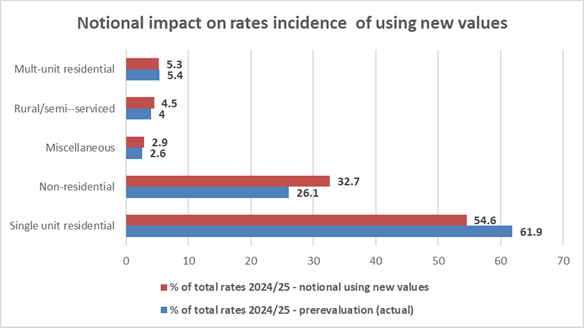
2.5 With
the single unit residential property share of the total land value decreasing
from 72.1% to 66.6% and capital value from 66.5% to 62.1%, using the new values
would see approximately $11m of rates transferred from the residential sector
to the non-residential sector ($10.2m) and rural sector ($0.8m) if no further
changes were made to the rating system.
2.6 Such
a significant movement may not be an appropriate outcome and scenarios have
been modelled to understand how this may be moderated. However, there are
other factors that will influence the final rates incidence for 2025/26, and
these are outlined in the following section.
Other factors impacting on rates
incidence for 2025/26
2.7 In
addition to the revised rating valuations, rates incidence for 2025/26 will be
influenced by the following:
· The
second stage of implementation of the targeted rate based on the capital value
– in effect approximately doubling the rates to be based on the capital
value
· The
proposed second stage of implementing the change to the differential surcharge
for the rural/semi-serviced (lifestyle) properties
· The
extent of the increases required in the fixed charges to fund the proposed
budgets for water, wastewater and resource recovery. Based on the draft of the
annual budget to be presented for consideration by Council on 12 February the
following fixed charges would be required:
|
|
Actual
for 2024/25 ($ GST incl.)
|
Draft
for 2025/26 ($GST incl.)
|
|
Water
|
415
|
500
|
|
Wastewater
|
375
|
410
|
|
Kerbside recycling
|
144
|
189
|
|
Rubbish & public
recycling
|
51
|
77
|
Metered water charges will also need to increase by approx.
10% - these are ultimately adopted as part of the rates setting resolution.
· Whether
as a consequence of the revaluation or as a part of the progressive
implementation of the capital value-based rate it is considered appropriate to
change the differential surcharges for some of the differential categories
· The
level of the uniform annual general charge (UAGC).
3. Discussion
Why might an intervention to
moderate the impact of the revaluation be appropriate?
3.1 An
intervention may be appropriate if it is considered that the rates that would
be assessed based on the updated valuations are unreasonable for a significant
group of ratepayers. It may also be appropriate as a holding action or
temporary measure if the extent of the change in rates is considered
unreasonably high.
3.2 Such
an intervention was made following the 2018 and 2021 revaluations as on both
occasions there was a significant increase in residential land values
especially for those at the lower end of the market. The response was to
lower the uniform annual general charge and increase the differential surcharge
for non-residential properties meaning the non-residential properties then paid
a greater share of the total than before.
3.3 The
circumstances are similar again this year although on this occasion there have
been reductions in values with the greatest reduction (in percentage terms)
occurring for residential properties at the lower end of property values.
What type of changes might
be possible?
3.4 The
following three main tools for change are considered in turn:
· A change to the level of
the uniform annual general charge (UAGC)
· A change to the
differential surcharges for some categories of property
· Changing
the proportion of the rates based on the capital value.
Changing the level of the UAGC:
3.5 The
UAGC is an integral part of the Council rating system. It serves to
moderate the level of rates (especially for residential properties) by making
sure those with low land values pay at least a minimum contribution to fund
city services and facilities and those with very high land values do not pay an
unreasonably high contribution.
3.6 The
UAGC for 2024/25 is $200 per rating unit. It was reduced to this level in
2022/23 from $500 per rating unit in 2021/22. It was reduced to $500 from $690
in 2018/19.
3.7 For
many years it was the practice to increase the UAGC annually to keep the fixed
component of the rates at similar proportions from year to year at levels just
below the statutory maxima of 30% (which by legislative definition excludes any
fixed targeted rates for water and wastewater). For the 2024/25 year
fixed charges, calculated in the same way as prescribed in the legislation, are
approx. 8%.
3.8 Given
the average rates assessed on commercial/industrial properties is much higher
than for residential properties the UAGC forms a much smaller part of the
individual rates assessed on them compared to residential properties.
3.9 Changing
the level of the UAGC would impact not only the total rates contributed by each
differential category but also the incidence of rates within each category.
3.10 One of the
arguments to reduce the UAGC to $200 following the 2021 revaluation was that
the spread of residential land value had been reduced through the revaluation
(lower land values increased by 100% or more whilst higher land values
increased by a smaller percentage).
3.11 The
reverse has occurred during the 2024 revaluation. The greater reductions
in land value have been in the traditionally lower valued areas. These
reductions have flowed through to the capital value.
3.12 An option
is therefore to increase the UAGC. Scenarios have been tested with a UAGC
of $200, $300 and $400.
Changing the differential surcharges:
3.13 A
fundamental component of the present rating system is that property is grouped
by differential category (primarily based on the nature of use) and a general
rate is assessed with different rates in the dollar of land value being assessed
on each property group.
3.14 The
targeted rate based on the capital value is also categorised in the same manner
and surcharges are applied (although not at the same level as for the general
rate). There are various reasons for this outlined in the funding impact
statement in the Council’s Long-term Plan.
3.15 The
Council describes the relationship between the rates charged to each
differential group in terms of a factor expressed as a percentage of the rate
that would apply if there were no differential rating in place. Each year
the Council reviews the differential factors applied to each group.
3.16 When
adopting the Long-term Plan the Council signalled its intention that the
discount provided through the differential system to semi-serviced/rural properties
(lifestyle blocks) of between 0.2 ha and 5 ha would be reduced over two years,
2024/25 and 2025/26. Year 2 of this change has been taken into account
when modelling scenarios for Council consideration.
3.17 If the
intention is that the other differential groups should pay similar proportions
of the total rates in 2025/26 as in 2024/25 then there will need to be
significant changes to the differential surcharges. A number of scenarios
have been tested.
The capital value based
targeted rate:
3.18 When
adopting the revisions to the rating system for 2024/25 Council signalled it
intended that its desire was to progressively increase the portion of the
value-based rates based on the capital value to 50% over three years.
Rates for 2024/25 were calculated to achieve 16.5% being based on the capital
value.
3.19 All
testing of scenarios has included an assumption 33% of the value-based rates
will be based on the capital value in 2025/26 as the second year of the
transition to a 50% capital value based rating system.
Testing scenarios
3.20 The
approach taken for this report has been as follows:
· All
scenarios assume an increase in total rates required of 8.5% and fixed charges
for services being as outlined in clause 2.7 above.
· UAGC
levels and differential surcharges as shown in the following table:
|
Scenario
|
Differentials
|
UAGC
|
|
1
|
FM (lifestyle)
change discount from -45% to
-40%
|
$200
|
|
2
|
FM (lifestyle)
change discount from -45% to
-40%
|
$300
|
|
3
|
FM (lifestyle)
change discount from -45% to
-40%
|
$400
|
|
4
|
FM (lifestyle)
change discount from -45% to
-40%
CI (non-residential)
Reduce LV surcharge from 200% to
150%
Reduce CV surcharge from 120% to
100%
|
$200
|
|
5
|
FM (lifestyle)
change discount from -45% to
-40%
CI (non-residential)
Reduce LV surcharge from 200% to
150%
Reduce CV surcharge from 120% to
100%
|
$300
|
|
6
|
FM (lifestyle)
change discount from -45% to
-40%
CI (non-residential)
Reduce LV surcharge from 200% to
150%
Reduce CV surcharge from 120% to
100%
|
$400
|
|
7
|
FM (lifestyle)
change discount from -45% to -40%
CI (non-residential)
Reduce LV surcharge from 200% to
135%
Reduce CV surcharge from 120% to
100%
|
$200
|
3.21 The first
three scenarios were chosen to demonstrate what would happen to rates incidence
if no change was made to differential surcharges (except for FM) but if instead
changes were made to the level of the UAGC.
3.22 Scenario 7
was chosen as a means of determining how much reduction there would need to be
in the differential surcharge for non-residential property in order to have the
various differential property groupings bearing a similar proportion of the
total rates as they have for 2024/25.
3.23 Scenarios
4 to 6 demonstrate how it is possible to moderate the impact on the
non-residential sector by reducing the differential surcharge but not by as
much as in scenario 7. Scenarios 5 and 6 have the same differential
surcharges as scenario 4 but the UAGC has been increased to $300 and $400
respectively. Officers have recommended the differentials that are used
in these scenarios.
3.24 The
following graph demonstrates the proportion of the total rates assessed that
would be borne by each differential group for each scenario, compared with the
actual for 2024/25.
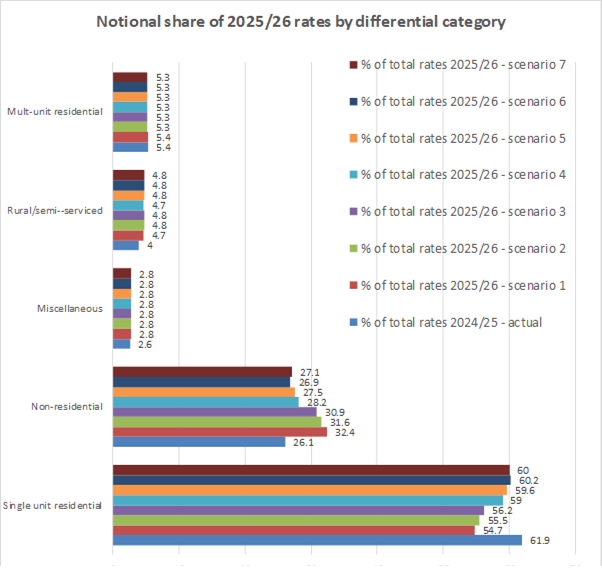
3.25 Interpreting
what the graph shows:
· Due
to a significant increase in the capital value of the utilities in the streets
(which form part of the non-residential category) along with stage 2 of the CV
system change, approx. 1% of the total rates relates to the additional rates
assessed on these previously non-rated assessments.
· Without
changing the differential surcharges (as in scenarios 1 to 3) increasing the
level of the UAGC does marginally reduce the total rates payable by the
non-residential sector and transfer it to the residential sector – this
is because there are many more rating units in the residential category.
· There
is a slight increase in the proportion of the rates payable by the
rural/semi-serviced sector and this relates in part to the second stage of the
implementation of the reduced discount for the FM (‘lifestyle’)
properties as agreed by the Council when adopting the changes for
2024/25. Although the change in the discount has been assumed in the
modelling, the outcome for each scenario is that the FM properties would still
receive a significant discount when compared with single unit residential
properties. For example, the rate-in-the dollar for FM for the general rate for
scenarios 4-6 is 75% of the single unit residential rate and 79% of the
capital-value based targeted rate. In each of the scenarios rates for
most individual ratepayers in the FM category will increase by approx. 30%.
3.26 In
addition to checking the rates incidence at the differential category level it
is necessary to consider the changing incidence at the individual ratepayer
level.
3.27 The graphs
in Attachment 1 show the number of properties within each band of
movement in rates (in both %age and dollar terms). There are graphs for
the single unit residential, non-residential and rural differential groups.
3.28 Some
initial observations from the graphs include:
· Scenarios
1-3 show significant reductions in rates for many residential properties as the
total sum to be collected from each differential category is significantly
different from the current year. By comparison these scenarios show
significant increases for non-residential properties and rural/semi-serviced.
· Scenarios
4-7 produce an overall outcome by differential category that is more like the
distribution for 2024/25. The majority of the rates increases for
residential properties are less than 10%. Between 2,900 and 6,900
residential properties would have increases in the 10-25% band –
principally those with high ratios of capital value to land value though the
number in this band increases as the UAGC is increased.
· In
Scenarios 4-7 most of the residential rates increases are less than $500.
In Scenario 4 80% of single unit residential rates increases would be less than
$250.
· Rates
movements for non-residential properties vary widely in all scenarios.
This is because of the wide variation in value movements in different parts of
the City and because of the range of different capital to land value ratios for
the properties in this category.
· Scenario
4 moderates the increases for non-residential properties with very high ratios
of capital to land value. Even in this scenario there are over 130 such
properties with increases over $10,000 with 3 having increases over $100,000, 9
with increases of between $50,000 and $90,000, 8 with increases of between
$30,000 and $50,000 and 20 with increases of between $20,000 and $30,000.
4. Conclusions
4.1 As
outlined in the report to the 11 December meeting using the latest rateable
values (in combination with the second stage of the move to a greater share of
the rates based on the capital value) would transfer a significant sum from the
residential to the non-residential (commercial/industrial) sector.
4.2 This
report shows the extent of that potential transfer using UAGC at levels of
$200, $300 and $400.
4.3 The
report also shows the changes to the differential surcharges that would be
necessary to enable the proportion of total rates payable by the
non-residential sector to be similar to that which applied for 2024/25.
4.4 The
report also provides scenarios that would enable the impact of the change of
incidence on the non-residential sector to be moderated through the use of a
combination of reductions in the differential surcharges and various levels of
UAGC.
5. NEXT STEPS
5.1 The
supporting material and consultation document for the annual budget will be
updated based on Council’s decisions and then presented to the Council
meeting on 5 March for adoption.
6. Compliance and administration
|
Does the Council have delegated
authority to decide?
|
Yes
|
|
Are the decisions significant?
|
No
|
|
If they are significant do they
affect land or a body of water?
|
No
|
|
Can this decision only be made
through a 10 Year Plan?
|
No
|
|
Does this decision require
consultation through the Special Consultative procedure?
|
No
|
|
Is there funding in the current
Annual Plan for these actions?
|
Yes
|
|
Are the recommendations
inconsistent with any of Council’s policies or plans?
|
No
|
|
The
recommendations contribute to the achievement of objective/objectives
in:
14.
Mahere mana urungi, kirirarautanga hihiri
14. Governance and Active
Citizenship Plan
The objective is: Base our
decisions on sound information and advice
|
|
Contribution to strategic
direction and to social, economic, environmental and cultural well-being
|
Determining rating valuations
every three years is a legislative obligation that is required to enable the
Council to set rates. The Council is required to prepare Funding Impact
Statements that provide the detail of the proposed rating system as part of
each year’s Annual Plan.
|
|
|
|
Attachments
|
1.
|
Attachment
1 - Scenarios showing impact on rates incidence ⇩ 
|
|
Memorandum
TO: Council
MEETING DATE: 12
February 2025
TITLE: Submission
on the Local Government (Water Services) Bill
Presented
By: Mike
Monaghan, Group Manager- 3 Waters and Julie Keane, Transition Manager Three
Waters
APPROVED BY: Chris
Dyhrberg, General Manager Infrastructure
RECOMMENDATION TO Council
1. That Council
agree the submission on the Local Government (Water Services) Bill (Attachment
1).
1. ISSUE
1.1 The
purpose of this memorandum is to report to Council, for information, on
Council’s submission on the Local Government (Water Services) Bill (WSB).
2. BACKGROUND
2.1 On
10 December 2024, the WSB was introduced to the House of Representatives.
It is the final bill (third) related to the water services reform that the
Government intends to pass. This Bill aims to provide arrangements for:
· Arrangements
for the new water services delivery system;
· a
new economic regulation and consumer protection regime for water services;
· and
changes to the water quality regulatory framework and the water services
regulator.
2.2 On
18 December 2024, Parliament’s Finance and Expenditure Committee called
for submissions on the WSB. The closing date for submissions was set by the
Committee for 23 February 2025.
2.3 The
Bill is very technical in nature, to respond to that Officers from across the
organisation have provided their input.
2.4 At
the time of writing this report, the WSB is at the Select Committee stage.
2.5 The
key areas highlighted in the submission are:
· The
requirement to strengthen Māori representation in the Bill by clarifying a
water provider’s obligations under te Tiriti o Waitangi, including iwi
and hapū without settlements in Treaty obligations and ensuring directors
have cultural knowledge of tikanga Māori and Te Tiriti.
· Improve
governance with clear enforcement provisions for the Statement of Expectations,
mandate essential skills for directors and ensure shareholder approval for
subcontracting of significant contracts.
· Ensure
alignment of financial principles and ringfencing provisions to ensure
consistency between Water Services Council-Controlled Organisation options and
the internal business unit option.
· Ensure
any new water organisation aligns with the City’s Future Development
Strategy (FDS) to support long-term growth and ensure water organisations
contribute to capital growth and development objectives.
· Avoid
inefficiencies by aligning levy timelines and consolidating water plan
requirements to reduce duplication and focus on improving services.
3. NEXT STEPS
3.1 Monitor
outcomes of the final reading of the WSB, likely to be enacted mid-2025.
4. Compliance and administration
|
Does Council have delegated
authority to decide?
If Yes quote relevant clause(s)
from Delegations Manual
|
Yes
|
|
Are the decisions significant?
|
No
|
|
If they are significant, do they
affect land or a body of water?
|
No
|
|
Can this decision only be made
through a 10 Year Plan?
|
No
|
|
Does this decision require
consultation through the Special Consultative procedure?
|
No
|
|
Is there funding in the current
Annual Plan for these actions?
|
Yes
|
|
Are the recommendations
inconsistent with any of Council’s policies or plans?
|
Yes
|
|
The recommendations contribute
to
Whāinga 4: He tāone
toitū, he tāone manawaroa
Goal 4: A sustainable and
resilient city
|
|
The recommendations contribute
to the achievement of objectives in
14.
Mahere mana urungi, kirirarautanga hihiri
14. Governance and Active
Citizenship Plan
The objective is: Advocate to Government and other
decision-makers on issues and opportunities.
|
|
Contribution to strategic
direction and to social, economic, environmental and cultural well-being
|
The purpose of Local
Government (Water Services) Bill (WSB) is to establish a framework for local
government to provide water services in a flexible, cost-effective,
financially sustainable, and accountable manner.
|
|
|
|
Attachments
|
1.
|
Draft
submission Local Government (Water Services) Bill ⇩ 
|
|
Memorandum
TO: Council
MEETING DATE: 12
February 2025
TITLE: Submission
on Treaty of Waitangi Principles Bill
Presented
By: Todd
Taiepa, Manager - Māori Advisory
APPROVED BY: David
Murphy, General Manager Strategic Planning
RECOMMENDATION TO Council
1. That Council
receive the memorandum titled Submission on Treaty of Waitangi Principles Bill.
1. ISSUE
1.1 A Bill has
recently been proposed by Parliament that seeks to redefine the Te Tiriti o
Waitangi / Treaty of Waitangi principles in legislation and require the
redefined principles to be used when interpreting legislation.
1.2 The
original submission period was 19 November 2024 until 7 January 2025. On 9
January 2025 the deadline was extended until 14 January 2025.
1.3 On
11 December 2024 the Council resolved to submit in opposition to the Bill and
agreed that the submission will be authorised by the Mayor and Deputy Mayor,
and that it will be reported back in February.
1.4 The
submission approved by the Mayor and Deputy Mayor and lodged with Parliament is
included as Attachment 1.
2. BACKGROUND
2.1 As outlined
at the 11 December 2024 meeting, the Bill proposes that a simple, clear, and
authoritative approach should be taken to the expression and application of the
Treaty Principles by Parliament. It was proposed that this would achieve key
outcomes such as reducing uncertainty and complexity in the delivery of
government services, and improving fairness and equity in the delivery of
those services by placing less emphasis on an indigenous Māori rights
framing but rather an emphasis on needs based criteria.
2.2 The Treaty
Principles Bill is part of the Government’s coalition agreement with its
ACT partner and is part of a wider consideration of how the Crown’s
Treaty obligations and responsibilities should appropriately shape the settings
for Māori participation and representation, the use of te reo and tikanga
Māori, and the broader consideration of how indigenous rights are
integrated into a modern liberal democracy.
2.3 While the
scope of the Bill is in relation to Government’s position on the Treaty
principles, the Council submission emphasises the positive and critical role
the principles have played to assist the Council to navigate relationships with
its Iwi partner Rangitāne o Manawatū, and this is reflected by the
inclusion of Treaty principles in our Partnership Agreement. The principles provide
guidance, but also boundaries, and importantly checks and balances for all
parties. The principles have also been of enormous value in building strong
relationships with the wider iwi Māori communities of Palmerston North.
2.4 While the
coalition partners National and New Zealand First have indicated they will not
support the Bill beyond its first reading, the Council submission does express
concern at the potential negative impacts of initiating and framing wider
public discourse on the Treaty, independently of the Tiriti partner.
2.5 Council’s
submission strongly rejects the Bill in its entirety and encourages the
National and New Zealand First coalition partners to not support it passed the
first reading, which they have committed to undertaking. Further, the
Government is encouraged to undertake more authentic and genuine engagement
with Māori to ensure that meaningful and constructive relationships with
the Crown are restored and enhanced.
3. UPDATE
3.1 There
were over 300,000 submissions on the Bill. The Justice Committee has begun
hearing more than 80 hours of oral submissions which are to be completed by the
end of February. Council was one of 15,000 submitters who requested to be heard
and was not successful in being selected to appear before the Committee.
3.2 The
report on the Bill will be due to Parliament’s Justice Committee later in
the year.
4. Compliance
and administration
|
Does the Council have delegated
authority to decide?
If Yes quote relevant clause(s)
from Delegations Manual
|
Yes
|
|
Are the decisions significant?
|
No
|
|
If they are significant do they
affect land or a body of water?
|
No
|
|
Can this decision only be made
through a 10 Year Plan?
|
No
|
|
Does this decision require consultation
through the Special Consultative procedure?
|
No
|
|
Is there funding in the current
Annual Plan for these objectives?
|
Yes
|
|
Are the recommendations
inconsistent with any of Council’s policies or plans?
|
No
|
|
The recommendations contribute
to:
(Not Applicable)
(Not Applicable
|
|
The
recommendations contribute to the achievement of objective/objectives
in:
14.
Mahere mana urungi, kirirarautanga hihiri
14. Governance and Active
Citizenship Plan
The objective is: Advocate to
the Government and other decision makers on issues and opportunities.
|
|
Contribution to strategic
direction and to social, economic, environmental and cultural well-being
|
Advocacy by local government
to central government means that localised information contributes to the
proposed legislation and can influence the impact on local communities.
|
|
|
|
Attachments
|
1.
|
PNCC
Submission on the Treaty of Waitangi Principles Bill ⇩ 
|
|


Memorandum
TO: Council
MEETING DATE: 12
February 2025
TITLE: Arena
Masterplan Steering Group
Presented
By: John
Lynch, Manager Venues + Events
APPROVED BY: Danelle
Whakatihi, General Manager Customer & Community
RECOMMENDATION TO Council
1. That Council
reconvene the Arena Masterplan Steering Group and agree the attached Terms of
Reference.
1. ISSUE
1.1 As
Council officers progress with the new Arena 5 development planned within the
current Long-Term Plan (LTP), the Arena Masterplan Steering Group (Steering
Group), who have not met for 3 ½ years, need to be reconvened to oversee
the project and keep Elected Members informed on design, tender or design and
build processes, developments, and delivery.
1.2 This
memorandum presents a reviewed Terms of Reference for Council’s approval
before the Steering Group is reconvened.
2. BACKGROUND
2.1 In
2014, Council undertook a high-level study of Arena Manawatū,
now Central Energy Trust Arena (CET Arena) to produce a spatial framework for
the site and immediate surrounding streets. Significant improvement of the
facility’s relationship and connection to adjoining streets was
identified as a key issue. A range of projects aimed to deliver a high-quality
site and sports destination with improved street presence, legibility and
sporting visibility. This included a new open plaza entrance to Cuba Street and
a potential Sports House.
2.2 In
2015, Updates to Section 15 Recreation of the Operative District Plan were made
resulting in a specific Arena Zone (Section 15.2.5) and embedding the Arena
spatial framework as a Planning Map (Map 15.2). Funding of priority streams of
work was allocated into the 2015 - 2025 Long Term Plan including Council
agreeing to provide a $1.5M funding grant for a Sports House on the site.
2.3 In
2017, a more detailed Masterplan study was then prepared to further test and
develop previous work undertaken. Key outcomes underpinning the Masterplan to
create a higher quality sporting destination with improved street presence,
legibility and sporting visibility remained. Further contextual analysis of the
planning framework, site conditions, built form, open space patterns and
general assessment of facilities were undertaken. Specific briefs for Arenas
1-6 were prepared and a range of concept options including a new Sports House
tested to best address site-wide requirements. Options were costed and
assessed, and a preferred Masterplan option emerged (Option 3). Funding for
Option 3 priority projects were then allocated into the 2018-2028 Long Term
Plan.
2.4 Land was acquired at the corner of Cuba and Waldegrave
Street and the site made good in preparation for construction works for a new
entrance plaza. From 2018, with oversight from the Arena Steering Group,
detailed design of priority projects commenced with the first artificial turf
at Arena 6 completed late 2019.
2.5 During this time the proposal for a Sports House to be
located at Central Energy Trust Arena was withdrawn by Sport Manawatū.
Attention then shifted to construction delivery with the Cuba Street entrance
plaza and overbridge, reconfigured speedway pits and south stand base plinth
and ablutions completed in April 2021.
2.6 This significant change has resulted in a more welcoming
public entrance from Cuba Street, an enhanced visitor and fan experience for
users of Arena 1 and improved operations management for larger events such as
speedway, rugby, concerts and community events. These changes have drawn
positive national design attention with Central Energy Trust Arena receiving a
handful of prestigious Toitanga and public space design awards.
2.7 With this tranche of work now complete, updating the
Masterplan to reflect progress made, understand any new or emerging needs and
confirm all future projects are the next logical steps in continuing to provide
long term vision and guidance for co-ordinated and integrated development of
Central Energy Trust Arena.
2.8 Sport and recreation facility planning processes are
occurring in parallel. Needs assessments guided by the Regional Sports
Facilities Plan 2018 and the Palmerston North ‘City Specific’
sections updated in 2022 have informed the Masterplan review. Central
Energy Trust Arena is recognised as having a unique role in the region for
meeting demand for further sports facilities. Needs have been canvassed for
additional indoor court and sports field facilities identified for the site. A
regional GymSports feasibility study is underway and Central Energy Trust Arena
is a potential location being considered.
2.9 The Arena site does not sit in isolation to its immediate
surrounds. Other projects – the Cuba Street link and Featherston Street
cycleway directly relate to the immediate street network that surrounds the
Arena site and these have been highlighted within the updated Masterplan. It is
essential to ensure these projects are considered in relationship to the
ongoing development of the Arena and that wider City Centre transformation and
active transport outcomes to better connect and access the site are achieved.
2.10 Three
significant projects have been completed since the original Masterplan was
adopted at Arena.
· In 2018 retractable
seating was installed in Arena 2 providing 2,282 seats at a cost of $1.5M
· In 2019 an
artificial turf was installed at the rear fields behind the grandstand at a
cost of $1.4M
· In 2021 the new
Entrance Plaza and Speedway Pits project was completed at a cost of $17.4M
2.11 In 2023
the Arena Masterplan was again reviewed, updated and adopted by Council. The
latest review was undertaken as:
· it had been 5 years
since the Arena Masterplan was last revised,
· there has been a
changing landscape in the markets which Arena operates in,
· there is a more
coordinated approach to the development of facilities regionally,
· ensuring the
facilities meet the current and future needs of the community.
2.12 The Arena
Masterplan Steering Group last convened in mid-2021 at the completion of the
Entrance Plaza, Speedway Pits and Ablution Block project which was delivered on
time, and within budget. As there were no further projects planned in the
Council’s LTP, it was determined there was no further need for the
Steering Group to meet. Strategic Planning and Infrastructure have been
consulted in putting the report and draft terms of reference together.
2.13 The
appointments from Council for the Steering Group have already been decided
following the last election and hold until the next election. These are The
Mayor, Cr Arnott, Cr Dennison, Cr Hapeta, and Cr Meehan.
2.14 In the
current LTP the new Arena 5 development is included with $.5M in Year 1, $8M in
Year 2, and $8.5M in Year 3.
2.15 Council
Officers within the Strategic Planning, Infrastructure, and Venues + Events
divisions of Council have, through the first 6 months of the current financial
year, brought together a working group of stakeholders relevant to the new
Arena 5 development. Officers have gathered key requirements and considerations
from this group to assist in the development of a design brief in relation to
the project and to take to market. Officers are now working through the
appropriate options whether to undertake a standard tender process or whether a
design and build process is the right path forward. Officers are working with
the Procurement team to understand the benefits and risks associated with the
various processes and the appropriate course to put forward for consideration.
3. NEXT
STEPS
3.1 An
initial design brief is expected to be completed in February which will detail
the requirements of the new facility, spatial and environmental considerations,
and allow for conceptual design and anticipated costings to be established.
3.2 The
Arena Masterplan Steering Group is required to be reconvened to oversee aspects
of Masterplan projects, current and anticipated in the future years of the LTP.
4. Compliance
and administration
|
Does the Council have delegated
authority to decide?
|
Yes
|
|
Are the decisions significant?
|
No
|
|
If they are significant do they
affect land or a body of water?
|
No
|
|
Can this decision only be made through
a 10 Year Plan?
|
No
|
|
Does this decision require
consultation through the Special Consultative procedure?
|
No
|
|
Is there funding in the current
Annual Plan for these objectives?
|
Yes
|
|
Are the recommendations
inconsistent with any of Council’s policies or plans?
|
No
|
|
The recommendations
contribute to: Whāinga 2: He tāone whakaihiihi,
tapatapahi ana
Goal 2: A creative and exciting city
|
|
The recommendations contribute to this
plan:
6.
Mahere rēhia
6. Recreation and Play Plan
The objective is:
Provide community sport and
sport-event facilities at Central Energy Trust Arena
|
|
Contribution to strategic
direction and to social, economic, environmental and cultural well-being
|
The Arena provides accessible and
affordable opportunities for community sport and recreation. Opportunities
for communities to take part in active sport and recreation are prioritised
over other uses of the Arena.
|
|
|
|
Attachments
|
1.
|
Draft
Arena Masterplan Steering Group Terms of Reference ⇩ 
|
|
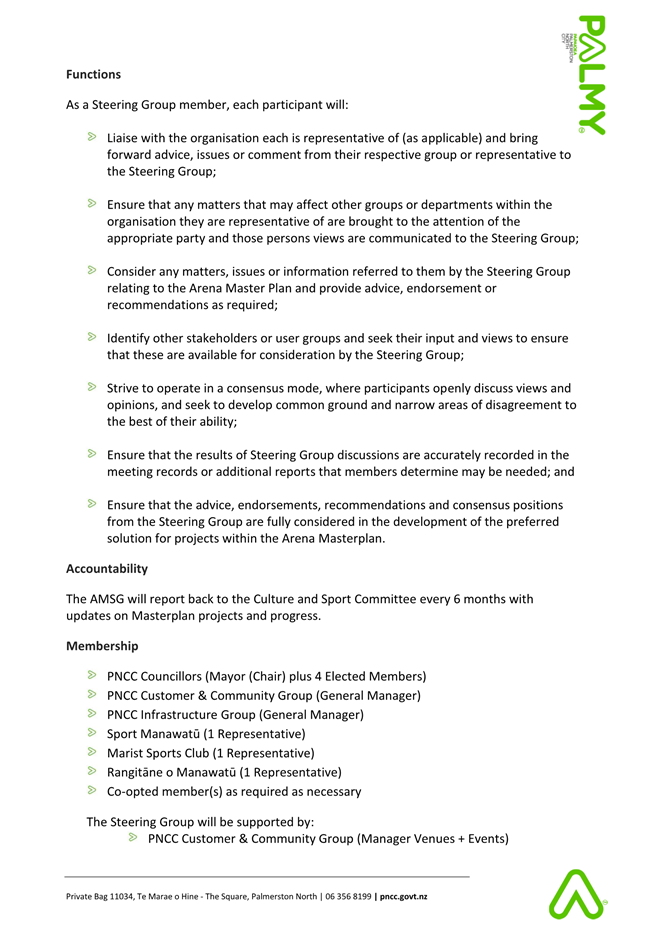
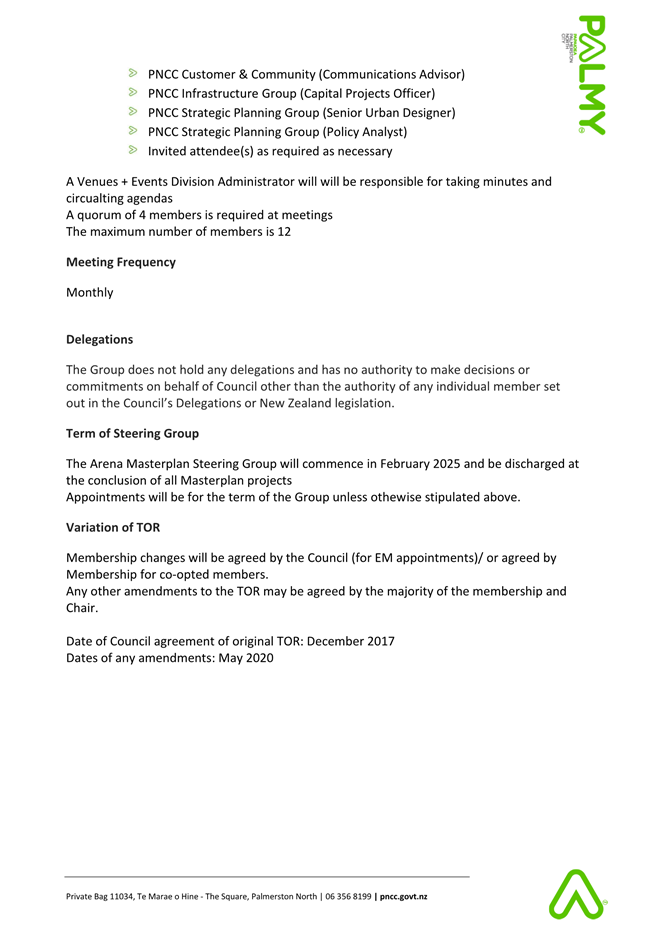
TO: Council
MEETING DATE: 12
February 2025
TITLE: Order
of Candidate Names on Voting Papers 2025
PRESENTED BY: Hannah
White, Manager Governance
APPROVED BY: Cameron
McKay, General Manager Corporate Services
RECOMMENDATION(S)
TO Council
1. That
Council agree the following order for arranging the names of candidates on
voting documents for Palmerston North City Council, pursuant to Regulation 31
of the Local Electoral Regulations 2001:
EITHER
(a) alphabetical
order of surname, OR
(b) pseudo-random
order, OR
(c) random order.
Summary of options analysis for
|
Problem
or Opportunity
|
Council
can decide which way candidates’ names will be ordered on local
election voting documents.
|
|
OPTION 1:
|
Alphabetical
order of surname
|
|
Community Views
|
Community views have
not been canvassed.
|
|
Benefits
|
Simple to locate
candidates’ names on voting documents.
This is the order used
in the candidate information leaflet included in the voting envelope.
Parliamentary elections
use alphabetical order, so voters are familiar with this method.
|
|
Risks
|
Potential for
candidates with surnames starting with letters late in the alphabet to be
disadvantaged.
|
|
Financial
|
No difference in cost
for the options.
|
|
OPTION 2:
|
Pseudo-random
order
|
|
Community Views
|
Community views have
not been canvassed.
|
|
Benefits
|
Equal opportunity for
candidates to be at the top of the voting paper.
|
|
Risks
|
Potential for those
candidates with names that are drawn first to be advantaged.
Not as user-friendly
for voters if they are referring to the candidate profile booklet which lists
candidates alphabetically.
|
|
Financial
|
There are some minor
additional compliance costs including public notice and witness of the
ballot.
|
|
OPTION 3:
|
Random
order
|
|
Community Views
|
Community views have
not been canvassed.
|
|
Benefits
|
This is the order
residents and non-ratepayer electors are familiar with for Palmerston North
elections.
As the order of names
varies from one voting document to another, this removes any positioning
advantage for any candidate.
|
|
Risks
|
Not as user-friendly
for inexperienced voters who may find it confusing if they are referring to
the candidate profile booklet which lists candidates alphabetically and
comparing this to locate preferred candidates on the voting paper.
Any concerns over
transparency can be verified by open inspection of the technology used to
randomise.
|
|
Financial
|
No difference in cost
for the options.
|
Rationale for the recommendations
1. Overview of the problem or opportunity
1.1 The
Local Electoral Act 2001 (the Act) and the Local Electoral Regulations 2001
(the Regulations) allows Council to make certain local decisions regarding the
election processes.
1.2 Candidates’
names may be ordered in one of three ways on local election voting documents:
alphabetical, pseudo-random or random.
1.3 Council
may determine the order by resolution prior to the Electoral Officer giving
public notice of the election on 6 August 2025. If Council does not make a
decision under clause 31(3) of the Regulations candidate names will be, by
default, listed in alphabetical order by surname.
2. Background and previous council decisions
2.1 Up
until the 2001 elections, candidates’ names on voting documents were
required to be listed in alphabetical order, by surname. Since 2004, the
Local Electoral Regulations allowed the Council to determine the manner of
listing names.
2.2 For
elections held from 2004 to 2013, Palmerston North City Council decided that
names should continue to be listed in alphabetical order by surname.
However, since the 2015 by-elections and for every election and by-election
since Palmerston North City Council has decided that names of candidates were
to be listed in random order.
3. Description of options
3.1 Option
1: Alphabetical
The order of names of candidates
is the same for all voting documents and is determined by initial letters of
candidates’ surnames.
3.2 Option
2: Pseudo-random
The order of names of candidates on voting documents is the
same for all documents but is determined by ballot rather than alphabet. Ballot
is held under supervision of a Justice of the Peace.
3.3 Option
3: Random
The order of names of candidates varies from one voting
document to another.
4. Analysis of options
4.1 Councils
across the country use all three methods of ordering. The most common is
alphabetical, followed by random, with only a small handful using
pseudo-random.
4.2 The
strength of random order is that theoretically it is the fairest method for all
candidates.
Research in 2021 analysed
the impacts of candidate order on election outcomes in the last four Auckland
Council elections. The overall analysis suggests that being listed
first appears to increase a candidate’s vote share by an average of
1.0 percentage point. Middle ballot positions deviate from the expected vote
share in a random manner by approximately ±0.5%. Candidates listed
in later ballot positions appear to receive slightly lower vote share than
expected. Further analysis did not show any observable effect of candidate
order on actual election outcomes, that is, whether candidates were
elected or not. This was in line with Australian findings across federal
elections between 1984 and 2004.
It should be
noted that the observed effect of primary bias does not occur to the same
degree for all. Research from outside of New Zealand has suggested that where
voters lack sufficient information to make informed choice, they are more
likely to be biased towards those names higher on a ballot paper.
Palmerston North’s case of a combination of STV where
voters rank candidates, may also increase the primary bias, in that people may
start at top of page and work down.
4.3 The
strength of alphabetical order is user experience.
There are several obstacles for voters. Local election
turnout is frustrated by having to use an unfamiliar postal system. Opening,
reading and understanding local government voting documents requires sustained
attention, an ability to read and proficiency in the English language. Voters
in Palmerston North use two different electoral systems[1] and are expected to be
familiar with each.
With 13 seats in the Te Hirawanui General Ward, we have
seen upwards of 40 candidates. Looking for a preferred candidate among a long
list of candidates could be further off-putting for voters, where the order in
the candidate booklet does not match that on the voting paper.
In the 2022 local government election both Horizons and
Palmerston used random order. It should be noted that Horizons is yet to make
their decision for 2025. There is a risk that there may be additional confusion
if Palmerston North and Horizons ended up with different ways of ordering names
on the same set of ballot papers.
5. Conclusion
5.1 Each
ordering option has strengths and weaknesses. Elected members must decide which
method best aligns with their priorities.
6. Next actions
6.1 Public
notice of the order to be used on voting documents will be placed on 6 August
2025.
6.2 Voting
papers will be prepared accordingly, following the closing of candidate
nominations.
7. Compliance and administration
|
Does the Council have delegated
authority to decide?
|
Yes
|
|
Are the decisions significant?
|
No
|
|
If they are significant do they
affect land or a body of water?
|
No
|
|
Can this decision only be made
through a 10 Year Plan?
|
No
|
|
Does this decision require
consultation through the Special Consultative procedure?
|
No
|
|
Is there funding in the current
Annual Plan for these objectives?
|
Yes
|
|
Are the recommendations
inconsistent with any of Council’s policies or plans?
|
No
|
|
The recommendations contribute
to:
(Not Applicable)
|
|
The
recommendations contribute to the achievement of objective/objectives
in:
14.
Mahere mana urungi, kirirarautanga hihiri
14. Governance and Active
Citizenship Plan
The objective is: Run local body
elections and any polls, including a Representation Review
|
|
Contribution to strategic
direction and to social, economic, environmental and cultural well-being
|
Opportunity for local
decision toward the encouragement of participation in elections and a fair
election process.
|
|
|
|
Attachments
Nil
Memorandum
TO: Council
MEETING DATE: 12
February 2025
TITLE: Appointment
to the Heritage Reference Group
Presented
By: Hannah
White, Manager- Governance
APPROVED BY: Cameron
McKay, General Manager Corporate Services
RECOMMENDATION TO Council
1. That Council
appoint Councillor Rachel Bowen as Council’s representative on the
Heritage Reference Group until October 2025.
1. ISSUE
At its meeting of 11
December 2024, Council agreed a terms of reference for the Heritage
Reference Group. The terms
of reference states that the membership of the will include one elected
member who will act as a liaison between Council and the Group.
This report recommends the appointment of Cr Rachel Bowen as
the elected member representative on the Heritage Reference Group.
2. BACKGROUND
The purpose of the Reference Group is to,
“provide expert heritage advice on local
projects. This group will act as a conduit between the Council and the heritage
community, ensuring that heritage considerations are integrated into planning
and development processes.
The Heritage Reference Group
will:
· connect
projects with knowledge holders and existing groups in the sector
· provide
guidance on which stories to tell through local projects
· advocate
to Council on strategies and plans that may have heritage implications”
Expressions of interest were
sought from Elected Members willing to represent Council on the Reference
Group. Cr Bowen was the sole nominee.
3. NEXT
STEPS
Expressions of Interest for the community members have been
advertised and close mid- February 2025. The first task of the appointed
elected member will be to participate in the selection process for the
community members.
Appoint the group and host the
first meeting in March 2025.
All elected member appointments
will be reviewed after the triennial election in October 2025.
4. Compliance
and administration
|
Does the Council have delegated
authority to decide?
If Yes quote relevant clause(s)
from Delegations Manual
|
Yes
|
|
Are the decisions significant?
|
No
|
|
If they are significant do they
affect land or a body of water?
|
No
|
|
Can this decision only be made
through a 10 Year Plan?
|
No
|
|
Does this decision require
consultation through the Special Consultative procedure?
|
No
|
|
Is there funding in the current Annual
Plan for these objectives?
|
Yes
|
|
Are the recommendations
inconsistent with any of Council’s policies or plans?
|
No
|
|
The recommendations contribute
to:
Whāinga 2: He tāone
whakaihiihi, tapatapahi ana
Goal 2: A creative and
exciting city
|
|
The
recommendations contribute to the achievement of objective/objectives
in:
11.
Mahere mō te kanorau koiora me Te Awa o Manawatū
4. Heritage Plan
The objective is: Establish a
volunteer city heritage reference group to contribute to heritage planning.
|
|
Contribution to strategic
direction and to social, economic, environmental and cultural well-being
|
A heritage reference group will
aid the Council in promoting the city’s social, economic,
environmental, and cultural identity. There will be spill-over benefits to
social, economic, and cultural well-being through a more explicit recognition
of the city’s history in public projects and initiatives.
|
|
|
|
Attachments
NIL
Committee Work Schedule
TO: Council
MEETING DATE: 12
February 2025
TITLE: Council
Work Schedule
RECOMMENDATION TO Council
1. That Council
receive its Work Schedule dated 12 February 2025
COUNCIL
WORK SCHEDULE 12 February 2024
|
#
|
Estimated
Report Date
|
Subject
|
Officer
Responsible
|
Current
Position
|
Date
of Instruction & Clause
|
|
1
|
early mid 2025
|
Report
back on Investment Options for PN Airport
|
GM Corporate
Services
|
|
6 December 2023
Clause 197-23
|
|
2
|
12 Feb 2025
|
Agree LWDW Consultation Document
|
Chief Executive
|
Hearings
- Sustainability Committee 16 April
|
5 Feb 2025
Clause 6-25
|
|
|
12 Feb 2025
|
Report back – Submission Treaty Bill.
|
GM Strategic Planning
|
|
11 Dec 2024
Clause 221 -24
|
|
|
12 Feb 2025
|
Review of Rating Incidences
|
GM Corporate Services
|
|
11 Dec 2024
Clause 213 - 24
|
|
|
12 Feb 2025
|
Review of Fees and Charges 25/26
|
GM Corporate Services
|
|
Terms of Reference
|
|
|
12 Feb 2025
|
Draft Annual Budget 2025/26
|
Chief Executive
|
|
Terms of Reference
|
|
3
|
5
March 2025
|
Draft
Annual Budget 2025/26 for consultation
|
Chief
Executive
|
|
Terms of Reference
|
|
4
|
5 March 2025
|
Remits from PNCC for consideration
|
GM Corporate Services
|
No remits received
|
Terms of Reference
|
|
5
|
5
March 2025
|
Alternative Options for BPO - Nature
Calls
|
GM
Infrastructure
|
Waiting on release of Taumata Arowai standards
|
Council
29 May 2024
Clause 95.11 -25 (rec 2)
|
|
6
|
2
April 2025
|
Extension of Contract – Nature
Calls
|
GM Infrastructure
|
|
11 Dec 2024
clause 224- 24
|
|
7
|
2 April 2025
|
Review of CEDA Directors Policy
|
GM Corporate Services
|
|
2 Oct 2024
Clause 172
|
|
8
|
30
April / 1 May 2025
|
Hearings for the Annual Budget 2025/26
|
Chief
Executive
|
|
Terms of Reference
|
|
9
|
7 May
2025
|
Deliberations for Local Water Done Well
|
GM
Infrastructure
|
following
Hearings at Sustainability Committee – 16 April
|
|
|
10
|
7 May 2025
|
Review of PNCC Appointment of Directors
Policy.
|
GM Corporate Services
|
|
2 Oct 2024
Clause 172
|
|
11
|
14
May 2025
|
Deliberations for the Annual Budget
25/26
|
Chief
Executive
|
|
Terms of Reference
|
|
12
|
4
June 2025
|
Remits
received from other Territorial Authorities
|
GM
Corporate Services
|
|
Terms of Reference
|
|
13
|
4
June 2025
|
2024
Residents Survey – Action Plan
|
GM Strategic
Planning
|
|
Terms of Reference
|
|
14
|
4
June 2025
|
Adopt
Annual Budget 2025-26
|
Chief
Executive
|
|
Terms of Reference
|
|
15
|
4
June 2025
|
Agree
LWDW - Water Services Delivery Plan
|
Chief
Executive
|
|
|
|
16
|
25
June 2025
|
Set
the Rates for 2025-26
|
GM Corporate
Services
|
|
Terms of Reference
|
|
17
|
25
June 2025
|
Approve
Borrowing for 2025-26
|
GM
Corporate Services
|
|
Terms of Reference
|
|
18
|
25
June 2025
|
Agree
revised BPO – Nature Calls
|
GM
Infrastructure
|
|
|
|
19
|
6 August 2025
|
Civic and Cultural Precinct Master Plan Steering Group
– 6-monthly update
|
GM Strategic Planning
|
|
Terms of Reference
|
|
20
|
8 Oct
2025
|
Parking
Contract Review Update – Frog Parking
|
GM
Infrastructure
|
|
4 September 2024
Clause 156-24
|
|
21
|
8 Oct
2025
|
Adopt
Annual Report 2024-25
|
Chief
Executive
|
|
Terms of
Reference
|
|
22
|
8 Oct
2025
|
Appointment
of Trustees on Council Controlled Organisations
|
General
Manager Corporate Services
|
|
Terms of
Reference
|
|
23
|
TBC
|
Summerhays Reports –
Partnership Models
Expressions of Interest
|
GM
Infrastructure
|
Lying on the Table
|
1 May 2024
Clause 66-24 and 74 -24
|
|
24
|
TBC
|
Effectiveness of Civics Education
Initiatives – Annual progress report
|
GM
Customer & Community
|
|
29 May 2024
Clause 95.29 -24
|





































